
Admin
-
Posts
7,487 -
Joined
-
Last visited
Content Type
Profiles
Forums
Events
Store
Gallery
Community Map
Posts posted by Admin
-
-
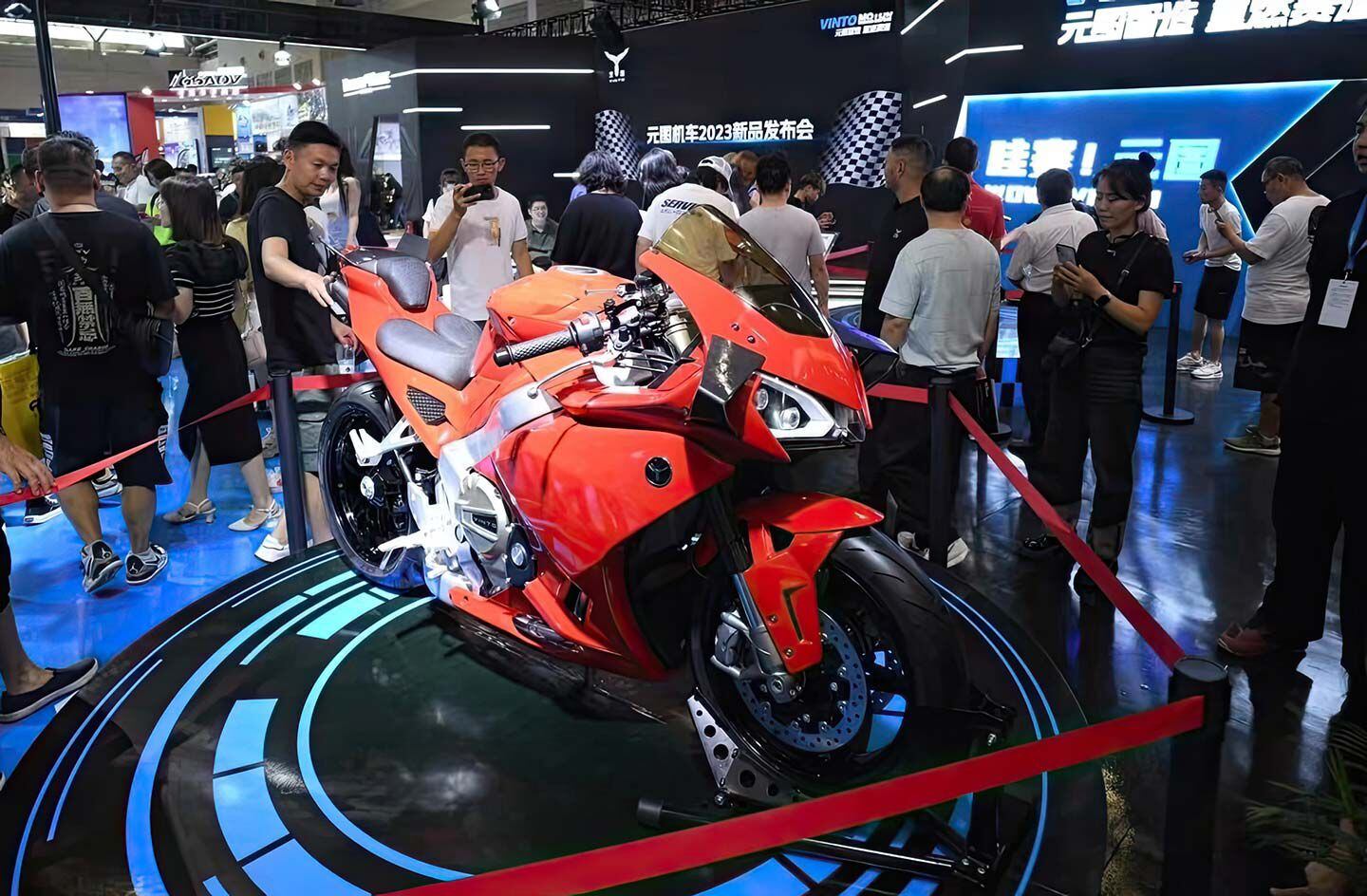
The recent CIMA show in China proved that companies from that country are building four-cylinder sportbikes at an exhilarating rate. (Vinto/)Chinese products are a divisive subject, but it’s becoming increasingly clear that the country’s motorcycle companies are rapidly catching up with their more established Western and Japanese equivalents. Never more so than at the recent CIMA show in China where there was a remarkable rush of new four-cylinder sportbikes from a variety of familiar and unfamiliar brands.
Some of these machines are unlikely ever to be seen outside their homeland, but others—names like Voge and QJMotor—are brands with a growing international presence and as such their offerings stand a good chance of going toe-to-toe with more familiar bikes in Europe and even the US.
We’ve already seen some impressive-looking Chinese sportbikes, most recently the teased CFMoto 675SR triple and 500SR four-cylinder, and they’re just the tip of the iceberg. These are the most interesting rivals to have been launched at CIMA in September.
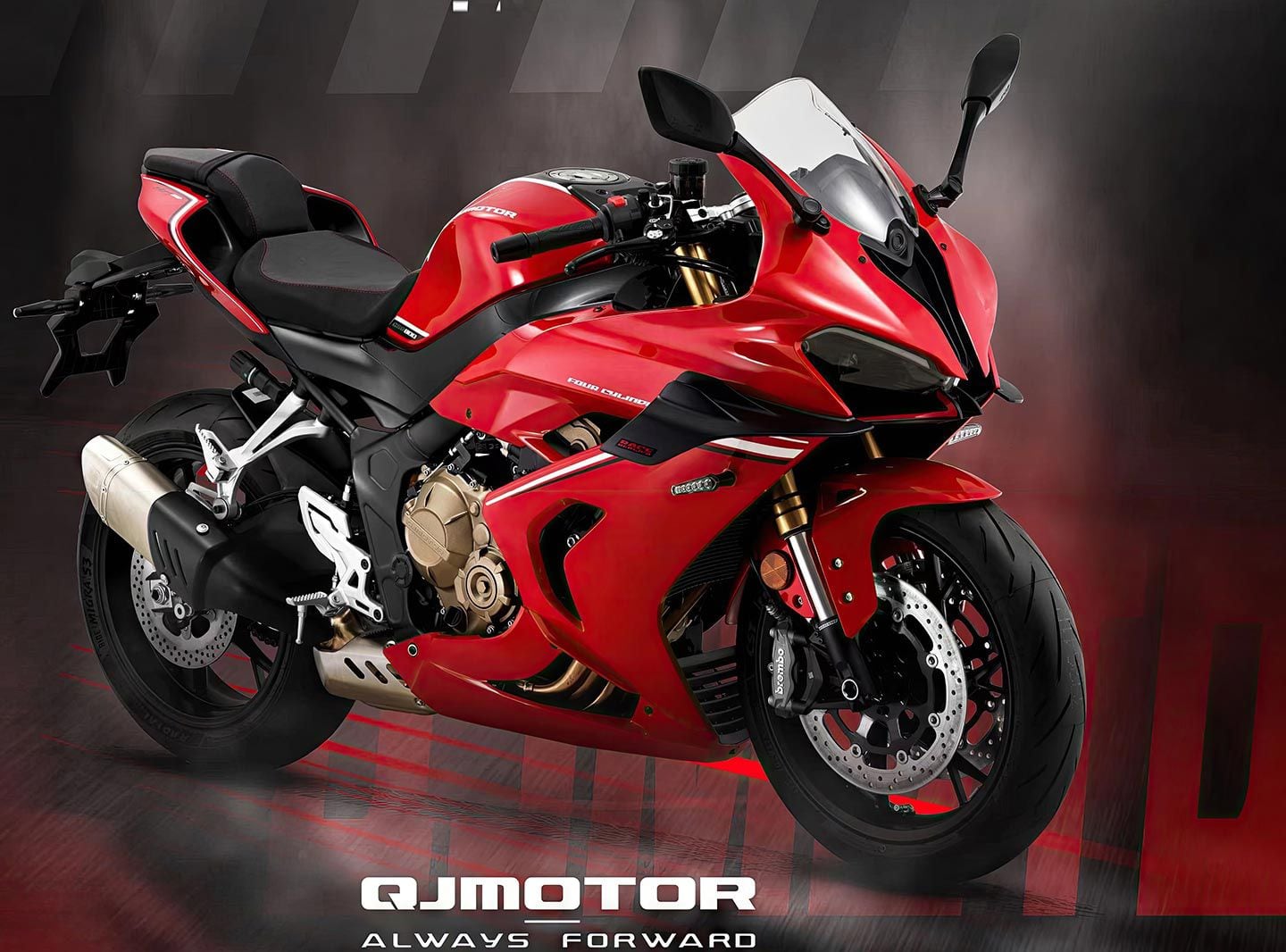
QJMotor’s SRK800RR has a 778cc inline-four. (QJMotor/)QJMotor SRK800RR
We actually brought the first news of this bike back in June, but now it’s been officially unveiled as the next step in a QJMotor sportbike plan that’s due to culminate later this year with the launch of the MV Agusta–based 1000RR. Details of the SRK800RR include a 778cc four-cylinder engine that appears (like several other Chinese fours) to be reverse-engineered from the Honda CBR650R engine. It shares the same 67mm bore as the Honda, but with a longer 55mm stroke to achieve its larger capacity. QJMotor claims 100 hp at 10,000 rpm and 57.5 lb.-ft. of torque.
The chassis is also remarkably similar to the CBR650R, with the same 57-inch wheelbase and a design that’s visually much the same as the Honda’s. However, the use of Brembo brakes is a step above the CBR650R, and in typical Chinese style the SRK800RR is heavy on tech, including a TFT dash and a built-in front-facing camera mounted just above the ram-air intake.
QJMotor’s ambitions are made clear by the company’s involvement in racing—it’s the title sponsor of the Gresini Moto2 team—and it’s a brand that’s already present globally, including the US. The company hopes to be able to homologate the SRK800RR for racing, too, probably in the World Supersport championship.
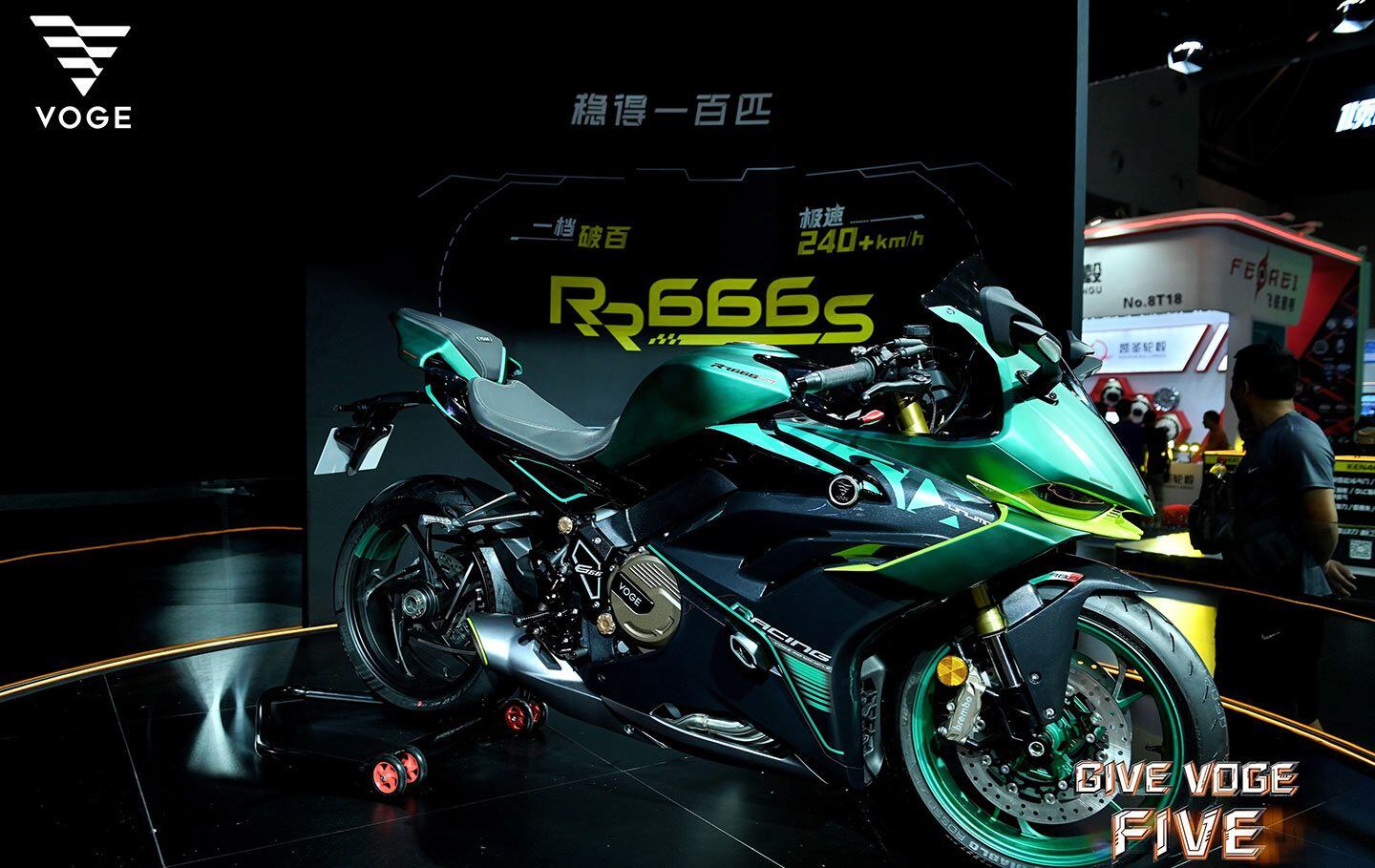
The number of the beast: The RR666S is from Locin’s luxury brand Voge and is the company’s first four-cylinder model. (Loncin/)Voge RR666S
Voge is the luxury, Western-oriented arm of Loncin—a company that’s long been among the most well-established of China’s bike makers, respected enough to be used by BMW as a contractor to build engines for its bikes. The RR666S is Voge’s first four-cylinder, with a 660cc engine that matches the QJMotor SRK800RR’s 100 hp output from less capacity.
The bike’s detailed specifications haven’t been released yet, but it’s claimed to be good for more than 150 mph and the visible parts include Brembo brakes, an aluminum chassis, and a single-sided swingarm.
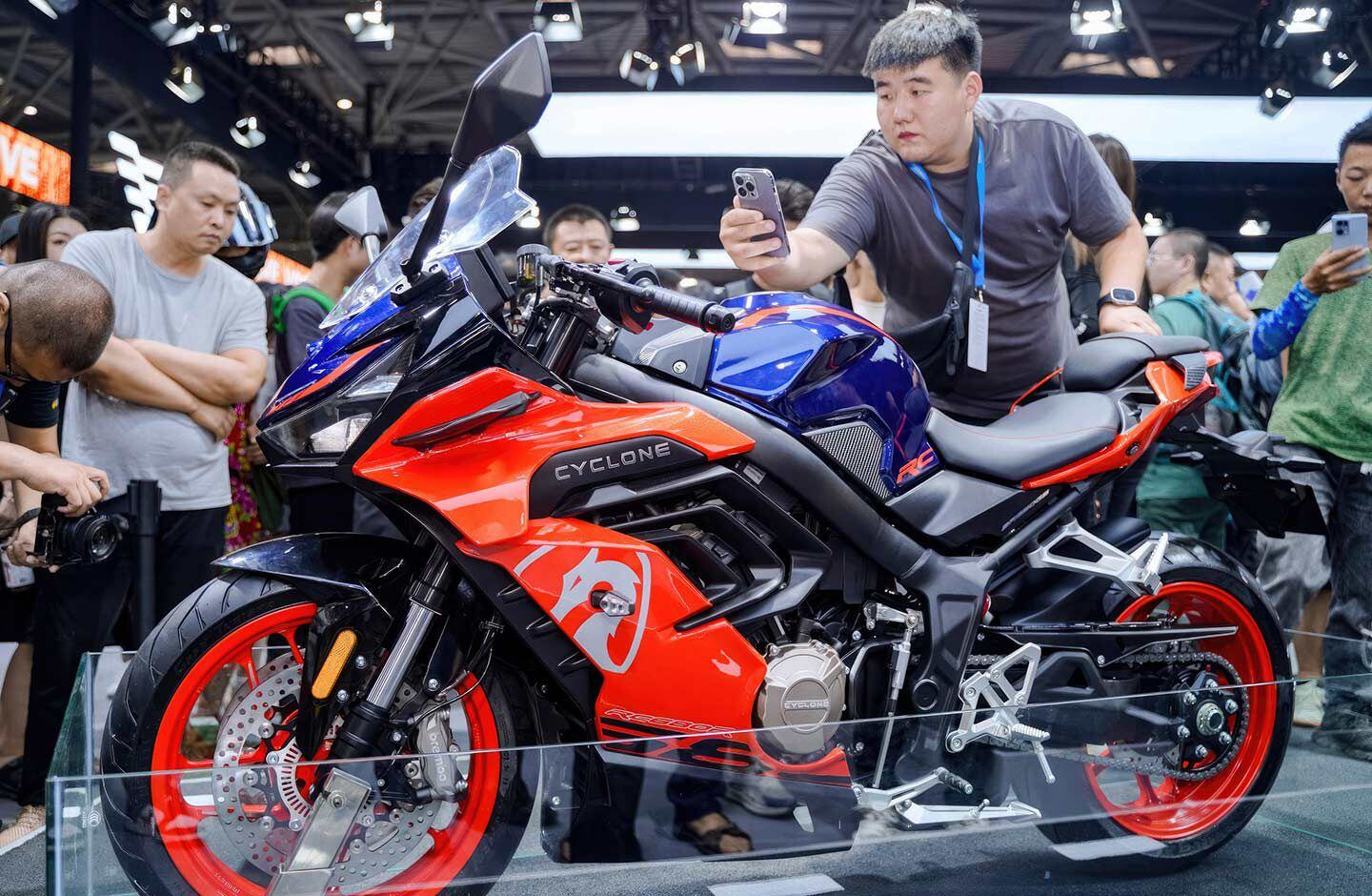
The Cyclone RC680R is that company’s first four-cylinder model and features a 680cc inline-four. (Zongshen/)Cyclone RC680R
Just as Voge is a sub-brand of Loncin, Cyclone is the high-end marque from Zongshen—another long-standing Chinese company with ties to the West, having built bikes for Piaggio and Aprilia for many years. The RC680R is Cyclone’s first four-cylinder model.
Like the QJMotor model, it looks like the Cyclone’s engine is reverse engineered from Honda’s CBR650R engine, and once again it’s claimed to make 100 hp, this time from a 680cc capacity. At 454 pounds fueled, the bike is a couple of pounds lighter than the SRK800RR. Once again, there are Brembo brakes, an upside-down fork, and a single-sided swingarm, as well as winglets on the bodywork to tick all the right sportbike boxes. There’s plenty of tech, too, including ABS, traction control, a color TFT dash, and like the QJMotor SRK800RR, a front-facing camera built into the bodywork.
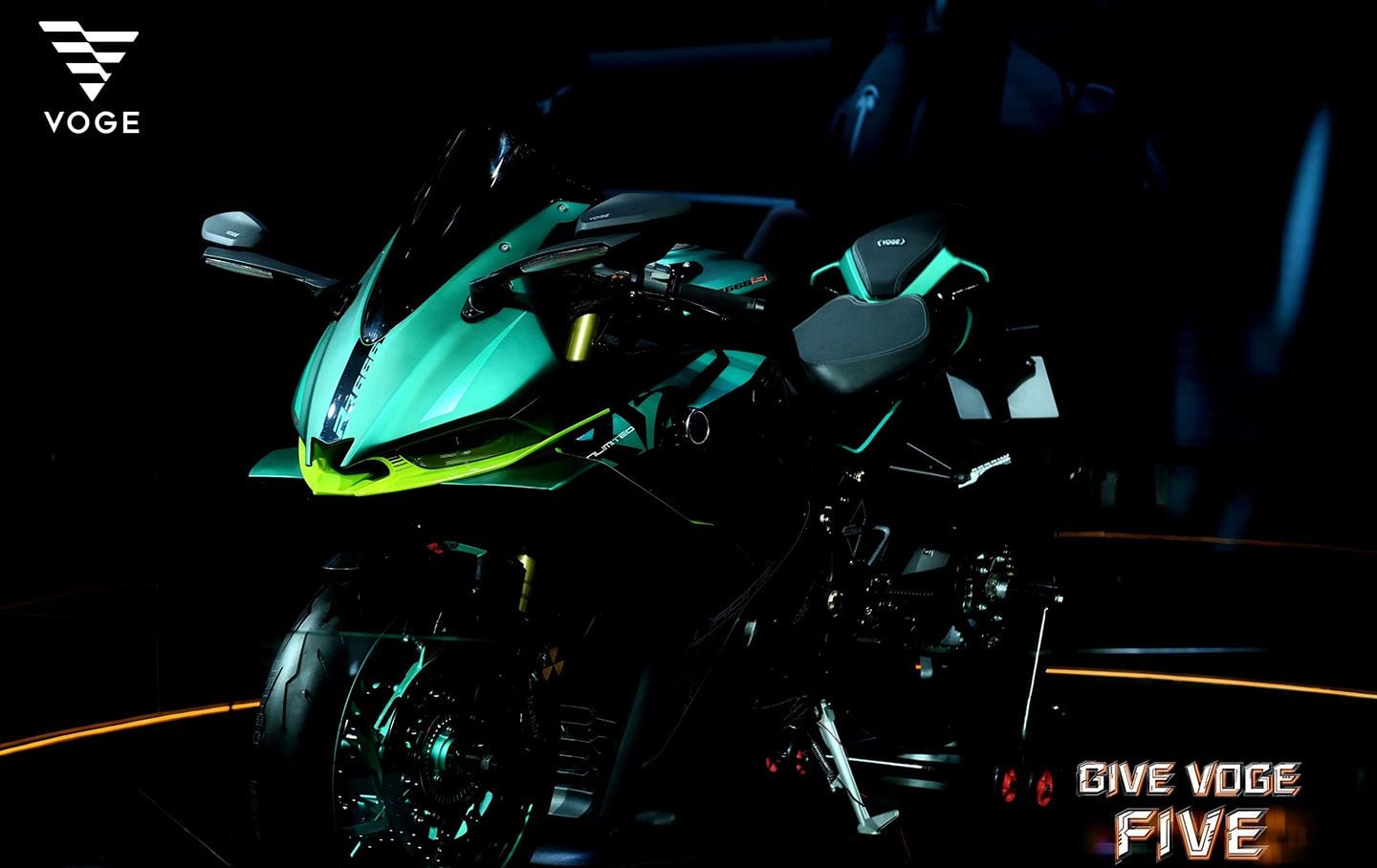
Vinto is a new company, not known outside of China. The engine, like many of the others, appears to be based on the Honda CBR650R. (Vinto/)Vinto GP660
We’re heading further into the unknown here; Vinto is a relatively new brand, even in China, and barely known outside that country. Its GP660, once again, features an engine with some distinct visual similarities to the Honda CBR650R motor, again promising around 100 hp.
The specs that have been revealed so far show it’s on roughly the same wheelbase as the SRK800RR and the CBR650R, and again there’s a single-sided swingarm and no shortage of MotoGP-style winglets. The GP660 even adopts the “stegosaurus” fins on the tail that have become the latest must-have in the top racing class, the first time we’ve seen them on a streetbike.
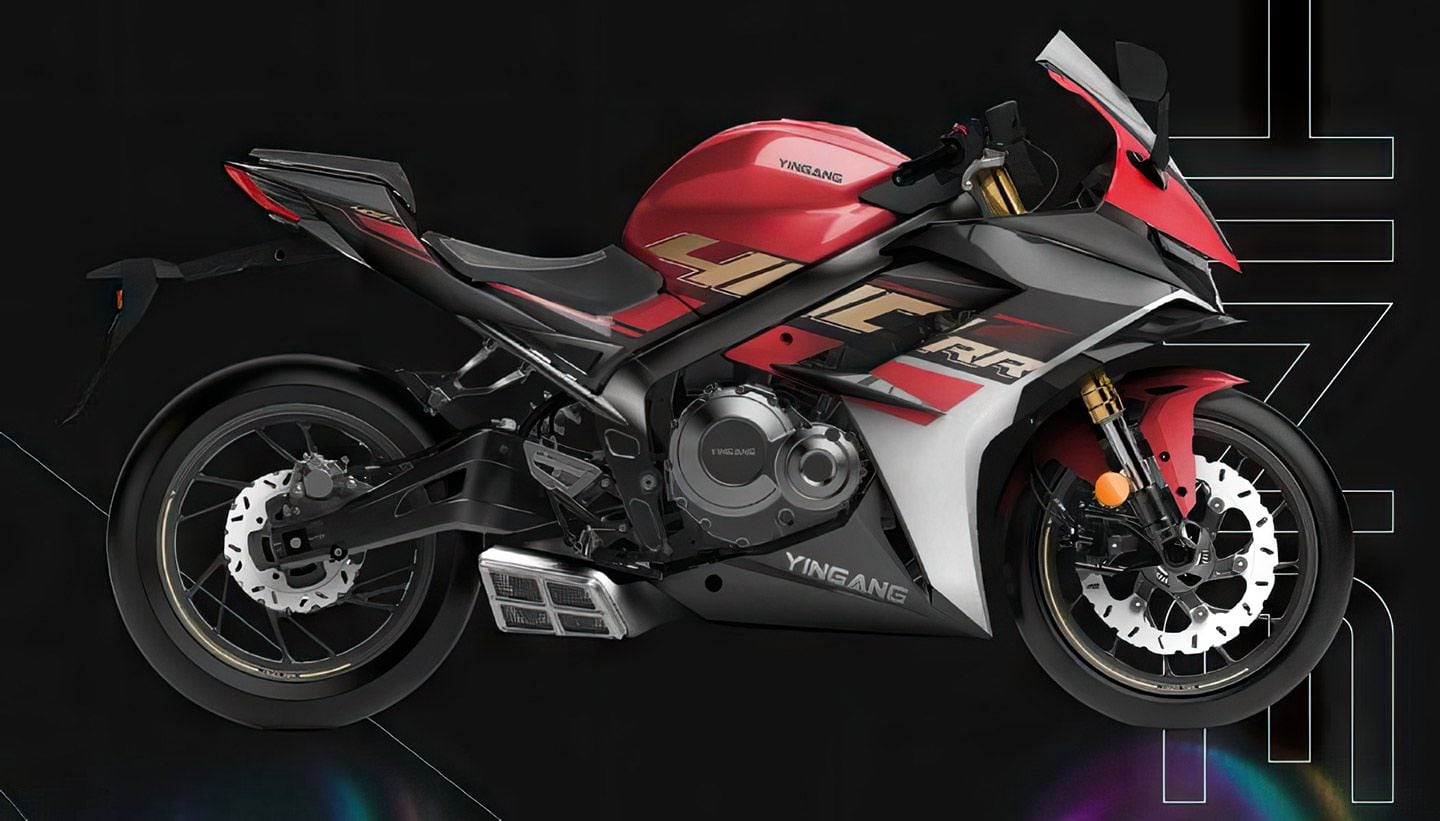
Unlike most of the 600cc-plus models shown, this inline-four is 400cc, aimed clearly at Kawasaki’s Ninja ZX-4RR. (Yingang/)Yingang 400RR
There’s still a lot of mystery around this one. Yingang showed its 400cc four-cylinder engine 12 months ago and now it has debuted the motorcycle built around it. It’s clearly designed to compete with the Voge 450RR and Kawasaki’s Ninja ZX-4RR, not to mention the soon-to-be-launched CFMoto 500SR, with Yingang claiming a peak of 54 hp at 11,000 rpm and 29 lb.-ft. of torque at 9,000 rpm.
The prototype shown at CIMA also featured keyless ignition and a TFT dash, but other details of the Yingang 400 are still scant at the moment, suggesting it could still be some way from being production ready.
-
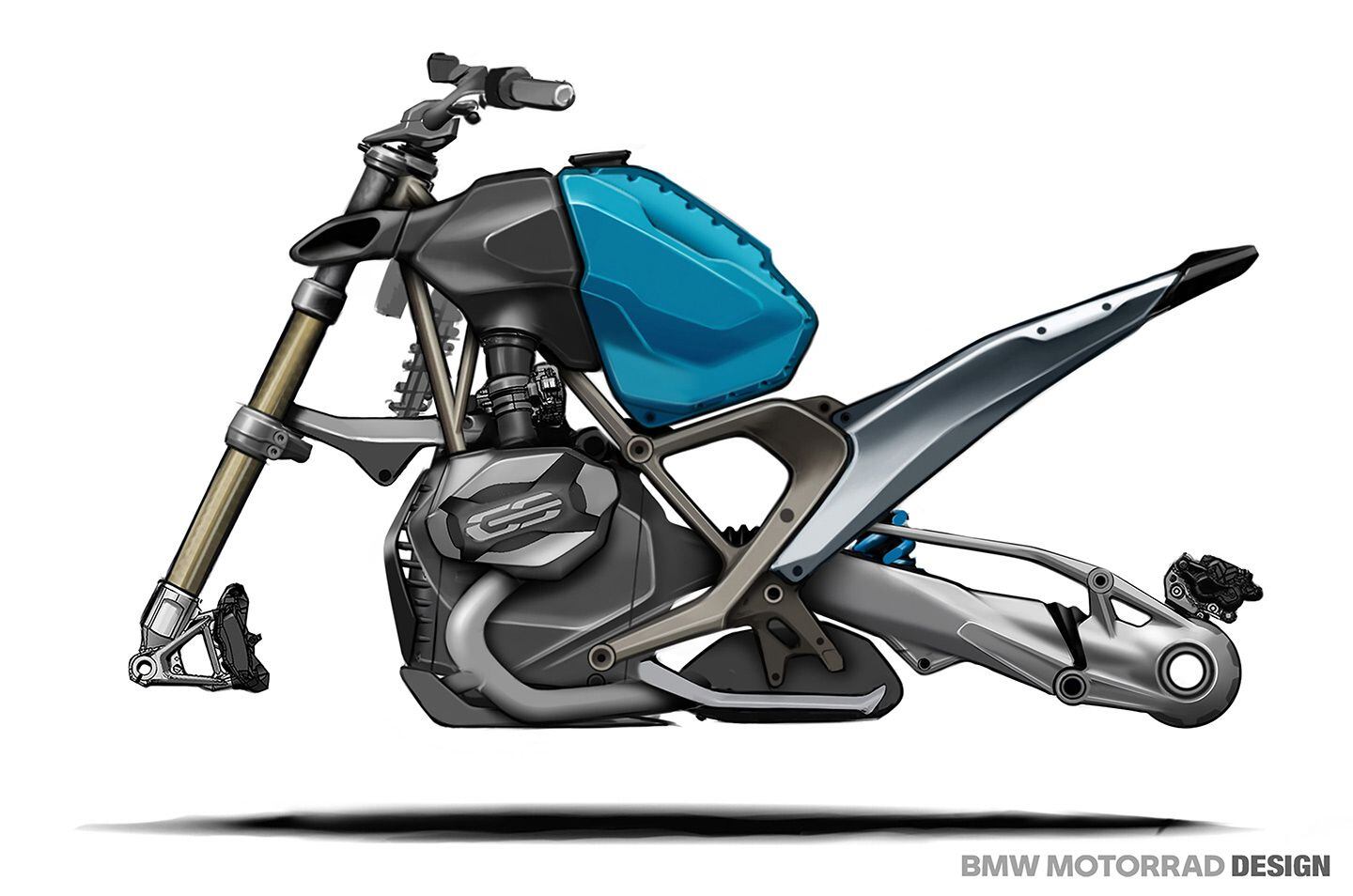
BMW has simplified and lightened its big-bore boxer adventure bike. The 2024 R 1300 GS is 26 pounds lighter than the R 1250 GS. (BMW/)“The bike looks smaller, very clean. It has a modern, easy shape.” Thus spoke Edgar Heinrich, BMW Motorrad’s design director, of the 2024 BMW R 1300 GS. He has been through four or five generations of the GS, saying, “I ride the bike often. Every time, the new one was so much better. Can we do this again?”
He was speaking to me in a phone meeting last Friday, accompanied by Reiner Fings, production manager, boxer models. When the photos of the new bike arrived, I saw that this 1300 is a new beginning. I saw a simple linear design, its engine very far forward. I saw all elements integrated. Previous machines have been workmanlike and capable, but seemed to have grown by addition—collections of separate elements.
“Is this a revolution?” I asked. Heinrich replied, “I would not say a revolution, but a bigger evolution.”
What has driven this comprehensive redesign, this “big evolution”? Heinrich replied, “Everybody is chasing, trying to do a GS.”
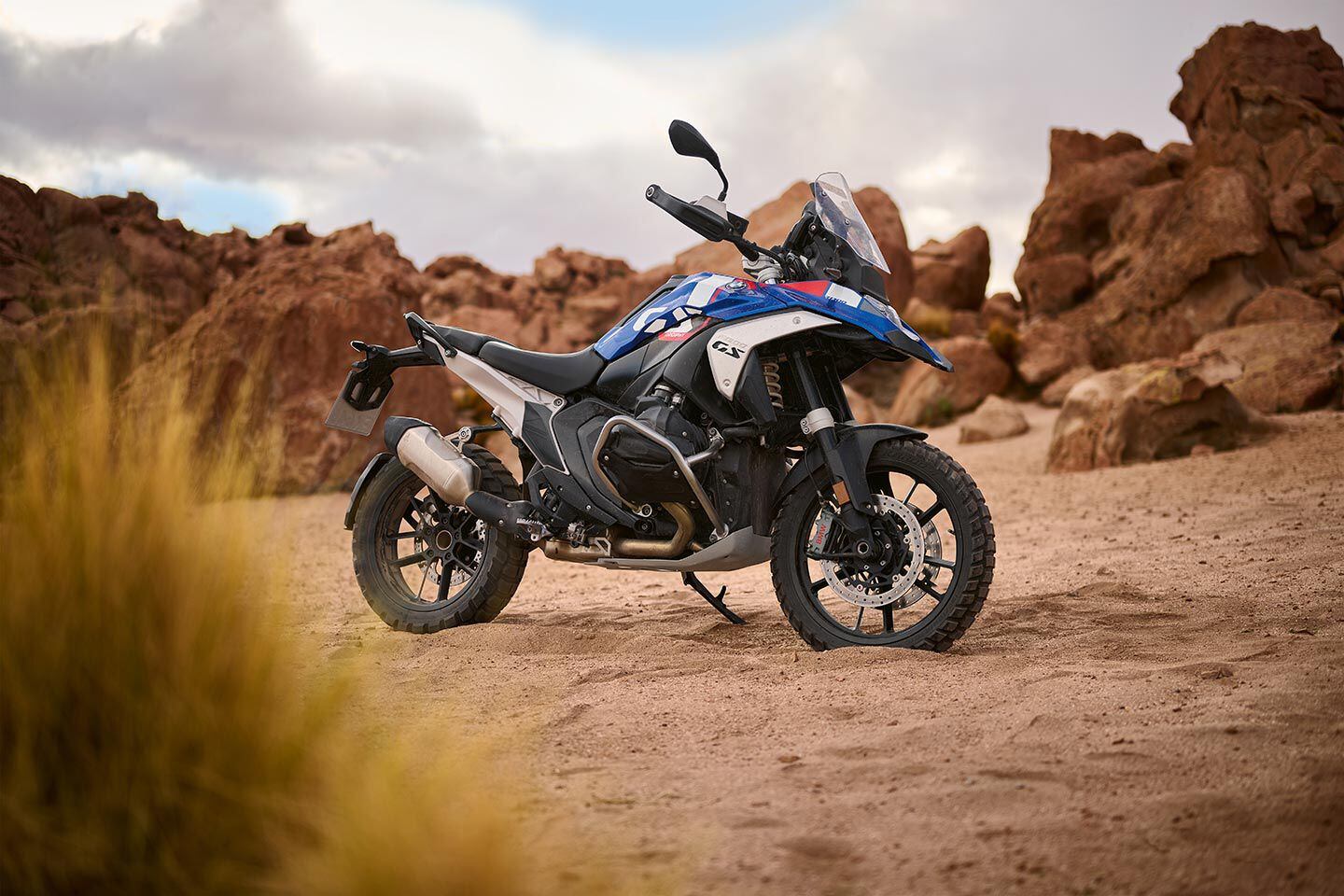
BMW’s R 1300 GS is slimmer thanks to a new engine and frame. (BMW/)He was referring to Harley’s new Pan America and Triumph’s Tiger 1200, among other newcomers. There is competition!
“The situation has always been the same,” he continued. “Everything adds weight. Performance is good but the bikes are heavy. We don’t want this circle! So at the top of the list is to lose weight.”
To accompany fundamental changes, there had to be a simpler, cleaner design.
BMW’s GS has for years defined the on/off-road segment, but others are seeking a share of that market. This means it is time for BMW to move the goal posts.
The new bike is 26 pounds lighter than the 1250 GS (“unladen” weight is 523 pounds), and now makes 145 hp at 7,750 rpm from its new bore and stroke of 106.5 x 73mm. Dimensions of the predecessor 1250 GS were 102.5 x 76. Although peak torque is 110 lb.-ft. at 6,500, the real story on torque is its width: From 3,600 to 7,800 rpm, more than 96 lb.-ft. of torque are continually available. Broad and strong. As the press release says, there is a “notable torque increase across the entire rpm range…”
Quoted performance is 0–100 kph in 3.39 seconds and a top speed “over 124 mph.” Others have estimated this as 140 mph.
Maximum engine speed is 9,000 rpm.
I was especially impressed that this engine, with its high 13.3 compression ratio and ShiftCam-driven four valves per cylinder, produces stroke-averaged net combustion pressures worthy of purpose-built racing engines. This is a solid benefit because it’s always more efficient to make power from combustion pressure than from friction-generating high rpm.
Two revolutionary changes are 1) the six-speed gearbox is now below the engine rather than behind it, allowing a modern forward weight bias and a longer swingarm. Lowering the gearbox has usefully reduced the angles through which the U-joints in the enclosed drive shaft must operate. This reduces the speed variation generated by Cardan joints.
And 2), the former tubular frame has been replaced by a sheet-metal shell frame that is stiffer while at the same time “optimizing installation space.” This means that the frame encloses necessary components, rather than competing with them for space.
Remember the principle of efficient structure: Move the material outward, away from the centerline. A tube is stiffer than a rod, and best of all are the fuselages of large aircraft—thin, large-diameter tubes.
How the R 1300 GS Makes More Power With the Same Efficiency
How can this large-bore twin breathe and burn as well as it does across a wide rpm range? The answer is not only BMW’s ShiftCam, but also in the way ShiftCam’s low-power mode is implemented. We expect engines that breathe especially well—as this 1300 does—to have narrow power because that requires tuning all design elements to work in the same narrow range. But ShiftCam gives this engine two natures by providing two different intake timings and valve lifts.
BMW chose to enlarge the bore and shorten the stroke for a specific reason: to make room for bigger, higher-flowing valves. Intakes were 40mm in the 1250, but have grown to 44mm in the 1300. In traditional design, big valves and ports often equate to weak bottom-end and midrange power, caused by the lower intake velocity being unable to fill the cylinder as well or to produce combustion-accelerating turbulence. ShiftCam prevents that loss by shortening valve timing and reducing lift at lower revs. Both increase intake velocity.
There is more. When ShiftCam operates in low rpm mode, the intake valves are given staggered opening timings that cause mixture entering the cylinder to swirl around the cylinder axis. This also contributes to speeding combustion, helping to maintain high torque.
Throttle bodies are 52mm and fuel capacity of the tank is 5 gallons.
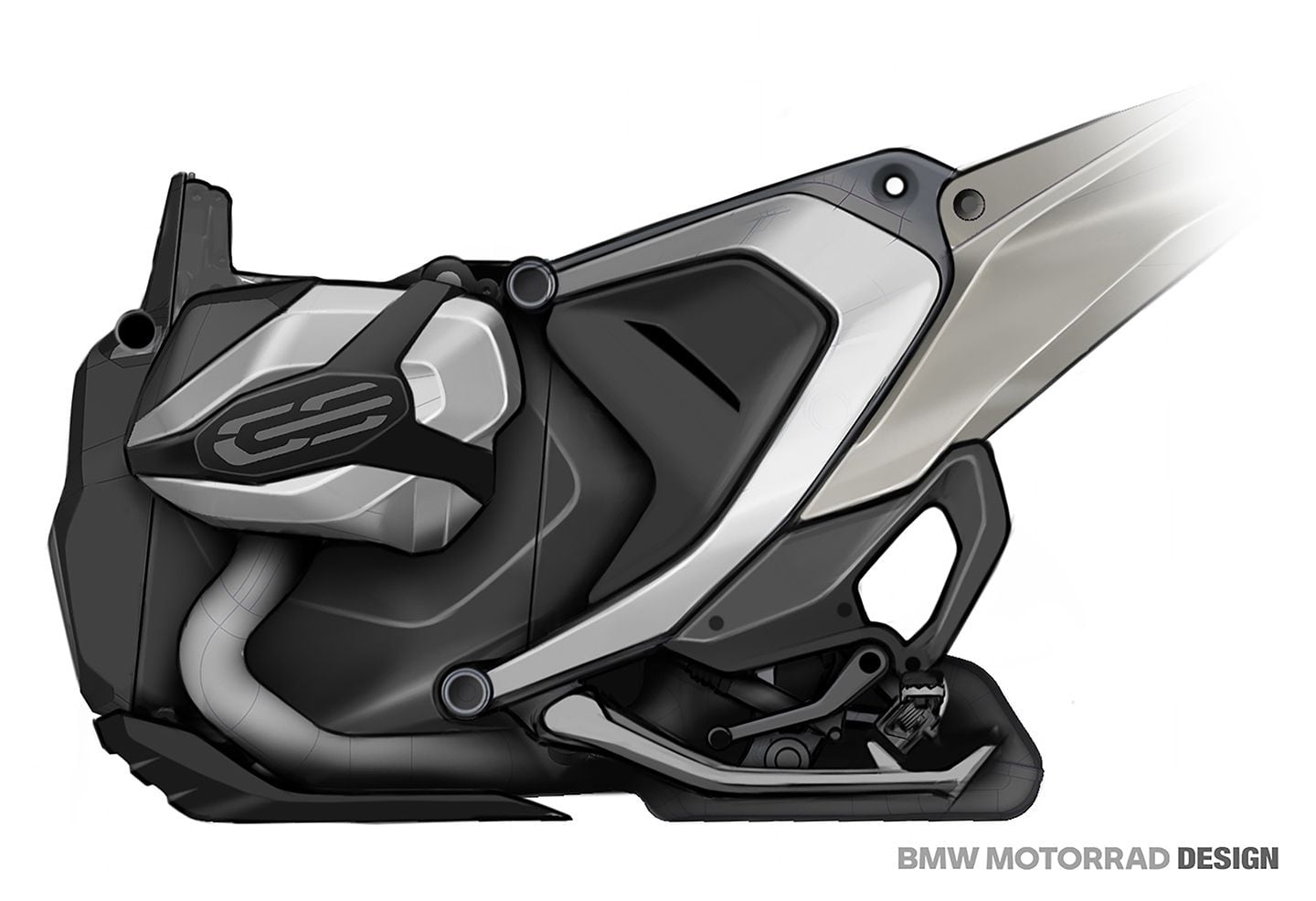
A shorter engine unit makes for tighter packing. (BMW/)Because we may occasionally get a tankful of substandard gas, the engine has a combustion knock protection feature; the shock waves of abnormal detonating combustion (knock or tinkle) are detected and the BMS-O engine control computer retards ignition timing whenever it occurs.
A rule of thumb tells us that peak combustion pressure is roughly seven times the pressure at the end of compression. This means that we can extract more useful energy from the fuel by raising compression ratio. Compression ratio is normally limited by the onset of detonation, but the 1300 GS engine has two strong defenses against this: 1) the fast combustion described above, and 2) the knock protection system. This has allowed the 1300′s compression ratio to be raised to 13.3:1. This increases torque (by boosting combustion pressure) and also makes the engine more efficient by taking more energy from the combustion gas, rather than letting that energy be wasted as exhaust heat. Mainly because of this, the 1300 gives the same fuel mileage as the 136-hp 1250. As the press release puts it, the result is “exemplary fuel consumption, emission levels, smoothness, and refinement.”
The closed-loop three-way exhaust catalyst (located under the engine) meets Euro 5 in its ability to reduce levels of unburned hydrocarbons, CO, and nitrogen oxides. Each cylinder’s stainless exhaust header pipe has its own oxygen sensor.
A wet slipper/assist clutch at the front of the engine has 10 friction discs. The assist feature, by using engine torque to increase pressure on the plates, allows a softer clutch pull. The slipper feature uses reverse torque to soften clutch engagement when rapidly decelerating to prevent engine-braking from dragging or hopping the rear tire.
A Lighter and Stiffer Chassis With Improved Rider Response
The managers I spoke with earlier emphasized the more precise feel and control of the new model. Recent motorcycles are a huge advance over what went before in this respect. We talked about the rider of the past, making a control movement on a bike of that time. The bars turn, but because they are rubber-mounted, the steering-crown at first does not. When the crown does turn, the fork tubes shift in their clamps (single pinch bolts). Finally the “message” reaches the tire footprint and the motorcycle begins to respond. That is steering delay. The new bike brings control “feel” and response closer to feeling like the bars are extensions of the front axle.
As one example, know that the front axle, which was 20mm in diameter, has become 25mm. Bending stiffness of tubes (for constant wall thickness) increases as the fourth power of diameter, so the new axle is potentially 2.4 times stiffer than the old.
Looking at the photos I noticed I could see right through the big hollow stub axle of the 1300′s single-sided swingarm. Looks like diameter (and therefore stiffness) is increased at that end as well. BMW describes the new swingarm as having a stiffer connection to the frame.
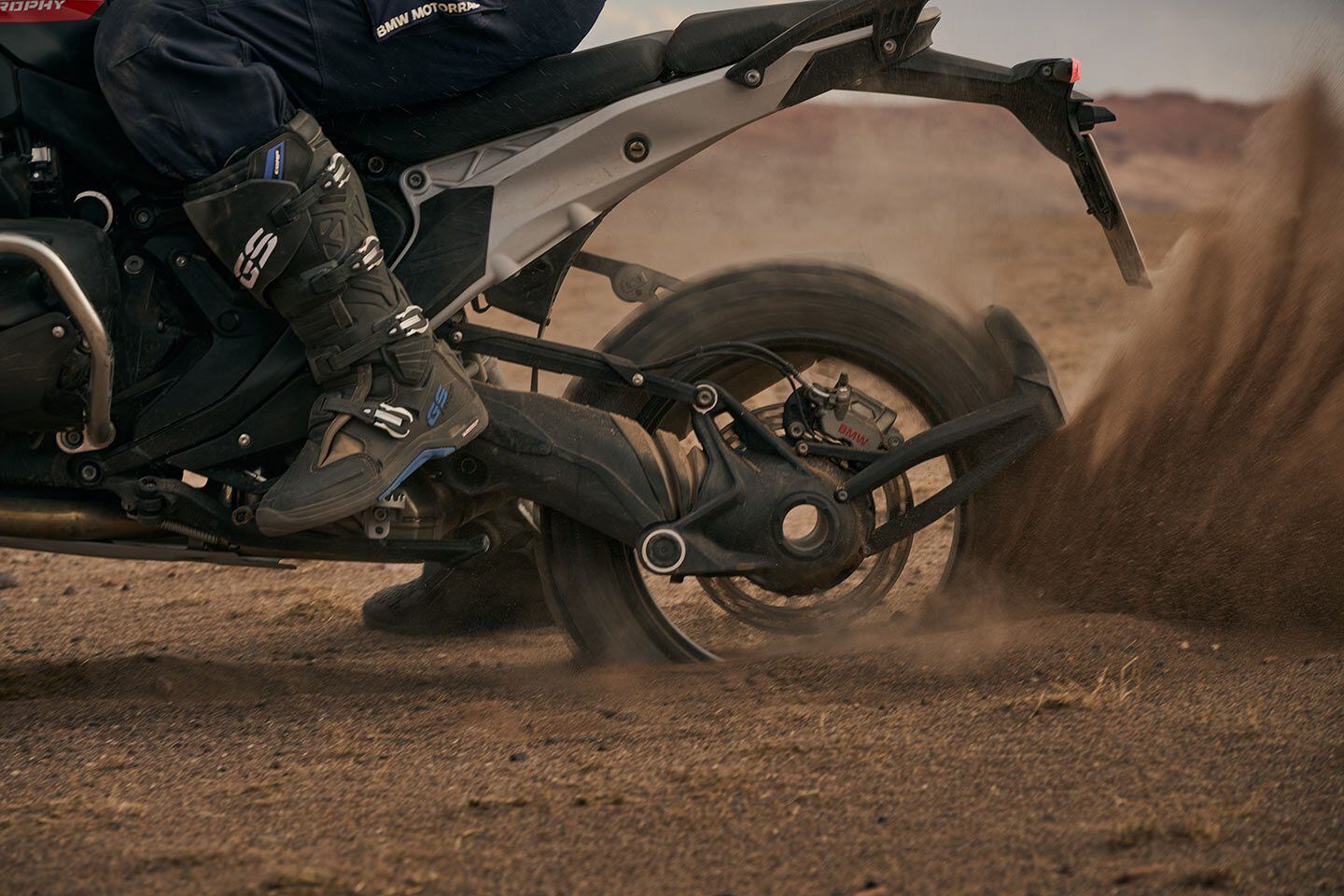
With the shorter engine comes a longer swingarm. Take a look at the diameter of that rear axle. (BMW/)Think of the change in chassis structure, from steel multi-tube to a sheet steel shell as analogous to enlarging a tubular axle.
The seat frame, formerly a tube structure, has been changed to an aluminum die-casting. In its stiffer bond with the main frame [there is an] increase in riding precision and stability. This is more of the same—making the motorcycle “more of a piece” gives prompt, accurate control.
There has also been a concerted effort to move components inward, to be grouped closer to the machine’s center of mass. This mass centralization reduces the effort required to set maneuvers into motion or to arrest them.
Past BMW boxer engines have had air/oil-cooling but the share of cooling performed by liquid has been increased in 1300. Where most liquid-cooled bikes have their radiator interposed between engine and front tire, on the 1300 GS rad location is offset to allow the more forward engine location.
The R 1300 GS’ Suspension Evolution
In the past the handlebar has attached directly to the upper fork crown of the Telelever front suspension and with suspension motion there has been a small amount of upper crown tilting (it attached to the frame with a ball joint). That was imperceptible on road bikes with less suspension travel and lower bars. Adventure-tour bikes require longer suspension travel and may have higher bars, accentuating the tilting of the upper crown. To prevent that, the 1300′s EVO Telelever upper crown cannot tilt as it turns on its own pair of bearings. Steering motion is linked to the fork tubes by a flexible stainless steel plate.
Steering geometry is rake 26.2 degrees, trail 4.4 inches. Wheelbase is 59.8 inches.
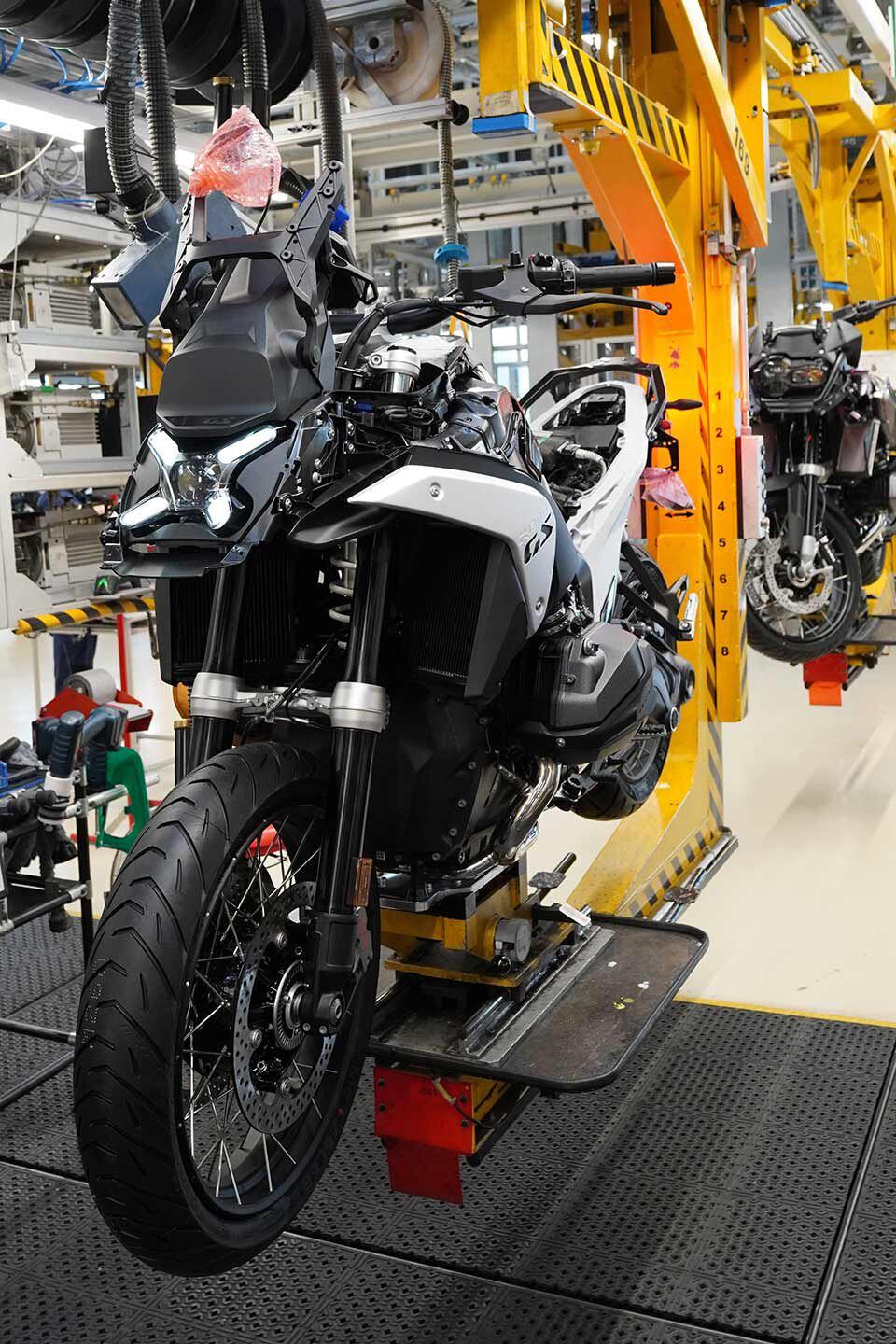
Front suspension travel is 7.5 inches. (BMW/)Suspension travel is unchanged from 1250 at 7.5 inches front, 7.9 inches rear. A Sports Suspension option adds 0.8 inch of extra travel front and rear, and is firmer. Three types of wheels are available in the 3.0 x 19F, 4.5 x 17R rim dimensions—cast aluminum, forged enduro, or cross-spoke (wire) wheels.
At the front are twin 310mm brake discs with four-piston calipers, and at the rear is a single 285mm disc. Integral ABS Pro and Dynamic Brake Control are standard.
Seat height tends to increase with suspension travel, and is 33.5 inches on the new model. With optional Adaptive Vehicle Height Control this reduces to 32.3 inches when stopped or moving slowly, allowing the rider’s feet to more easily reach the ground. City buses (and other ADV bikes) have had a similar height control feature for many years; R 1300 GS owners can now enjoy it as an option.
We have seen systems which allow suspension damping curves to be electronically altered either by rider choice or automatically, but such systems ignore the fact that for best performance, damping and spring rate must remain in correct proportion. The 1300′s optional Dynamic Suspension Adjustment alters spring rate as well as damping.
The optional Shift Assist Pro eliminates motion formerly lost in triggering the switch, making its action more direct.
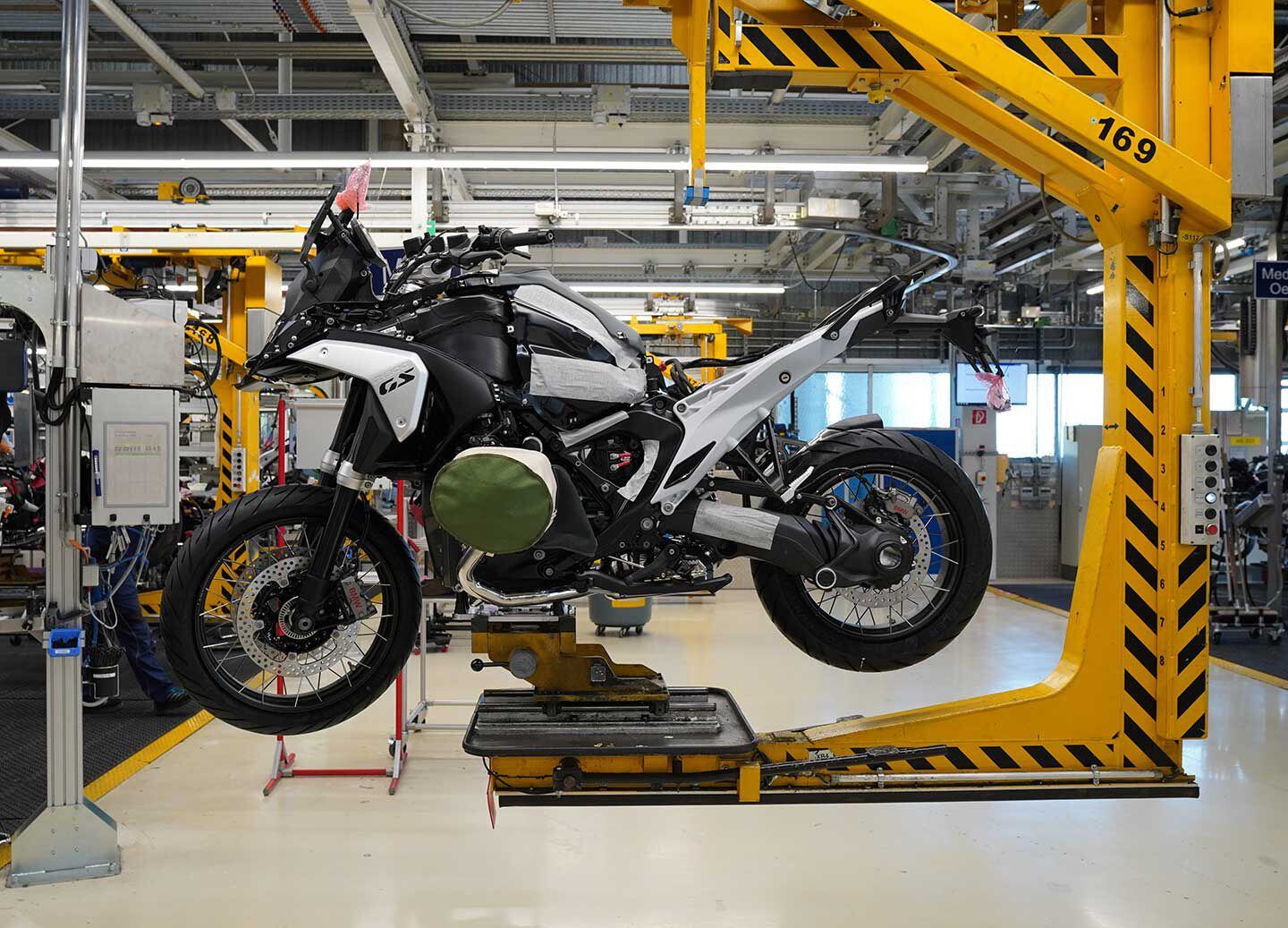
Getting “bigger and bigger” is no longer the way forward for BMW’s big boxer GS. (BMW/)I’m leaving most of the description of the electronics control and display to others, save to say that my informants Heinrich and Fings told me the goal in these areas was to simplify what can be a confusing task—finding what you want among so many choices.
In the words of 1300 Project Manager Jochen Beck, this machine stops the trend in adventure-tourers of “getting bigger and bigger.” The new 1300 GS is a balanced combination of valuable technological change with a fresh look.
-
The new bike offers more power, greater mass centralization, and a weight reduction of 26 pounds over the R 1250 GS.
-
 1
1
-
-
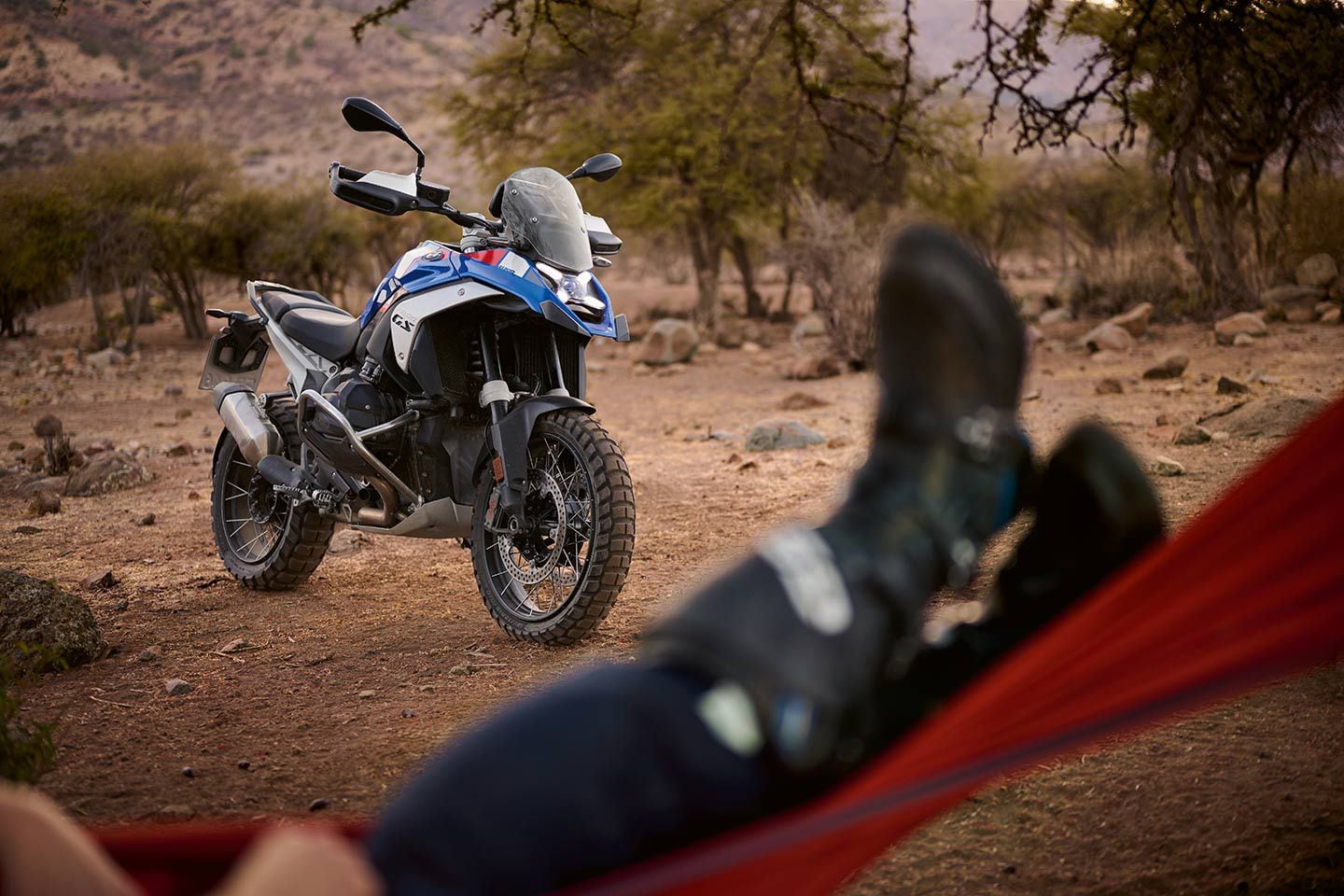
BMW’s R 1300 GS is lighter, leaner, and more powerful. Can it rule the adventure segment? (BMW/)BMW officially pulled the wraps off the long-rumored and highly anticipated R 1300 GS adventure motorcycle.The outgoing R 1250 GS was excellent and for many remained the standard of the class, but the ADV segment has seen a slew of new technology and features introduced across multiple manufacturers and the ol’ 1250 was starting to be left behind. For 2024, BMW’s R 1300 GS has increased power, reduced weight, new suspension, a new frame, and radar. It’s a nearly all-new GS and BMW is gunning to reclaim its position as king of the ADV mountain.
BMW R 1300 GS Engine
When talking about an R-model GS, you have to start with the big boxer engine. That horizontally opposed twin has defined the model for 43 years. Its broad power and torquey output character suited the demands of adventure motorcycling. Now, more compact overall dimensions house an exact 1,300cc displacement that delivers more GS power than ever before. How much power? A claimed 145 hp at 7,750 and 110 lb.-ft. of torque at 6,500. This increase comes largely from the new cylinder dimensions of 106.5 x 73.0mm—an increase of 4mm in the bore and a decrease of 3mm on the stroke. The bigger bore area makes room for larger valves (44mm intake and 35.6mm exhaust), and new cams help the new engine breathe its best. The new output numbers are 9 hp and 5 lb.-ft. more than the previous 1,250cc mill. BMW says that between 3,600 and 7,800 rpm there is a minimum of 96 lb.-ft. of torque available.
Related: Top Adventure Motorcycles for New Riders
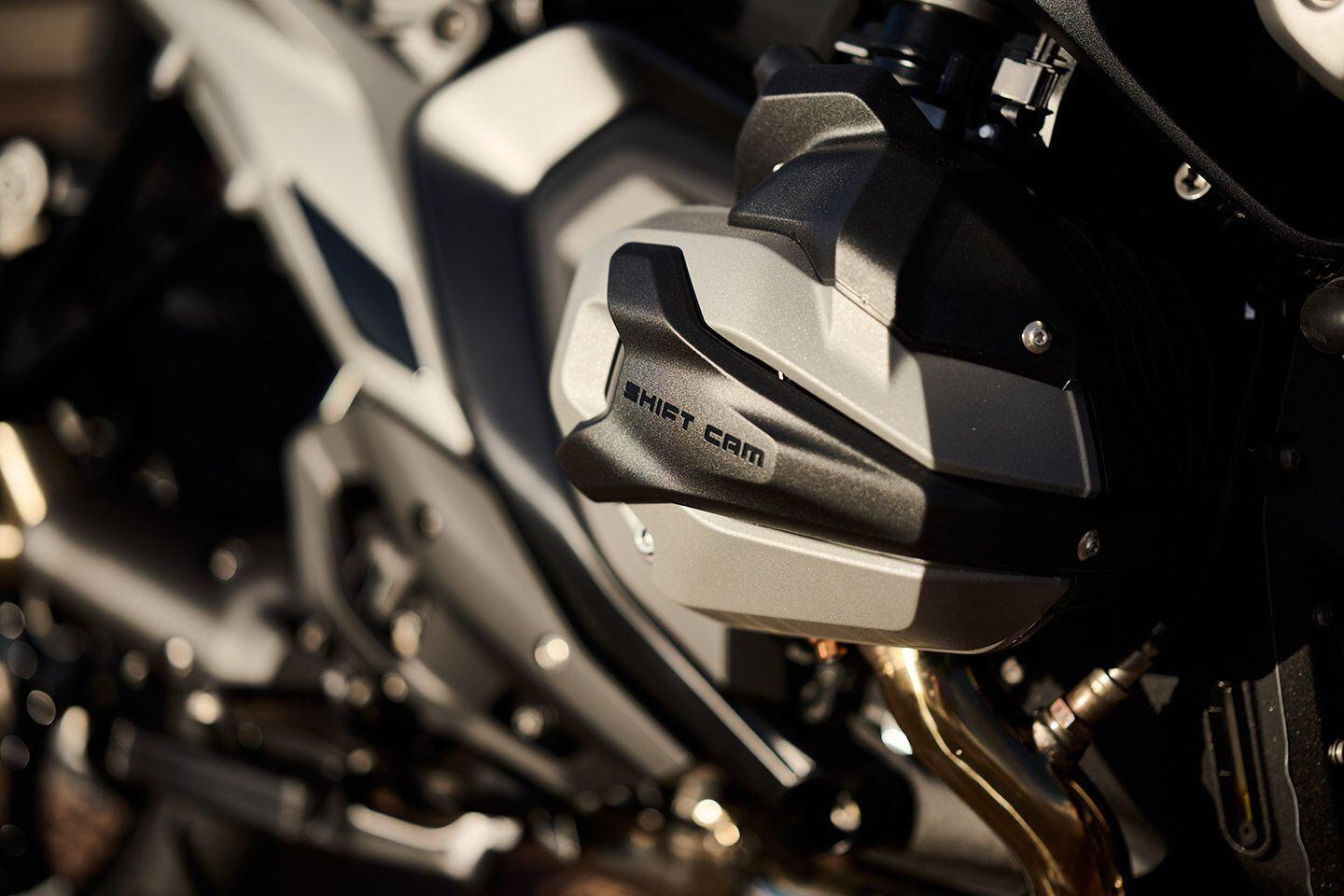
A new 1,300cc boxer produces 145 hp and 110 lb.-ft. of torque. (BMW/)As before, cylinder heads and other high-thermal-stress areas are liquid-cooled via a radiator, and air-cooling takes care of the rest to keep the liquid side of the equation more compact. DOHC cylinder heads use chain-driven cams with BMW’s ShiftCam tech that varies intake-valve timing and lift. The intake camshaft features a partial-load and full-load profile This improves fuel economy and smoothness while cruising and boosts output under heavy load.
Exhaust gases exit via a 2-into-1 stainless steel exhaust with a closed-loop catalyzer system controlled via an oxygen sensor. BMW says the R 1300 GS not only complies with current exhaust emission standards but also is equipped to meet future requirements.
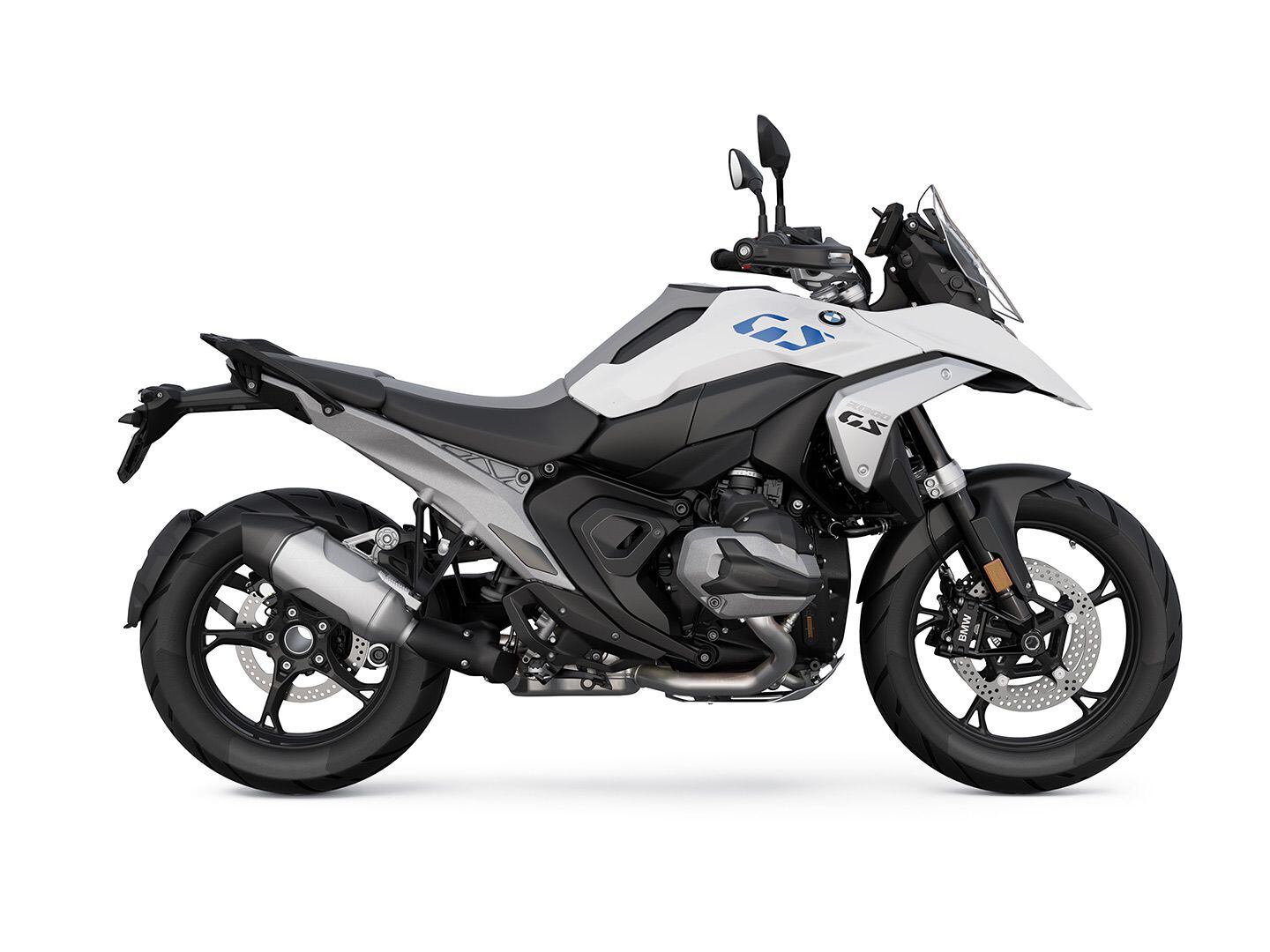
Base MSRP for the 2024 R 1300 GS is $18,895. (BMW/)New Underslung Transmission
The gearbox is relocated beneath the crankshaft and is integrated into the engine case. This reduced engine weight by 8.6 pounds, and cut a total of 14.3 pounds from the entire drivetrain. The change also reduces engine length and allows for shorter transmission shafts. What mass remains is now concentrated closer to the center of gravity for improved handling. The wet clutch has mechanical assist and slipper functions. Optional Shift Assistant Pro’s up-and-down quickshift action is said to be more precise and offer a more direct feel thanks to a torsional-magnet sensor/signal transmitter.
The driveshaft and rear axle assembly are redesigned to feature larger universal joints with decreased angles to reduce deflection of the rotating mass for improved durability. A longer rear axle stub makes for easier installation and removal of the wheel.
Electronic Rider Aids
Four standard riding modes tailor the engine’s response and power: Rain, Road, Eco, and Enduro. An optional Riding Modes Pro package adds three additional modes: Dynamic, Dynamic Pro, and Enduro Pro. Both Pro modes allow for extra customization of throttle response, traction control, and wheelie control. Additionally, the as-standard engine drag torque control (MSR) that limits rear wheel slip on deceleration can be adjusted in the Pro modes.
Braking via twin four-piston radial-mount front calipers and single two-piston rear caliper is linked by BMW Motorrad Full Integral ABS Pro. The front brake lever activates the rear brake and the same goes for the rear lever activating the front brakes. Both on- and off-road settings are linked to the ride modes, and the rear ABS can be deactivated in the ABS Pro settings. Additionally Dynamic Brake Control prevents unintentional throttle applications by reducing drive torque during braking to maximize braking power at the rear wheel.
Related: 10 Great Motorcycles for Travel 2023
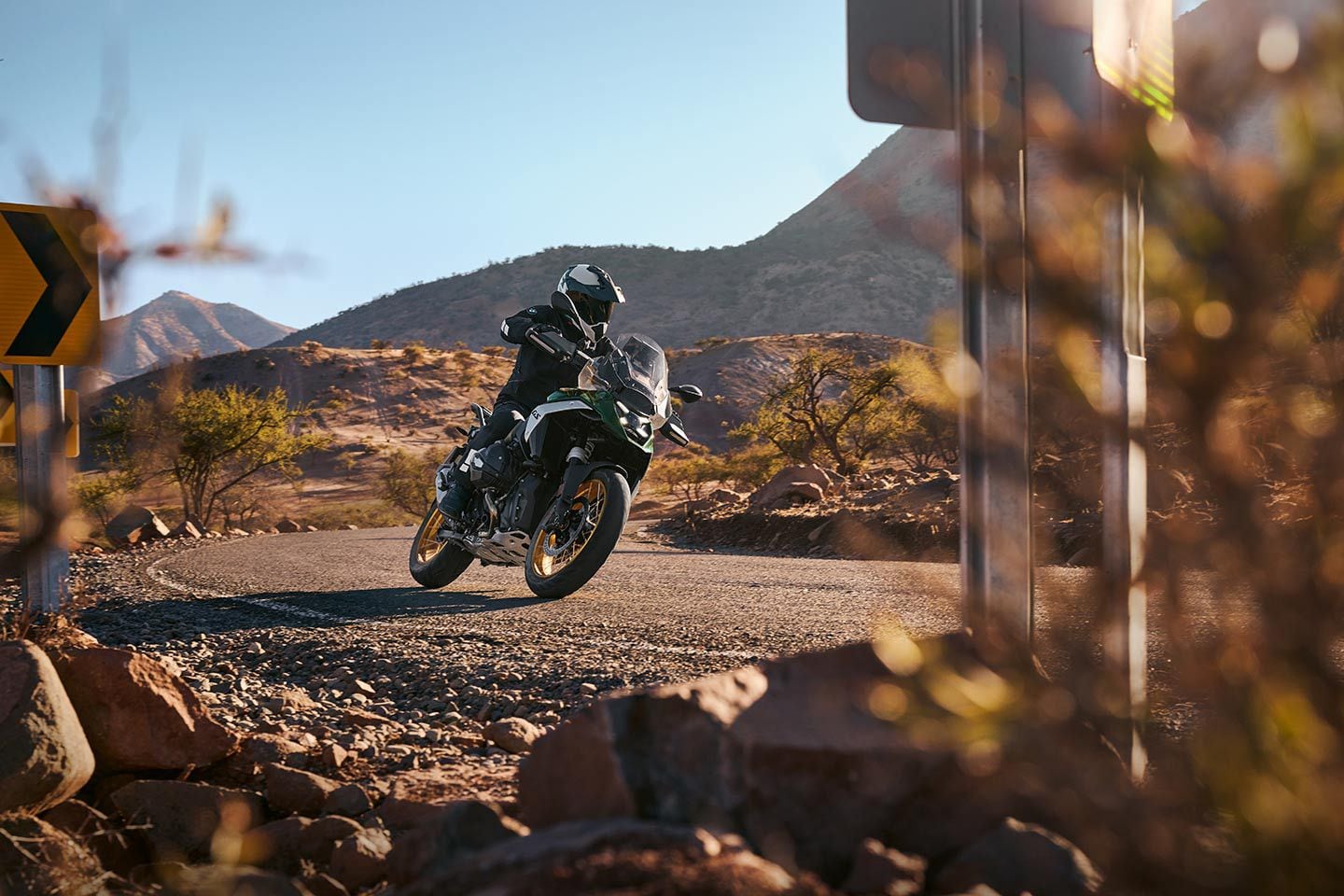
The list of electronic rider aids on the R 1300 GS is extensive. (BMW/)BMW has joined the radar-assisted club with its Active Cruise Control (ACC), Front Collision Warning (FCW), and Lane Change Warning (LCW) features. ACC allows the rider to set a speed and distance to the vehicle in front; the system then uses the front radar to measure distance to the vehicle and controls speed to maintain the preset gap. BMW says FCW uses braking intervention to help prevent collisions and reduce the severity of accidents. A rear radar sensor monitors behind the bike as well as the blind spots. If it is deemed dangerous to change lanes, the LCW system illuminates a warning in the left or right mirror.
The R 1300 GS features smartphone connectivity via a 6.5-inch TFT display. BMW’s Multi-Controller connects to a smartphone and Bluetooth headset to allow for media and phone functionality without the rider removing their hands from the bars. Add in BMW’s Motorrad Connected app and turn-by-turn arrow-led navigation will be displayed on the TFT screen. When switched to the Sport screen, bank angle, traction and braking behavior, a sports tachometer, and gear indicator are displayed.
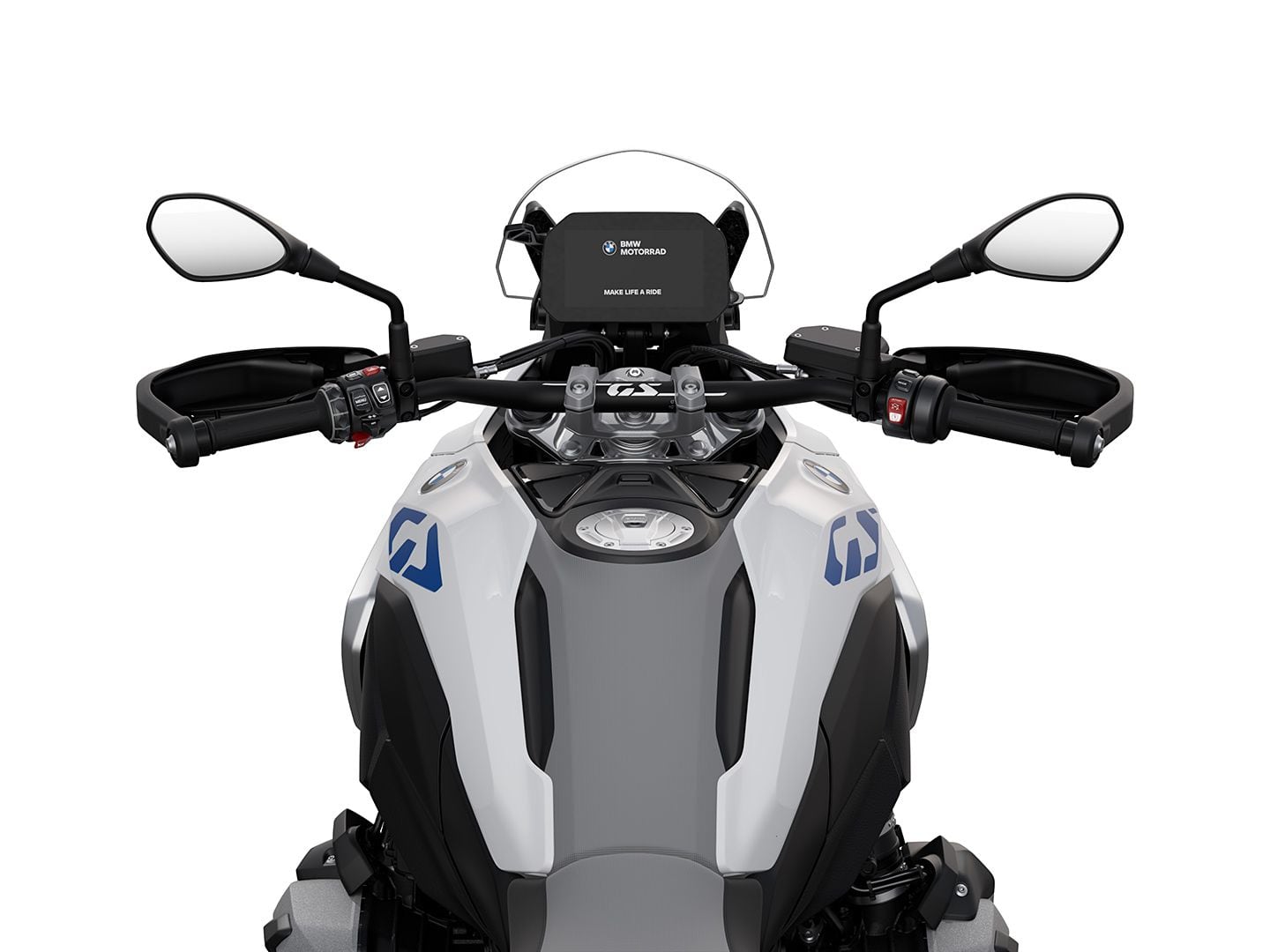
A 6.5-inch TFT connects the rider’s smartphone to the bike and is used to adjust rider preferences. (BMW/)The free BMW Motorrad Connected app informs the owner of service status and warnings, including a Battery Guard feature that monitors the li-ion 12-volt battery’s state of charge. Fuel level, remaining range, and bike mileage are also relayed. In the event of an accident, BMW’s eCall system (Intelligent Emergency Call) is standard equipment and aims to get help to the scene as fast as possible. When a fall is detected the BMW call center is automatically connected to make contact with the rider if possible. The system can also be activated manually via an SOS button.
New Steel Frame and Aluminum Subframe
A new steel sheet-metal frame increases chassis stiffness in a more compact package. The previous model’s tubular-steel subframe has been replaced by a die-cast aluminum unit. This gives the GS a short and slim rear end that is also stiffer. This stiffness increases riding precision and stability.
Suspension
For 30 years BMW’s big boxer GS has used some form of Telelever front suspension, and that continues with this new EVO Telelever matched to a new rear EVO paralever suspension. At the front, the EVO Telelever combines the stiffness and direct steering feel from sporty models such as the R 1200 S and HP2 with the stability of previous GS boxer models. The new system clamps tightly to the fork tubes (like the sporty models) but is decoupled with a flex element to prevent the tilting movement that was not noticeable on the streetbikes but would be detrimental with the longer wheel travel and tall bars of a GS. With this design the EVO Telelever offers greater rigidity and ride stability while producing excellent steering precision. (Look for a Kevin Cameron article explaining all of the geometry and construction soon.)
BMW’s new EVO paralever rear end has a significantly stiffer connection to the frame and has been extended for improved traction. Wheel travel is 7.5 inches at the front and 7.9 inches at the rear.
Related: Cycle World Ten Best Bikes 2022
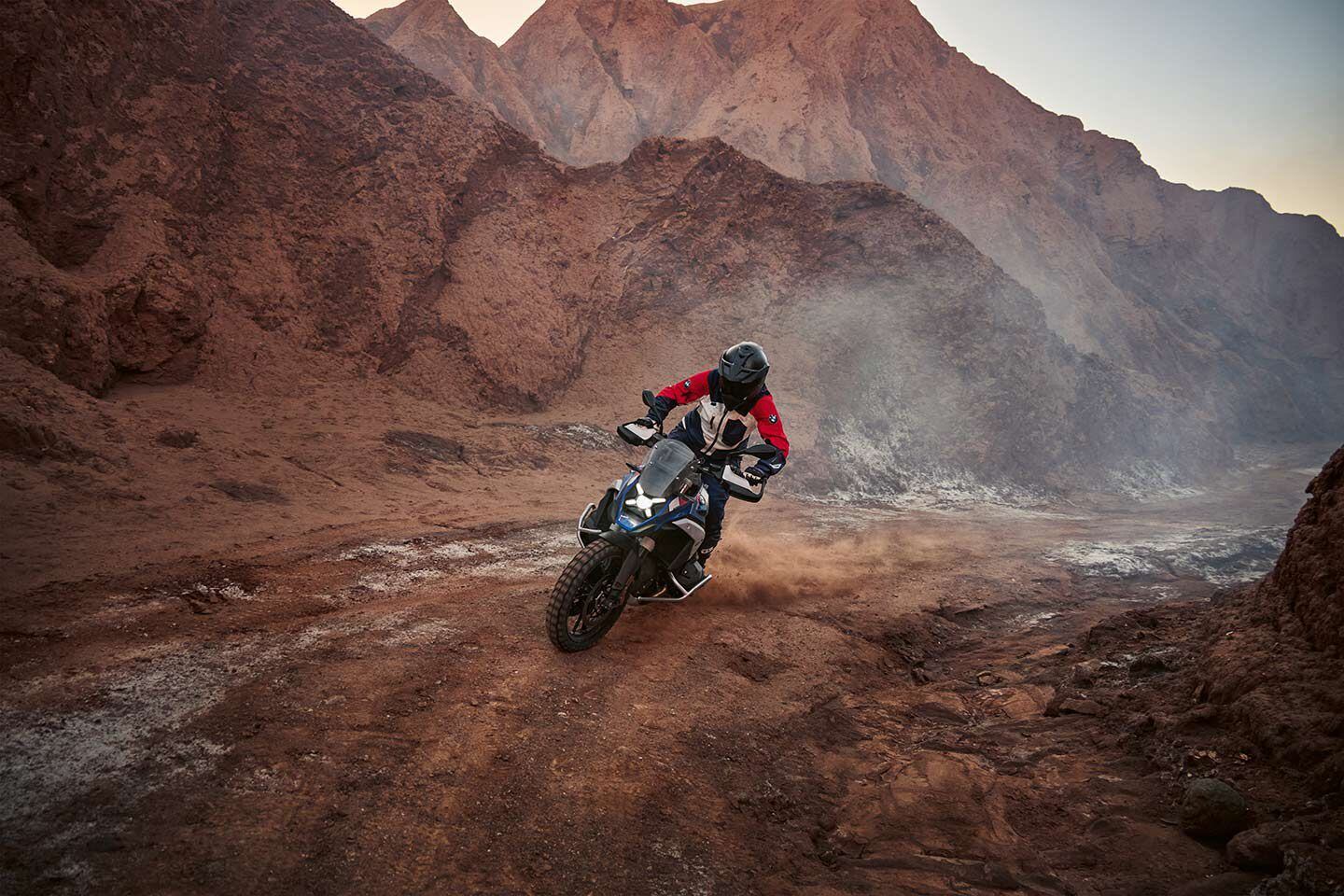
BMW’s new EVO Telelever promises sharper handling from the 2024 R 1300 GS. (BMW/)Optional Dynamic Suspension Adjustment (DSA) replaces BMW’s Dynamic ESA Next Generation electronic suspension, going one step further in the dynamic adjustment of damping and spring preload. Now, depending on the selected riding mode, riding condition, and maneuvers, DSA dynamically adjusts front and rear damping along with a corresponding spring rate adjustment. BMW says this offers a higher level of ride safety, performance, and comfort no matter vehicle load with a passenger or luggage. Usability is simplified with improved integration within riding modes, but DSA can also be individualized in the vehicle settings menu.
Along with the optional DSA, a new adaptive vehicle ride height control and sport suspension are available.
The adaptive ride height system offers fully automatic adjustment of ride height depending on the conditions. Seat height is reduced from 33.5 inches to 32.3 inches during slow riding and at a standstill. BMW claims the adjustment up and down “happens quickly and almost imperceptibly.” The rider can customize automatic adaptive ride height operation, or choose between permanently low and permanently high settings.
With the optional sport suspension, the R 1300 GS gets a more off-road-based setup with 0.8 inch more travel at the front and rear. Settings are firmer and specially developed for off-roading.
R 1300 GS Design
While slimmer than previous models, the 2024 R 1300 GS is immediately recognizable as the next-generation GS. It strikes a more enduro-like silhouette with a flatter aluminum fuel tank with an upholstered cover that extends from the 33.5-inch-tall standard seat. A new LED headlight integrates the high and low beams into a single projector unit surrounded by four LED running lights in an X pattern. Overall, the R 1300 GS has shed 26 pounds from the previous model, but it looks even lighter than that.
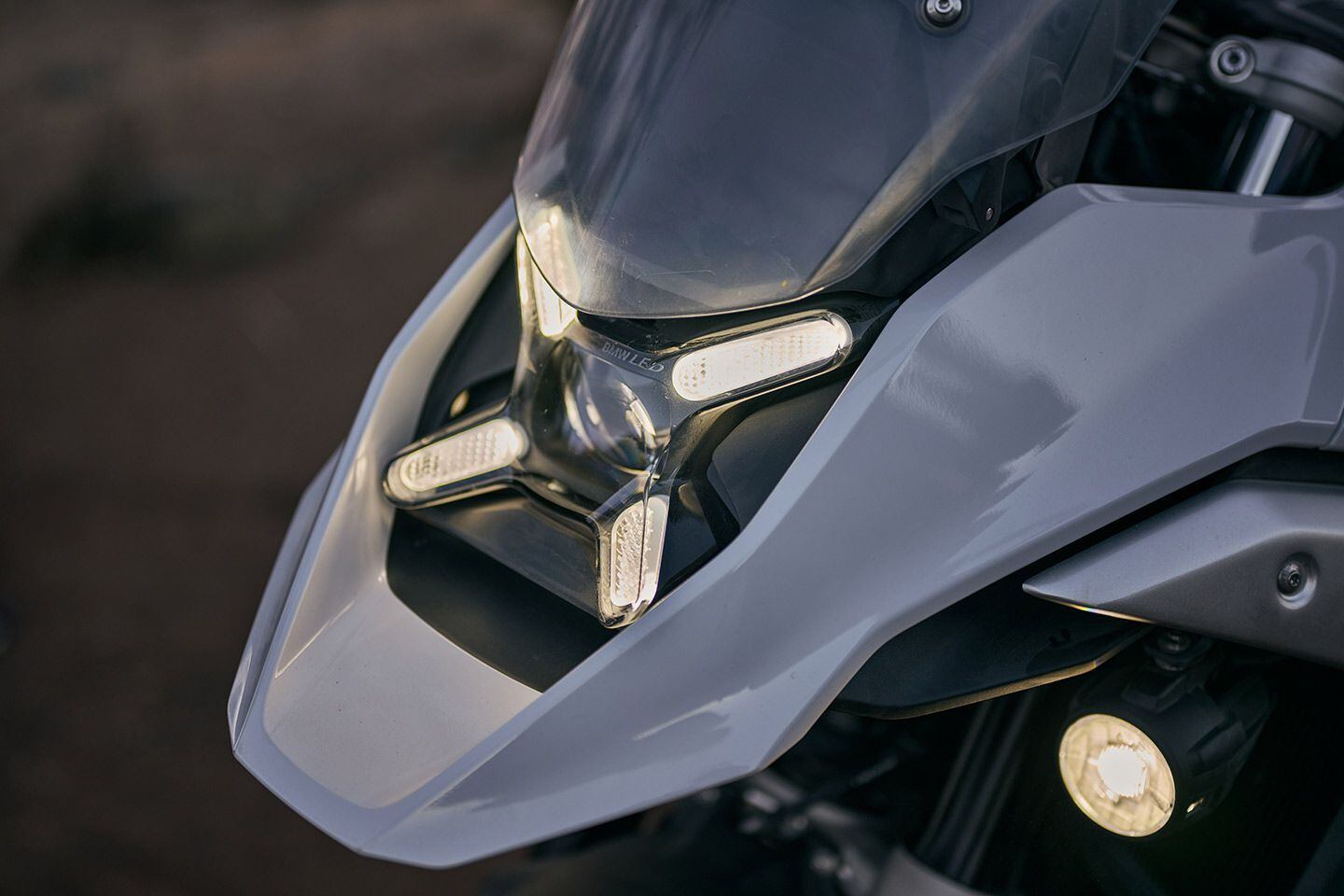
BMW’s R 1300 GS gets a new LED headlight that integrates the high and low beams into a single unit. (BMW/)BMW says the ergonomic triangle of the R 1300 GS has been optimized for a “sporty, yet relaxed riding position.” An optional handlebar riser is included in the Enduro Package Pro to suit off-road riding. Four optional seat heights, three different footpegs, comfort handlebars, and accessory hand and foot levers are offered to suit riders’ varied body types and riding needs.
Pricing and Variants
Base model price for the 2024 R 1300 GS is $18,895 and the bike is expected to arrive at dealers in early 2024. BMW almost never offers the base model at the dealer. Typically customers want more features, and packages are listed below, although prices for these are not yet released.
- <b>Premium Package</b>: Headlight Pro, DSA, Riding Assistant, Shift Assistant Pro, Riding Modes Pro, Sport Brakes, central locking, preparation for navigation, chrome-plated exhaust manifold, Vario side and top case mounts, hand protector extension
- <b>Comfort Package</b>: Electrically adjustable high windshield, centerstand, comfort passenger seat, comfort passenger footrests, luggage carrier
- <b>Enduro Package Pro</b>: Handlebar risers, engine protection bars, enduro aluminum engine guard, short enduro handlebar levers, GS adjustable rider footrests, exhaust mount for single seat, adjustable foot brake and gearshift levers, large frame guards, tight-fitting turn signal stalks
In addition to the base R 1300 GS, there are three variants: a Triple Black which gets the black-out treatment of most surfaces and has cast wheel for extra attitude; the GS Trophy that features cross-spoke wheels along with a slew of off-road ready parts and a Racing Blue Metallic color scheme; and the Option 719 Tramuntana that comes with “rich” colors and finishes.
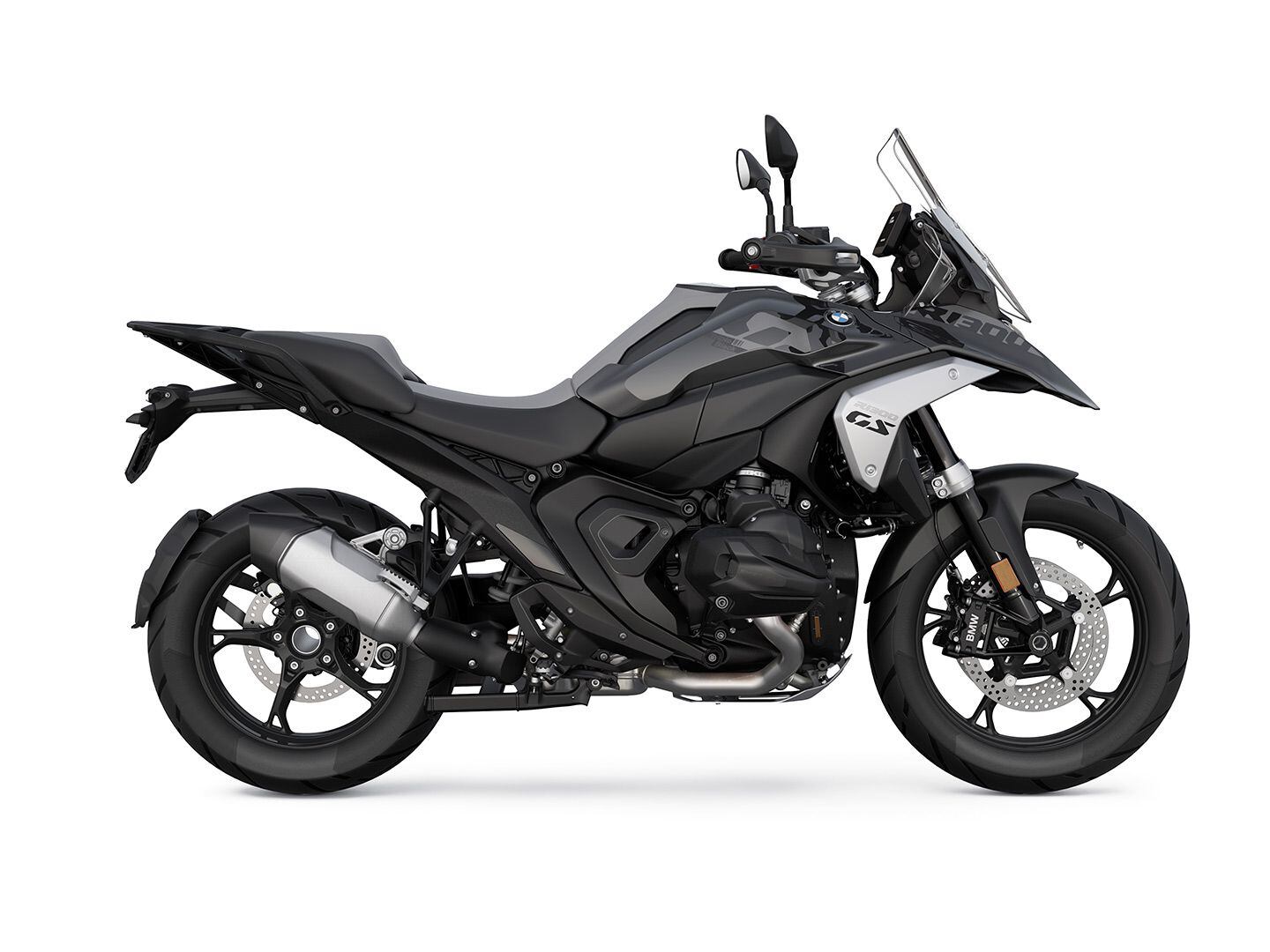
Triple Black variant of the 2024 BMW R 1300 GS. (BMW/)We look forward to finding out if the 2024 R 1300 GS makes good on the promise of higher performance, better handling, and a slimmer fit. From the looks of it here, BMW has put the ADV world on notice that the king is back to reclaim the throne. Stay tuned for a first ride review late October 2023.
2024 BMW R 1300 GS Specs
MSRP: $18,895 Engine: DOHC, air/liquid-cooled, four-stroke flat twin w/ BMW ShiftCam Displacement: 1,300cc Bore x Stroke: 106.5 x 73.0mm Compression Ratio: 13.3:1 Transmission/Final Drive: 6-speed/chain Claimed Horsepower: 145 hp @ 7,750 rpm Claimed Torque: 110 lb.-ft. @ 6,500 rpm Fuel System: Electronic intake manifold injection Clutch: Wet, slipper function; hydraulic activation Frame: Steel sheet metal; aluminum subframe Front Suspension: BMW Motorrad EVO Telelever, central spring strut; 7.5 in. travel Rear Suspension: BMW Motorrad EVO paralever; 7.9 in. travel Front Brake: 4-piston radial calipers, dual 310mm discs w/ BMW Motorrad ABS Pro Rear Brake: 2-piston floating caliper, 285mm disc, BMW Motorrad ABS Pro Wheels, Front/Rear: Light alloy cast; 19 x 3.00 in. / 17 x 4.50 in. Tires, Front/Rear: 120/70R-19 / 170/60R-17 Rake/Trail: 26.2°/4.4 in. Wheelbase: 63.8 in. Seat Height: 33.5 in. Fuel Capacity: 5.0 gal. Claimed Wet Weight: 523 lb. Contact: bmwmotorcycles.com -
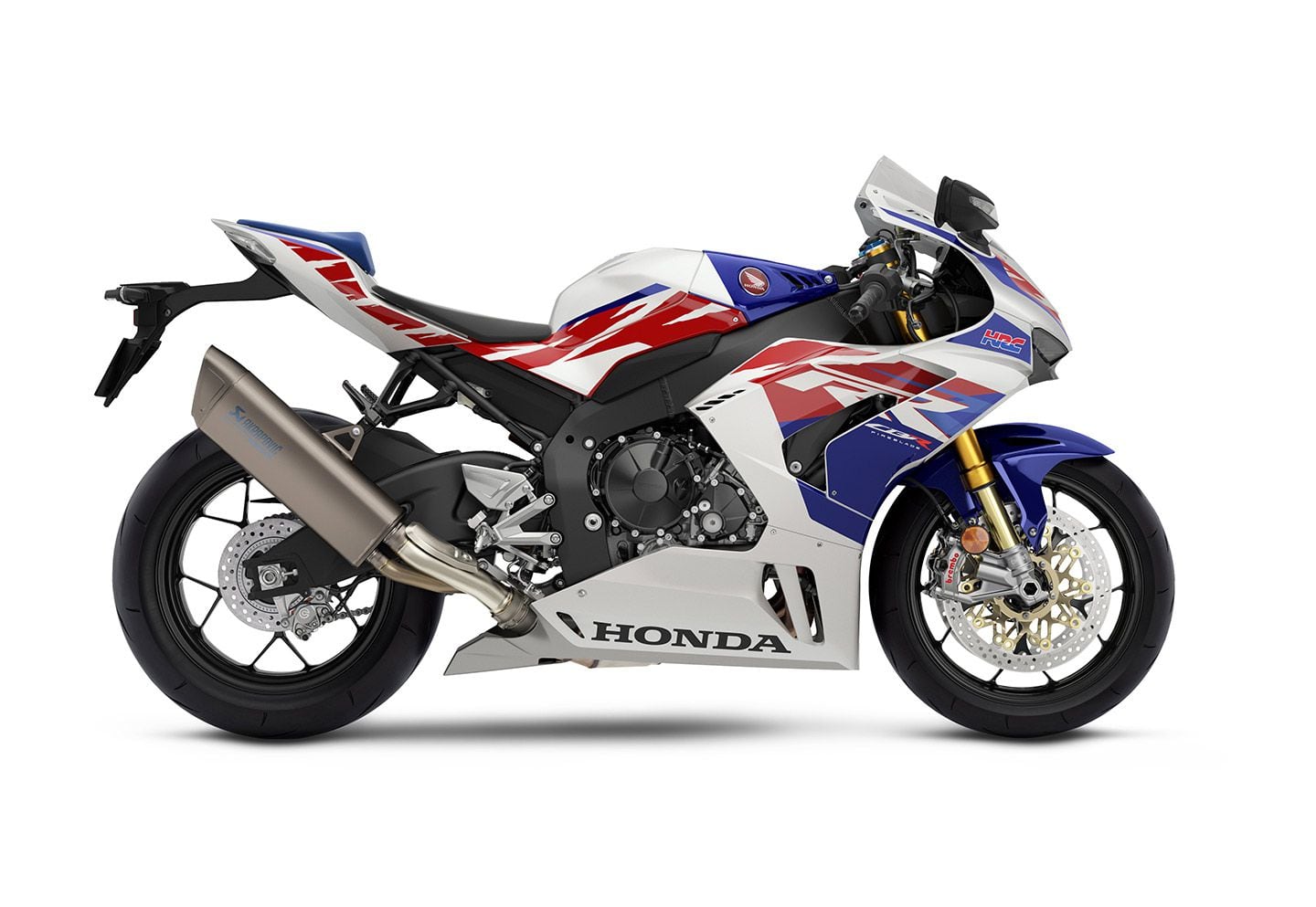
2023 Honda CBR1000RR-R Fireblade SP. (Honda/)Ups
- The CBR1000RR-R Fireblade SP is Honda’s single-minded pursuit of production-class racing glory
- The engine uses the same bore and stroke (81.0 x 48.5mm) as the RC213V MotoGP racebike, emphasizing the depth of HRC’s involvement
- Dripping with ‘Blade nostalgia, the striking paint scheme was designed by Hiroaki Tsukui who was also responsible for the original 1992 design.
Downs
- The US-spec model’s output is limited to 186 hp at the crank. Who wants to spend top dollar and not get all the goods?
- Uncompromising seating position
- Where’s a rider supposed to put the key fob when wearing one-piece leathers?
Verdict
The pinnacle of Honda’s CB lineage, the CBR1000RR-R Fireblade SP is an HRC-developed, uncompromising race replica with significantly more performance than the CBR1000RR that American Honda continues to sell. For a production Honda motorcycle, it’s as rarefied as they come. The only problem? In the US, output is limited to 186 hp at the crank, and less when measured at the rear wheel.
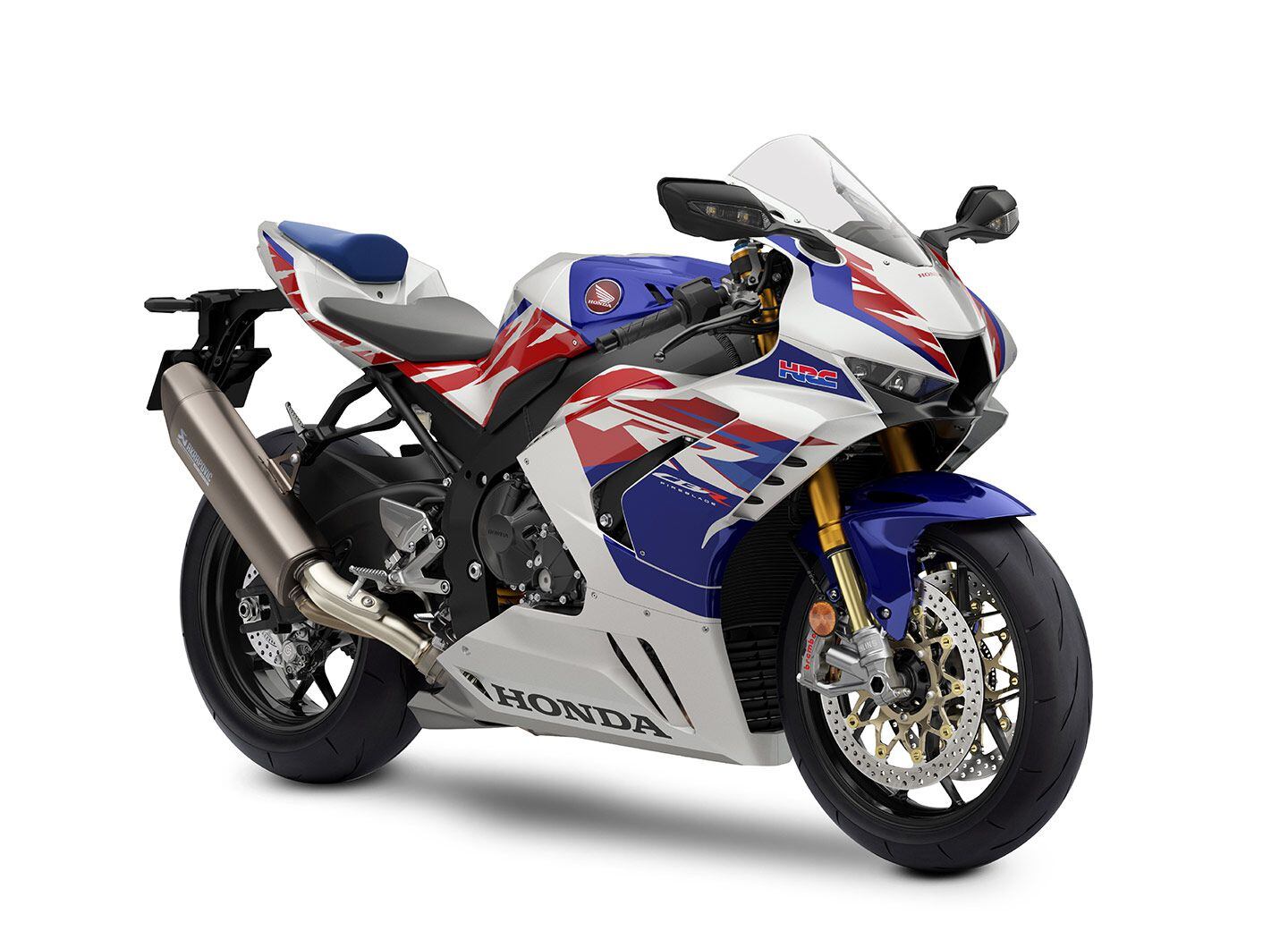
The CBR1000RR-R Fireblade SP’s anniversary livery is about as good as it gets. (Honda/)Overview
The 1992 Honda CBR900RR is easily one of the most significant motorcycles of its day. As CW’s first prescient analysis said back in 1991: “It is a motorcycle that promises to change forever the way big-bore sportbikes are conceived and built.”
Its first comparison test—against the Yamaha FZR1000 and Suzuki GSX-R1100—confirmed the veracity of that statement. On the CW scales, the CBR weighed 76 pounds less than the FZR and 94 pounds less than the GSX-R. That first ‘Blade was the shot heard round the world, transforming the economy of two-wheeled performance in much the same way the Honda Interceptor and the original Suzuki GSX-R750 did the decade before.
Thirty years later, it’s difficult to conceive of a motorcycle so technically beyond the competition that it inspires such a sea change. Still, the Honda CBR1000RR-R Fireblade SP is a credit to Tadao Baba’s legacy.
At $28,900, the Triple R is as expensive as the European competition with performance to match. From the highest-spec electronic suspension to integrated aero and a screaming inline-four powerplant, the CBR is Honda’s purest performance weapon. Undoubtedly, the latest CBR was built to win. While the World SBK crown has thus far evaded capture, Honda won the 2022 and 2023 Suzuka 8 Hours.
The fly in the ointment, however, is that the US-spec Triple R comes stateside with output limited to 186 hp. In a highly competitive field, coming to the fray with one hand tied behind its back is very unfortunate.
Related: Fastest Bikes You Can Buy in 2023
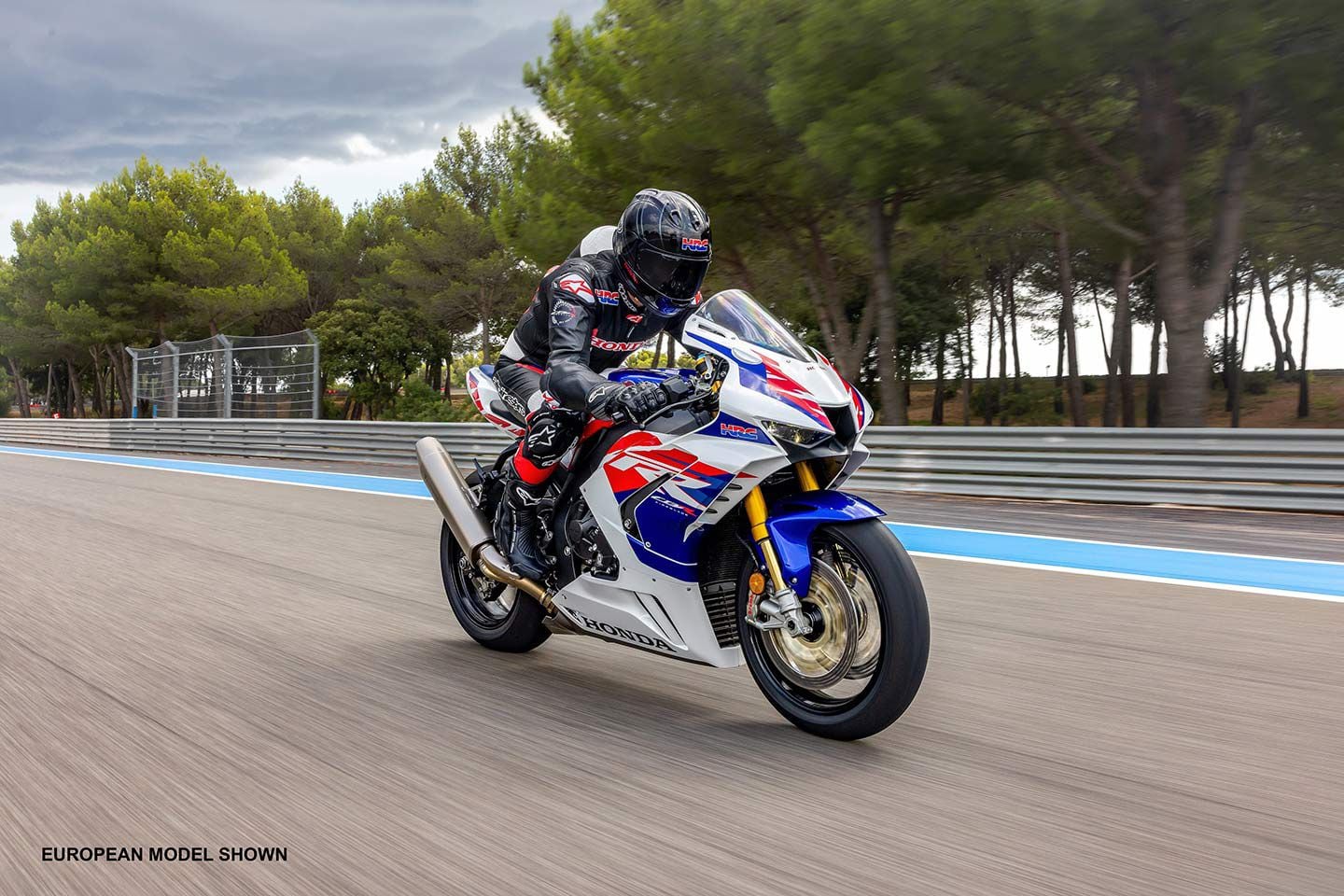
While American Honda still sells the base-model CBR1000RR, the CBR1000RR-R Fireblade SP is recognized as its top-tier, track-focused offering. This is one of those bikes that makes the most sense when being pushed around a racetrack. (Honda/)Updates for 2023
The Fireblade SP is unchanged for 2023. For 2022, however, the engine was tweaked with revised intake ports, narrower than before to increase the air velocity into the combustion chambers and bump up torque, along with an increased compression ratio of 13.4:1, up from 13.2:1. A new airbox, modified to improve flow, feeds revised intake funnels, with the center pair shorter by 15mm, and all four getting new, slash-cut shapes.
On the other side of the engine, the exhaust was modified with a new center section and redesigned catalytic converter, both intended to improve gas flow. Elsewhere, the throttle was modified to make it easier on the wrist, no doubt further emphasizing the impression of improved response. More notably, the rear sprocket gained three teeth, rising to 43 in total, reducing the final drive gearing for better acceleration. That sprocket change, and the longer chain that comes with it, explains the fractional increase in wheelbase for the 2023 Fireblade. Honda also optimized quickshifter performance and refined traction control.
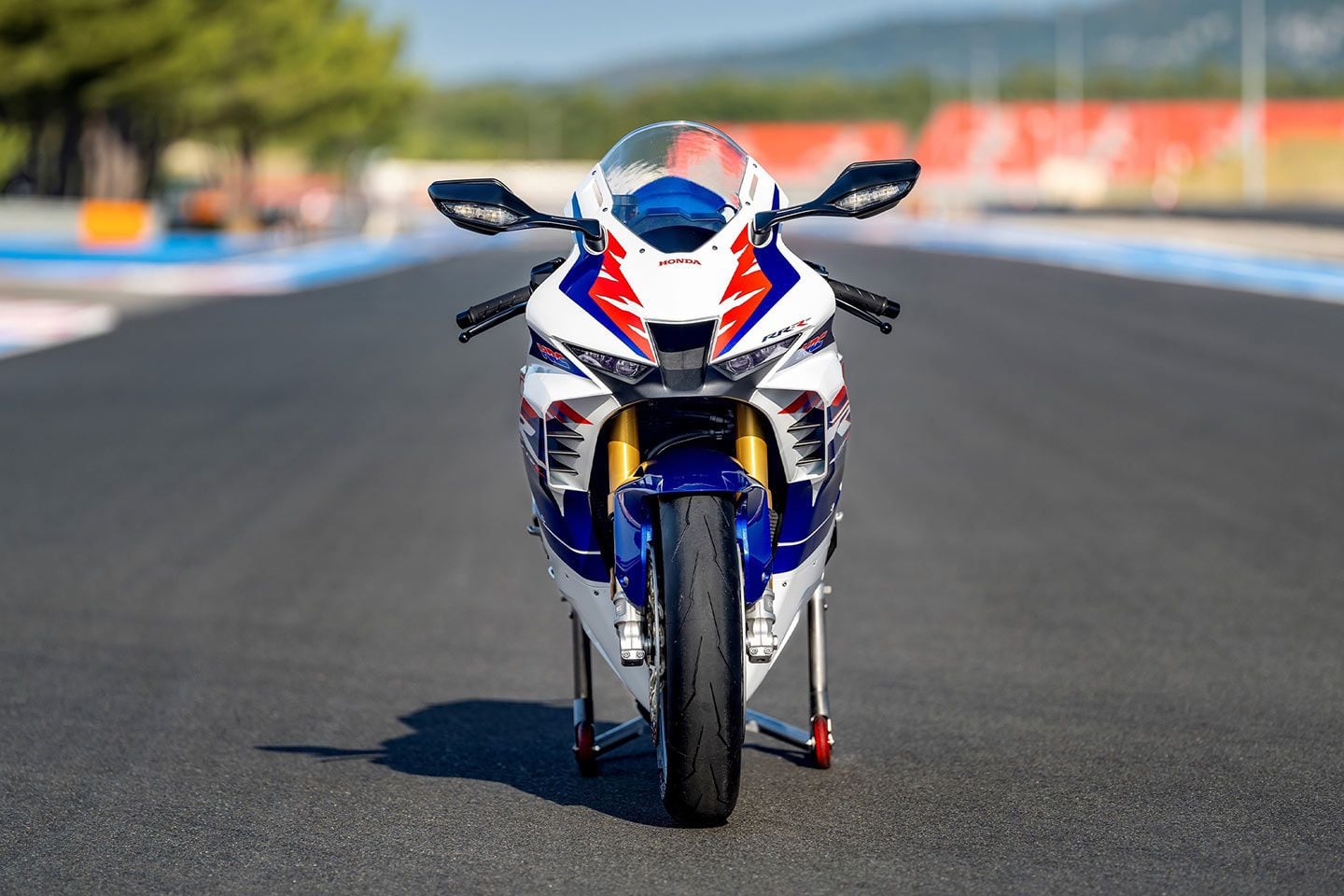
Last year, the CBR1000RR-R Fireblade SP celebrated 30 years since the original CBR1000RR was offered in Europe in 1992 (to be followed a year later in the US). (Honda/)Pricing and Variants
The 2023 Fireblade SP ($28,900) is available in a striking paint scheme reminiscent of the original.
Competition
The CBR1000RR-R Fireblade SP competes with rivals from Japan: the Yamaha YZF-R1 ($17,999) and YZF-R1M ($26,999), Kawasaki Ninja ZX-10R ($17,799), and Suzuki GSX-R1000R ($18,499). Its European rivals are the Ducati Panigale V4 ($24,995) and V4 S ($32,595), the BMW S 1000 RR (from $18,295) and M 1000 RR (from $33,345), as well as Aprilia’s RSV4 ($18,999) and RSV4 Factory ($25,999).
Honda’s own base-model CBR1000RR was top of Honda’s literbike heap before the introduction of the Triple R. For riders who want a less committed experience and who want to save some coin, it’s available for $16,599.
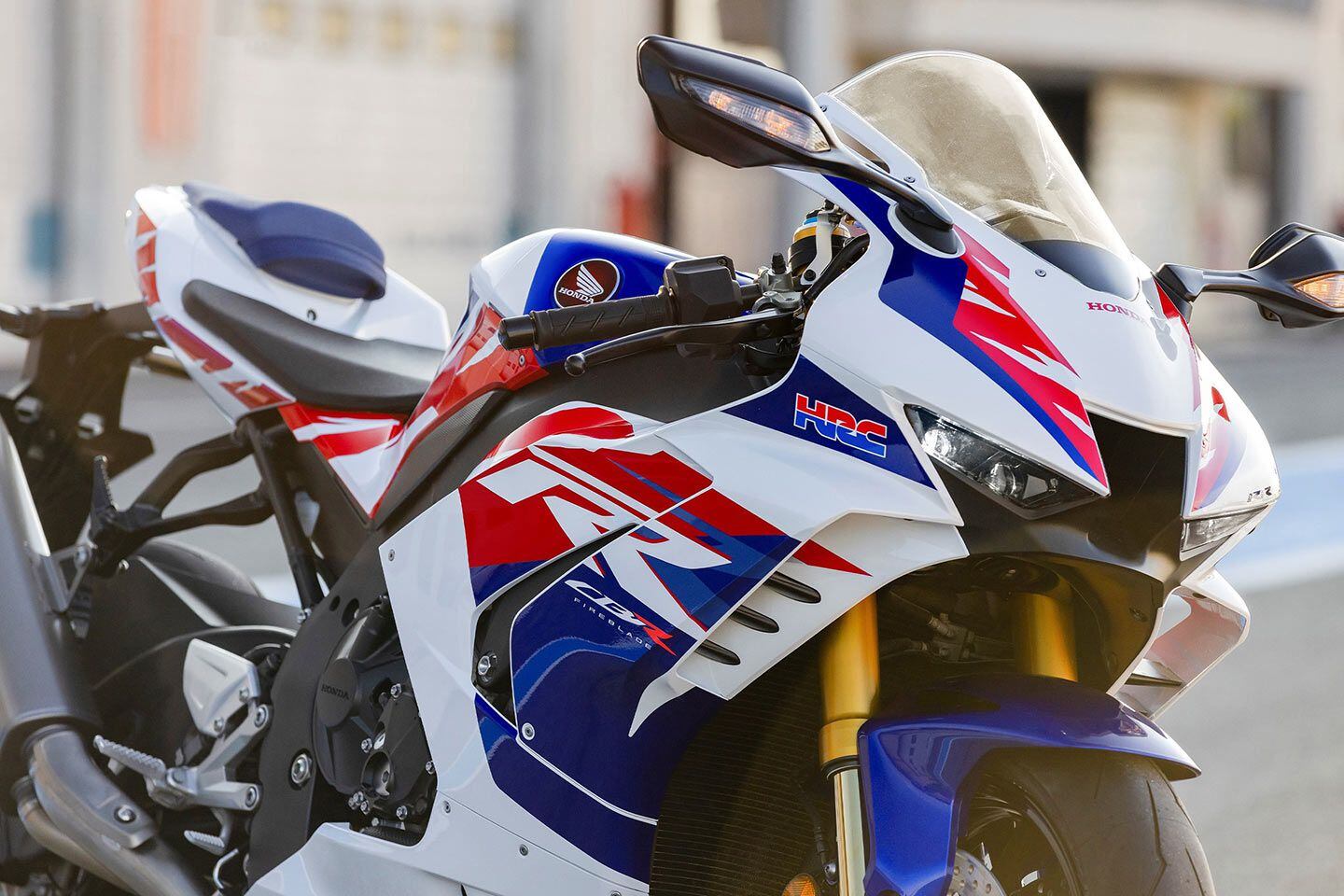
For chasing tenths: integrated aero devices. (Honda/)Powertrain: Engine, Transmission, and Performance
The CBR1000RR-R Fireblade SP’s 999cc inline-four produces a claimed 214 hp at 14,500 rpm and 82.6 lb.-ft. of torque at 12,500 rpm. However, the US-spec model is limited to 186 hp at 12,000 rpm.
The SP uses the same bore and stroke (81.0 x 48.5mm) as the RC213V MotoGP racer, which is very different from the base-model CBR1000RR’s 76.0 x 55.1mm measurements. It also happens to be the same as Ducati’s V4 R.
Why adopt the same bore and stroke of the MotoGP engine for the production ‘Blade? According to Fireblade large project leader Yuzuru Ishikawa, “By using the existing MotoGP combustion chamber, piston shape, and entire intake port, we saved time that would otherwise have been used in step-by-step development of those components.”
In Euro guise, its claimed 214 hp and 445-pound curb weight (fully fueled and ready to ride) is said to net a 9.7 percent power-to-weight ratio improvement over the RR base model and a whopping 79.5 percent gain compared to the original CBR900RR of ‘92. Too bad US customers won’t get the full benefit of those numbers.
On the EU-spec machine tested in 2020, roll-on acceleration from second gear was impressive with a strong yet incredibly linear delivery through the low-to-mid revs. Then, a surge of power comes in around 10,000 rpm and the engine pulls hard to its redline of 14,500 rpm.
One of the appreciable traits of this engine is its smooth power delivery, though admittedly, it’s tuned more for the racetrack and lacks some of the midrange grunt that might help it in real-life riding situations around town, or even on a tight canyon road.
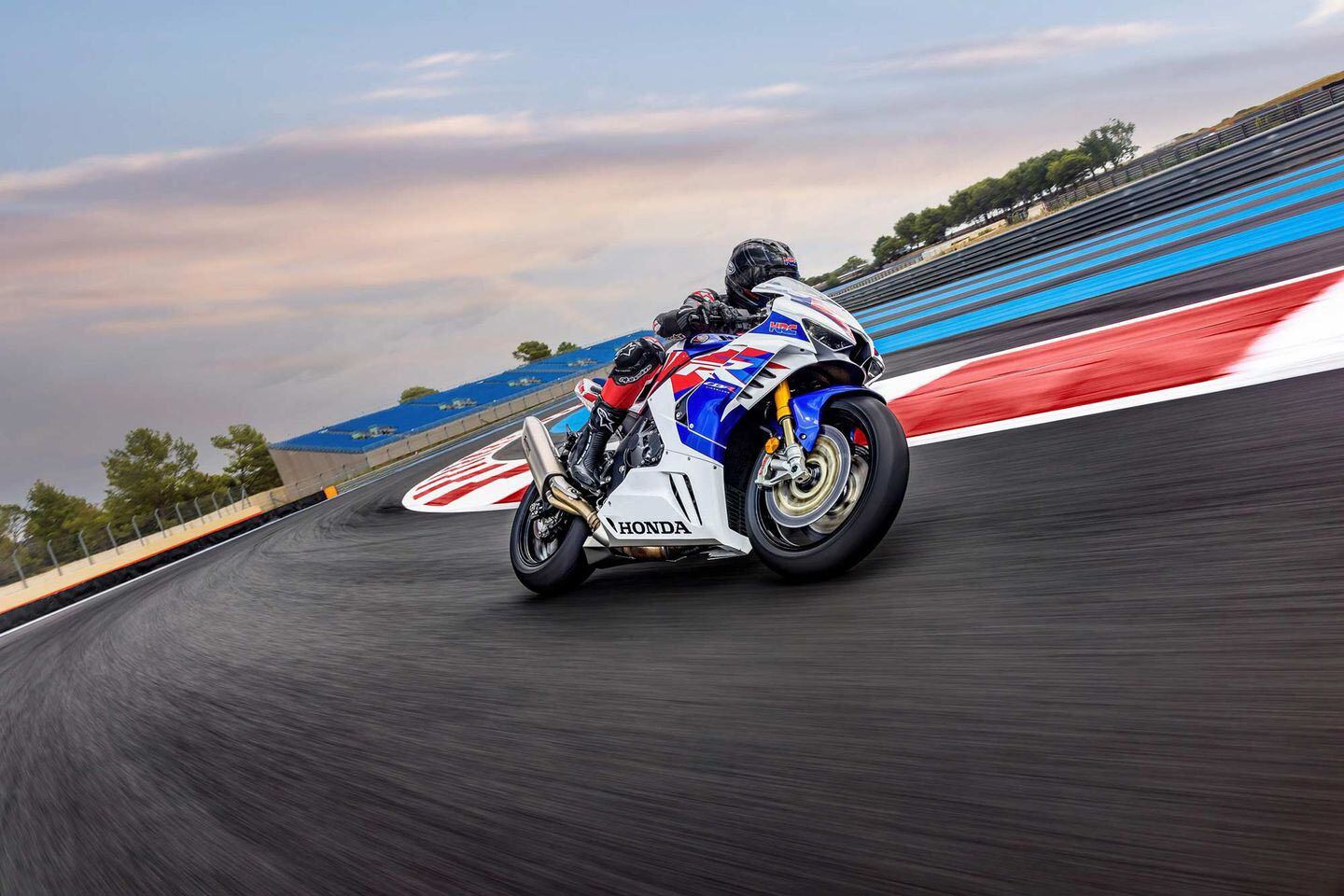
The Fireblade SP is agile yet composed and stable around a racetrack, with great front-end feel. (Honda/)Chassis/Handling
The Fireblade SP has a twin-spar aluminum frame and swingarm with redone rigidity characteristics that conspire to give it seriously glorious corner-carving prowess. The bike exemplifies its strength in difficult side-to-side transitions, and requires little effort to change direction and easily execute midcorner corrections. Look where you want to go, and it goes, no drama—a true track weapon and racebike to the core.
Öhlins’ top-shelf NPX Smart EC 2.0 semi-active gas-charged fork and a TTX 36 Smart EC shock play their part, offering superb feel and support from corner entry to exit. The pair is easily adjustable via the Objective Based Tuning Interface (OBTi) in three customizable Automatic, or semi-active settings, while three Manual modes freeze damping characteristics to settings the rider chooses prior to riding.
The Öhlins suspension boasts supreme consistency and feel that offers everything needed for ultimate handling performance. Stability is a standout characteristic, especially in high-speed braking.
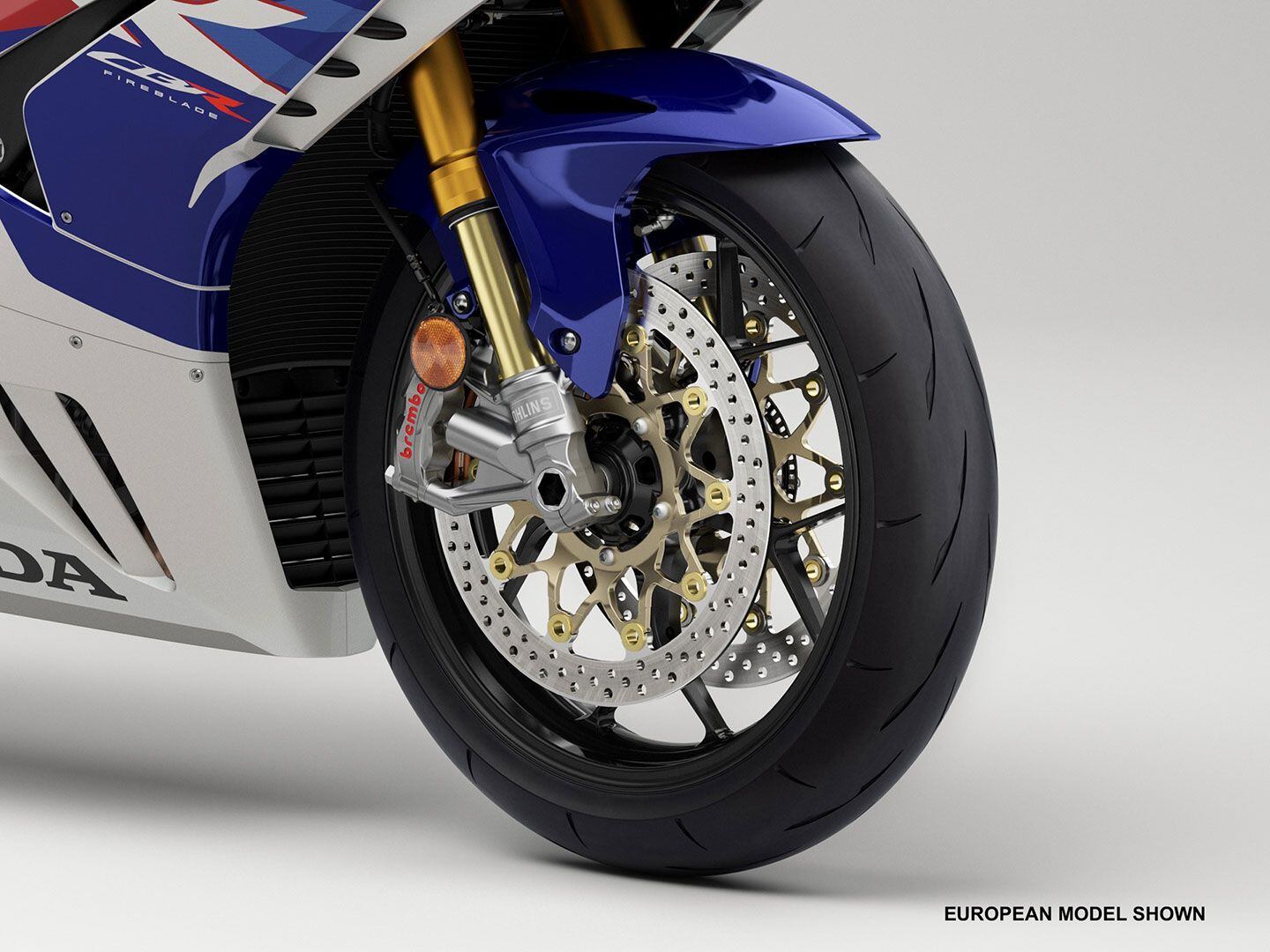
Honda gives the people what they want with top-shelf components from Brembo and Öhlins. (Honda/)Brakes
The Triple R uses a pair of 330mm discs up front with top-shelf Brembo Stylema calipers. Performance is exceptional with no hint of the base model’s excessive ABS intervention or fade.
Fuel Economy and Real-World MPG
No fuel mileage numbers are currently available for the CBR1000RR-R Fireblade SP.
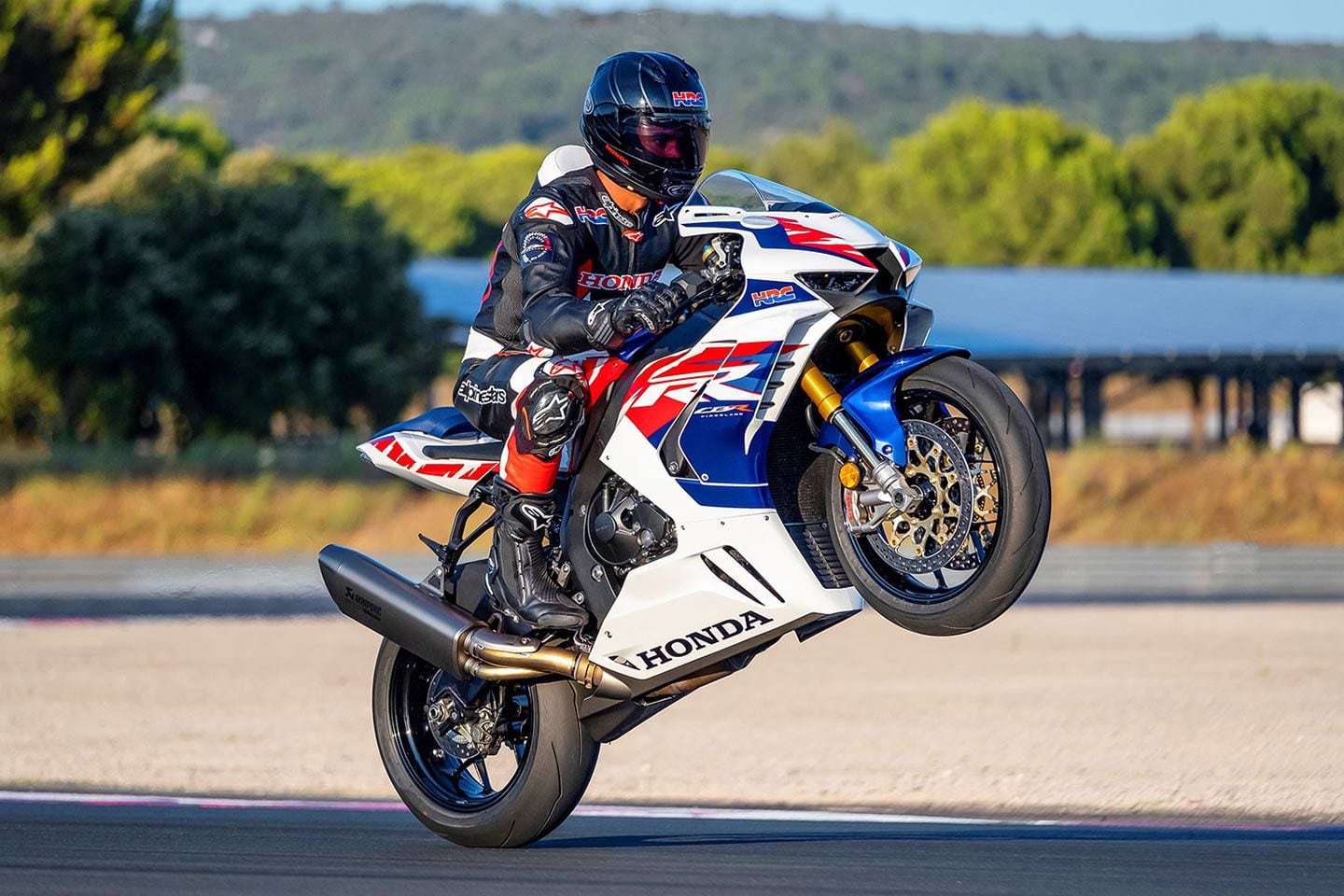
The RR-R’s rider triangle is more aggressive than the RR’s, thanks to a higher and more rearward footpeg position, and lower, more heavily angled clip-ons. (Honda/)Ergonomics: Comfort and Utility
The Fireblade has a thin, narrow seat that gives it an authentic racebike feel. The ergonomic triangle has been made significantly more aggressive than the base-model RR. Footpeg position is raised by 21mm and pushed back by 43mm, creating a more athletic lower-body stance. The handlebars have been repositioned 17mm lower and angled farther forward, motocross style. The result is excessive wrist pressure under heavy braking and a feeling of constantly using arm strength to “climb” back onto the bike during the Fireblade’s mighty acceleration.
Engineers achieved a neat design via a solid aluminum triple clamp and keyless ignition (the CBR uses a proximity fob and ignition button located next to the dash), while a 5-inch full-color TFT dashboard provides vital information.
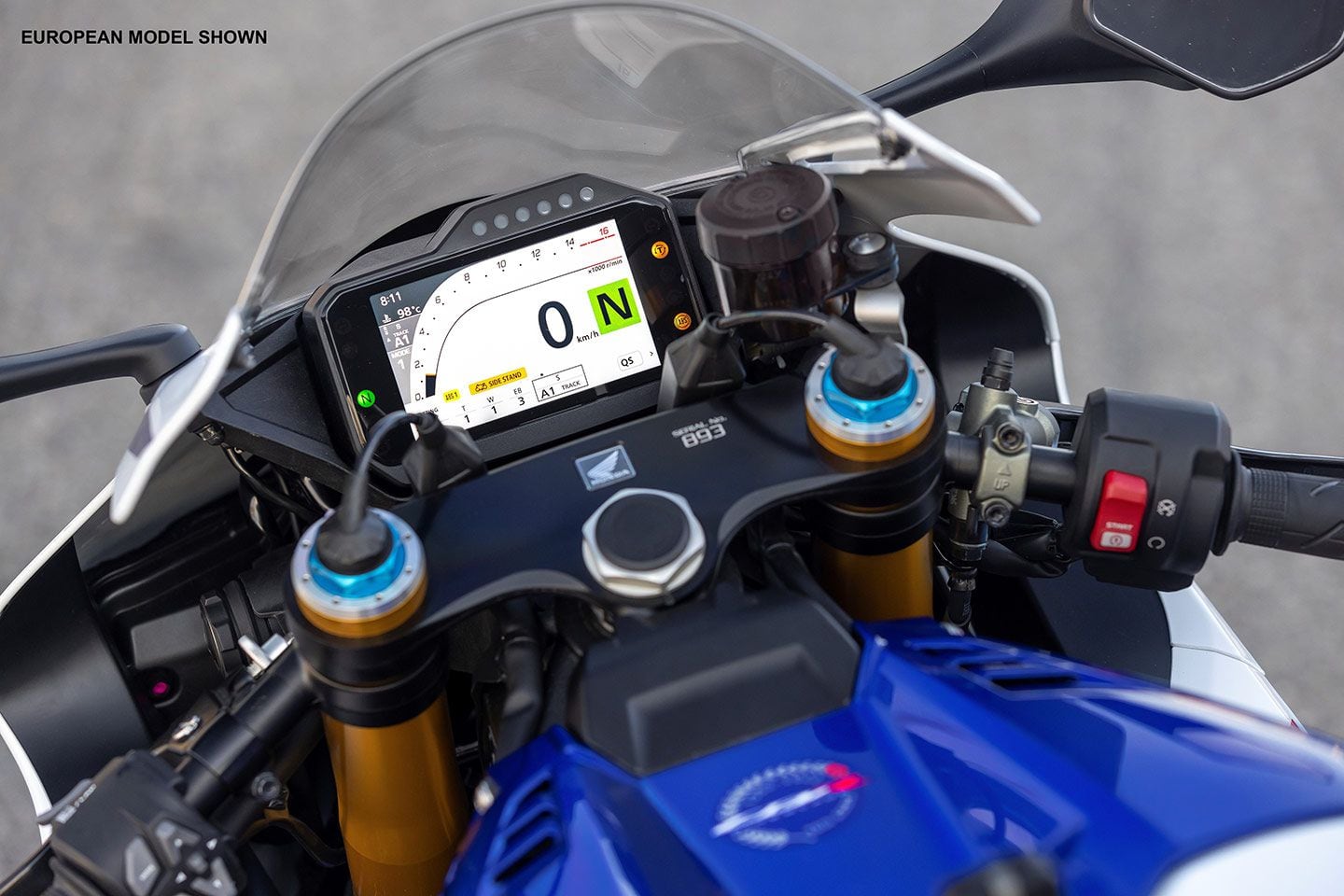
The ’Blade is equipped with a 5-inch TFT dash, and host of electronic rider aids. (Honda/)Electronics
The Fireblade SP uses a Bosch six-axis Inertial Measurement Unit (IMU) to manage a suite of rider aids. There are three default riding modes, with options to change engine output and character. Power (P) operates through levels 1–5, with 1 giving the most power. Engine Brake (EB) manages performance on a closed throttle through levels 1–3, with 1 being the strongest engine-braking; Wheelie (W) manages through levels 1–3 (plus off), with 1 giving the weakest intervention.
The nine-level (plus off) Honda Selectable Torque Control (HSTC) monitors the rate at which slip is changing based on the ratio of front/rear wheel speeds to smoothly manage wheelspin.
The Fireblade SP is also equipped with Start mode for race starts; it limits engine rpm to 6,000, 7,000, 8,000, and 9,000 rpm set points. The up/down quickshifter, updated for 2022, has been refined for shorter fuel-cut times and for smoother torque pickup after shifting. The Triple R also has a three-level adjustable electronic steering damper.
Warranty and Maintenance Coverage
Honda offers a one-year, transferable, unlimited-mileage limited warranty.
Quality
Honda has been long known for its fit and finish, reliability, and large dealer network. The CBR1000RR-R Fireblade SP has HRC’s fingerprints all over it. This is Honda at its finest.
2023 Honda CBR1000RR-R Fireblade SP Claimed Specs
MSRP: $28,900 Engine: 999cc, DOHC, liquid-cooled inline-four; 4 valves/cyl. Bore x Stroke: 81.0 x 48.5mm Horsepower: 186.0 hp @ 12,000 rpm (US model)/214 hp @ 14,500 rpm (Euro model) Torque: 83 lb.-ft. @ 11,000 rpm (US model)/83 lb.-ft. @12,500 (Euro model) Transmission/Final Drive: 6-speed/chain Fuel Delivery: Fuel injection w/ 52mm throttle bodies, 12-hole injectors Clutch: Wet, multiplate Engine Management/Ignition: Throttle-by-wire, digital transistorized w/ electronic advance Frame: Twin-spar aluminum Front Suspension: 43mm Öhlins NPX Smart EC fork w/ electronically controlled preload, compression, and rebound adjustments; 4.3 in. travel Rear Suspension: Öhlins TTX 36 Smart EC shock, compression, rebound, and spring preload adjustable; 5.6 in. travel Front Brake: Brembo Stylema radial-mount calipers, 330mm discs w/ ABS Rear Brake: Brembo 2-piston caliper, 220mm disc Wheels, Front/Rear: 17 x 3.5 in. / 17 x 6.0 in. Tires, Front/Rear: 120/70ZR-17 / 200/55ZR-17 Rake/Trail: 24.0°/4.0 in. Wheelbase: 57.4 in. Ground Clearance: 4.5 in. Seat Height: 32.7 in. Fuel Capacity: 4.3 gal. Wet Weight: 445 lb. Contact: powersports.honda.com -

BMW’s R nineT is being renamed the R12 nineT. (BMW/)BMW teased the next-generation R nineT, which is now called the R12 nineT, earlier this year but without revealing many technical details. Now, the bike has been type-approved in Europe alongside a second version simply called R12 that appears to take a more cruiser-style approach.
The emergence of the type-approval documents mean that we get our first look at the bikes’ dimensions, performance, and weights, showing that the R12 nineT won’t be any more powerful than its predecessor and the R12 is a step below it in terms of performance.
The R12 nineT is the model shown in these images, released by BMW, and it clearly carries on the same neo-retro roadster theme established by the R nineT, combining modern suspension and brakes with BMW’s traditional air-cooled boxer twin. The styling has nods to the past, most notably the R90S of the 1970s. That, presumably, explains the retention of the “nineT” name, which was originally coined for the first-generation R nineT a decade ago as a celebration of 90 years of BMW motorcycle production. Now BMW has been making bikes for a full century—the first was the R32 of 1923—but the nineT name has established itself over the last 10 years, so there’s no rebranding to mark the centenary.
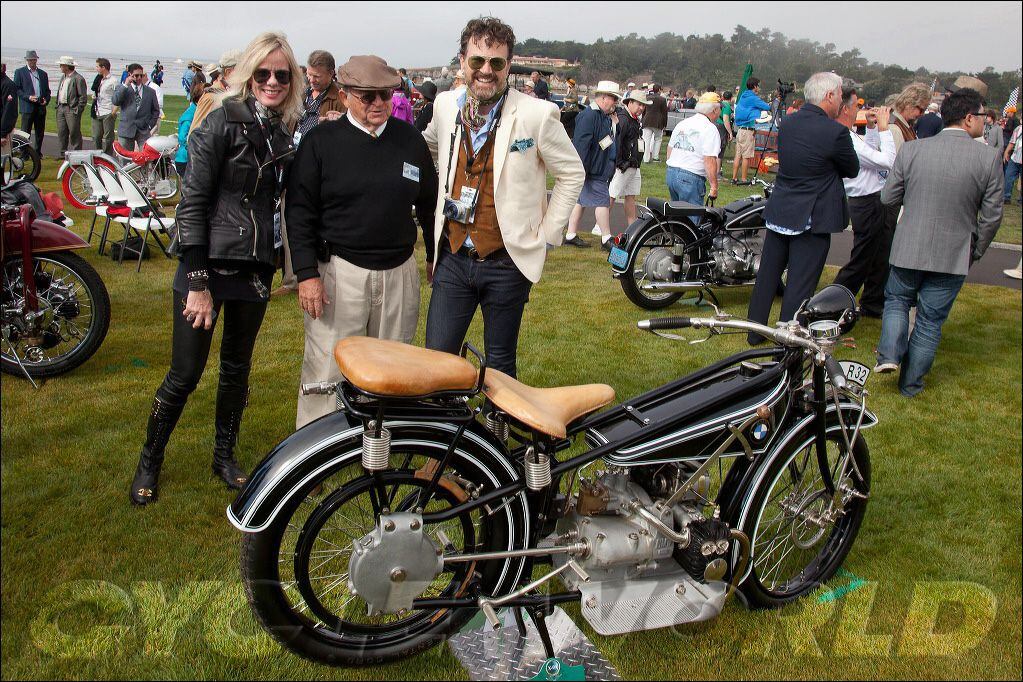
BMW’s R32 was the bike that started it all for the Motorrad back in 1923.In terms of specs, the sportier R12 nineT’s type-approval information shows that the full-power version manages 107 hp at 7,000 rpm from its 1,170cc air-cooled boxer twin. That’s essentially the same output as the previous model, albeit arriving a fraction lower in the rev range. Torque peaks at 85 lb.-ft. at 6,500 rpm, again within a whisker of the current-generation bike, but this time peaking 500 rpm higher.
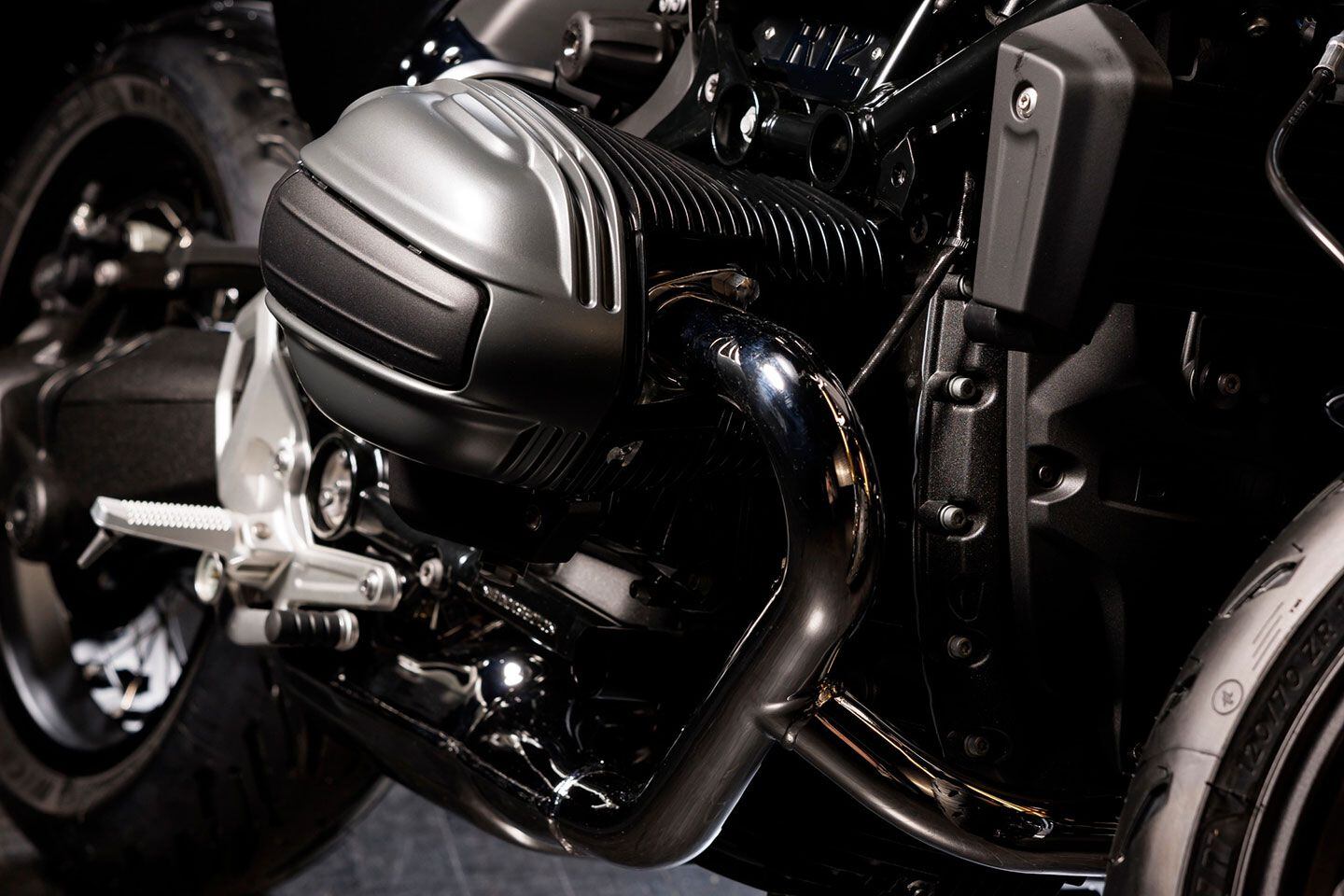
The R12 nineT uses the same air-cooled boxer twin as its predecessor. (BMW/)For Europe, BMW will also offer a detuned version of the R12 nineT with 94 hp to comply with the region’s A2 license laws, which allow bikes making up to 94 hp to be restricted further to 47 hp and used by less experienced riders. They can be derestricted once those riders get their full motorcycle licenses. A ready-restricted 47 hp version of the R12 nineT has also been type-approved.
The non-nineT “R12″ model has only been type-approved in 94 hp and 47 hp versions, with no full-powered, 107 hp variant. The 94 hp model peaks at 6,500 rpm and hits its max torque of 81 lb.-ft. at 6,000 rpm, while the restricted 47 hp machine maxes out at 5,250 rpm and manages only 72 lb.-ft., peaking at just 3,000 rpm. All the bike’s top speeds are in line with their power outputs. The R12 nineT is the fastest, managing 134 mph, while the 94 hp version reaches 130 mph. The R12 is a fraction slower, peaking at 126 mph, while the restricted 47 hp versions of both bikes both run out of steam at about 100 mph.
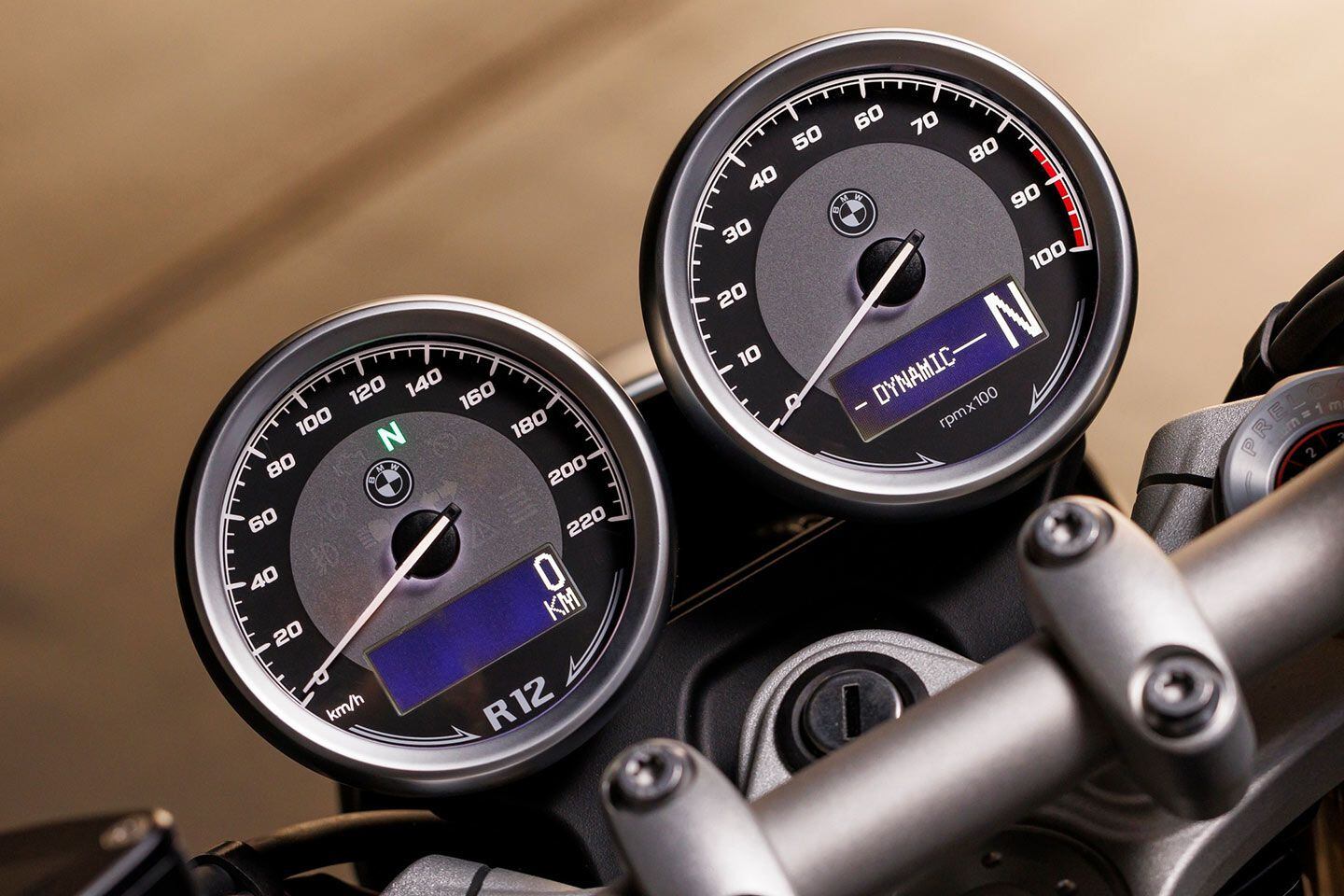
The retro theme extends to the twin gauges with a mix of analog and digital displays. (BMW/)The R12 nineT’s dimensions show it’s an inch longer than its predecessor at 83.8 inches, while its 34.2-inch width is nearly identical to the current model, and there’s less than half an inch difference in height at 42.1 inches. A second variant coming in at 43.9 inches tall suggests a cowl will be optional. The wheelbase of both the R12 and R12 nineT are the same at 59.8 inches, up from 58.5 inches for the existing R nineT. The type approval also shows that both the R12 and R12 nineT share the same twin-exit exhaust system, and their weights are similar, with the R12 nineT coming in at 489 pounds while the R12 is 505 pounds.
The R12 is also taller than the R12 nineT at 43.3 inches, rising to 49.3 inches with an optional screen, but the biggest difference between the two bikes are the wheel and tire sizes, which indicate how the R12 takes a more cruiser-style stance. The standard R12 nineT has the same wheel sizes as the current model, with a conventional 120/70-17 at the front and a 180/55-17 rear, but the R12 swaps those for a narrow, 2.75-inch wire-spoke, 19-inch-diameter front wheel wearing a 100/90-19 tire, and a 16-inch rear, which is 4 inches wide with a 150/80-16.
While there have been R nineT variants with a 19-inch front before, notably the Scrambler and Urban G/S versions, they’ve had wider 120/70-19 tires and matched them to 17-inch rears with a wider 170/60-17 tire. The use of a 19-inch front, 16-inch rear on the new R12 model suggests it’s a cruiser. It also grows in length from 83.9 inches for the R12 nineT to 86.6 inches for the R12, a difference that the larger front wheel alone can’t account for, suggesting its rear bodywork extends further back.
Full details are expected to appear in around a month’s time, and there may be additional R12 nineT derivatives coming as well to replace the Scrambler and Urban G/S models.
-
I had the Ducati Scrambler Nightshift on loan from On Yer Bike – you can read my review of the bike here to hear about our adventures

https://www.webbikeworld.com/2023-ducati-scrambler-nightshift-review/
Here’s a link to my YouTube riding video of the Scrambler:
The post Ducati 2023 Scrambler Nightshift appeared first on BikerKaz.
-
It now sports the same 693cc parallel-twin engine found in the 700 CL-X retro models.
-
 1
1
-
-
The Yamaha Ténéré 700 has been a resounding success in the middleweight adventure bike segment since its inception in 2019. Its CP2 engine is a Cycle World favorite in models such as the MT-07 and XSR700, but is the 689cc parallel twin enough to power a midsize ADV bike? We threw it on our in-house dyno before a three-bike comparison test to find out.
Yamaha’s CP2 engine is a 689cc liquid-cooled DOHC parallel twin with a 270-degree crossplane crank that produces a beautifully throaty exhaust note. Its agile handling on and off-road is attributed to the fully adjustable 43mm inverted fork and linkage-type shock with remote preload adjustment. Its chassis design is of tubular steel construction. The 2023 Yamaha Ténéré 700′s lively engine, off-road-capable suspension, and willing chassis in combination with a competitive MSRP of $10,499 (2023 pricing) has made it one of the most popular middleweight adventure bikes on the market.
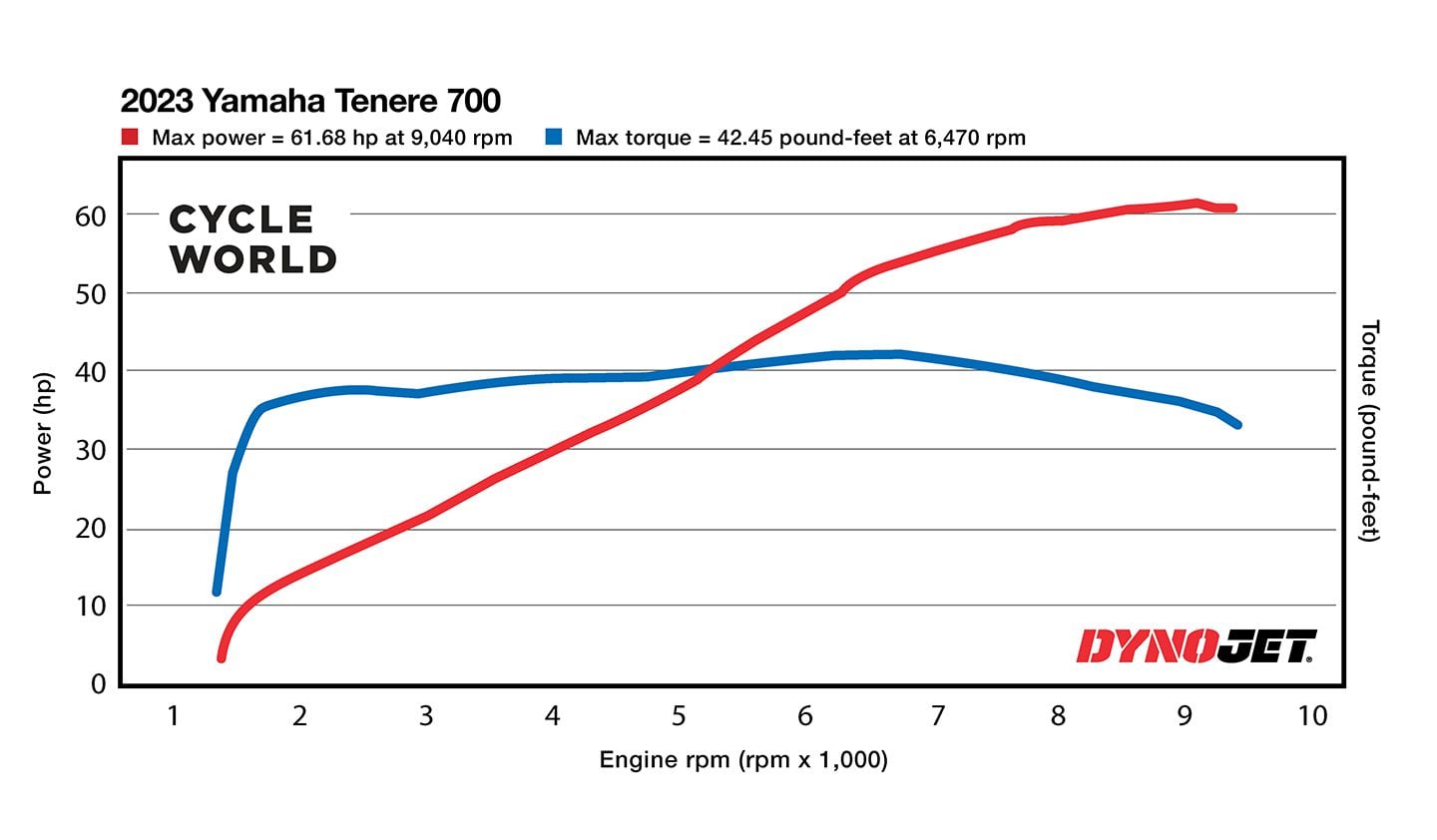
2023 Yamaha Ténéré 700 Dyno Chart. (Robert Martin/)On our in-house Dynojet 250i dynamometer, the 2023 Yamaha Ténéré 700, weighing 457 pounds on our automotive scales, produced 61.7 hp at 9,000 rpm and 42.5 lb.-ft. of torque at 6,500 rpm. These numbers slot the T7 just below the Aprilia Tuareg 660 in our performance database at 69.9 hp and 44.3 lb-ft. of torque. The Ténéré 700′s extremely flat torque curve and linear power delivery make the bike fun yet manageable off-road while still providing plenty of excitement on road.
View the full articleSam Bankman-Fried
-
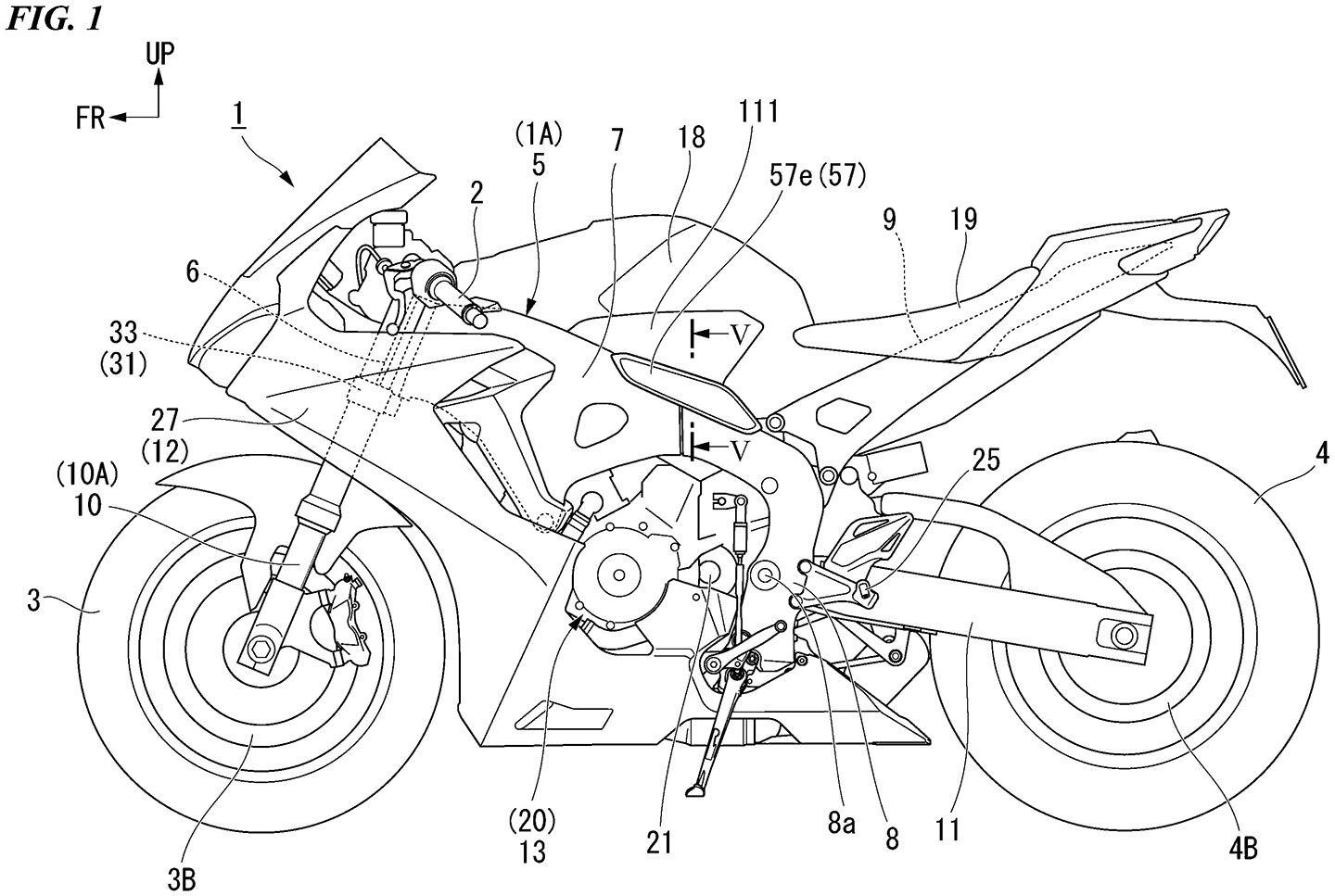
Honda is working on solutions to reduce rider fatalities by 2050. Informing the rider when automated systems intervene is part of the puzzle it’s trying to solve. (Honda/)With the advent of radar and camera-based safety solutions for motorcycles already a reality and work well underway on active steering-assist systems, manufacturers are facing a growing need to find new ways to keep riders aware of what their bikes are doing on their behalf. Honda’s latest approach to the problem is to use active bodywork sections that push against the rider’s inner thighs—not only alerting them to the intervention but helping them adopt a more suitable position on the bike at the same time.
Patents filed in Europe show a CBR1000RR sportbike fitted with movable panels where the rider’s knees grip the sides. These have a simple rotary actuator behind them and hinges along their upper edges, allowing them to flap outward with a considerable amount of force when the actuator is triggered.
You might, quite understandably, ask why Honda wants to do that. The answer lies in the array of rider-assist systems that the company is already working on. We’ve previously written about work Honda is doing on steering-assist and lane-keep-assist for motorcycles, as well as radar and camera systems to create a complete “autopilot” style system. This is an added element to those ideas, created to overcome an essential issue of keeping the rider informed. After all, a safety system that can intervene in a bike’s braking and steering—which is exactly what Honda is working on—has the potential to create more problems than it solves if the rider is taken unawares and thrown off balance by the bike’s automated actions.
Related: Honda Blind-Spot Protection
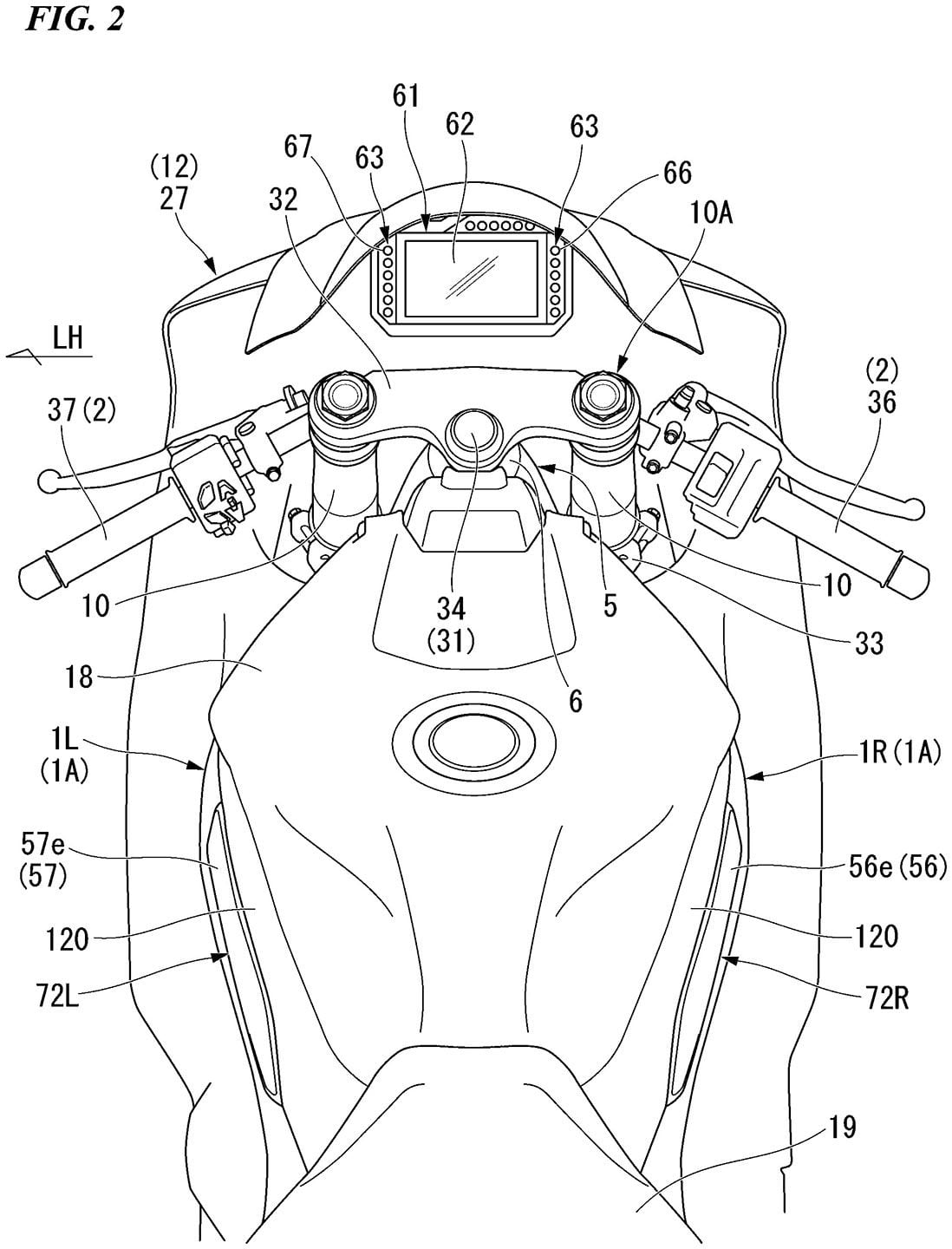
A view of the top of the motorcycle shows where the panels would deploy from, indicated by 72L and 72R. (Honda/)The mechanical panels acting against the rider’s inner thighs on Honda’s latest design are a proposed solution to that problem. The idea is that when the servo-operated steering assist system kicks in, for instance to push the bike back on course if the rider isn’t concentrating and starts drifting into the adjoining lane, the pads move. In that instance, if the bike steers left, the pad on the left-hand side pushes outward, increasing the rider’s grip on that side of the tank and pushing his or her leg to the left to alter the center of gravity a fraction, helping the maneuver. The same system could also be instructional, helping riders learn to position their weight during corners.
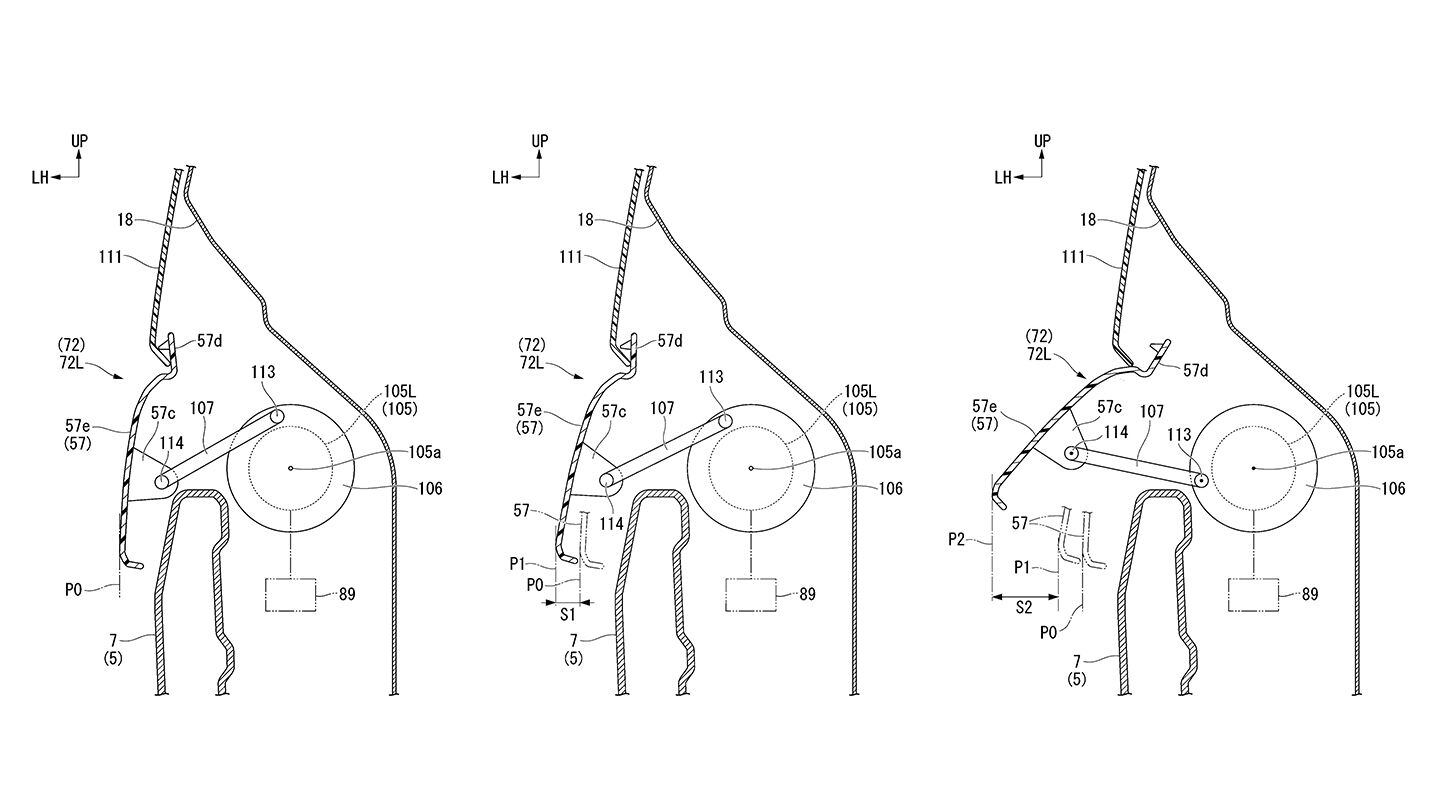
A servo beneath the bodywork would push a hinged panel out to inform the rider that the bike is actively intervening with rider assist. But would also help the rider position their body for that intervention. (Honda/)When connected to a radar or camera-based adaptive-cruise control or accident mitigation system, the pads both push out together when the bike brakes on its own—another thing that could be unnerving and unbalancing for an unsuspecting rider. By pushing both pads out, the idea is that the rider’s overall grip on the sides of the tank is increased, as well as giving an immediate, tactile alert that the bike is putting the brakes on. The patent also suggests the system would be connected to the hazard lights, flashing them when it auto-brakes.
Although it’s unlikely that Honda is about to put a system like this into production anytime soon, it’s increasingly clear that the company is developing an integrated suite of rider assists including auto-steering and auto-braking. Honda’s stated intention is to end traffic collision fatalities involving its motorcycles or cars by 2050, and bikes that can intervene when riders make bad decisions or simply aren’t paying attention look to be a key part of achieving that goal.
-
You can still get on the wait list in case anyone cancels, though.
-
From Lucky Explorer to Enduro Veloce, now more in line with the rest of the lineup.
-
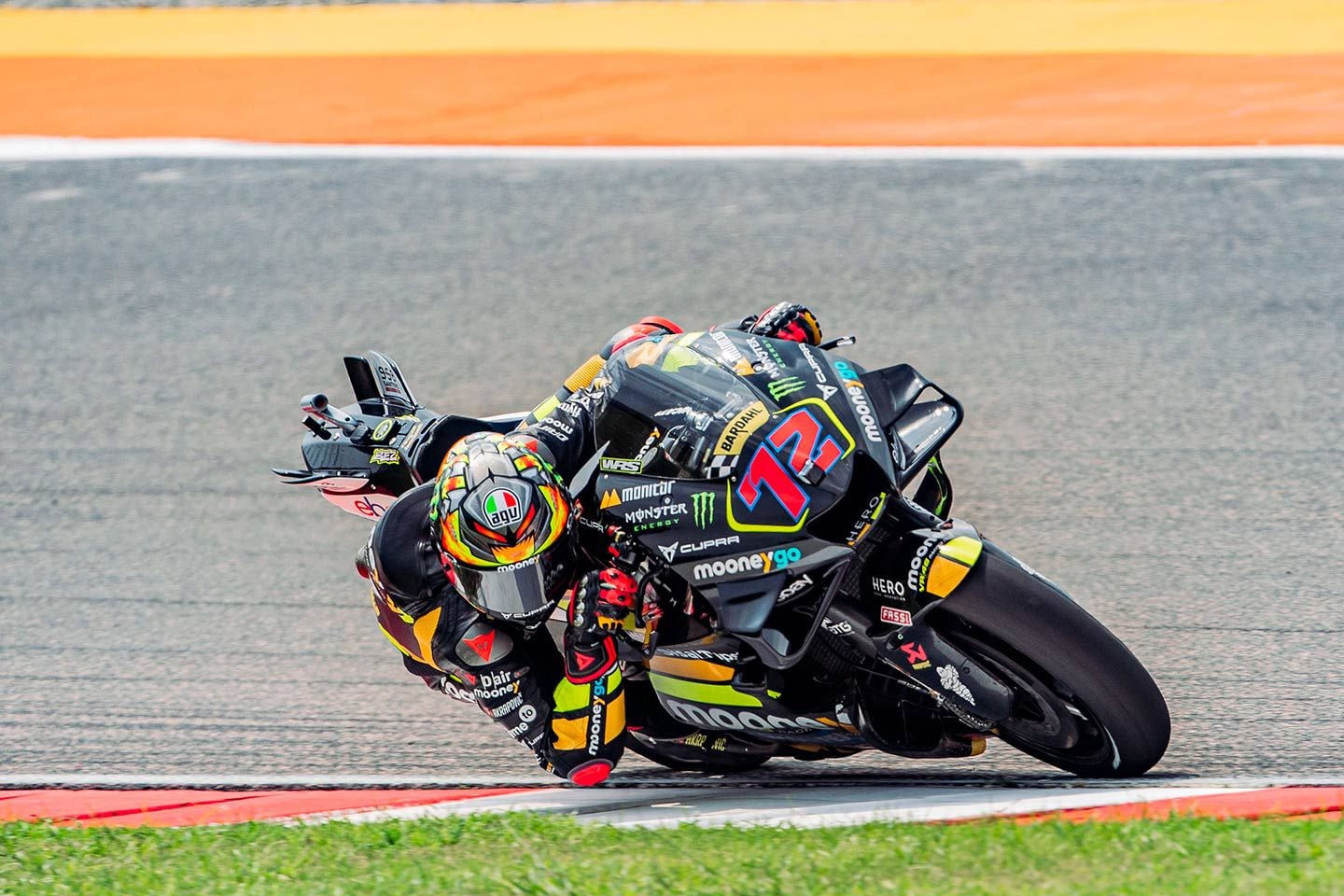
Marco Bezzecchi ran away from the field in the first-ever Indian MotoGP. (Mooney VR46/)Marco Bezzecchi (Mooney VR46 Ducati) won the first-ever Indian MotoGP, appearing cheerfully invulnerable to the crushing heat and humidity. So harsh were the conditions on the Buddh circuit that the planned 24 laps were shortened to 21, as riders described the heat as “worse than Malaysia.”
Finishing second while suffering from dehydration for the last third of the race was Jorge Martín, more than 8 seconds back. Passed near the end by a surprisingly fast Fabio Quartararo (factory Yamaha), Martín mustered an abrupt repass to recover his position. This brings him closer to series leader Francesco Bagnaia (factory Ducati) with 279 points to 292. Bagnaia had lost the front on lap 14, just as he was about to pass Martín.
“…when I overtook him I got to corner 5,” Bagnaia said, “and as soon as the rear tire came back from the slide, it pushed a bit the front, and I lost it.”
Bagnaia had elected to run a hard front tire. “…with the mediums the other Ducatis were using, I was struggling a lot.
“…I was having a lot of front locking so we decided to go with the harder [tire].
“I was fighting with Jorge and as soon as I took him, I lost the front.”
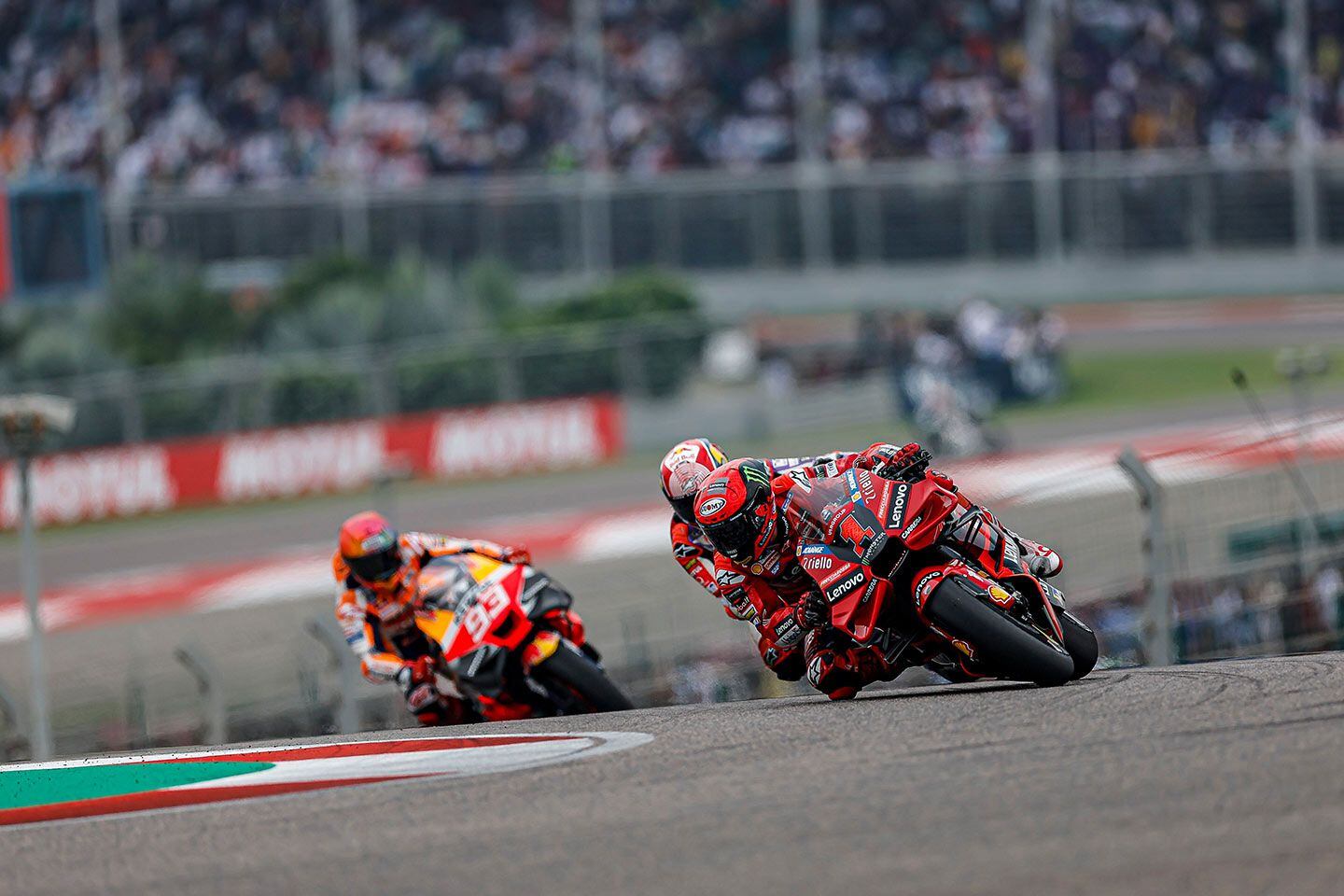
Francesco Bagnaia’s crash on Sunday tightens up the point race, putting him just 13 points ahead of Pramac’s Jorge Martín. (Ducati/)Bezzecchi’s day was almost routine: “I knew I would struggle at the start…but with my electronics I studied the start as best I could.”
His satellite bike does not have the latest starting system.
“I tried to [get into first place] as soon as possible.
“…from the front you can manage the race without making the bike and tires suffer.
“Getting up front and without the hot air of the other bikes I was able to handle myself well.”
It was much harder for Martín, who after the finish bypassed parc ferme and went instead directly to his garage. When he dismounted, his strength left him and he sank to his knees. Water quickly restored him.
It was pointed out that the riders get into their thick suits half an hour before the start, and that, while riding, their major source of cooling is moisture constantly evaporating from the lungs. I have on occasion seen riders come into pit lane and then keel over from dehydration when they dismount and try to stand. Each of us is different, but the advice given to athletes is to keep drinking water, not just until you no longer feel thirsty, but until you are obliged to pee.
Bagnaia had said, “The main problem is the heat. In some areas you feel like you are burning.”
Quartararo said, “Physically the track is not very tough. It’s just the heat.”
Several riders described the track as “technical”: Bagnaia said, “Some parts are very difficult, like the first corner. There’s only one trajectory and [for it] you have to brake at a precise point. Do it just a meter later and you end up wide.”
Aleix Espargaró (factory Aprilia, DNF from tech problem) said, “The track is extremely technical—probably the most technical of the championship.”
Bezzecchi said, “I like the layout. The third sector requires a lot of precision, since it has various curves in rapid succession. If you get one wrong, you risk compromising everything...”
Marc Márquez likened the track to Austin (CoTA in the US). “This racetrack is very similar to Austin, a lot of stop-and-go first-gear corners.
“It’s not exactly the same here but it’s very similar and in [such] corners we are struggling less.”
The Hondas—in particular those of 2019 and earlier that were optimized for Márquez’s point-and-shoot style—perform best on “small” corners of the type beloved by F1 circuit designers.
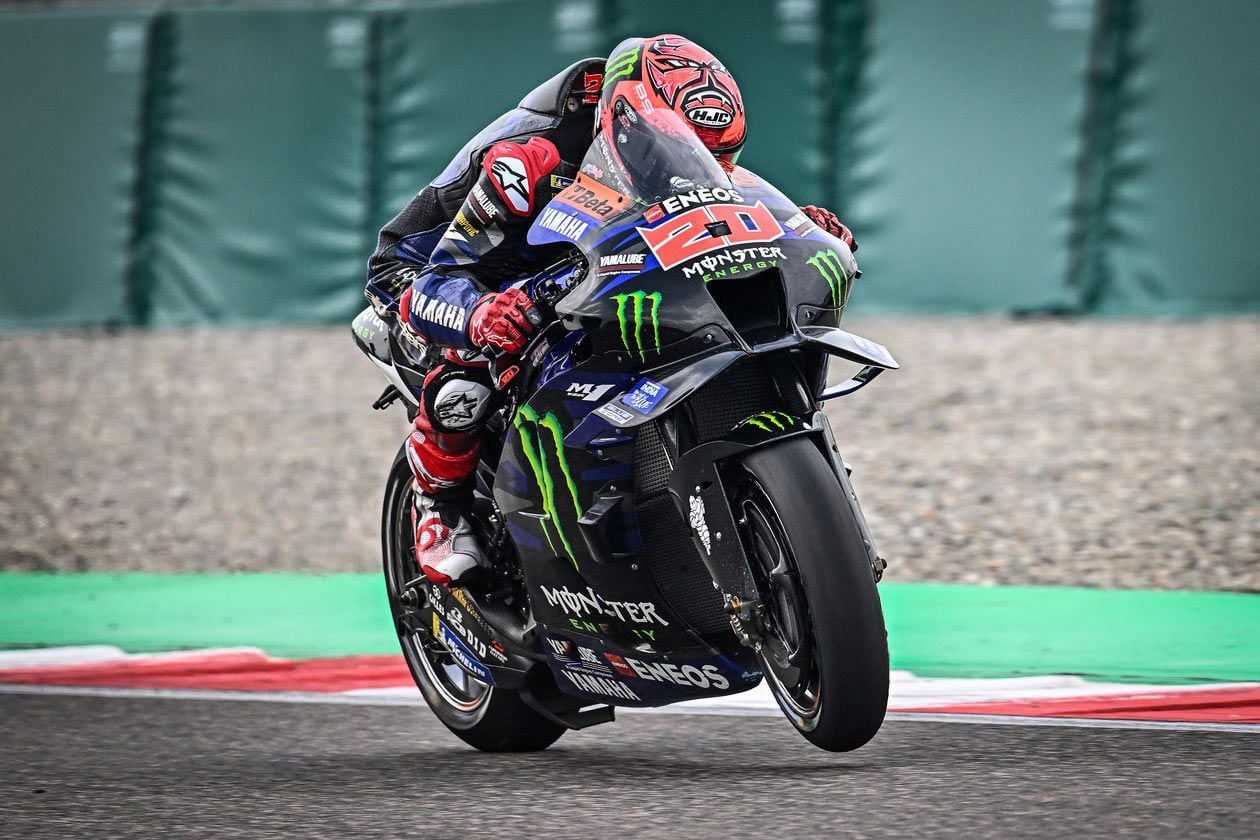
Fabio Quartararo made his return to the podium in India. (Monster Energy Yamaha/)Espargaró agreed: “It’s more stop-and-go and not as flowing. It reminds me of Austin, but with less grip.”
The number of first-gear corners may have been a part of Quartararo’s gearbox troubles. He said, “We have something new which we’ve been using for three races and it’s never given us any problems. But today [Friday] I broke two gearboxes in 10 laps.”
Ratio separations in gearboxes are wider at the bottom—typically engine rpm falls 20–25 percent on the first-to-second upshift, but as little as 5–8 percent from fifth to sixth. This means that the thump of upshifts from first is the harshest; in production gearboxes ridden hard it is the first-to-second dog set that gets hammered and gives trouble first. In MotoGP, so-called “seamless” gearboxes are used—those that engage the next gear without first disengaging the gear that had been driving. Only once the new ratio is engaged is the previous ratio kicked out of engagement. Some of the ways of accomplishing this involve quite small and heavily loaded parts whose reliability strongly depends upon material and heat-treatment.
Because the Buddh track gets little use, it was initially dirty. Márquez noted that grip improved over time. Bagnaia noted the trickiness that arises as a single line cleans up and achieves useful grip: “…if you go a little wide, the asphalt becomes very slippery. In those cases you have to stay calm and get back on the right line, otherwise you lose the front or the back.”
Bagnaia also had interesting things to say about Martín’s recently improved performances and his own mysterious decline in braking performance.
“My bike is nervous when braking. I suffer from chattering at the rear, and I struggle to exploit what is usually my strong point.
“Today, Jorge made the difference in braking.
“In the last two Grands Prix he has started to brake hard. Normally he wasn’t one of the best in that area. If [now] I lift off at the same point as him, I go wide.”
Initial braking is very sensitive to ride height—a few millimeters can make a big difference. Initial braking is the ability of the bike to transfer weight onto the front tire as fast as the rider is applying the brake. If weight transfer can’t keep up, initial braking will be weak and the rider will arrive in the corner with too much speed. This effect would be intensified in drafting situations by the resulting higher front tire temperature and the smaller tire footprint that results from increased tire pressure.
Tire grip is constantly changing around the circuit, but the tread rubber compounder has choices to make, as events of 2008 remind us. In European races, Michelin had been able to delay making Sunday’s tires until Saturday afternoon, giving them the advantage of best possible forecasting of Sunday’s weather. Tires were then expressed from factory to circuit. This encouraged Michelin to develop quite temperature-sensitive rubber compounds—just 5 degrees could make the difference between race-winning grip and also-ran red faces. This allowed Michelin to travel far down the road of pushing peak grip to high values by sacrificing temperature range. Outstanding performance was the result—until new rules required race tires to be at the track days in advance.
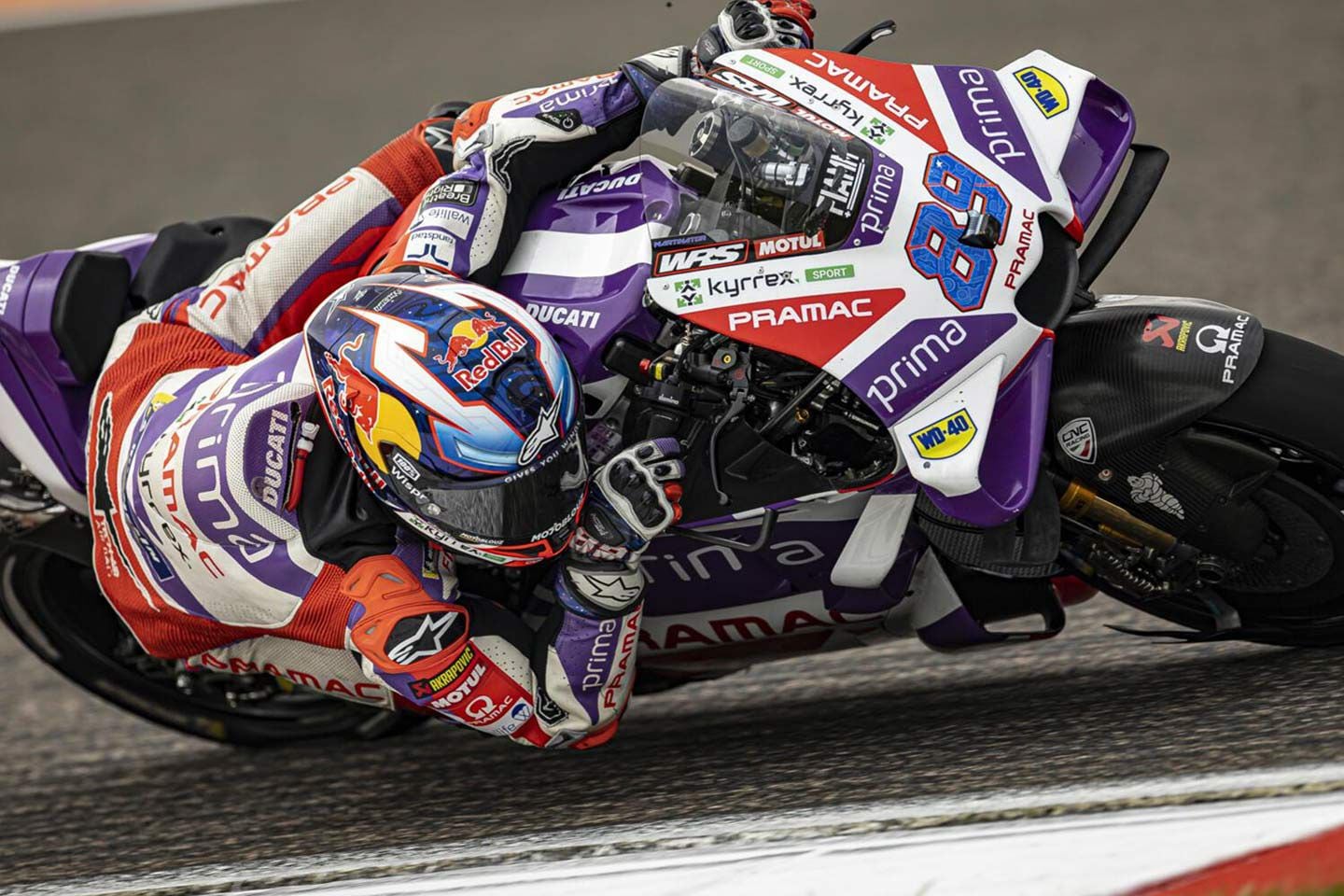
Martín arrived at the finish so dehydrated, he had trouble standing. He also dodged a penalty when his leathers unzipped, but he was able to close them on the track after receiving a warning. (Prima Pramac/)Meanwhile Bridgestone, being too far from most races to rely on “just-in-time” tire delivery, had to steer its early-21st-century compound research onto a different course: Learning to achieve high grip over a wider temperature range.
At present, best MotoGP front tire performance is often available only over a very narrow temperature range, complicated by spec tire provider Michelin’s insistence upon the minimum front tire pressure of 1.88 bar (27.6 psi).
Quartararo’s third place in Sunday’s GP is the best Yamaha performance in a while. Brad Binder (KTM factory) was fourth and Joan Mir (Repsol Honda) was fifth.
Here are the new championship point standings:
- Bagnaia - 292
- Martín - 279
- Bezzecchi - 248
- Binder - 192
- A. Espargaró - 160
Will Bagnaia’s crew, as he confidently expects (“I’m not worried because I know that my team will find a solution”), discover the cause of his current braking problems in time to divert to himself points that may go instead to Martín? And what of Bezzecchi, whose cheerful confidence must be demoralizing to rivals? As we have seen at other times, powerful performances by Aprilia and KTM riders have yet to occur on demand. At the moment, consistency is Ducati’s alone.
For the moment, MotoGP reporting devotes a lot of words to speculation about Marc Márquez’s future. Will/can he sign with a Ducati satellite team? Will he “stay the course” at Honda? The “Big Boss” is expected to be at Motegi.
The Japanese GP is next weekend.
-
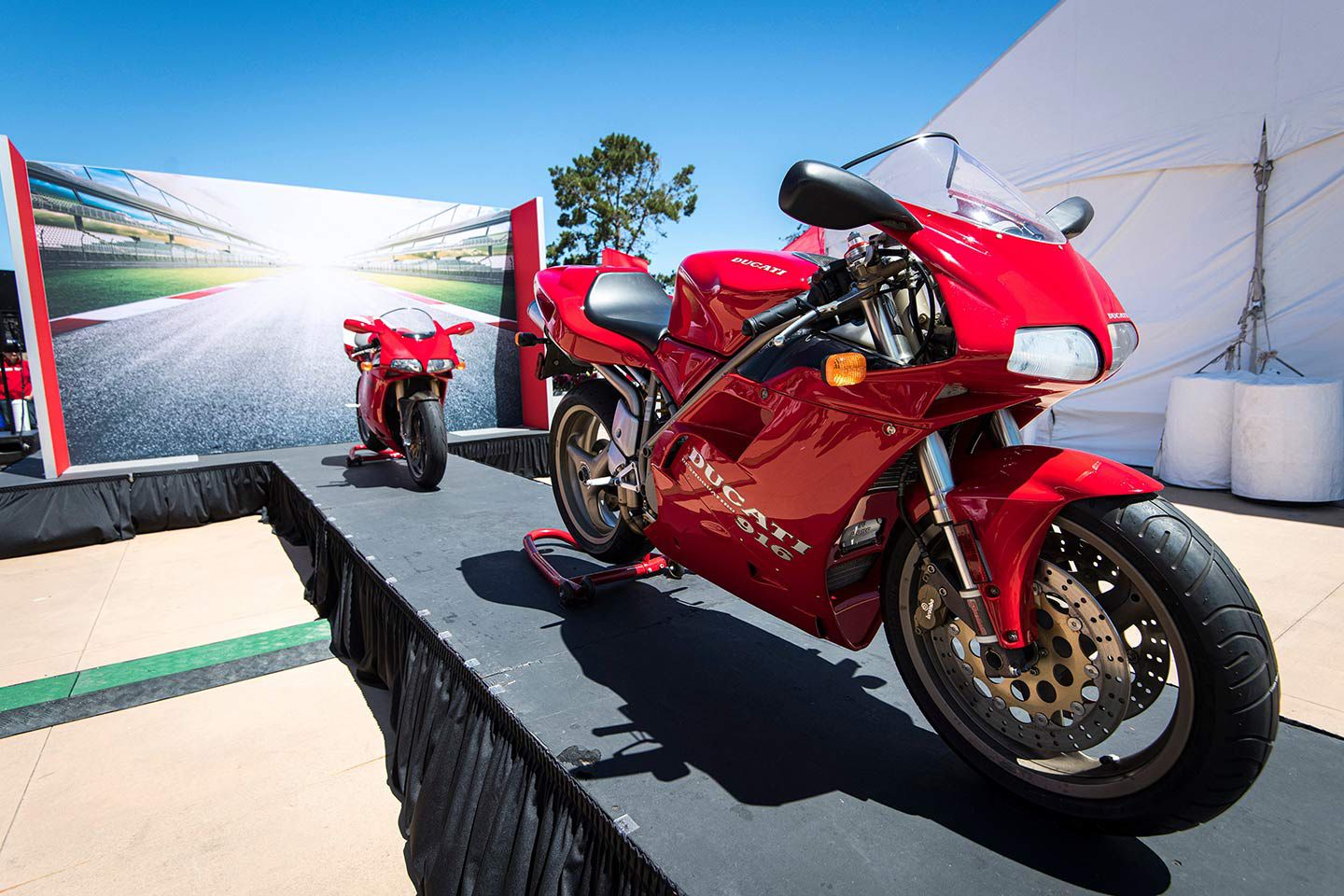
The Ducati 916 celebrates 30 years in 2024 and Ducati plans to commemorate that historic model with a special edition of the Panigale V4. (Ducati/)Ducati’s new-model launches for 2024 are being staggered over the next few weeks but a new approval by the California Air Resources Board has revealed that one of them will be a limited-edition machine to celebrate 30 years since the launch of the Ducati 916.
Given that Ducati made a 25th anniversary model—the Panigale V4 25th Anniversario 916—in 2019, perhaps it should be no surprise that the 30th anniversary is getting a similar treatment. However, the 2024 machine will be more exotic than the 2019 offering, as it’s based on the high-spec SP2 version of the Panigale V4 instead of the S variant that was the platform for the 25th anniversary bike.
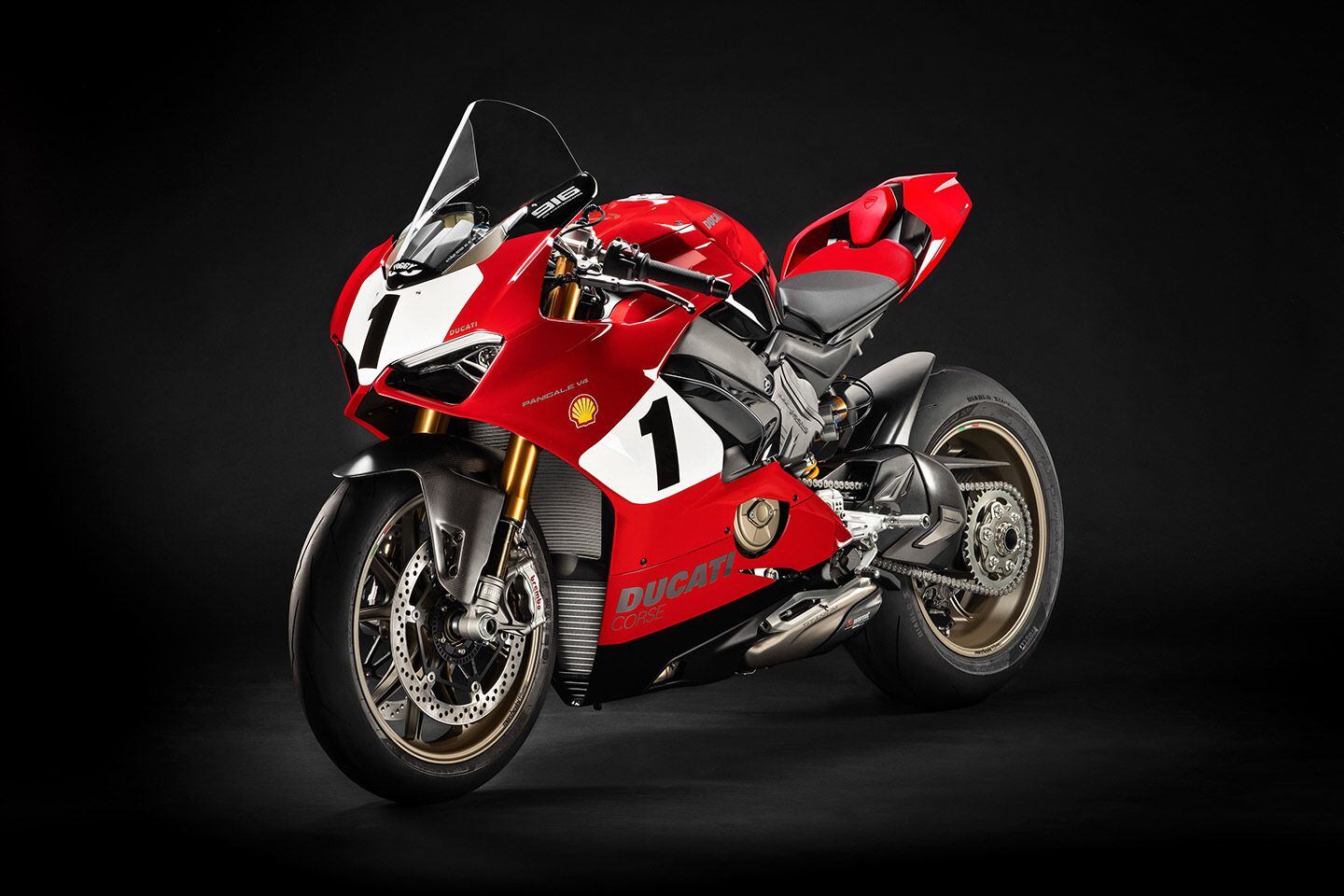
Five years ago, Ducati created a special 25th anniversary version of the Panigale and is expected to do so again to mark the 30th anniversary of the 916. (Ducati/)Apart from the name, the CARB filing doesn’t reveal much about the Panigale V4 SP2 30th Anniversario 916. Its weight is listed as being the same as the rest of the range—all Panigale V4s, from the base model to the V4 R, are within a couple of pounds of each other—and the engine is the same 1,103cc V-4 used in all versions apart from the 998cc V4 R. That means power is likely to be unchanged at 215 hp.
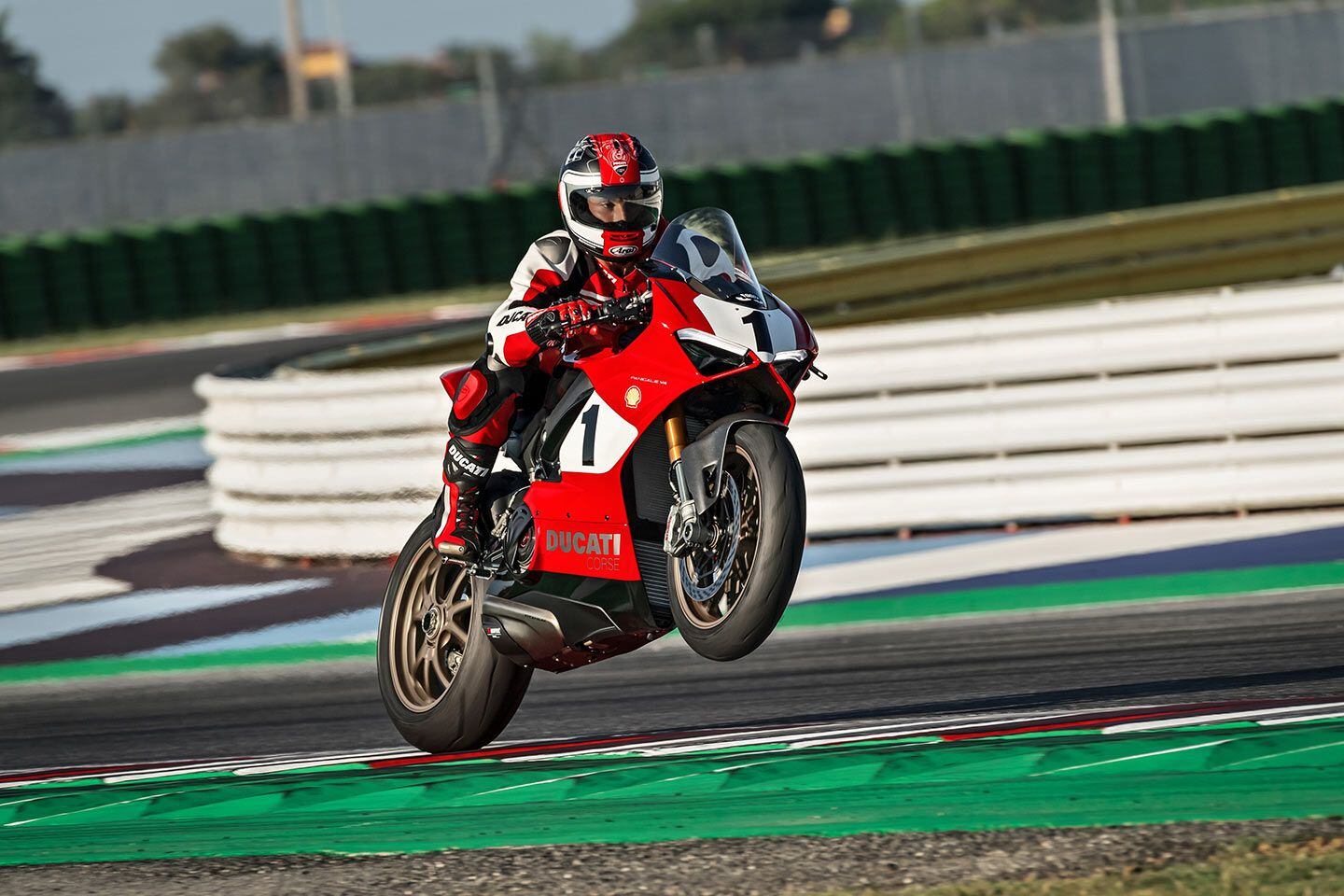
The Panigale V4 25th Anniversario 916. (Ducati/)The 25th anniversary model was marked out by additional carbon parts, forged Marchesini wheels, a titanium Akrapovič exhaust, and a selection of billet aluminum bolt-ons including the levers, filler cap, and mirror plugs. It also had a paint scheme that reflected the 916 racers that Carl Fogarty had so much success with in the 1990s, including Shell and “Foggy” logos that could be optionally applied to complete the look. It’s likely that the Panigale V4 SP2 30th Anniversario 916 will take a similar route, although the standard SP2 already sports high-end parts including an aluminum fuel tank, Öhlins NPX 25/30 fork, Brembo Stylema R brake calipers, and five-spoke carbon fiber wheels, leaving less scope for improvement on the limited-edition Anniversario model.
Ducati has already launched two models from its 2024 range—the Monster 30th Anniversario and the Multistrada V4 S Grand Tour—and there are more reveals planned for October 3, October 19, November 2, and November 7. Those remaining launches are expected to be the DesertX Rally on October 3, since Ducati’s teaser video shows deserts and a bike kicking up dirt for that date, followed by a track-oriented bike on October 19. November 2′s reveal is believed to be a new single-cylinder 660cc Hypermotard model, while the teaser for November 7 shows clips from inside the Ducati Museum, opening with a shot of the 916. From those teases, the Panigale V4 SP2 30th Anniversario 916 could appear on October 19 but is more likely to be coming on November 7.
-
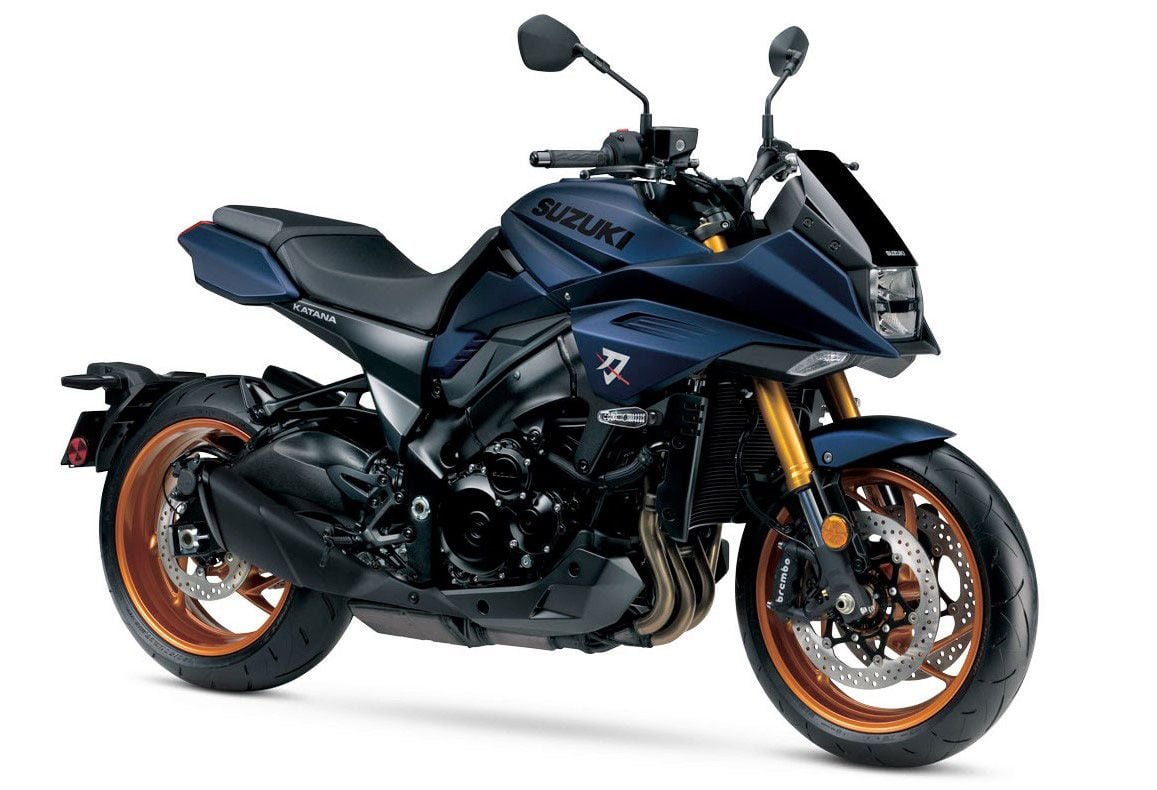
For 2024, limited numbers of Suzuki’s Katana will be available in the US. The bike is finished in Metallic Blue paintwork, gold forks, and gold wheels. (Suzuki/)Suzuki has announced the return of its neo-retro Katana to the 2024 lineup, and although the new model is aesthetically unchanged from last year’s bike—which had received meaningful updates anyway—we’re pleased to report there are actually a few minor tweaks this year. Also intriguing is the fact that Suzuki decided to give the 2024 Katana a smaller production allotment. In the company’s words: “This special, limited-run model is available for US buyers to reserve via special order through the Suzuki dealer of their choice. Availability is limited and reservations are accepted on a first-come, first-served basis.”
The addition of a collectible artwork and two years of Suzuki’s service maintenance plan, called Katana Premium Care, sweetens the deal. The bike can be reserved through October 20, 2023.
Related: 2022 Suzuki Katana First Look
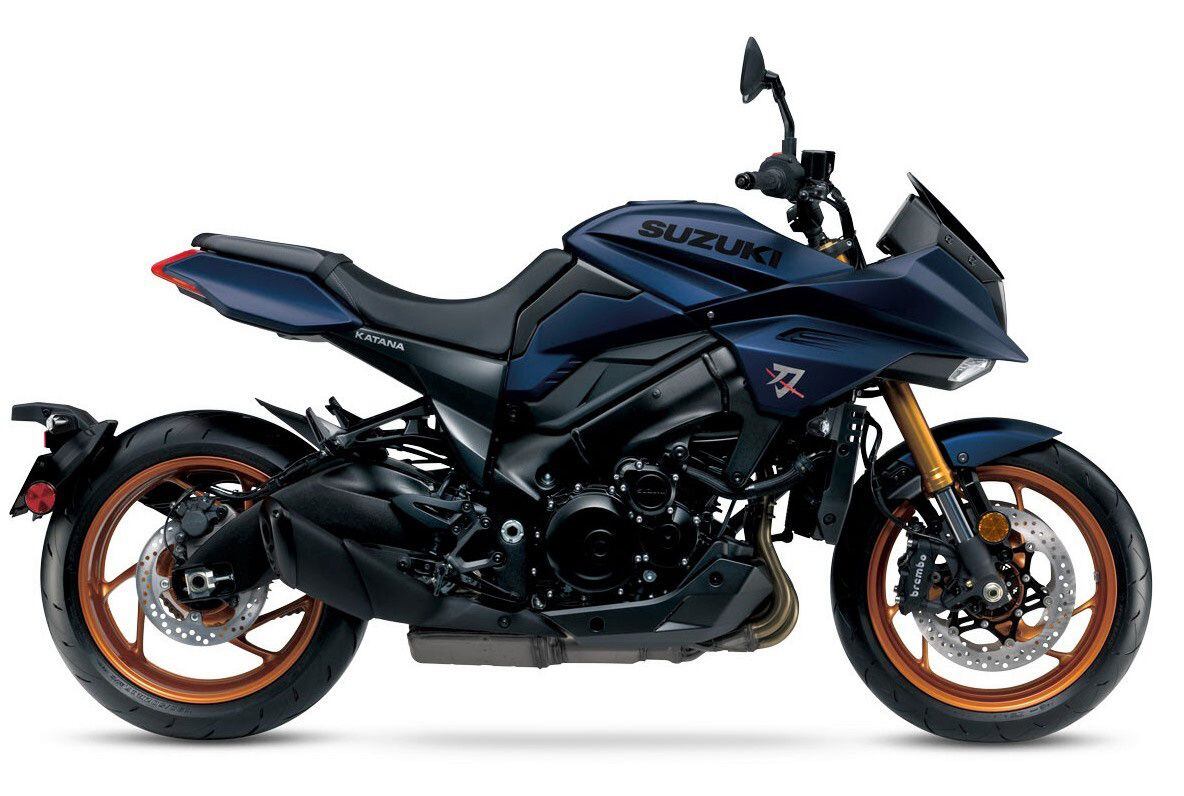
The Katana comes with Suzuki’s latest Drive Mode Selector system to manage three power modes and updated, five-mode traction control. (Suzuki/)How many units are being produced and exactly why it’s being limited is anybody’s guess, so let’s start with what we know. Rather than making massive changes to the 999cc GSX-R-based powerplant, which was already significantly updated in 2022 to meet Euro 5 guidelines, Suzuki decided to improve the electronics package.
The company says the 2024 Katana updates include the introduction of its electronic Suzuki Intelligent Ride System (S.I.R.S.) which comes with a bidirectional quick-shift system and updated, five-mode traction control system, as well as the Suzuki Drive Mode Selector Alpha (SDMS) providing three power modes. That’s not a surprise, since most of the GSX series got the same tech and electronic updates earlier this year, and even though Suzuki is touting new ride-by-wire throttle bodies, an updated slipper clutch, and more power for the 2024 Katana as well, those tweaks were actually seen on last year’s model, so unless there are further unspecified refinements to them, we’re not sure of their importance.
Related: Suzuki GSX-8R Likely on Its Way
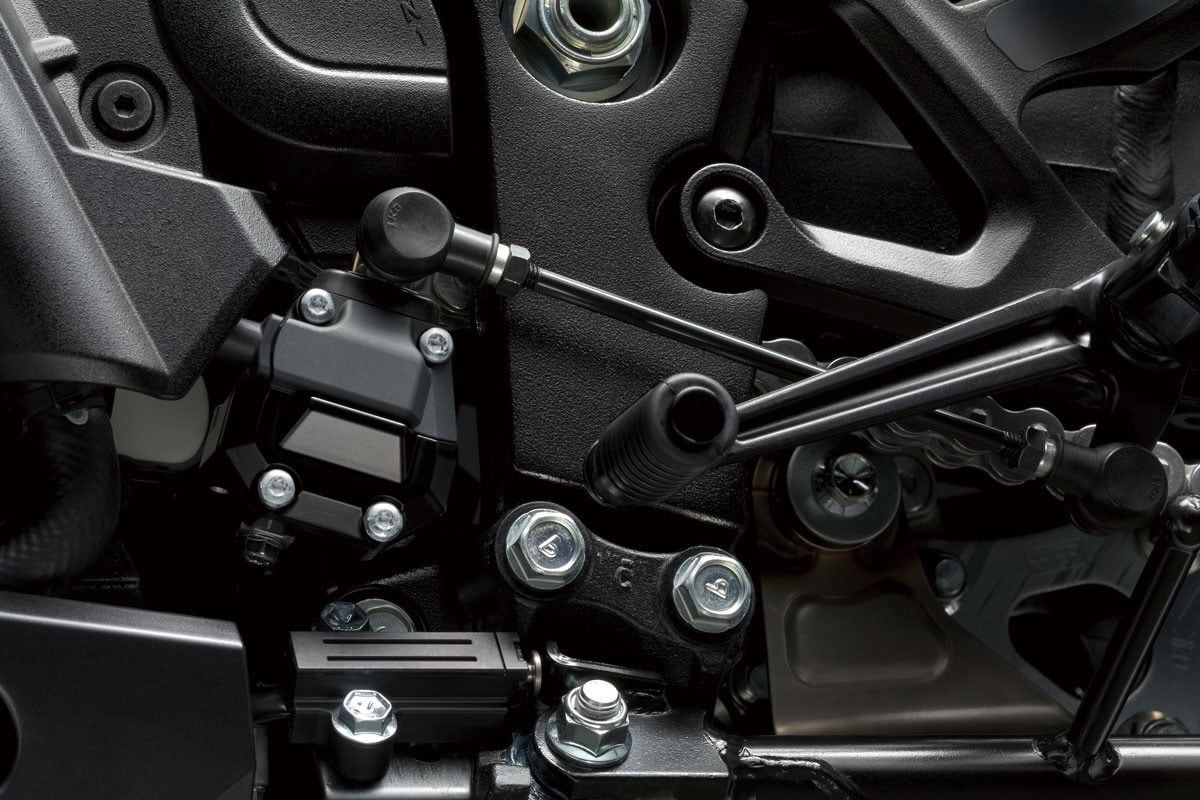
Suzuki is also calling attention to the Katana’s updated bidirectional quick-shift system for the 2024 model year. (Suzuki/)In short, the bike we see here appears to be a slight refinement of the updated 2022–23 model, when the 999cc inline-four engine got new intake and exhaust camshafts, valve springs, a 4-into-2-into-1 exhaust system, and airbox for improved efficiency. Those changes resulted in a claimed 2 hp increase and a wider spread of midrange power.
Back to the add-ons for this year’s model though: Reserving the 2024 Katana gets owners two years of the complimentary maintenance service as well as a collectible 24 x 24 inch digital lithograph reproduction of Japanese artist Makoto Endo’s Katana illustration, which was originally featured in Cycle World magazine.
Related: Updated Suzuki GSX-R1000 Coming
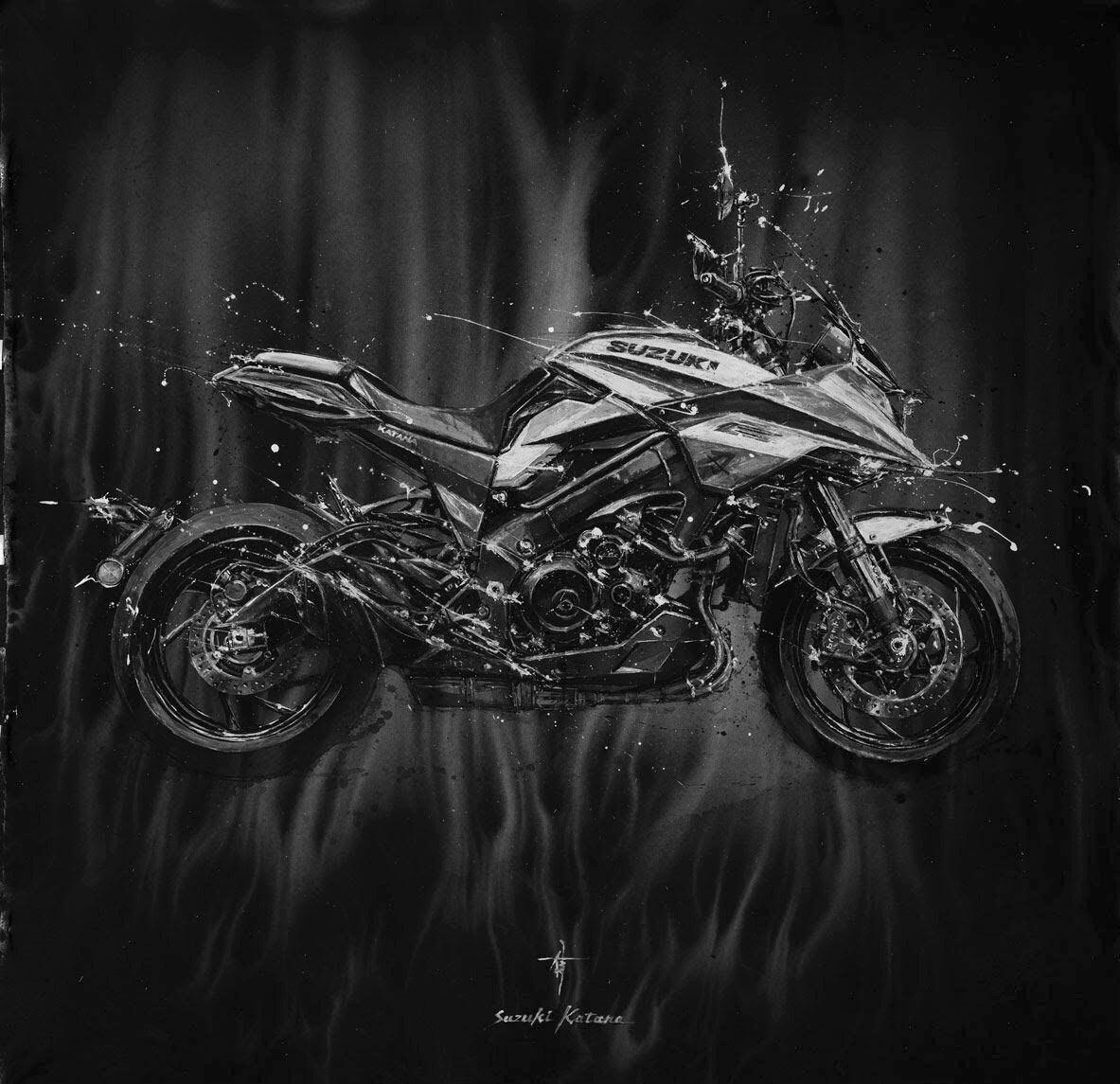
The 2024 Katana comes with a collectible 24 x 24 inch lithograph reproduction of Japanese artist Makoto Endo’s Katana illustration, originally featured in <i>Cycle World</i> magazine. (Suzuki/)As expected, the new Katana will also sport a fresh color for 2024 along with accents emphasizing remnants from the original’s Hans Muth styling. The bike gets slathered in deep Metallic Matte Stellar Blue bodywork and adds contrast via gold-anodized fork legs and matching six-spoke gold wheels. Suzuki also says a variety of accessories are available, such as a meter visor (sort of a sport screen), billet clutch and brake levers, axle spools, fuel tank and engine cover protectors, clip-on tank bags, plus a selection of apparel.
MSRP for the 2024 Katana is $13,879. See Suzuki’s bike-specific microsite suzukicycles.com/katana for more details.
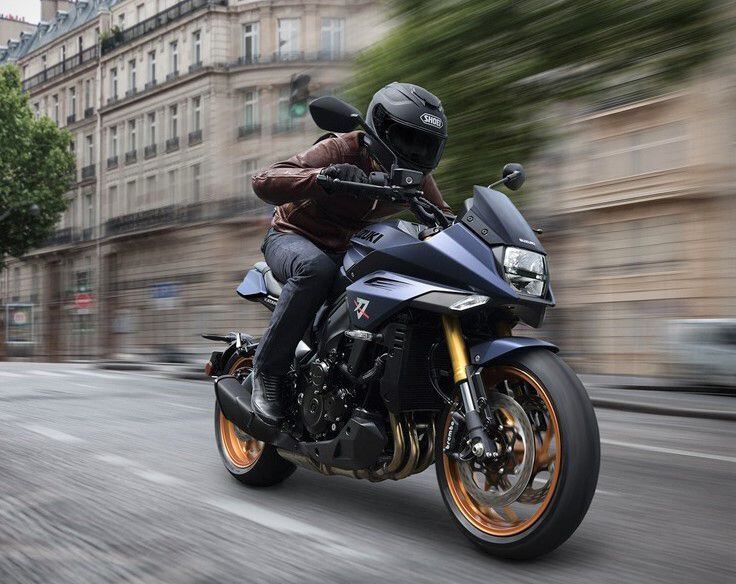
The limited-run Katana will also come with two years of Suzuki’s service plan, called Katana Premium Care, included. (Suzuki/) -

Ask Kevin Cameron (Cycle World/) Because motorcycles are built for many applications—touring, cruising, sport, and off-road—motorcycle handling must in each case deliver the kind of performance riders in that discipline need.
One way of looking at motorcycle handling is to consider stability versus control response. The sporting rider, wanting a highly responsive machine, soon discovers that response cuts two ways. A bike designed to respond promptly to the rider’s control inputs will respond just as promptly to other disturbances, such as bumps in the road or crossing railroad tracks at an angle.
The touring rider traversing the great flat states of Nebraska or Kansas, with the sound system playing favorite tunes, does not want to be constantly correcting. That motorcycle’s wheelbase will be longer, providing room for rider, passenger, and luggage without crowding. Wheelbase is also the lever or “tiller” by which steering the front wheel swings the rear to a new heading. The longer the wheelbase, the more slowly a steering input at the bars (or the effect of any accidental disturbance) becomes a whole-vehicle change of direction.
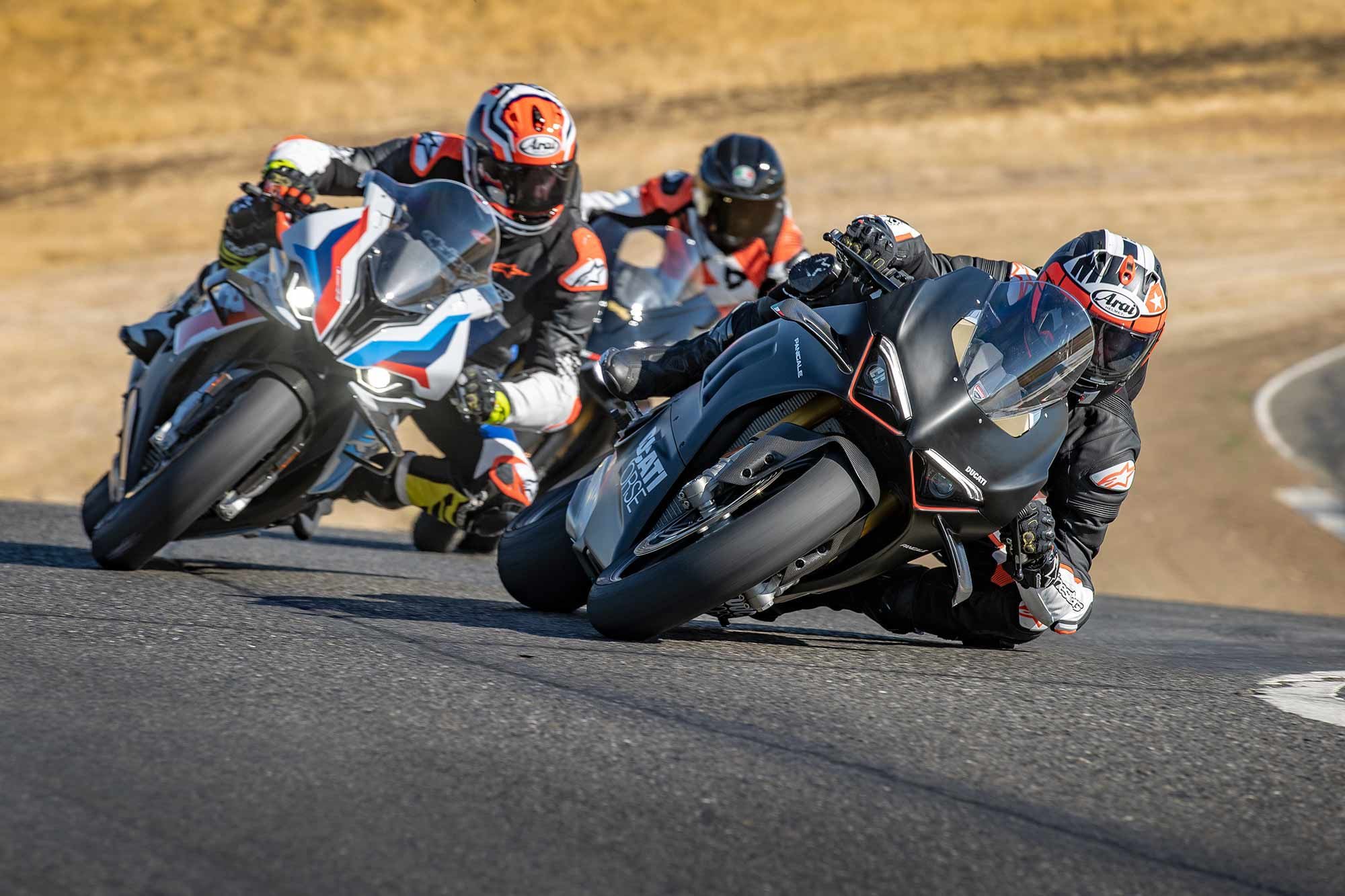
Sportbikes’ wheelbases have grown as power has increased, but are still relatively short in comparison to like “hyper” segments. (Jeff Allen/) Measure touring bike wheelbases and you’ll find numbers around 65 inches.
The sporting rider, being more entertained by curves and changes of direction, wants quicker steering and direction changing because in that way, maneuvers eat up less time and distance, and there is a tighter connection between cause and effect. Wheelbase is therefore made shorter. Stanley Woods, one of the great roadracers of the between-the-wars period 1919–1939, liked best a wheelbase of 52 inches. Giacomo Agostini in the 1960s, riding MV Agusta factory bikes, liked 53.5 inches. And today, racers in Superbike and MotoGP are most often on 56 inches.
Why the trend toward longer? As engines progressed from the 40 hp of the mid-1930s to double that in the late 1960s, more and more time could potentially be wasted in wheelies. Better to extend the wheelbase a bit to use more of that ability to accelerate.
Comparing MX and other off-road designs with those of 50 years ago is a shock. Back when suspension travel averaged 3–4 inches, MX bikes could afford a short wheelbase in return for quicker steering. But now that bikes with 8–12 inches of suspension travel are so tall—and much faster across our planet’s undulations—wheelbase has had to grow in order to keep the front wheel on the ground at least occasionally.
Longest of all wheelbases are those of dragsters, which are from 65 inches upward—again, to turn horsepower into acceleration rather than waste it in wheelies.
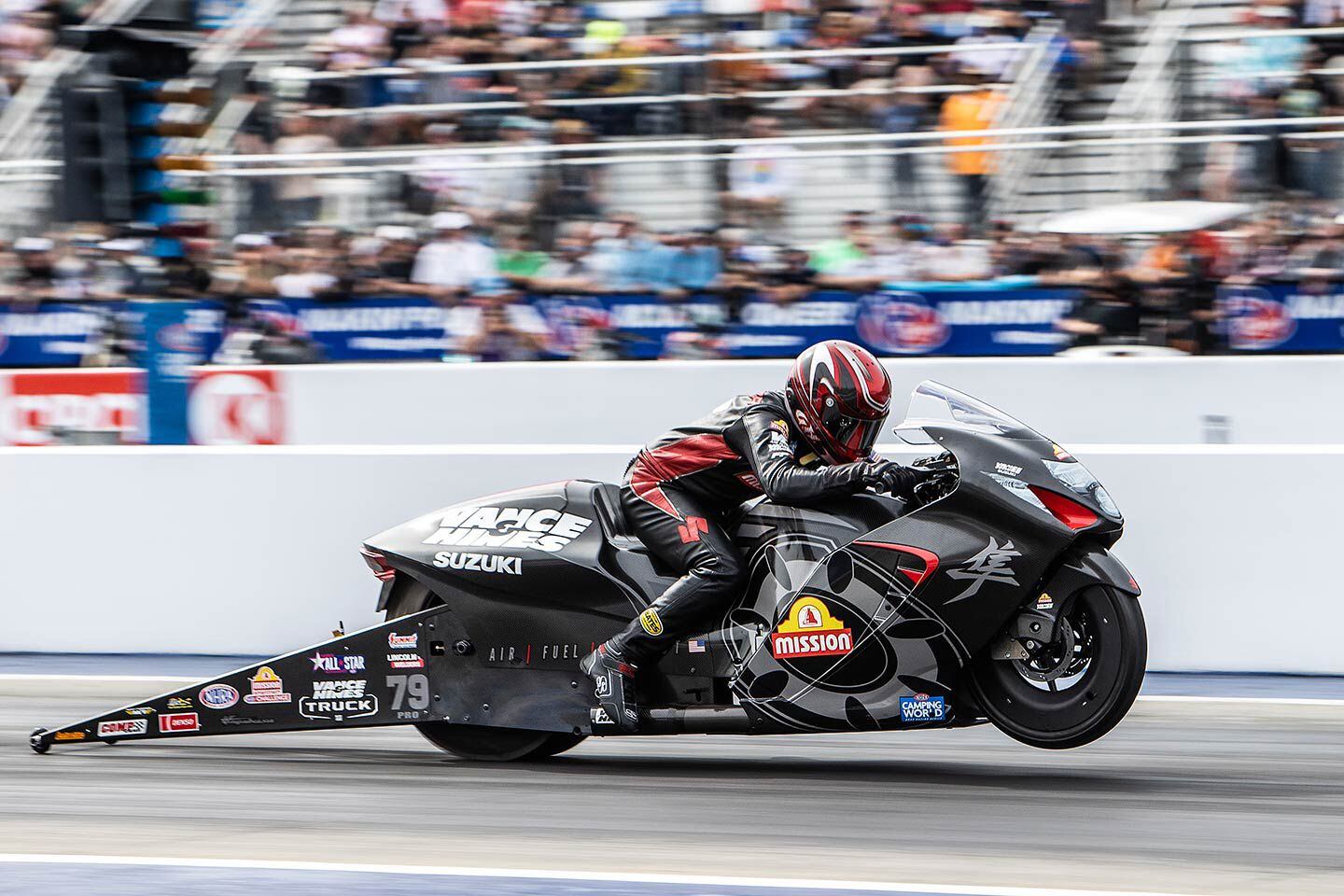
Acceleration is the goal of dragsters’ long wheelbase; turning is low on the list of priorities. (Suzuki/) Where does the engine belong in the frame? Forward? Back against the rear tire, “for traction” as designers of the 1950s claimed? Higher? Lower? Some time in the early 1960s came a piece of research published by the Japan Society of Mechanical Engineers (JSME), relating stability to engine position. Their conclusion, based on testing on a motor-driven artificial belt roadway? Move the engine forward for stability.
Today, have a look at most kinds of motorcycles and see that practice and theory agree. There are Honda’s Gold Wing and Harley-Davidson’s grand tourers, both with engines well forward (OK, part of the reason is to get them out from underfoot!).
The same is true of sport and racing pavement bikes; what use is increased engine power if the major result is wheelies that constantly interfere with control? Moving the engine forward makes wheelies less frequent and less sudden.
The big exception here is dirt-trackers. When I first saw a classic Harley XR-750 up close, I could see that its front and rear wheels were essentially pushed as close to the V-twin engine as possible, implying the shorter the wheelbase, the better.
Touring and cruising bikes have their engines set so low that 30–32 degrees of lean in cornering are about all she wrote (any more and bright sparks stream from hard parts hitting the pavement). Riders need to have the weight of those engines set as low as possible so they can confidently manage it when stopped at a light or maneuvering at low speed. The higher the engine, the worse the feeling that “I’ve gotta watch it or this thing will pin me to the pavement.” Likewise for the very low seat height—as little as 24 inches; it lets the rider plant his or her feet firmly on the ground to manage that weight.
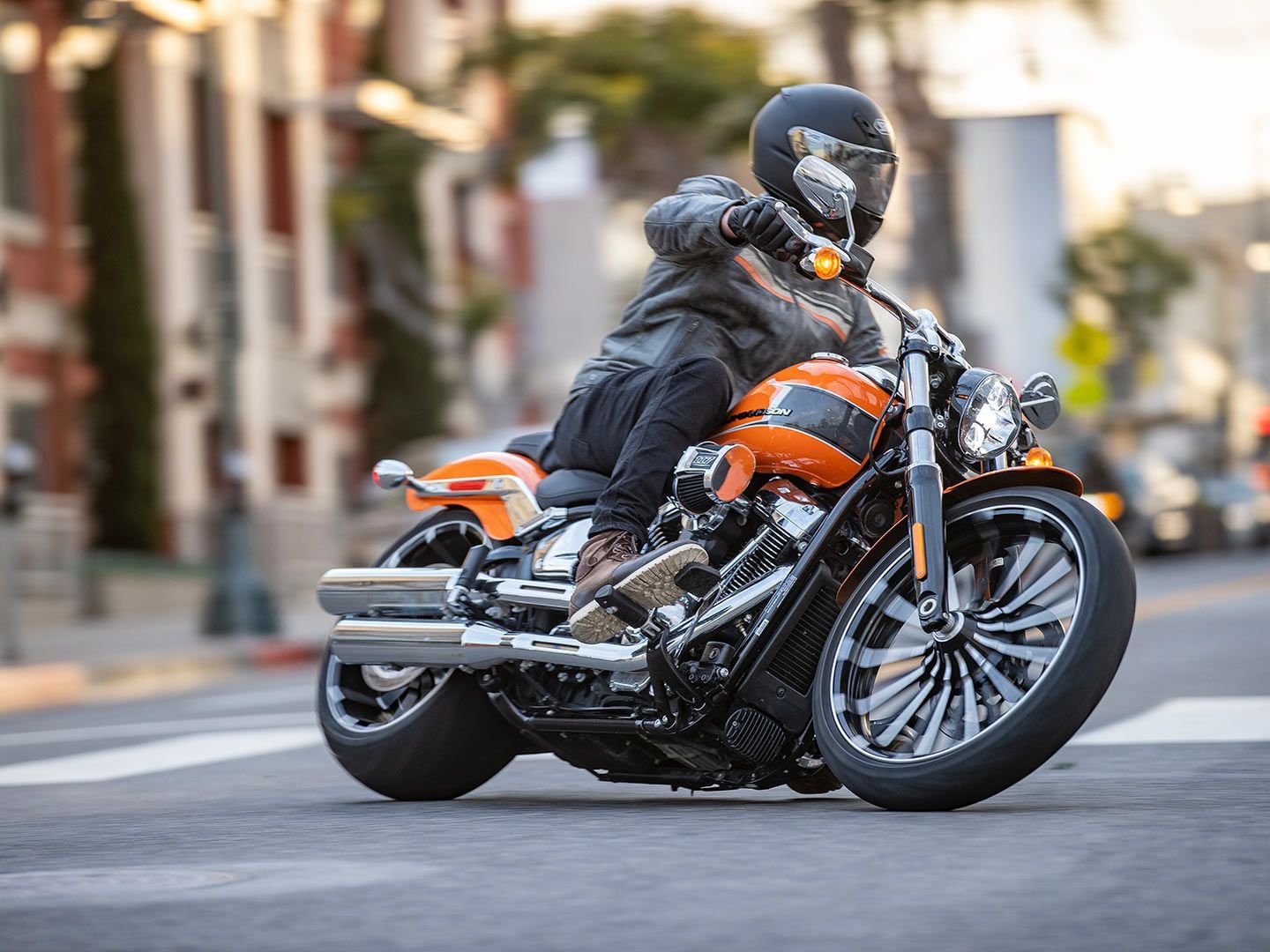
Low and long is the mix most used for cruisers. (Jeff Allen/) Sport and racing motorcycles, their performance dependent as it is on rapid roll response, need to centralize their major masses (engine, rider, fuel). This makes the bike act more like a 24-pound cannonball than like a 24-pound ladder when responding to forces trying to change its orientation. Mass centralization lies at the heart of quick response.
One hundred twenty-five years of tire and rubber development has given us fabulously grippy tires, but in order to use that grip to the full we need cornering clearance (the ability to lean bikes to tremendous angles) as great as 63 degrees from vertical, in the case of racing slicks on good pavement. That too requires engines set quite high in the chassis, and made as narrow as possible (which is part of the reason why the cam drives of in-line four-cylinder engines were moved from the center of the crankshaft to one end; it allowed deleting the extra width of one of the six main bearings formerly used).
Another matter is steering geometry, which refers to two numbers:
- The angle at which the steering axis is set to the vertical (the <a href="https://www.cycleworld.com/2015/05/22/cycle-world-tips-and-tricks-understanding-motorcycle-rake-and-trail/">rake</a> angle)<br/>
- The distance by which the center of the front tire’s footprint trails behind the projection of the steering axis onto the pavement (the <a href="https://www.cycleworld.com/blogs/ask-kevin/what-is-motorcycle-trail-explained/">trail</a>).<br/>
Back in the 1970s rake angles for pavement sport and racing bikes were in the range of 27–31 degrees. A good reason for these numbers (unfashionably large today) was the greater general flexibility of the steel tube chassis of that time. The more flexy the chassis is, the more vulnerable it is to instability, requiring more stable steering geometry to make it behave.
As stiffer chassis and forks came into use in the 1980s, smaller rake angles and somewhat shorter trails became usable. Today’s sportbikes have rakes in the vicinity of 23.5 to 24.5 degrees, with trails in the range of 3.75 to 4.0 inches. Because of this, older bikes with rakes up around 30 degrees look decidedly vintage to me!
Another thing to mention in regard to chassis stiffness is steering delay. Years ago CW’s former resident off-road editor Jimmy Lewis described riding two makes of 125 dirt bikes with nearly identical rake and trail. Yet, he said, one of them delivered right-now steering while the other was sluggish. Compare the fork and bars on a 60-year-old Triumph 650 with one of today’s middleweights. You could hold the Triumph’s front wheel between your knees and turn the bars through scary large angles. Today’s bikes have at least two lower crown pinch-bolts per fork leg, and maybe three—these new front ends don’t budge when you apply the above test. The Triumph, having a high-vibes parallel-twin engine, was given squidgy rubber-mounted bars that added even more steering vagueness.
Bottom line? The more bendy stuff there is between your hands and the front tire, the less responsive your ride will feel.
The aesthetics of the chopper movement glorified large rake angles up around 35 degrees or even more. They probably originated in the large rakes found in the 1950s to give good stability at Bonneville or on the dragstrip. Occasionally a stylist today will “go for the look” by angling the fork legs more than the steering stem, thereby combining a bygone look with reasonably modern steering.
-
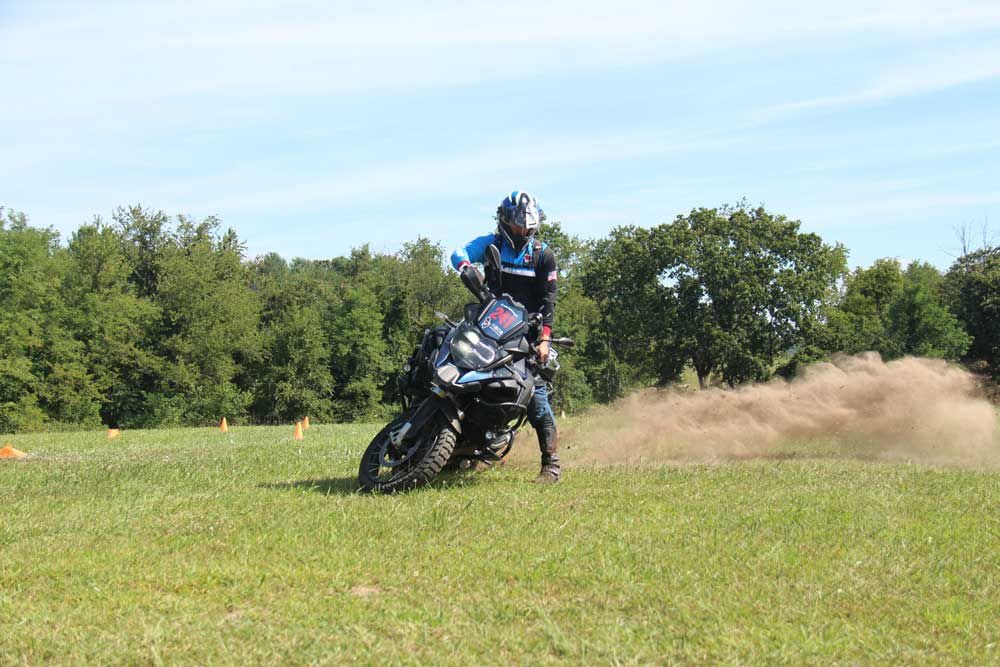
Ben Phaup, 2022 BMW International GS finalist and owner of 241 Moto, demonstrates an elephant turn. (Rob Bandler/)When I rode my BMW R 1250 GS press loaner to Penmerryl Farm in Greenville, Virginia, it didn’t have a scratch on it. I have this innate desire to keep a motorcycle pristine—even when I don’t own the thing—but training for the BMW GS Trophy Qualifying means pushing myself beyond my predispositions. That desire to keep the GS looking new has to die. If I want to build my skills, the GS isn’t the only thing that will have to get beaten up a bit.
That much was obvious as soon as I dropped the bike trying to maneuver it through a field of cone courses that looked like they were set up for my toddler’s soccer practice. But this wasn’t child’s play; these impossibly tight courses were examples of what I can expect to encounter at the Trophy Qualifier in October. “This is crazy,” I exclaimed in my helmet. At least I found some comfort knowing I wasn’t alone in my estimation of the situation.
“[The courses are] really tight,” Ben Phaup says. “It’s eye-opening just how tight everything is. If you look at videos, it doesn’t look that hard until you’re on the bike doing it.”
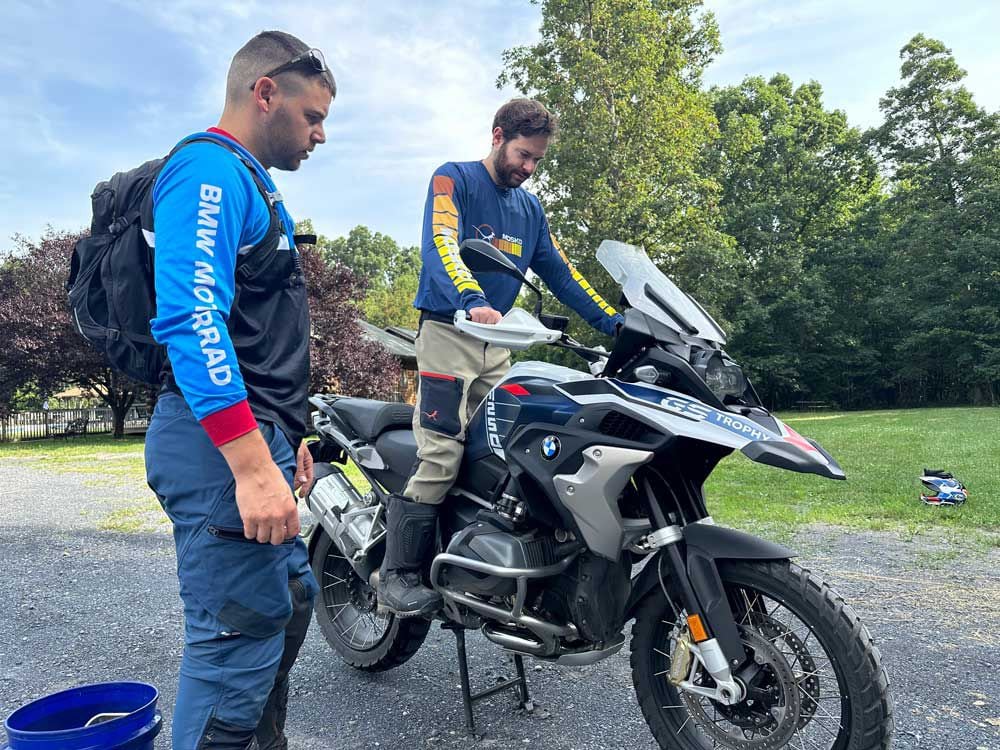
Phaup and the author adjust the GS’ handlebars to dial in the ergos for off-road riding. (Rob Bandler/)Phaup, who was a member of Team USA at the 2022 BMW International GS Trophy final in Albania, is not prone to exaggeration. The straight-shooting Virginian, a former Marine and father of three, is the kind of guy who likes a challenge—the more strenuous, the better; the more unlikely the odds, the more appealing. Phaup sacrificed a year of evenings and weekends—and much more than that—to train for Trophy Qualifying. In the end, he earned his spot in the finals on his very first attempt.
I wanted to train with Phaup at his newly founded school 241 Moto to see firsthand what it takes to make the Trophy team and to learn some skills of my own. Phaup offers beginner- to advanced-level off-road training, and aspires to make 241 Moto the go-to outfit for Trophy Qualifying training.
“Everything is full-lock turns,” he says of Trophy training. “If you can master that, it’s the biggest thing you can do.”
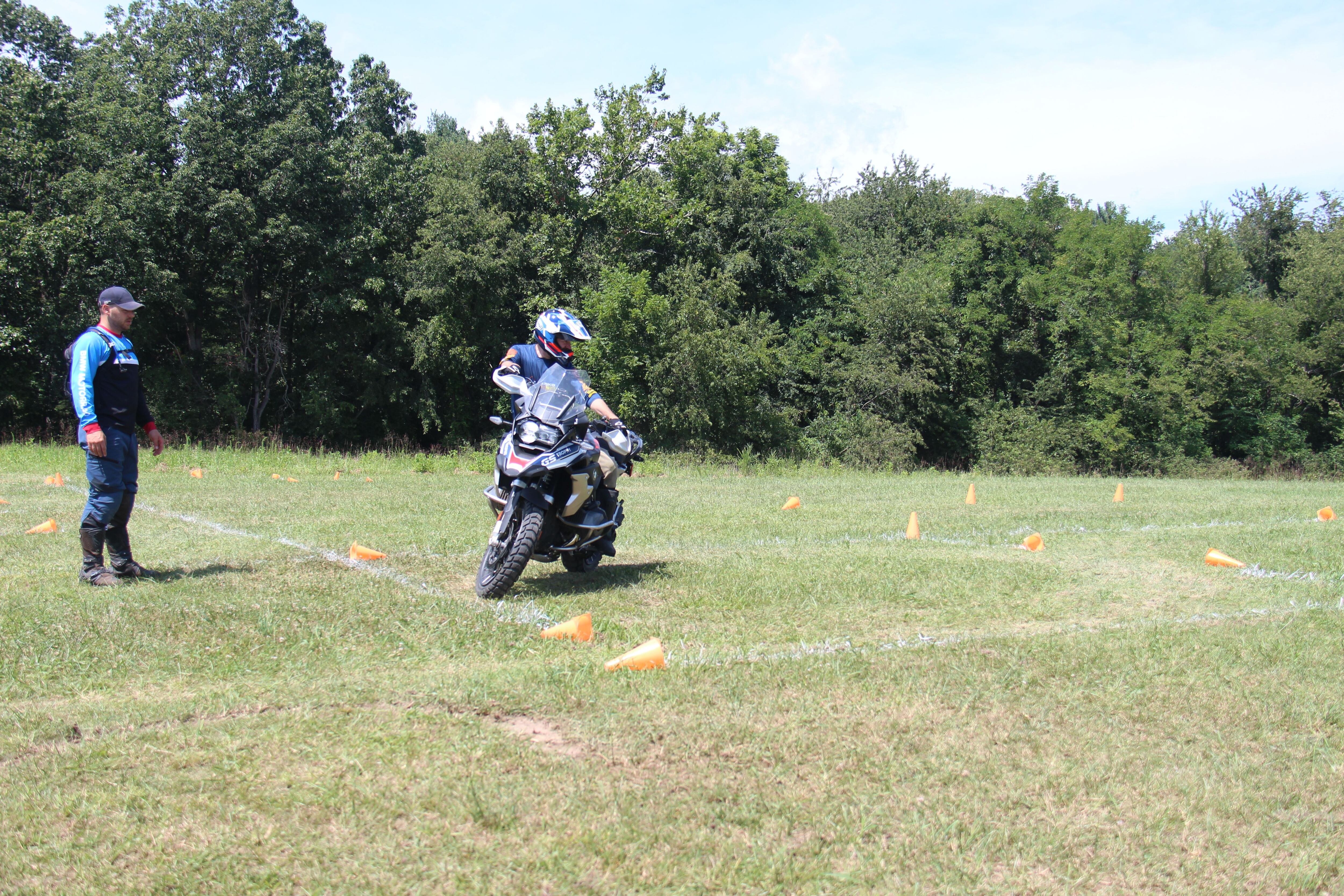
Practicing box turns at Penmerryl Farm in Greenville, Virginia. (Rob Bandler/)For those of us who’ve spent most of our riding lives on sportbikes with minimal steering lock, doing a full-lock turn on purpose is a very foreign feeling. When doing a U-turn on a motorcycle, if the bars hit the stop, the bike feels like it’s dropped anchor and the front wheel is going to fold.
For Trophy riding, it’s critical to master the full-lock turn in order to execute many of the maneuvers. Take the classic box turn. The “box,” a 16-foot-by-16-foot square painted on the ground, is the field of play: Without touching the boundaries or dabbing, competitors ride in three dizzying circles in one direction before entering an adjacent square to do the same in the reverse direction. On a 550-pound R 1250 GS, it means turning the handlebars to the stop and using body weight and smooth inputs at the controls to trace an inch-perfect circle through the box. Vision, balance, and line selection are paramount.
Trophy tests are designed to push the limit of riders’ abilities and the GS’ capabilities. While the GS is renowned for its generous steering lock, one still has to know how to take advantage of it. Phaup says that some maneuvers, like a 16 x 16 box turn simply aren’t possible on motorcycles with less steering lock—a lesson he learned the hard way.
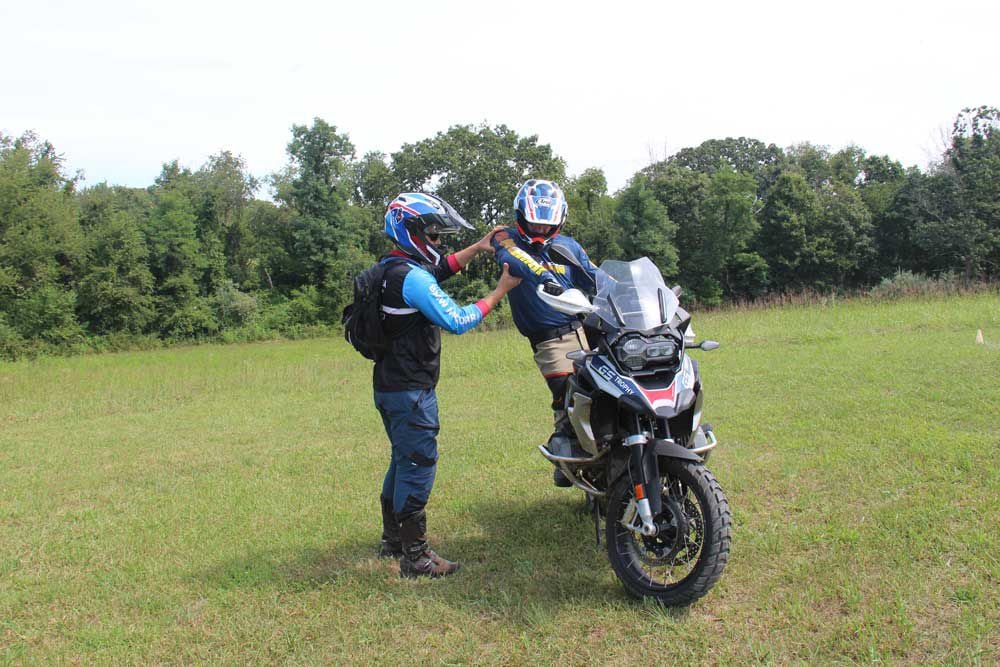
Adjusting body position to get the hang of full-lock turns (Rob Bandler/)When Phaup first learned about the GS Trophy, he mistakenly believed it was a competition for professional riders. Then he heard Shawn Thomas, BMW brand ambassador and owner of Stromoto Training, on the Adventure Rider Radio podcast explaining that it’s an event exclusively for amateur riders and GS owners. When he learned that finalists get an all-expenses-paid trip to an exotic location to compete on a brand-new GS with their name on it, he was immediately inspired.
“In that moment, everything clicked,” Phaup says. “I knew instantly that I was going to be on Team USA—somehow, some way I was going to be there.”
The first obstacle: He didn’t own a GS. Worse, it quickly became apparent that it wasn’t even feasible to practice on the motorcycle he owned.
“I was enjoying my new-to-me KTM 1090 R,” Phaup says, “but its turning radius was so bad compared to the GS. I couldn’t do the drills on it. I loved the 1090 but I was like, ‘I’ve gotta sell it and get a GS,’” he recalls.
As soon as he could, he found an immaculate used 2016 R 1200 GS Adventure.
“It was a garage queen,” he says. “I told the seller, who was a longtime GS owner, what I was going to do with it and he had no clue what the Trophy was. He’d never been off-road, and dismissively said, ‘Some people try to treat these things like dirt bikes…’ I just nodded and laughed. After I left, he looked up the Trophy. I don’t think he would have sold it to me had he known [what I was going to do with the bike].”
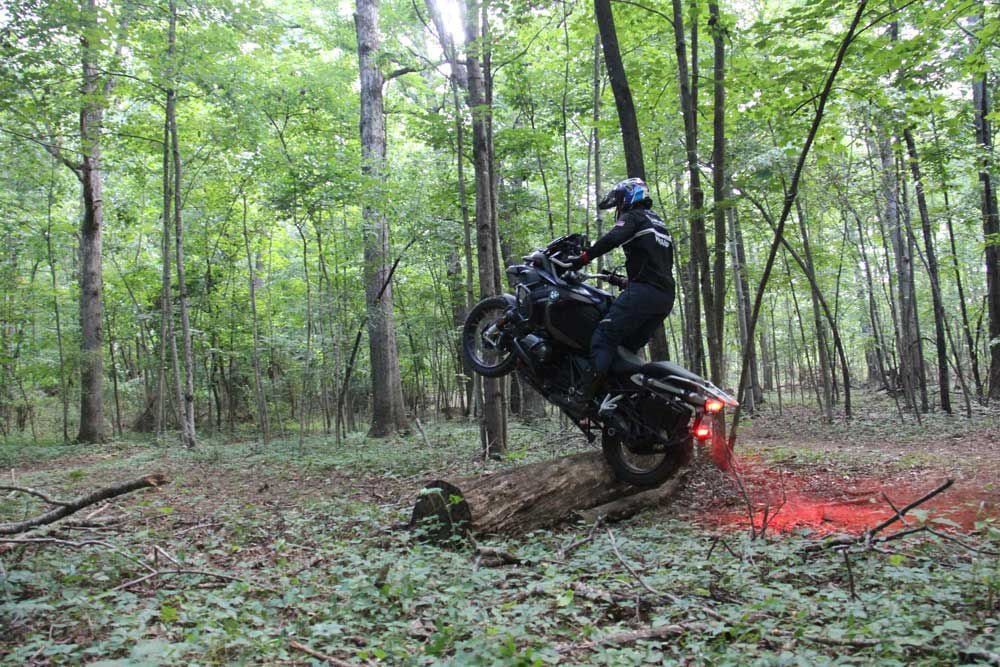
Phaup in action. (Rob Bandler/)And what Phaup does with it is a thing to behold. Climbing impossibly steep embankments, jumping logs, drifting through corners, wheelying for days—generally riding it as if it were a single-cylinder enduro bike. Watching Phaup toss the big GSA around has big entertainment value. He makes it look effortless. It’s humbling.
At Penmerryl, he led me through some of the miles of trails, and I struggled to keep him in sight. Even more than just single-skill maneuvers, like turning tightly, stopping without putting a foot down, or going up or down a steep hill, the really difficult part is combining multiple skills at the same time. To negotiate a steep drop-off/180-degree switchback on the trail required simultaneously combining all of the aforementioned skills. Trail riding on technical terrain like this is really what I want to get good at.
Practicing the cone courses that I’ll see in Trophy Qualifying is an excellent way to build the skills that I need in the wild, but the truth is, I was struggling even in a controlled environment. I’m still not sure what held me back more: my body or my mind. The blisters on my hands burst. I was light-headed from the Virginia heat. I bruised my body and my ego every time I dropped the bike. It stopped being fun.
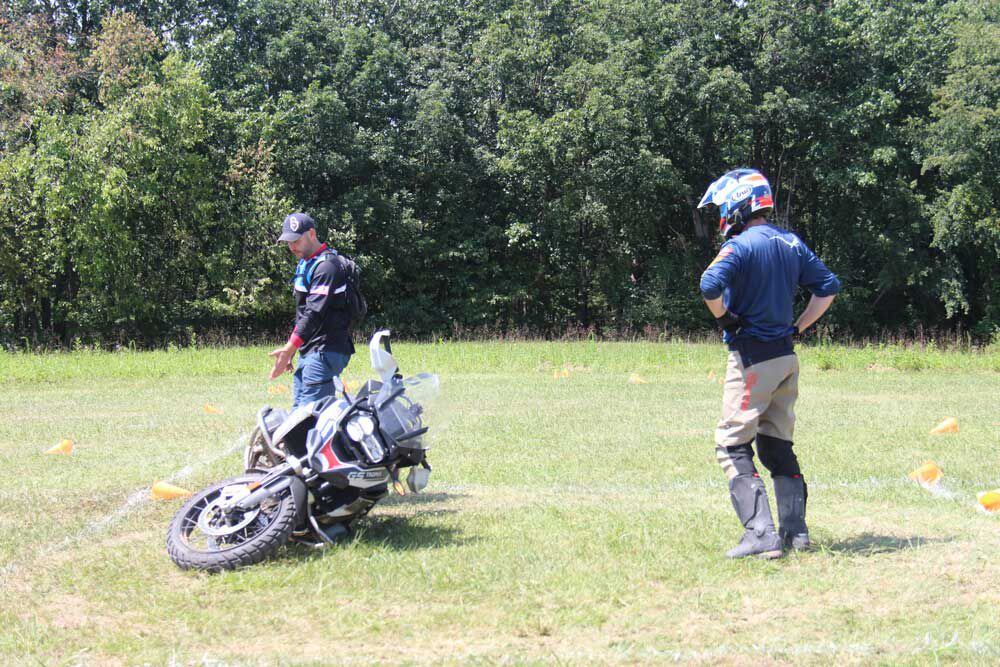
A familiar sight: The GS resting on its cylinder head cover. (Rob Bandler/)It’s daunting to come face to face with one’s limitations. Pushing past them and silencing the self-doubt requires serious intentionality. Having committed to competing in the GS Trophy Qualifying means there’s no going back; I have no choice but to face my limitations every time I practice. The extent to which one is willing to submit to failure to find the beginning of success comes down to motivation.
“You have to want it bad enough,” Phaup says. “I’m very competitive by nature. I hate to lose. The more the odds are stacked against me and the more people say something can’t be done, the more it motivates me to prove them wrong. I really locked in and got tunnel vision on training for the Trophy. I poured everything I had into it, which was challenging as a husband and father of young children. There were a lot of evenings when my wife put the kids to bed by herself while I was out trying to get in a little time. In the winter, I was out training in the dark. If the weather was nasty, I was out doing static balance drills or doing full-lock turns in the garage, anything and everything to dial in on slow-speed stuff.”
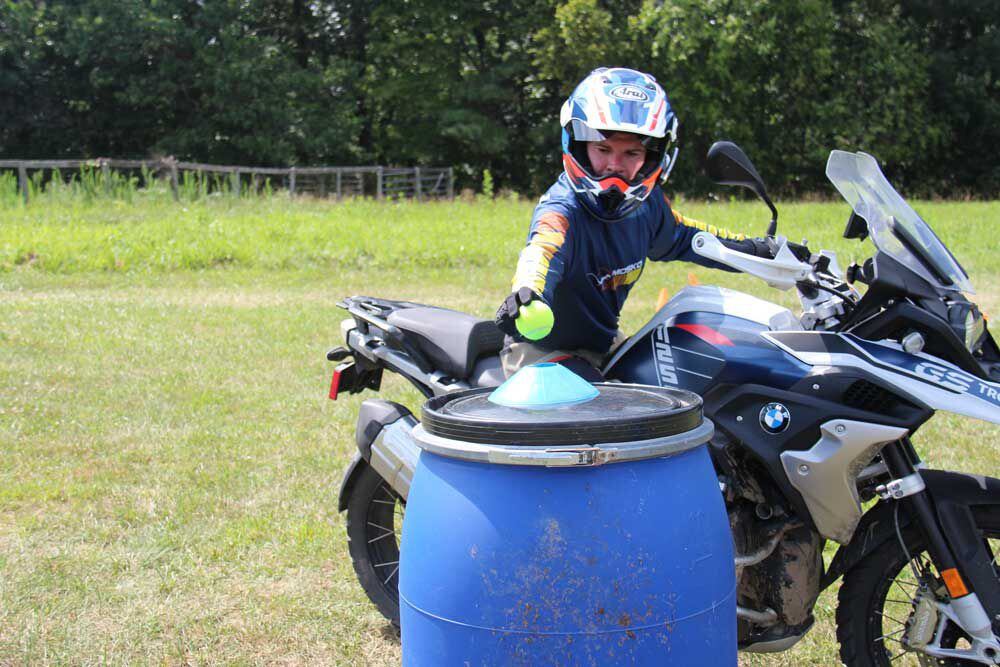
Practicing a common Trophy skill. (Rob Bandler/)After returning home, I continued to struggle. I dropped the GS so often the cylinder head covers started to look like I took an angle grinder to them. Even when my failures got to my head, I didn’t accept defeat. I began to realize that success and failure aren’t black and white.
“There’s a lot of gray area inside of good technique,” Phaup says. “The individual rider may have to make small adjustments in that gray area in order to find what works best for them. As an instructor, my goal is to give my students the tools to work with to make them successful. That might look different for different people.”
Before long, I personalized the techniques I learned from training with Phaup, and began to see some progress—in my riding and in my mindset. I’ve grown accustomed to enduring the failures that come along with pushing for improvement.
While my wife is putting the kids to bed, I’ve been practicing: in the rain, in the sweltering heat, in the dark, and when it takes all of my willpower to get off the couch after a long day of looking after the kids. I return home drenched with sweat, with mosquito bites all over me, and a new bruise or two. The GS’ cylinder head covers look worse everyday.

Penmerryl Farm’s mix of grassy fields and wooded trails offer an ideal location for training. Most people won’t have the luxury of such conditions at their homes, but a parking lot will suffice to practice some of the basics. (Rob Bandler/)I’m satisfied with my effort, even when I’m not satisfied with my performance. Being willing to fail again and again is a success all its own, and it makes every accomplishment all the more gratifying. I can glimpse that more skilled future self I’d hoped I’d become when I committed to doing this whole thing.
Unlike Phaup, I’m not motivated by a desire to win, but the more time and energy I’ve invested in training, the more I want to keep investing. Motivation is self-perpetuating. It’s a shame I only have a month to go before qualifying because I have a lot left in me to give. It’s even more of a shame that winter will be here before I know it and I’ll have to return the GS to the folks at BMW. I hope they don’t mind a few scratches, because for me, they’re not a sign of failure. They’re a promise of success. Those scratches are sacred; as are my own. I’m beaten up, but not beaten.
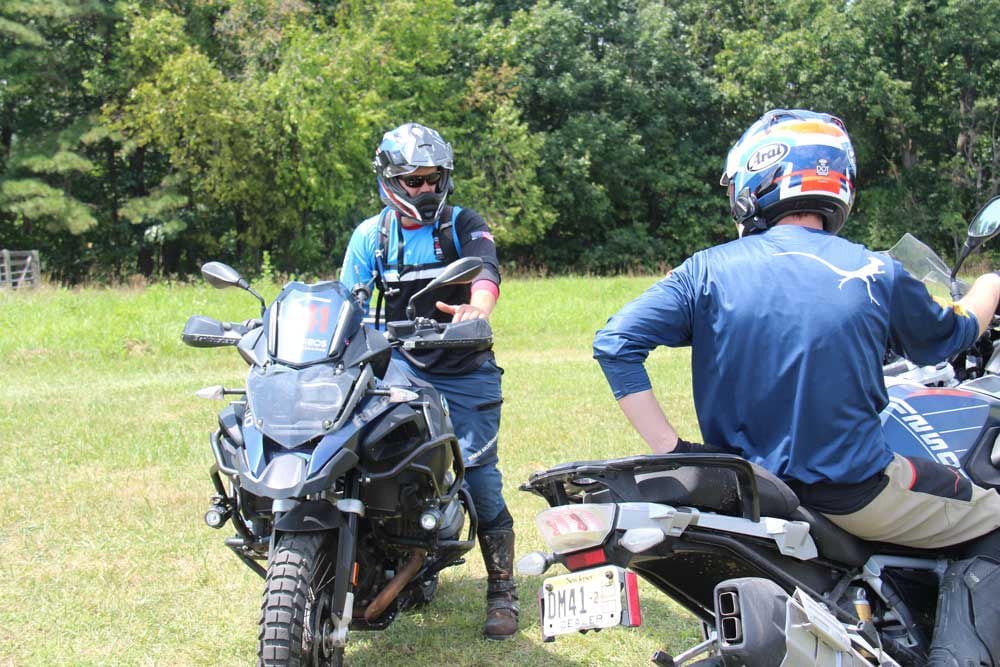
Phaup says: “241 was the number on my competition bike at the 2022 GS trophy. For me, being part of the US GS Trophy Team changed my path in adventure motorcycle riding. It’s opened a lot of doors for me so it seemed fitting to use my number moving forward.” (Rob Bandler/) -
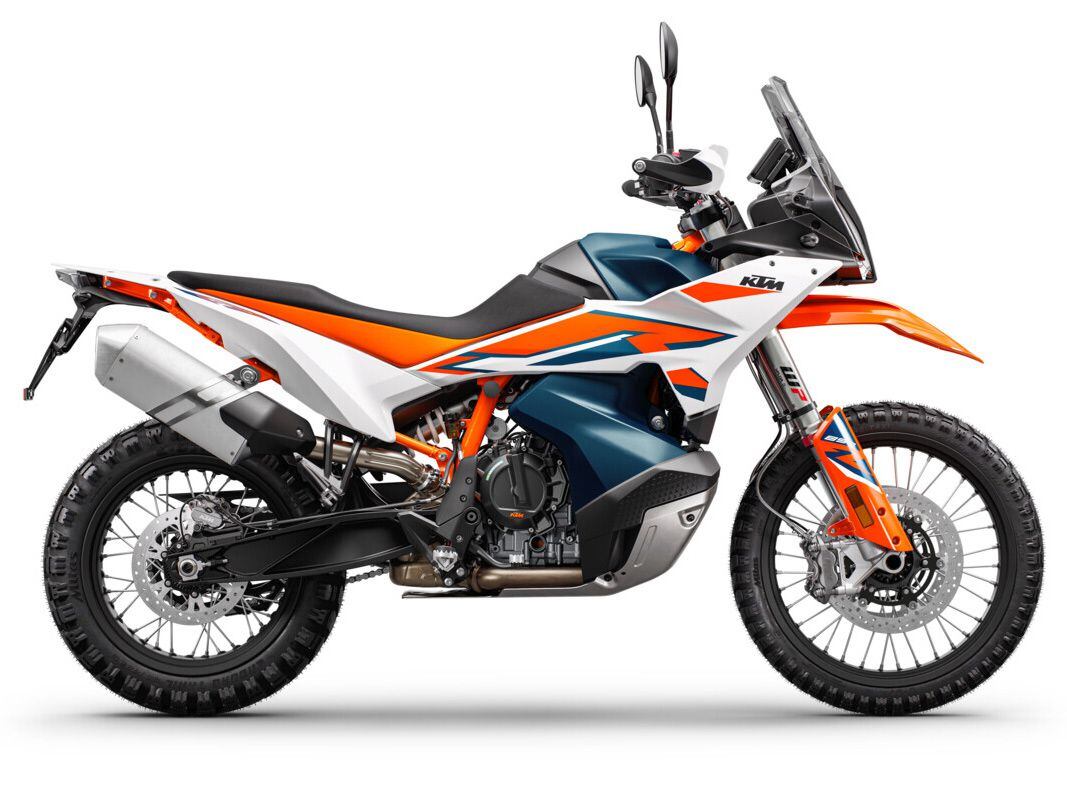
2023 KTM 890 Adventure R (KTM/)Ups
- Low-slung fuel tank gives a low center of gravity that makes it easier for riders of every skill level to find their limit off-road
- Top-end rider aids are simple to use and incredibly effective
- Compact LC8c engine is tractable, laugh-out-loud fun, and refined enough for touring comfort
Downs
- At start-up the engine sounds like a toolbox falling down a flight of stairs
- Available in any color you want as long as it’s orange
- Brakes aren’t as high-spec as what can be found on some of the competition
Verdict
The benchmarks of the middleweight adventure category, the 890 Adventure and Adventure R shatter preconceptions of adventure-touring performance. Anything but top-heavy or cumbersome, these middleweights impress with killer rider aids, a responsive chassis, and a rowdy engine.
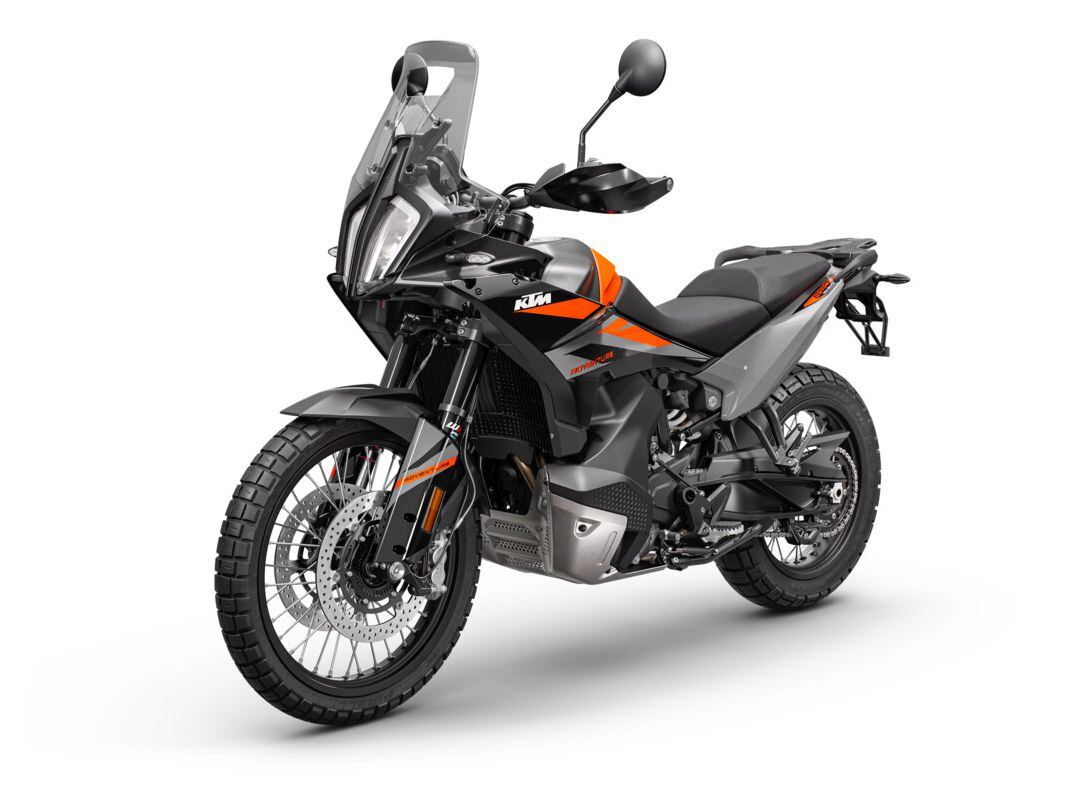
2023 KTM 890 Adventure (KTM/)Overview
Adventure bikes, by nature, are the most compromised motorcycles on the market. They’re the proverbial jacks of all trades, but masters of none. There’s no perfect intersection of touring comfort, sport-riding exhilaration, around-town usability, and off-road capability that satisfies riders who want their machine to excel in every area. However, if those required traits were displayed on a Venn diagram, KTM’s 890 Adventure and Adventure R would increase the overlap between each circle.
When KTM unveiled the LC8c-powered 790 Adventure and Adventure R in 2019, we said: “It set a new standard in the adventure segment for dirt-worthiness,” and that “it nearly makes open-class machines irrelevant.” In other words, it was a game-changer.
Since that time, the middleweight class has become arguably the hottest segment in motorcycling as OEMs have attempted to wrest the middleweight crown from the rally-worn hands of the madmen from Mattighofen. Never one to rest on its laurels, KTM upped the ante in 2021, introducing the 890 Adventure and Adventure R, with a revised, larger-displacement 889cc engine with a higher compression ratio, larger intake and exhaust valves, an updated camshaft, and lighter pistons. In 2023, KTM revised the platform yet again.
One of the qualities that sets the 890 Adventure R apart is its low center of gravity. With most of its fuel sitting in front of the rider’s shins rather than on top of the machine, the 890 feels like a smaller, more nimble machine than its competition, inspiring riders to reevaluate what they thought they were capable of tackling on an ADV bike—both on and off-road. Coupled with a supereffective parallel-twin engine, impressive rider aids, great ergos, and unbelievable suspension—particularly on the R model—the 890 puts all other ADV bikes on their heels in the dirt. Even the base-model 890 Adventure, which uses less expensive, less off-road-biased suspension, is still an effective tool off-road while being more manageable for shorter riders and more aerodynamically efficient on the street.
It’s not like the 790/890 Adventure lineup were the first middleweight adventure bikes in the world, but they certainly opened a lot of people’s eyes and made good on the promise that yes, adventure motorcycles can go off-road, and yes, you should definitely get them as dirty as possible. The 890 Adventure series is what happens when you give a dirt bike manufacturer the keys to daddy’s adventure-tourer.
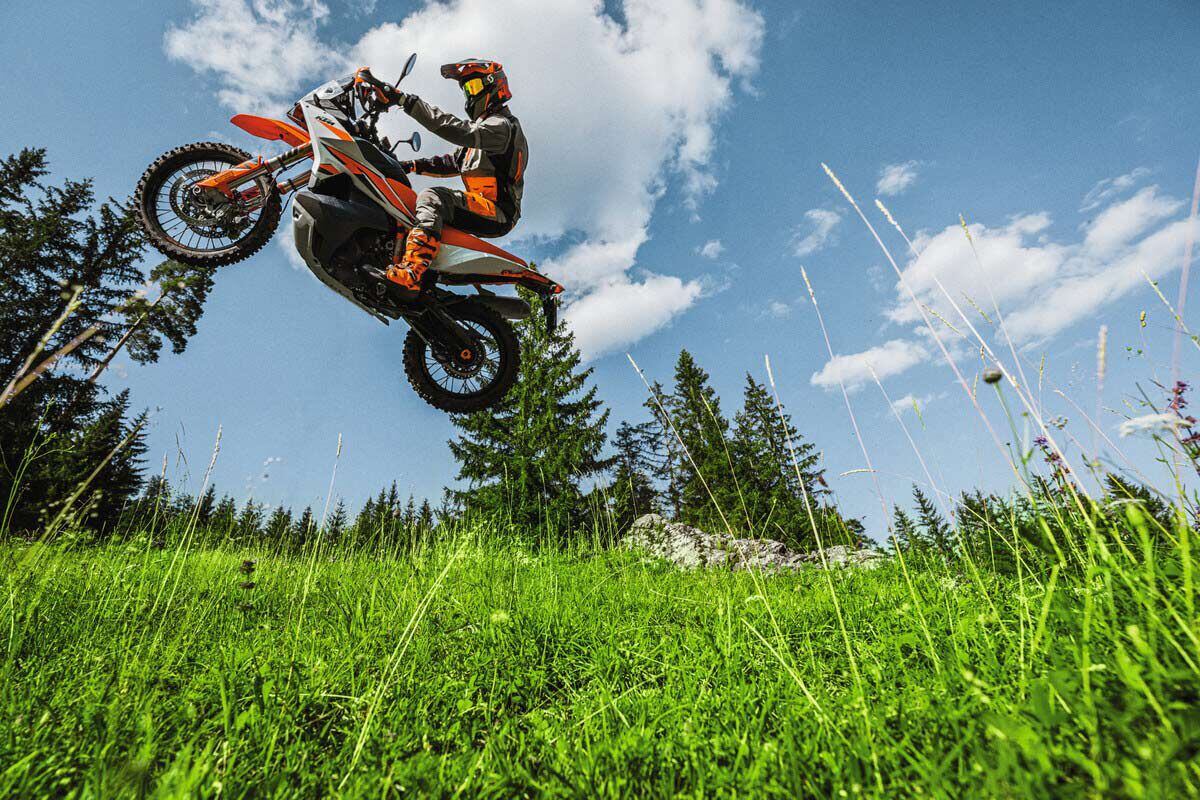
The 2023 KTM 890 Adventure R in the hands of someone with more skill than most of us. The aspirational R model has 10.4 inches of ground clearance, so you know it’s serious. (KTM/)Updates for 2023
For 2023, the 890 Adventure series was further refined with a host of changes. Redesigned rally-inspired bodywork is intended to improve aerodynamics and ergonomics, as well as to provide more support for large navigation units. Both the base model and R receive their own windshields and both have aluminum covers that extend past the skid plate to add greater protection to the engine and tank.
Both the base model and R receive a 9.3 MP ABS unit for improved braking performance. KTM must have heard customer complaints because it finally linked ABS settings to ride modes, saving riders from having to change them manually when switching between modes, as was the case on previous models.
Somewhat controversially, KTM is introducing a demo setting that gives riders full access to all its electronic rider aids (e.g., Rally mode and quickshifter) for the first 1,500 kilometers (932 miles). After that, the demo mode expires and riders must purchase them for permanent use.
Both models receive a 5-inch TFT display with a redesigned graphic interface and a scratch- and glare-resistant surface treatment. An optional Connectivity Unit is available to hook the TFT to the KTMconnect app for turn-by-turn navigation, music, incoming calls, and KTM roadside assistance. A new phone call-out function also allows a favorites call option, with a maximum of 10 numbers, or the option to call one of the 10 last numbers called.
The Adventure R model receives updated suspension: The fully adjustable 43mm WP Xplor fork and linkage-less WP Xplor PDS (Progressive Damping System) rear shock are retuned for improved feedback and damping to help alleviate fatigue during long stretches of riding off-road terrain.
The base model gets a WP Apex 43mm front fork, adjustable for rebound and compression (replacing the previous model’s nonadjustable fork). The Apex shock, adjustable for preload and rebound, has revised settings. There’s also a new two-piece seat for improved comfort.
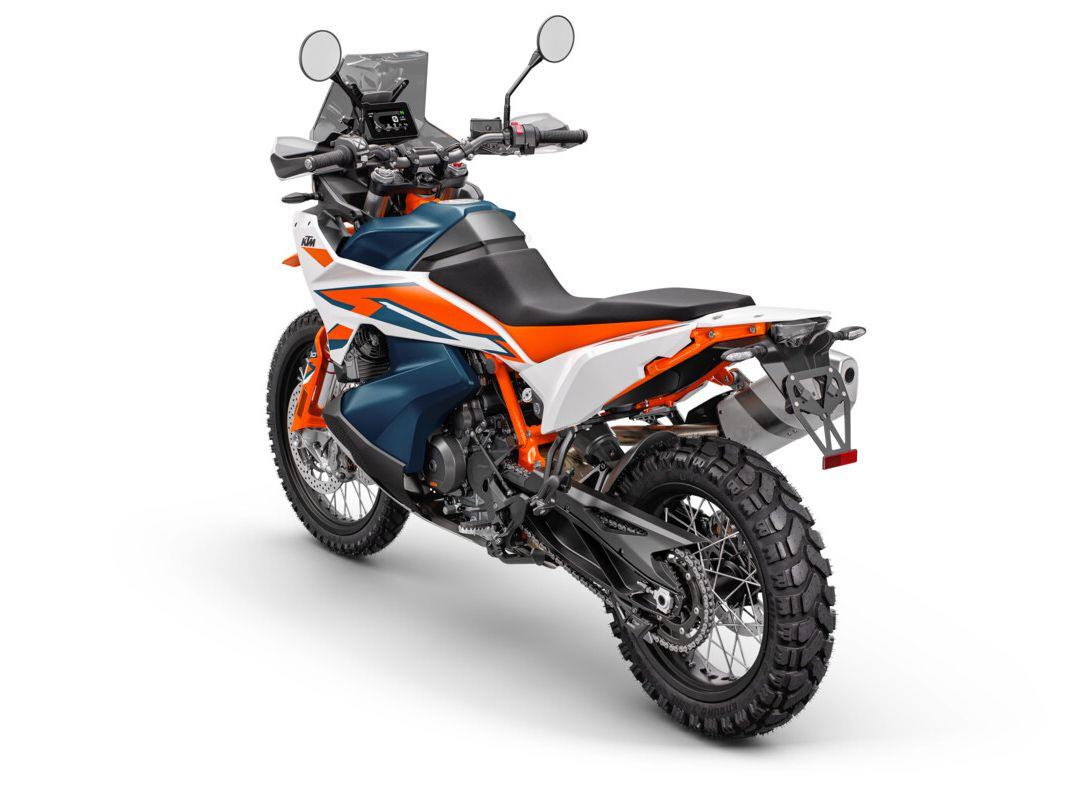
Is it a rally bike or an 890 Adventure R? While the base and R models share the same engine, frame, and electronics, different suspension gives the two their own identities. (KTM/)Pricing and Variants
The 890 Adventure R has an MSRP of $15,199, while the base-model 890 Adventure retails for $13,949.
The Adventure R is the more serious off-roader of the two, with longer-travel, higher-spec suspension, an off-road-style front mud guard, and a shorter windscreen. It’s the natural choice for riders who are serious about riding more technical terrain off-road, but it comes at a cost for street riders. The Adventure R’s tall 34.6-inch seat height is 1.5 inches taller than the base model’s, which may make it a non-starter for some riders. The long-travel suspension is also not as well suited for corner carving on the street. Additionally, the front mud guard can cause some vibration and discomfort at highway speeds.
Ultimately, intended use should be the guide. While the R may be “the one to have,” it’s only better than the base model if you’re getting wild off-road and willing to sacrifice a degree of street comfort and all-around usability.
Competition
The middleweight adventure bike category is full of competent contenders, though many consider the 890 Adventure series the benchmark. The base model competes with the Aprilia Tuareg 660 (starting at $12,299), the Honda Transalp ($9,999), the Suzuki V-Strom 800DE (starting at $11,349), the Yamaha Ténéré 700 ($10,799), the Husqvarna Norden 901 ($14,499), as well as BMW’s new-for-2024 F 900 GS and F 800 GS models.
The 890 Adventure is a claimed 20 hp more powerful and only 30 or so pounds heavier than the Tuareg 660, the smallest-displacement bike here. Compared to the Japanese parallel twins, it’s a bit higher-end, with more advanced rider aids and arguably more off-road bias. The BMWs will be considerably more expensive when spec’d out. The Norden is essentially a reworked 890, so it’s very close on the spec sheet and in the real world, despite being a physically larger machine than the 890.
The 890 Adventure R competes with the Triumph Tiger 900 Rally Pro ($17,395), Ducati DesertX ($17,995), and the Husqvarna Norden 901 Expedition ($15,799). Here, the competition is pretty stiff on the spec sheet, with each bike producing comparable performance figures. They even have comparable levels of suspension travel (around 9 inches). While the Ducati possesses that fetching Italian style, the Triumph exudes British refinement, and the Husqvarna is decked out with accessories, the KTM is both the most affordable and the most approachable thanks to its low CG and tractable parallel twin.
Note: Listed MSRP are the starting price, and costs will vary depending on features.
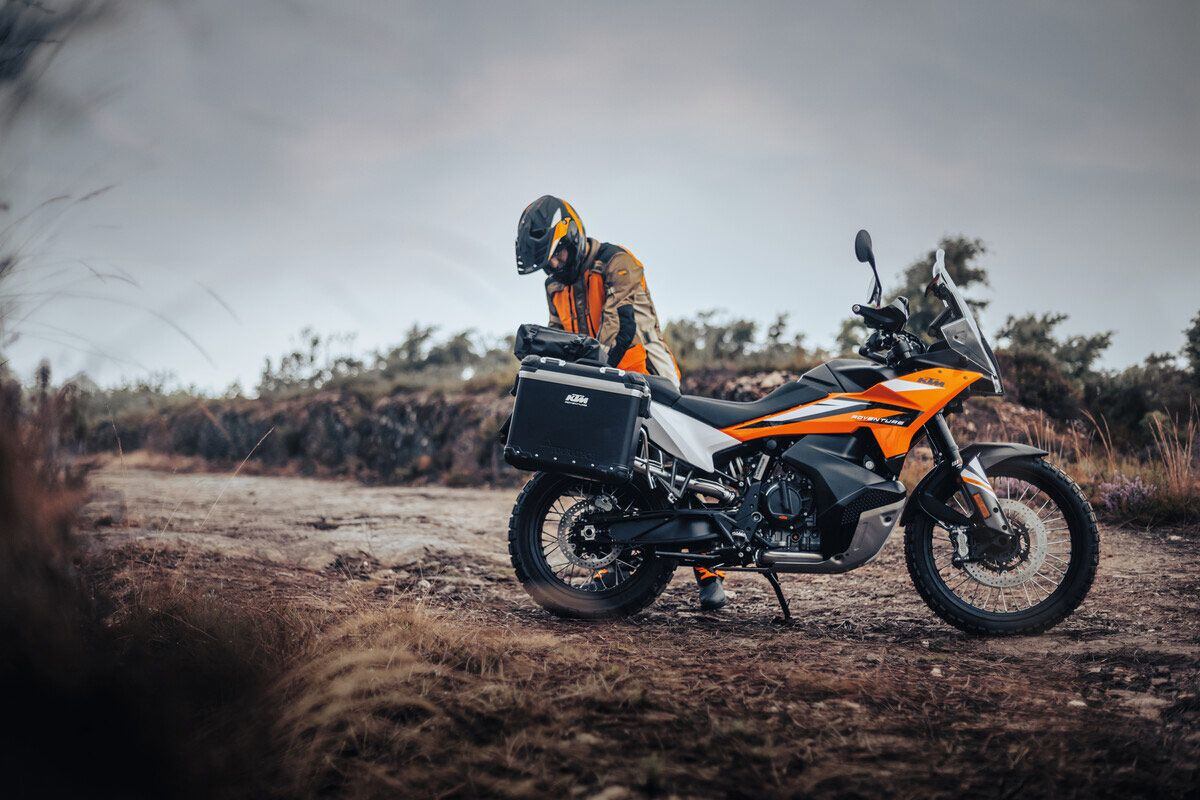
The base-model 890 is still more than capable of hanging tough off-road. For 2023, KTM adds more value to the base model by using adjustable suspension that’s not overly off-road biased. For many riders, that will make it a better all-rounder. It includes a taller windscreen; a lower, adjustable seat; and a conventional front fender. It’s also less expensive. Accessory luggage pictured. (KTM/)Powertrain: Engine, Transmission, and Performance
The 890 Adventure R utilizes KTM’s updated LC8c 889cc DOHC parallel-twin engine that’s also seen in the impressive 890 Duke R. On the Cycle World dyno, the 890 produced 86.5 hp at 8,300 rpm and 58.1 pound-feet of torque at 6,900 rpm. Aside from its increase in displacement over the 790, the 890 powerplant leverages a higher compression ratio, larger intake and exhaust valves, an updated camshaft, and lighter pistons.
A forged single-piece crankshaft with a 435-degree firing order supplies the power delivery and sound character of a KTM V-twin (though the exhaust note is quite muted); vibration is quelled by dual counterbalancers—one in front of the crankshaft and the other in the cylinder head, driven by the exhaust camshaft.
In the real world, the LC8c is a rev-happy twin that begs to be flogged. One of its greatest strengths is its low-down tractability. Nearly stall-proof at low rpm, it can happily chug along just above idle, pulling cleanly from the bottom as you wind on the throttle.
The LC8c’s six-speed transmission shines with the use of the optional up/down quickshifter, firing off lightning fast shifts with a light, pleasantly notchy feel through the shifter.
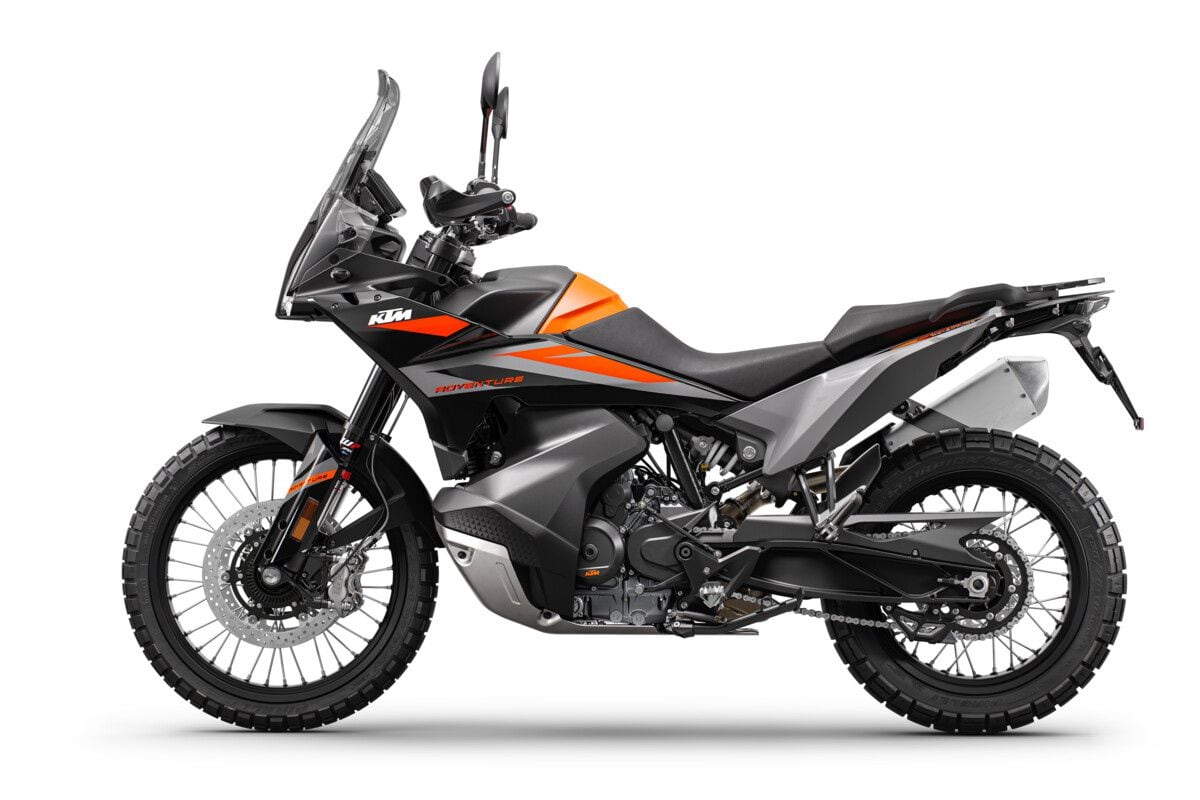
Is the 890’s party piece the engine, the low CG, the suspension, the electronic rider aids, or the reasonable price? New for 2023, rally-inspired bodywork makes it look the part. (KTM/)Chassis/Handling
Using the tightly packaged LC8c engine as a stressed member, the Adventure and Adventure R’s chromoly steel frame hugs the top of the engine to help centralize mass. A steel trellis subframe bolted to the main frame keeps weight low while allowing space for easy airbox access and filter replacement. A long, traction- and stability-enhancing open lattice cast aluminum swingarm can be used thanks to the shortness of the engine.
WP suspension is fitted to both models, but differs in spec according to each bike’s intended use. A 43mm Apex fork is spec’d for the standard 890 Adventure, offering 7.9 inches of travel. Damping is split—one leg handling compression and the other controlling rebound—and for 2023, is adjustable using dials on the top of each fork leg. Matched to the 43mm fork is a WP Apex PDS (Progressive Damping System) shock, adjustable for preload and rebound, connected directly to the swingarm and frame, giving 7.9 inches of wheel travel.
Suspension becomes longer and more dirt-ready on the 890 Adventure R. Travel of 9.4 inches is provided by a WP Xplor fork—the very same design fitted to KTM’s EXC-F dual sports and XC-W off-road two-strokes. The Xplor fork also splits compression and rebound functions between the two legs, and each damping circuit is adjustable using dials at the fork top. An Xplor PDS shock gives the rear wheel 9.4 inches of travel and is fully adjustable for preload, high- and low-speed compression, and rebound damping.
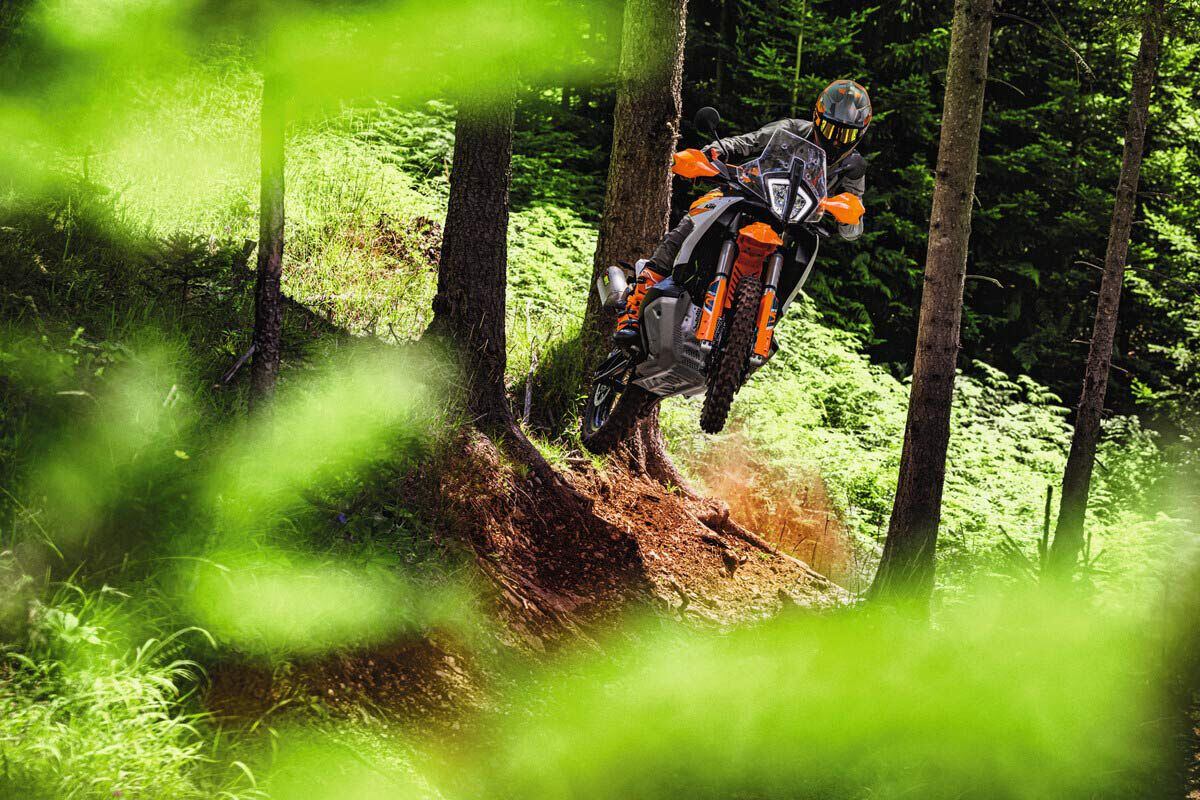
The 890 Adventure R’s up-spec WP suspension brings dirt bike–level performance to the ADV world. The optional Rally mode gives riders 10 levels of traction control, adjustable with the up/down buttons on the left grip. No need to stop or even look down to change levels. How far do you want to hang the rear end out? (KTM/)Brakes
Both 890 Adventure models use radially mounted four-piston calipers and dual 320mm discs in the front, and a twin-piston floating caliper and 260mm disc in the rear. Cornering ABS comes standard.
Fuel Economy and Real-World MPG
The 890 Adventure R managed 43.9 mpg in real-world testing.
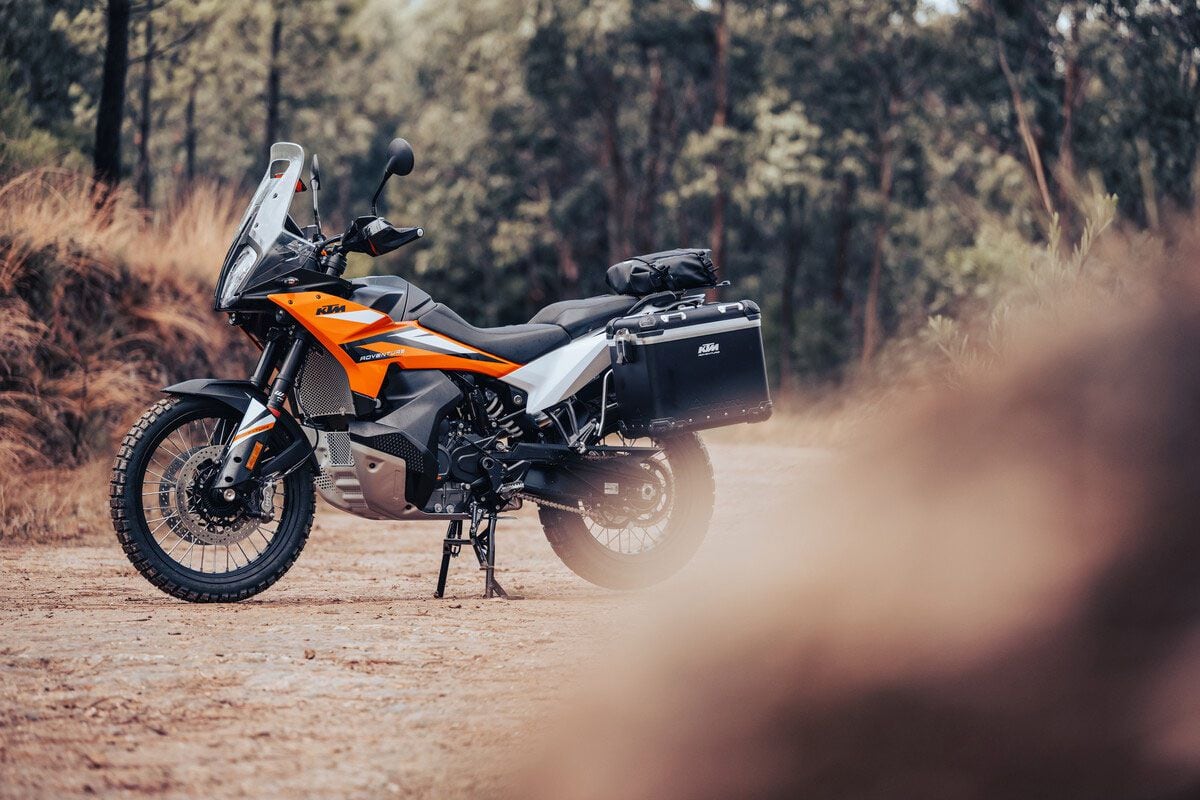
The plastics are color injected and use in-mold decals where possible for resistance, as seen on the KTM off-road bikes. Wider panels on the tank and side panels give the seat protection against unwanted scrapes. (KTM/)Ergonomics: Comfort and Utility
The most noticeable and welcome ergonomic feature is the low-slung tank. Fuel is kept low to centralize mass, and it makes for a narrow seat/tank junction to optimize body positioning for aggressive off-road riding. You can toss the bike around like a big enduro, thanks to the compact chassis and narrow feel. It’s also beneficial on the street, where maneuvering at slow speeds, and even getting it off the sidestand requires less effort than traditional top-heavy adventure-tourers.
KTM knows its customers and has done a great job of making the bike ready for adventure. From being prewired for a GPS mount, to making the airbox easily accessible for routine filter cleaning, there’s little after-purchase fussing to prep the bike for your first adventure. Another benefit of the fuel tank is that it provides protection for the engine and radiator, so many consider crashbars unnecessary.
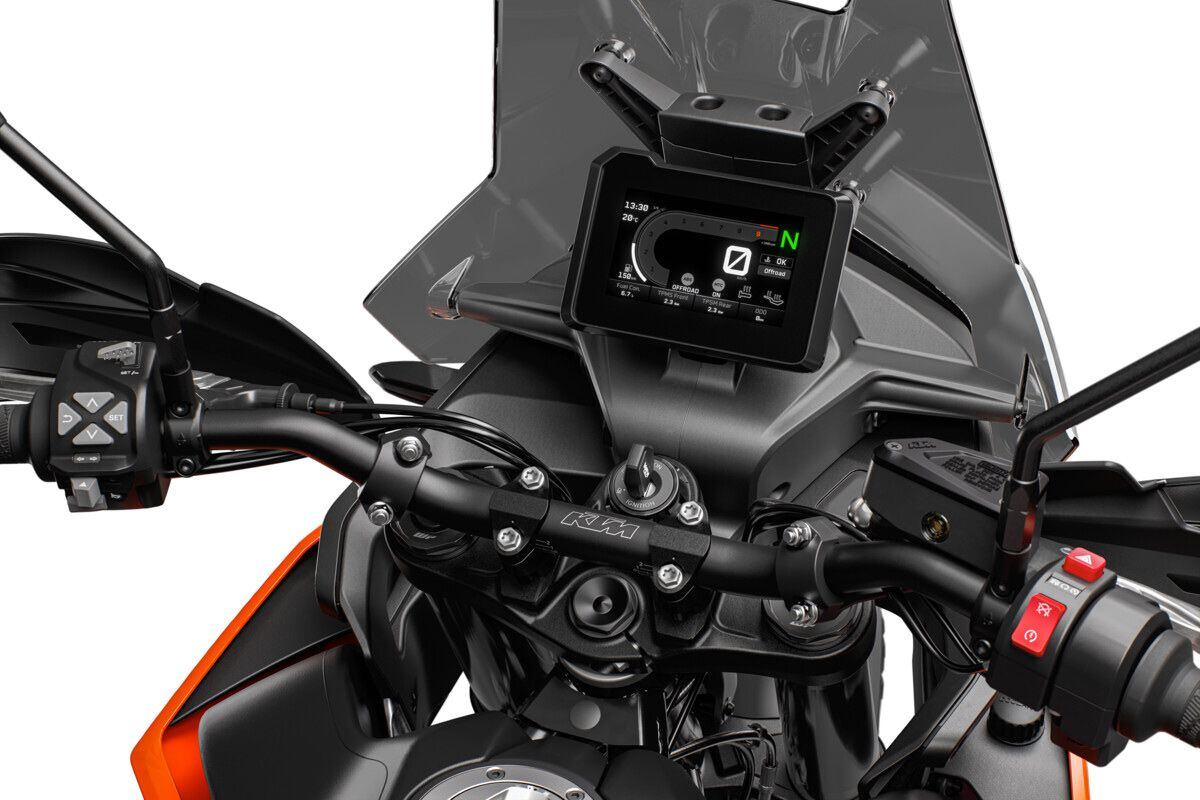
Both models receive a new 5-inch TFT dash. Menus are easy to navigate, though the user experience isn’t as exceptional as some of the other European competition. Still, it gets the job done. Note the new headlight and dash subassembly. (KTM/)Electronics
The 890 Adventure’s ride modes (Street, Offroad, Rain, or the optional Rally mode) tailor power delivery and are tied to KTM’s lean-sensitive Motorcycle Traction Control (MTC) and lean-sensitive ABS. Street and Rain work as you’d expect. Offroad allows the rider to break loose the rear wheel, but still controls slip, metering the throttle for controlled slides; the ABS intervention is reduced in the front and deactivated in the rear. Rally mode allows for 10 levels of rear wheelspin that can be adjusted on the fly, along with a choice of throttle-response settings.
A 5-inch TFT dash and LED lighting are standard. Heated grips, cruise control, and a bidirectional quickshifter are optional extras. Prepare for demo mode to get you hooked—especially to the quickshifter and Rally mode.
Warranty and Maintenance Coverage
KTM offers a 24-month manufacturer’s warranty on the base-model 890 Adventure, but only a 12-month warranty on the R model.
Quality
The 890 Adventure series packs a lot of bang for the buck with highly effective electronic rider aids, a charismatic motor, and a killer chassis. Dirt bike-like plastics with in-mold graphics convey the bike’s toollike utilitarianism. For brushed aluminum finishes and styling flourishes, look elsewhere.
2023 KTM 890 Adventure R Specs
MSRP: $15,199 Engine: DOHC, liquid-cooled, 4-stroke parallel twin; 4 valves/cyl. Displacement: 889cc Bore x Stroke: 90.7 x 68.8mm Transmission/Drive: 6-speed/chain Fuel System: DKK Dell’Orto w/ 46mm throttle bodies Clutch: PASC (Power Assisted Slipper Clutch); cable operated Engine Management/Ignition: Bosch EMS; ride-by-wire Frame: Chromoly tubular steel, engine as stressed member Front Suspension: 48mm WP Xplor inverted fork, fully adjustable; 9.4 in. travel Rear Suspension: WP Xplor fully adjustable monoshock w/ PDS; 9.4 in. travel Front Brake: Radially mounted 4-piston calipers, dual 320mm discs w/ ABS Rear Brake: 2-piston floating caliper, 260mm disc Wheels, Front/Rear: 21 x 2.50 in. / 18 x 4.50 in. Tires, Front/Rear: Continental TKC80; 90/90-21 / 150/70-18 Rake/Trail: 26.3°/NA Wheelbase: 60.2 ± 0.6 in. Ground Clearance: 10.4 in. Seat Height: 34.6 in. Tank Capacity: 5.3 gal. Claimed Dry Weight: 432 lb. Contact: ktm.com 2023 KTM 890 Adventure Specs
MSRP: $13,949 Engine: DOHC, liquid-cooled, 4-stroke parallel twin; 4 valves/cyl. Displacement: 889cc Bore x Stroke: 90.7 x 68.8mm Transmission/Drive: 6-speed/chain Fuel System: DKK Dell’Orto w/ 46mm throttle bodies Clutch: PASC (Power Assisted Slipper Clutch); cable operated Engine Management/Ignition: Bosch EMS; ride-by-wire Frame: Chromoly tubular steel, engine as stressed member Front Suspension: 43mm WP Apex inverted fork, compression and rebound adjustable; 7.9 in. travel Rear Suspension: WP Apex monoshock, preload and rebound adjustable; 7.9 in. travel Front Brake: Radially mounted 4-piston calipers, dual 320mm discs w/ ABS Rear Brake: 2-piston floating caliper, 260mm disc Wheels, Front/Rear: 21 x 2.50 in. / 18 x 4.50 in. Tires, Front/Rear: Pirelli Scorpion STR; 90/90-21 / 150/70-18 Rake/Trail: 25.9°/4.2 in. Wheelbase: 59.4 ± 0.6 in. Ground Clearance: 9.2 in. Seat Height: 33.0 in./33.8 in. Tank Capacity: 5.3 gal. Claimed Weight w/o Fuel: 441 lb. Contact: ktm.com -
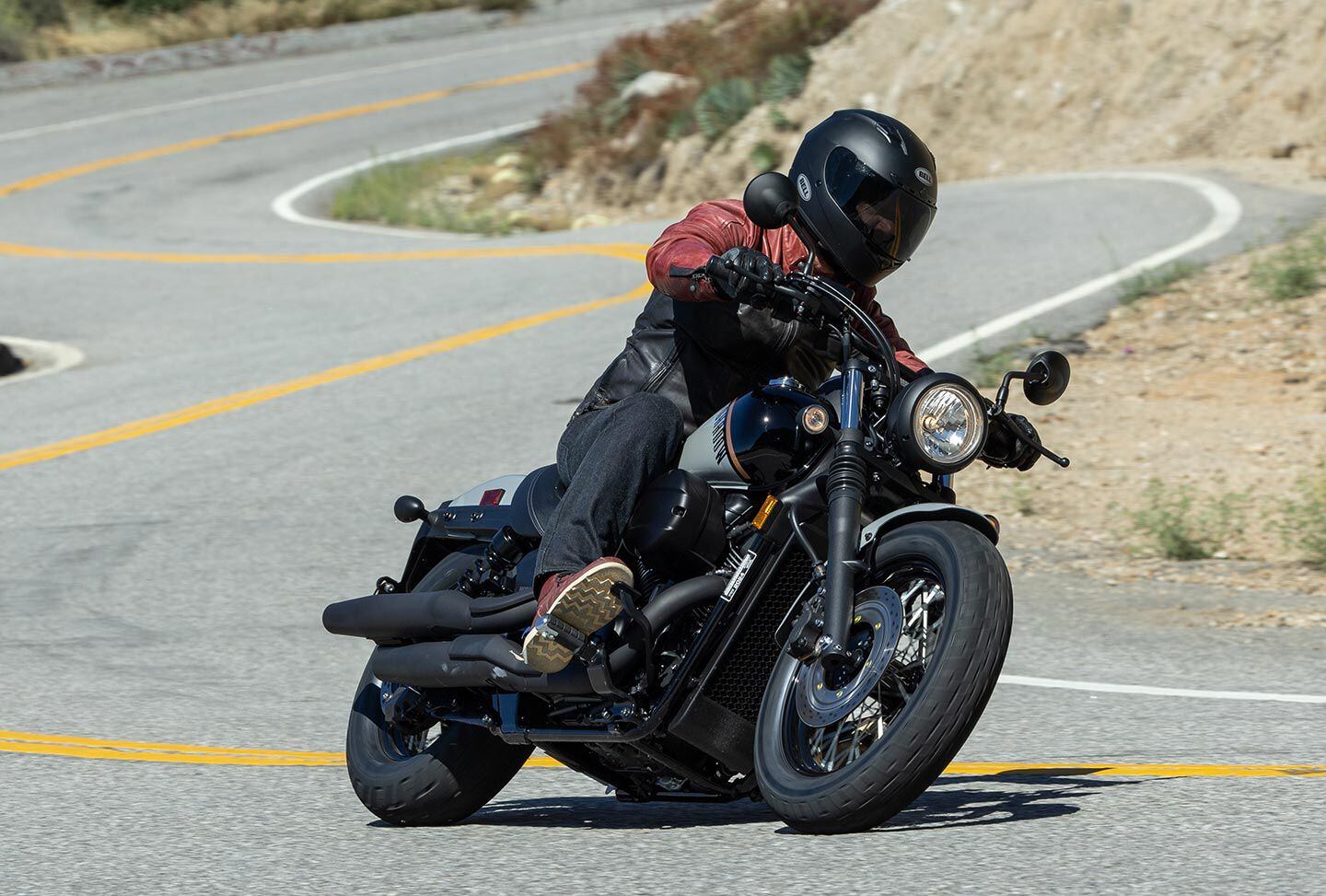
Honda has revised its Shadow Phantom for 2024 with key updates to the chassis and styling. (Kevin Wing/)The metric cruiser (or Japanese-made cruiser) has survived the test of time, providing exceptional value and excellent quality for decades. Like its Eastern rivals, Honda has been trying to cash in on the popularity of American-style cruisers for a long time, in particular with its Shadow motorcycles. All the way back in 1983, Honda released the 45-degree V-twin-powered Shadow 750, followed by the Shadow ACE 750 in 1998, then the Shadow Phantom with its then-new 52-degree V-twin in 2010. Honda’s current cruiser lineup consists of seven models including the revised Shadow Phantom, which received some key updates for 2024 to keep it in the scrum for years to come.
Cruising is as much about styling as it is performance, and the Japanese companies haven’t always done a great job of hitting that nail on the head, often so close, but just lacking the nuances that make bikes from Harley-Davidson the ones that all others are judged against. However, there are other areas that Honda has executed very well.
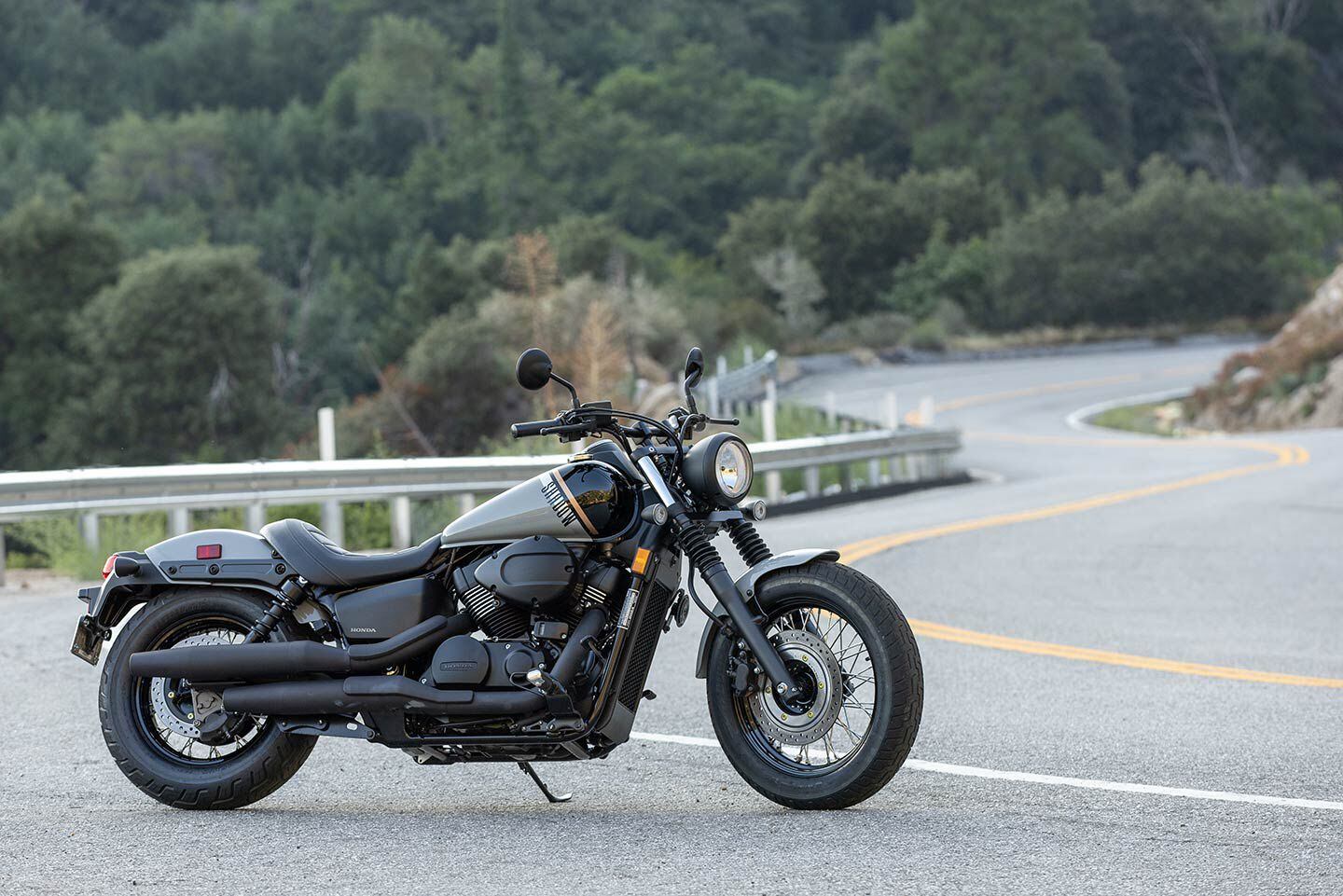
2024 Honda Shadow Phantom in Deep Pearl Gray. (Kevin Wing/)Honda’s updated Shadow Phantom capitalizes on the growth of the midsize cruiser market, which really got some legs during the pandemic as people took advantage of downtime to jump back into motorcycling or purchase bikes for the first time. But where Honda has carved out a niche for itself is by offering excellent bang for the buck. Updates to the $8,399 Shadow Phantom include fresh styling, a revised riding position, the availability of ABS ($399 option), and a new disc rear brake replacing the drum unit of the previous model. And the classic bobber styling is, in our opinion, right on the mark.
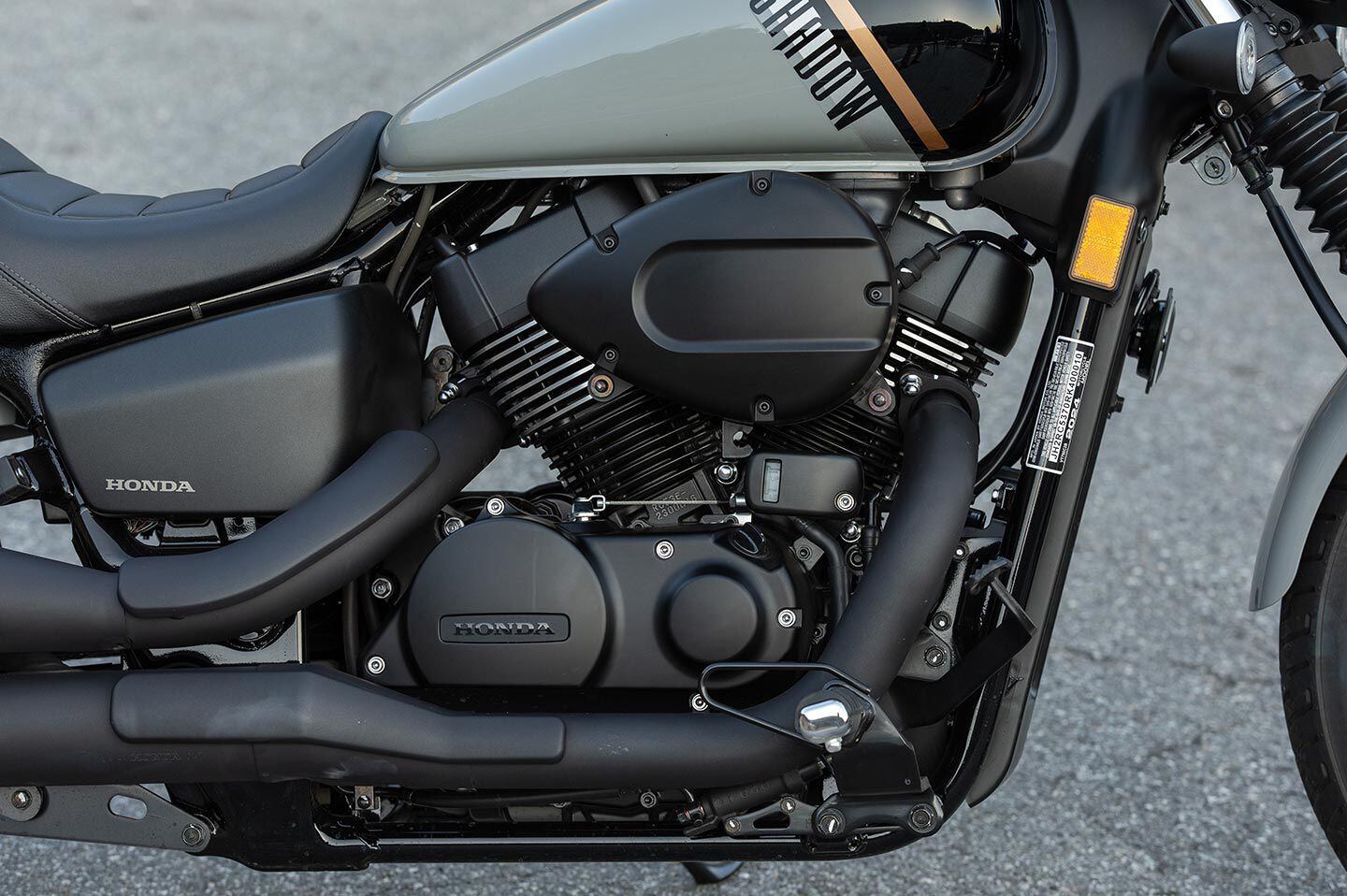
The Phantom’s 745cc V-twin remains unchanged for 2024. (Kevin Wing/)Power comes from a liquid-cooled 745cc 52-degree V-twin with 79.0 x 76mm bore and stroke dimensions. The valve train features three valves (two intake, one exhaust) per cylinder with a single overhead cam in each. Air-fuel mixture is fed via a 34mm throttle body controlled by the Programmed Fuel Injection (PGM-FI) system. Power is sent to the rear wheel via a five-speed transmission and then to a low-maintenance shaft final drive.
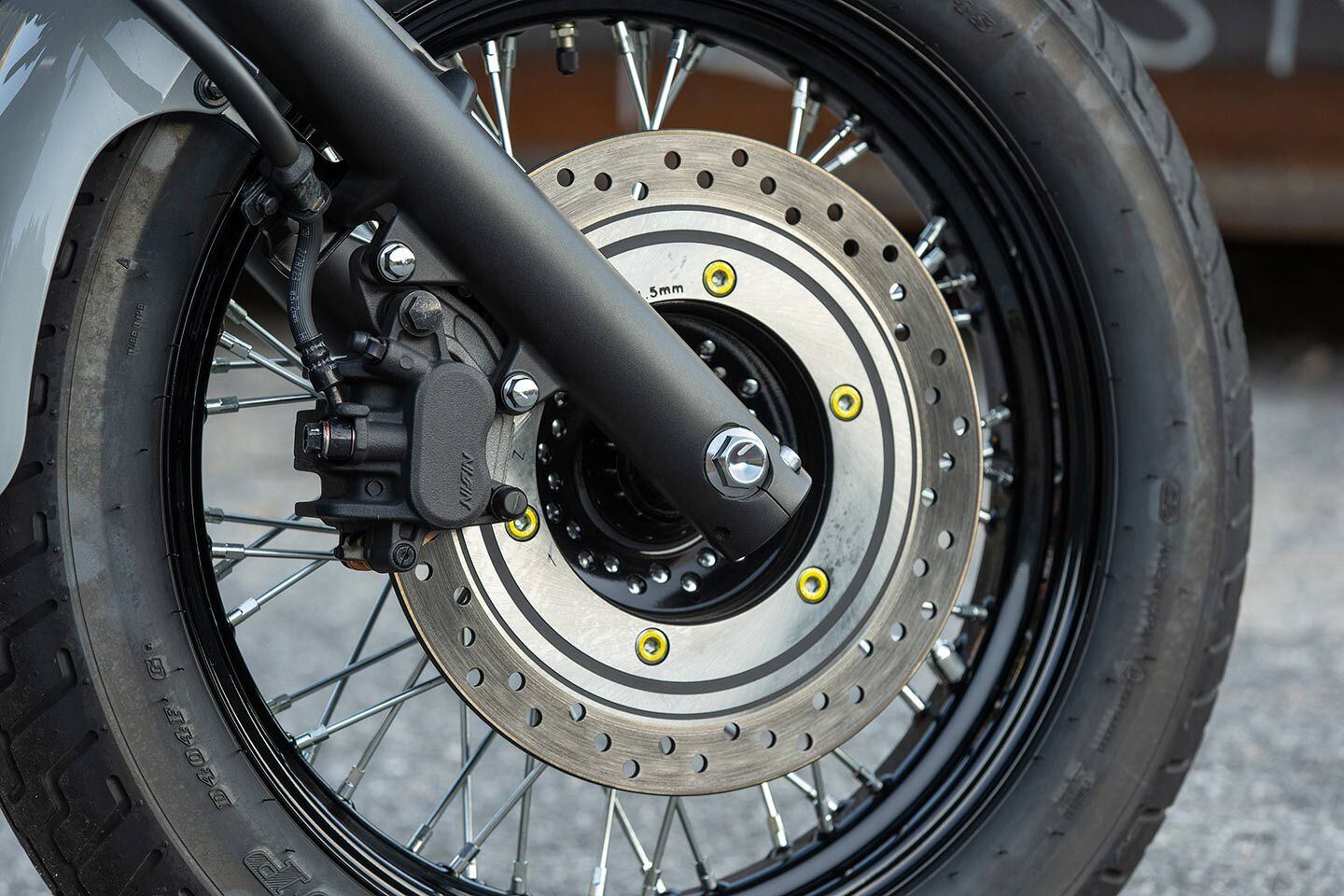
The standard fork provides 5.1 inches of travel, while a single 296mm disc is pinched by a twin-piston caliper. (Kevin Wing/)Chassis highlights include a 41mm standard fork with 5.1 inches of travel and a pair of preload-adjustable shocks that provide 3.5 inches of rear-wheel travel. Braking is handled by a single 296mm front disc with a single twin-piston caliper, while the new rear disc measures 276mm and has a single-piston caliper. Up front is a 17-inch spoked rim mounted with a 120/90-17 tire, while at the rear is a 15-incher and 160/80-15 tire.
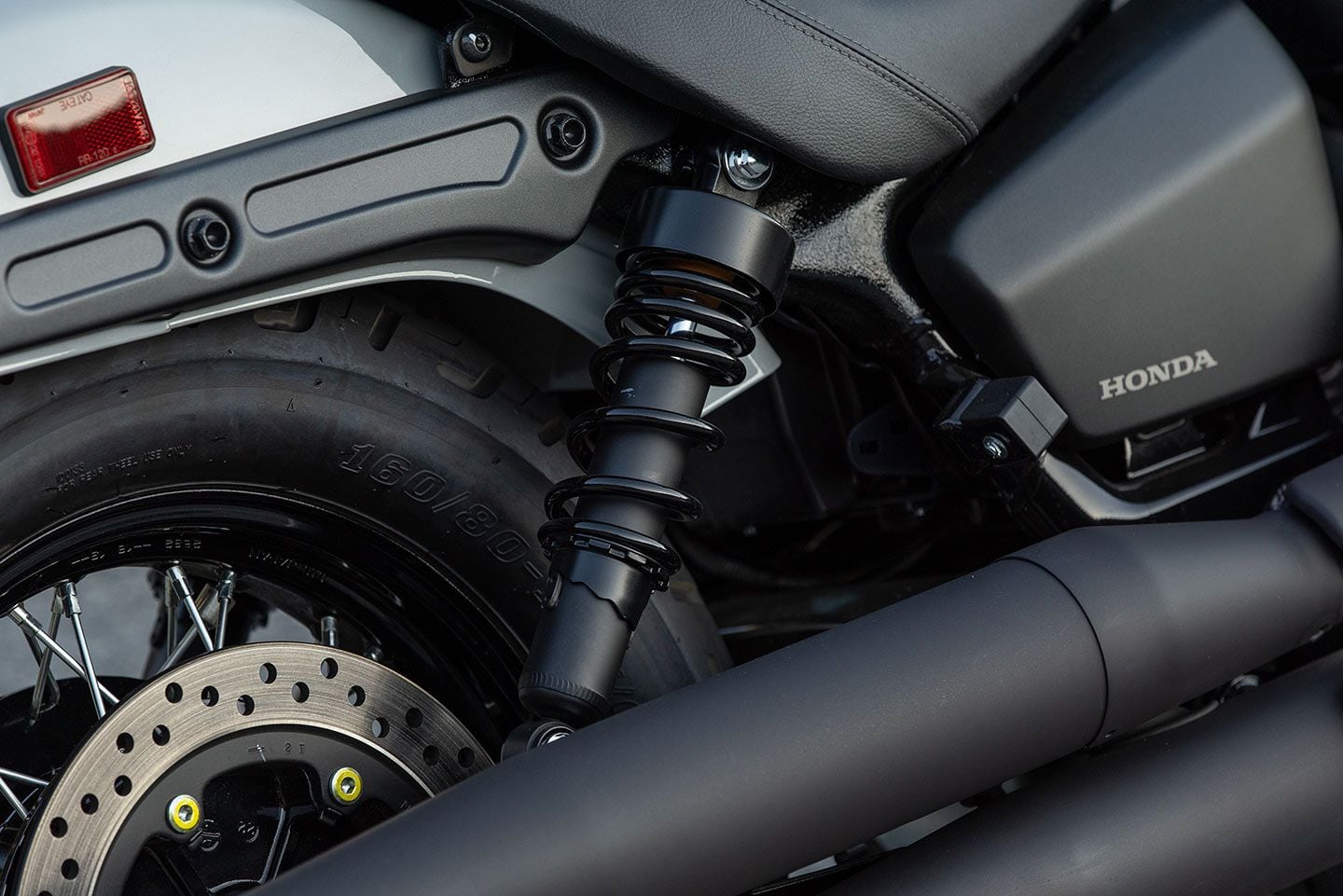
A pair of preload-adjustable shocks provide 3.5 inches of rear-wheel travel. (Kevin Wing/)The Shadow Phantom’s wheelbase measures 64.6 inches with front-end geometry measuring 34 degrees of rake and 6.3 inches of trail. But perhaps the most important dimension is the ultralow 25.6-inch seat height. The rider triangle has been altered with the handlebar now moved forward 3.4 inches with the width increased by just under three-quarters of an inch, while the seat and footpeg relationship remains the same.
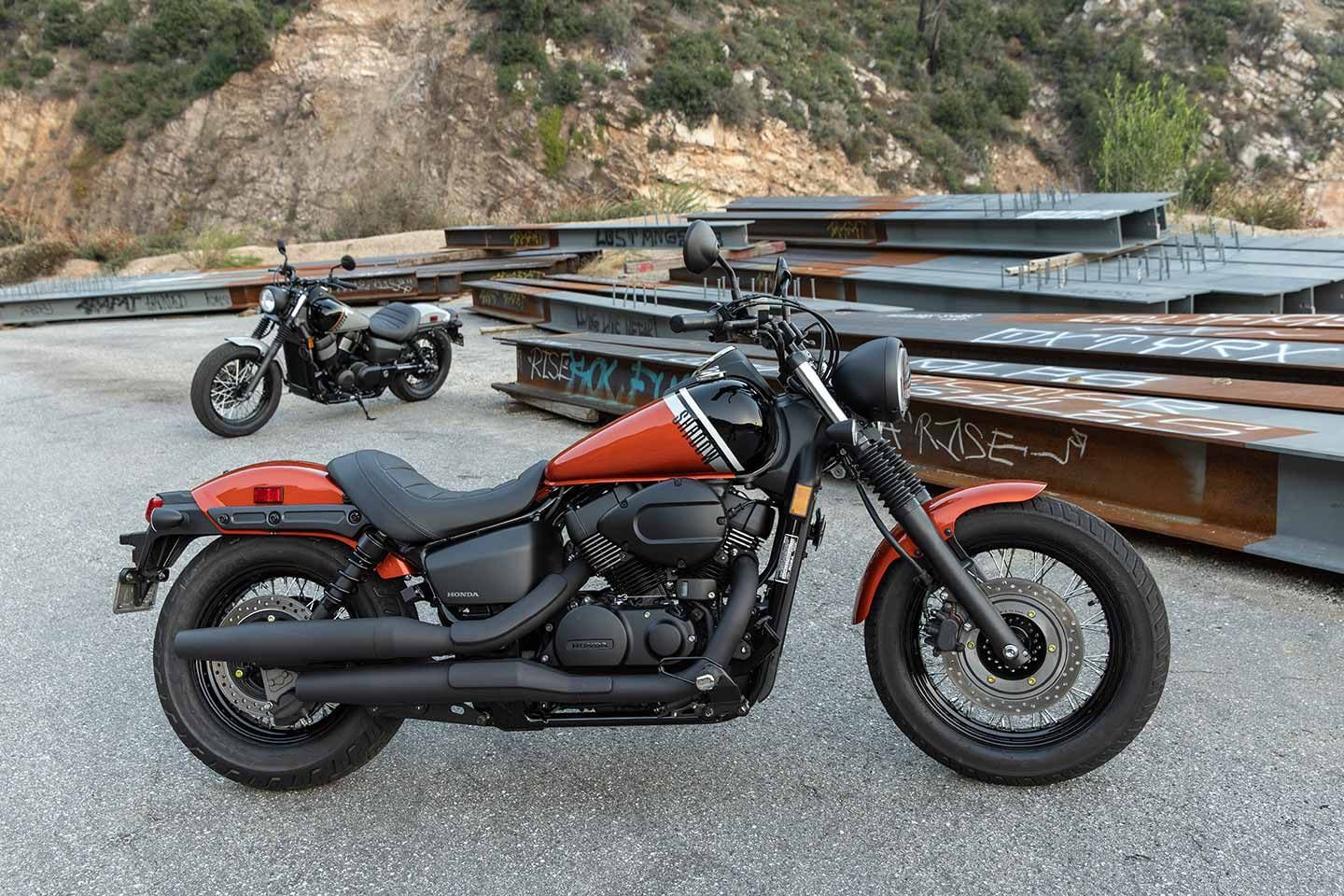
The 2024 Honda Shadow Phantom is available in Metallic Orange or Deep Pearl Gray. (Kevin Wing/)Areas that have been refreshed in terms of styling include a new front fender, rear fender and seat rail, new seat shape, LED turn signals all around, a new air-cleaner cover, headlight nacelle, rubber boots on the fork legs, machine-cut cylinder-head fins, and most obvious is the two-tone fuel-tank paint. Two colors are available: Deep Pearl Gray or Metallic Orange.
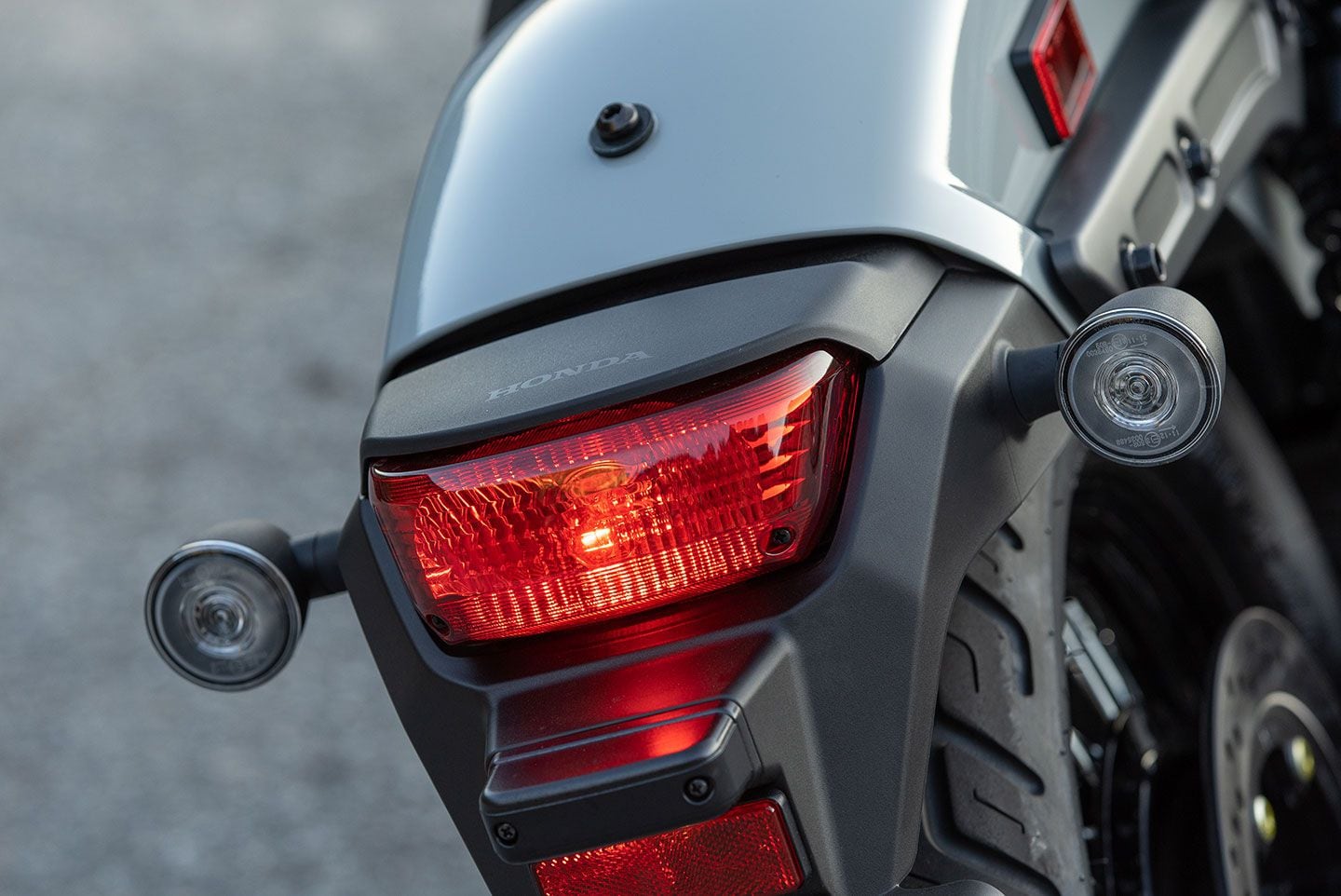
The Shadow Phantom gets LED turn signals at each corner. (Kevin Wing/)A quick walk around the Phantom in a parking lot reveals a bike with excellent fit and high-quality finishes from the tank and fender paint to the blacked-out (grayed out?) covers and brackets. One of the most appealing features of the bike for potential buyers has to be that ultralow seat, which makes getting on and off the bike and managing its light-by-cruiser-standards 543-pound fueled weight really easy. Reach up to the bars and you are greeted by modern switches and controls. On top of the fuel tank is the bike’s lone gauge with an analog speedometer and inset LED screen for basic info like the tripmeter, clock, and so on.
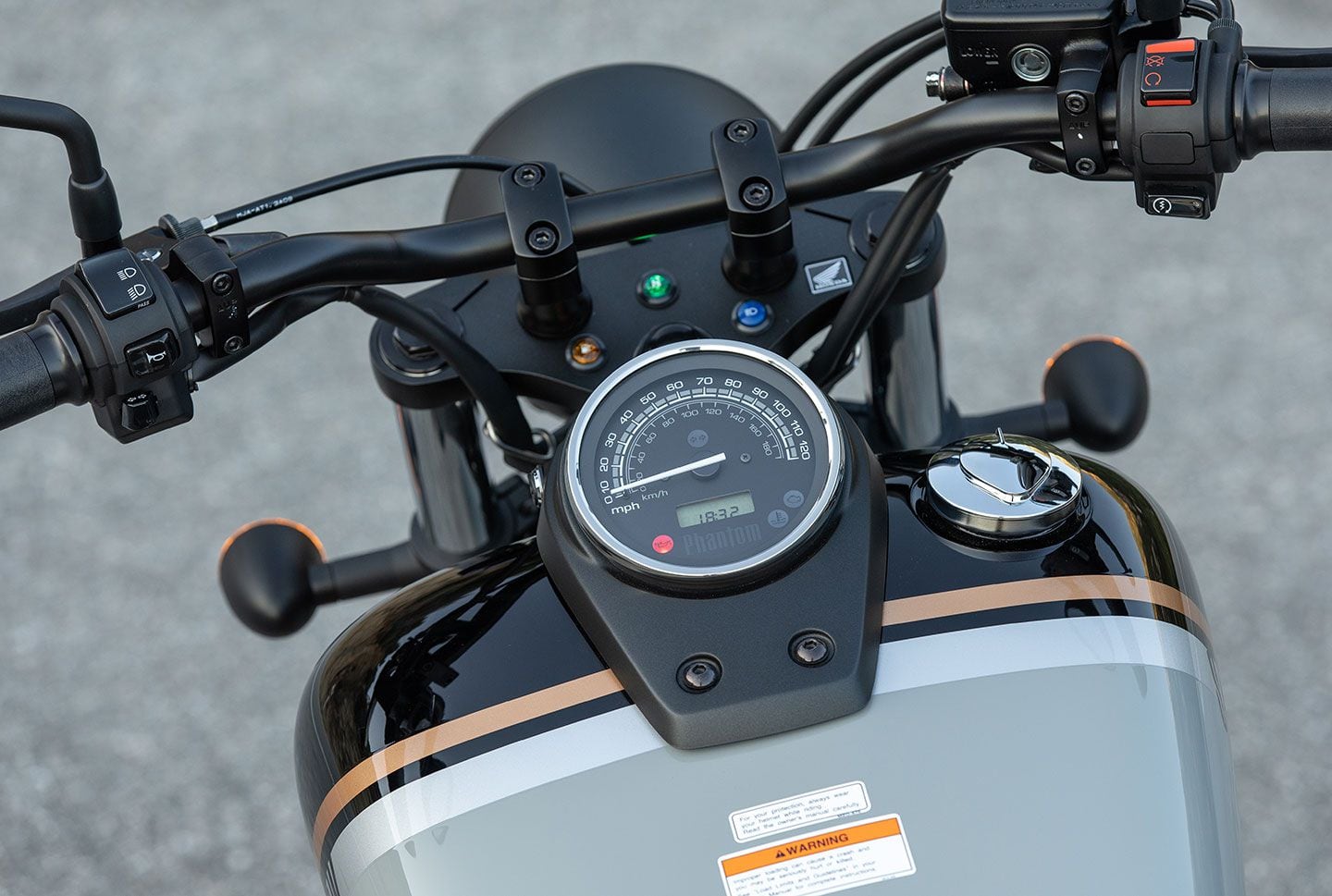
A simple and classic single gauge provides all the basic info. (Kevin Wing/)Fire up the engine and it settles into a pleasant V-twin rumble. Snicking the transmission into gear and pulling away from a stop is helped by light action from the cable-actuated clutch, while shifting through the gears is smooth and positive without any clunkiness. Around town in urban environments, the Phantom is light steering with excellent and balanced low-speed handling. The seating position pulls this 5-foot, 11-inch rider’s upper body just forward with an easy reach to the bars and a relaxed bend of the legs to the forward-mounted foot controls. The seat is firm enough to provide good support for the lower back, but comfortable enough for longer stints. The low seat height should provide solid footing at stops for all but the most height-challenged riders.

The Shadow Phantom’s riding position has been altered to pull the rider forward with a new bar position. (Kevin Wing/)Heading out into the mountains above Azusa, California, the Phantom provides predictable and stable handling and flicks into corners with light and neutral steering. Pick up the pace through tighter hairpin bends and the forward foot controls’ peg feelers will drag (as will the heel of your boots). The suspension is plush and offers a cushy ride, eating up bad asphalt with no issues, but will tend to bounce a bit after hitting G-outs in the road with less than ideal rebound damping. The only adjustment to suspension is preload for the twin shocks, so fine-tuning the ride is aimed more at firming up the rear if you add a passenger with the optional fender-mounted seat and passenger pegs.
Performance from the 745cc V-twin is good, with decent low-end to midrange torque on tap. Around town and exiting tight corners, the engine provides good drive, but the power definitely falls off in the upper rpm range. Making a quick pass of another vehicle usually requires a downshift if you’re hanging out in the upper two gears. But overall, the engine is smooth, with excellent fueling and a good spread of power for a middleweight cruiser.
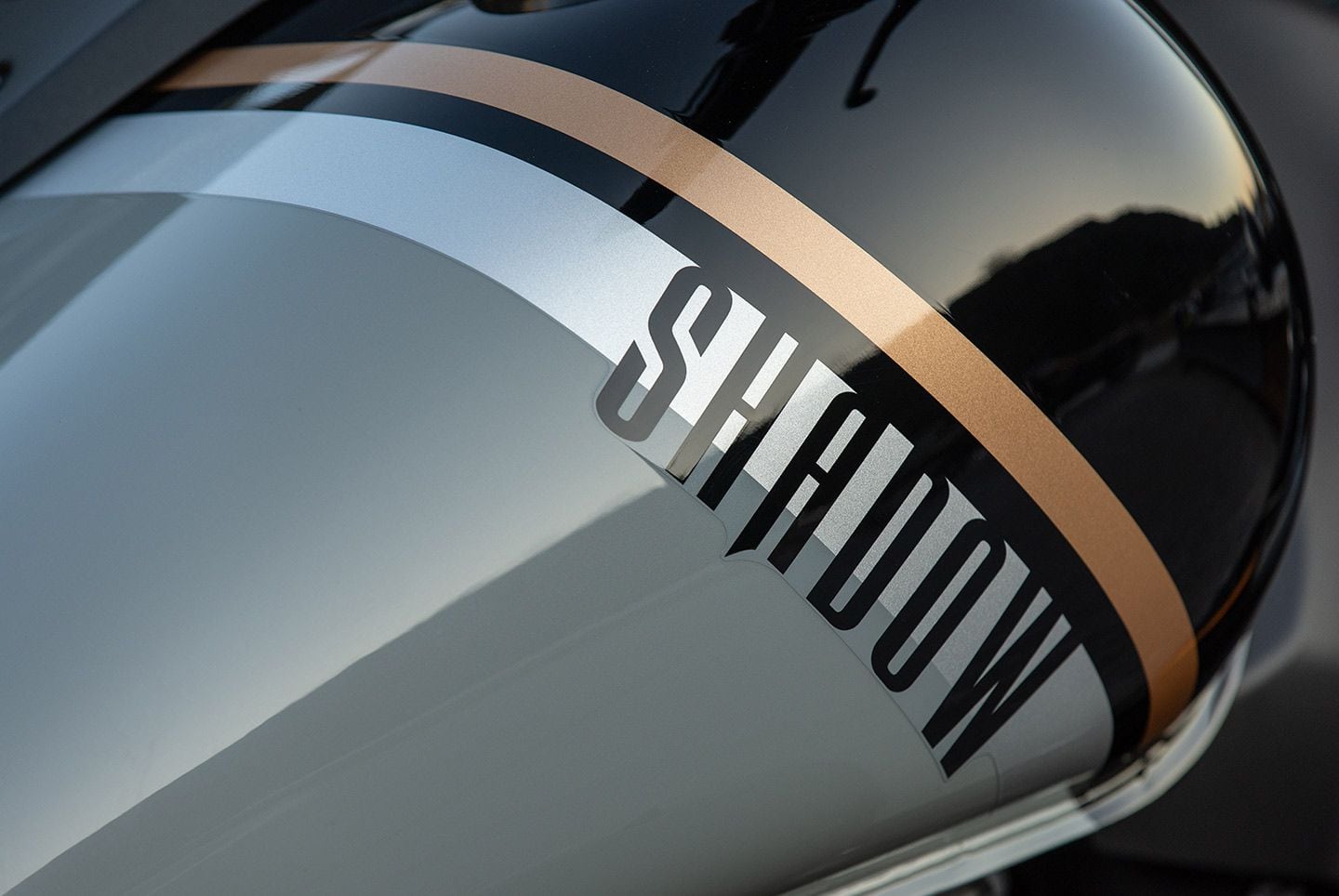
Paint and finishes appear to be top quality. (Kevin Wing/)At a normal riding pace the front brake provides decent power, but if you need to get slowed down in a hurry for an upcoming hairpin, you have to grab a big handful at the front lever. The brake never provides a super-crisp bite but is progressive and predictable. Thankfully Honda has added that big rear disc which can supplement the front and help get the bike stopped without issue. The bike we rode for the day didn’t have ABS, but we can’t imagine why you’d want to forego that option considering it only adds $399 to the price.
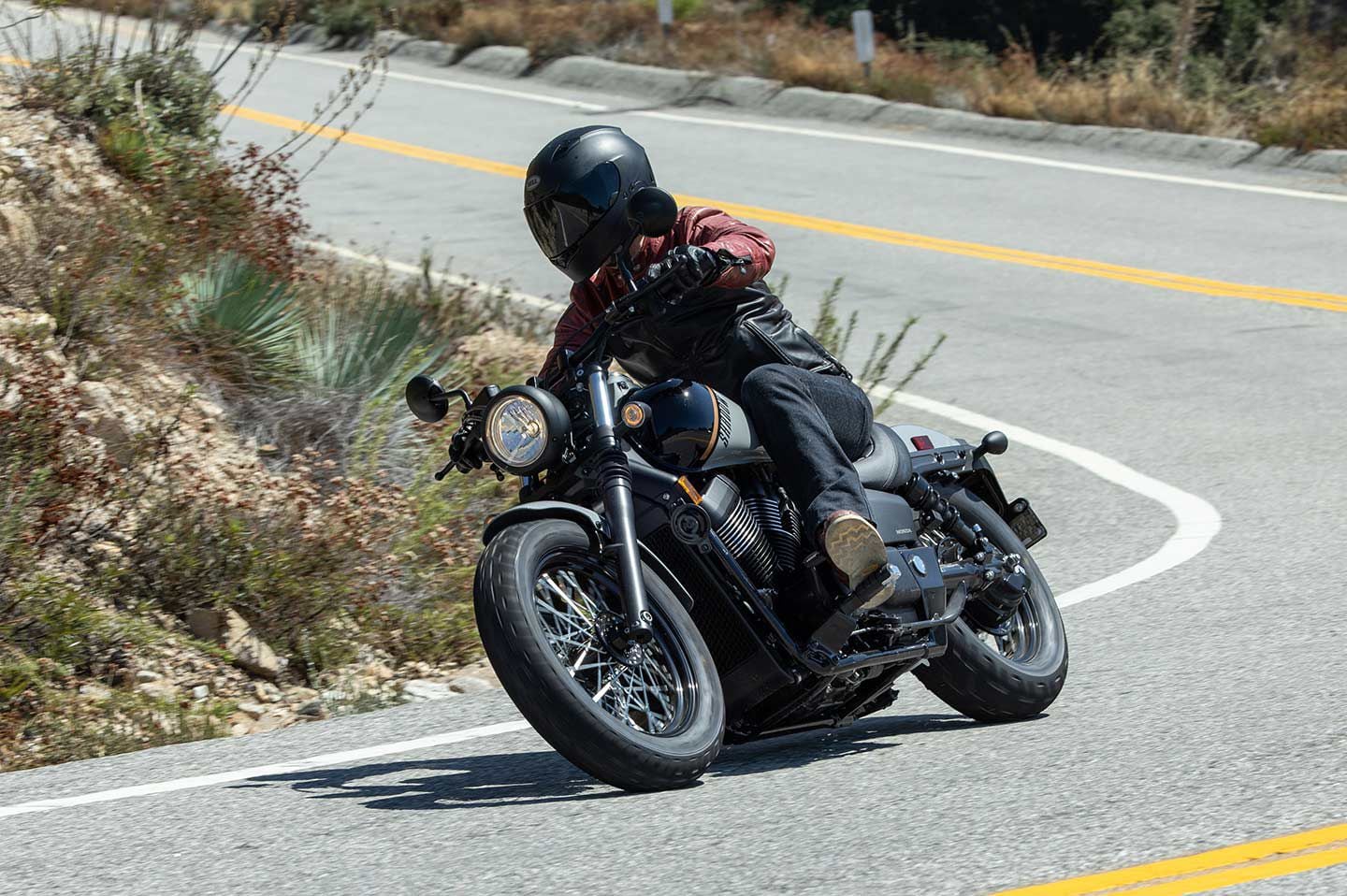
Honda’s Shadow Phantom provides a plush ride, and good handling, from its lightweight package. (Kevin Wing/)The bottom line here is that there are very few options out there for buyers looking for a midsize cruiser, especially one that looks this good in person. Perhaps the most popular bike of all time in this category, the Harley-Davidson 883 Sportster was dropped after the 2022 model year (having been in production since 1957), leaving some big shoes to fill. Currently there are just a handful of bikes remaining to give the Honda Shadow Phantom any serious competition, like the $10,359 Suzuki Boulevard C50T and $8,999 Kawasaki Vulcan 900 Classic.
Clearly recognizing the opportunity, Honda has thrown some smart updates at this bike and delivers a great-looking motorcycle that isn’t intimidating for newer riders with its low curb weight, nice low-speed handling, and mellow power delivery. On the flip side, it delivers enough engine performance for seasoned riders looking for a really nice bike at a very reasonable price and offers all the hallmarks of a Honda, like excellent fit and finish, quality components, and a large dealer network. The Shadow Phantom is available in dealers now.
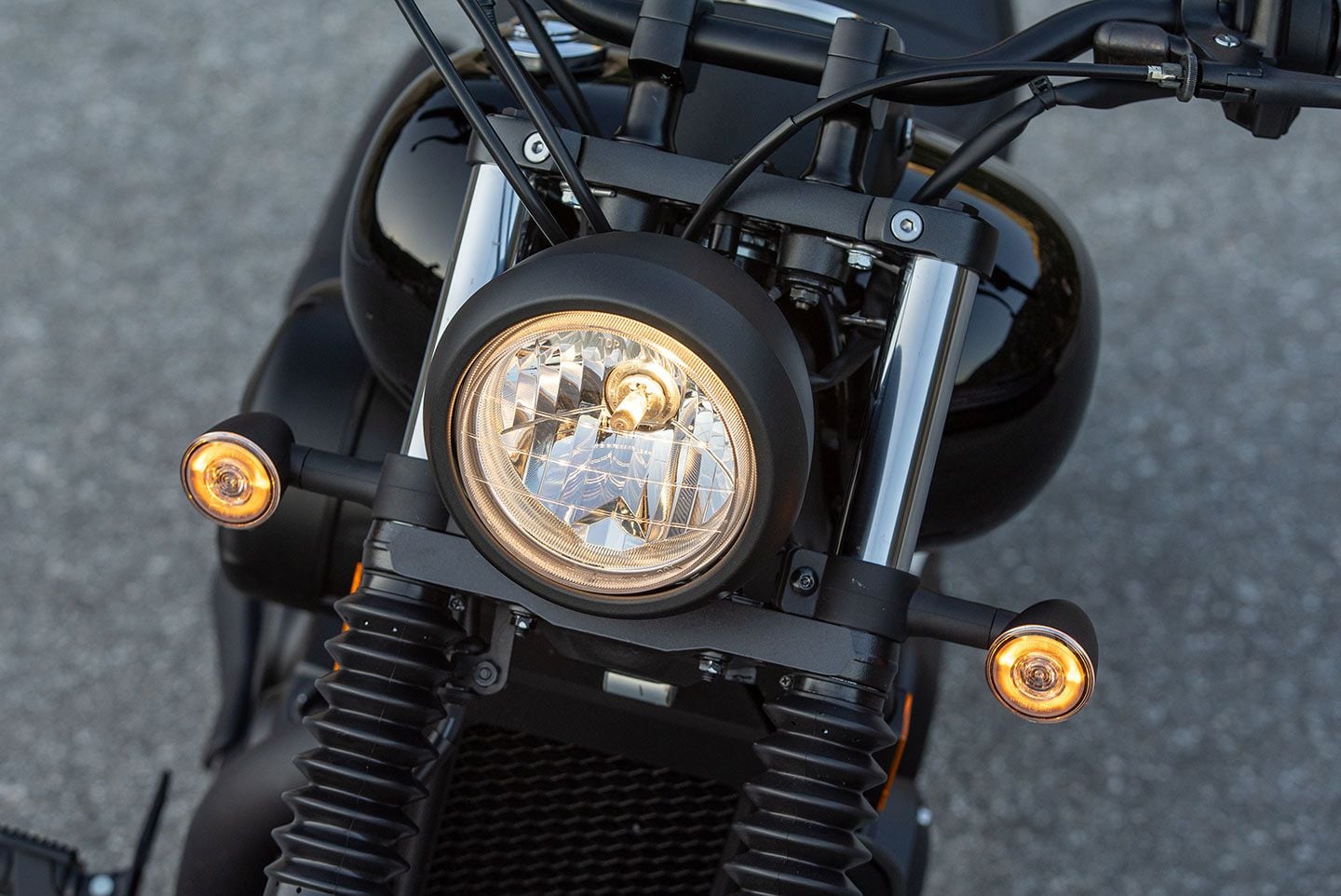
The blacked-out headlight bezel is bookended by new LED turn signals. (Kevin Wing/)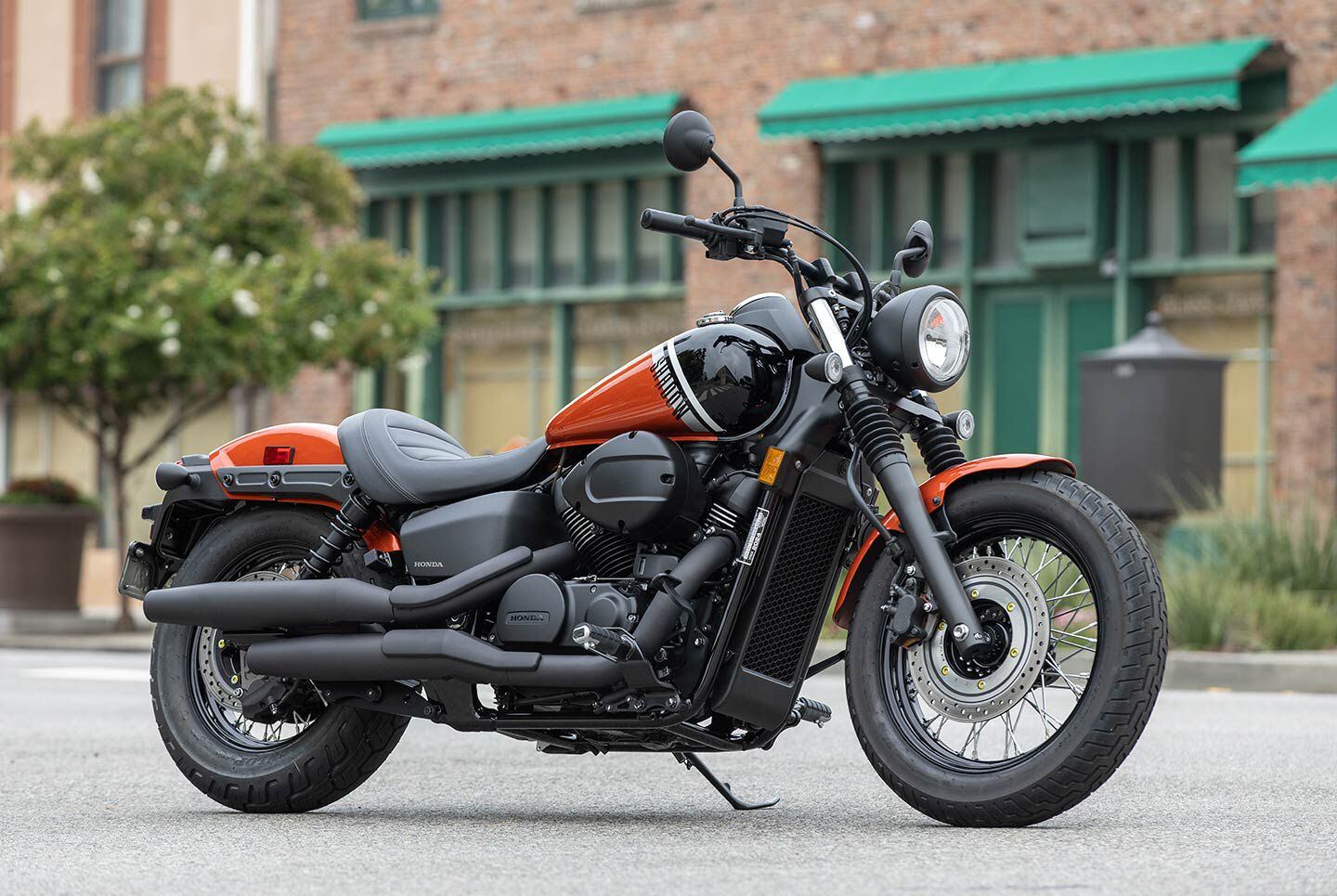
The 2024 Honda Shadow Phantom in Orange Metallic. (Kevin Wing/)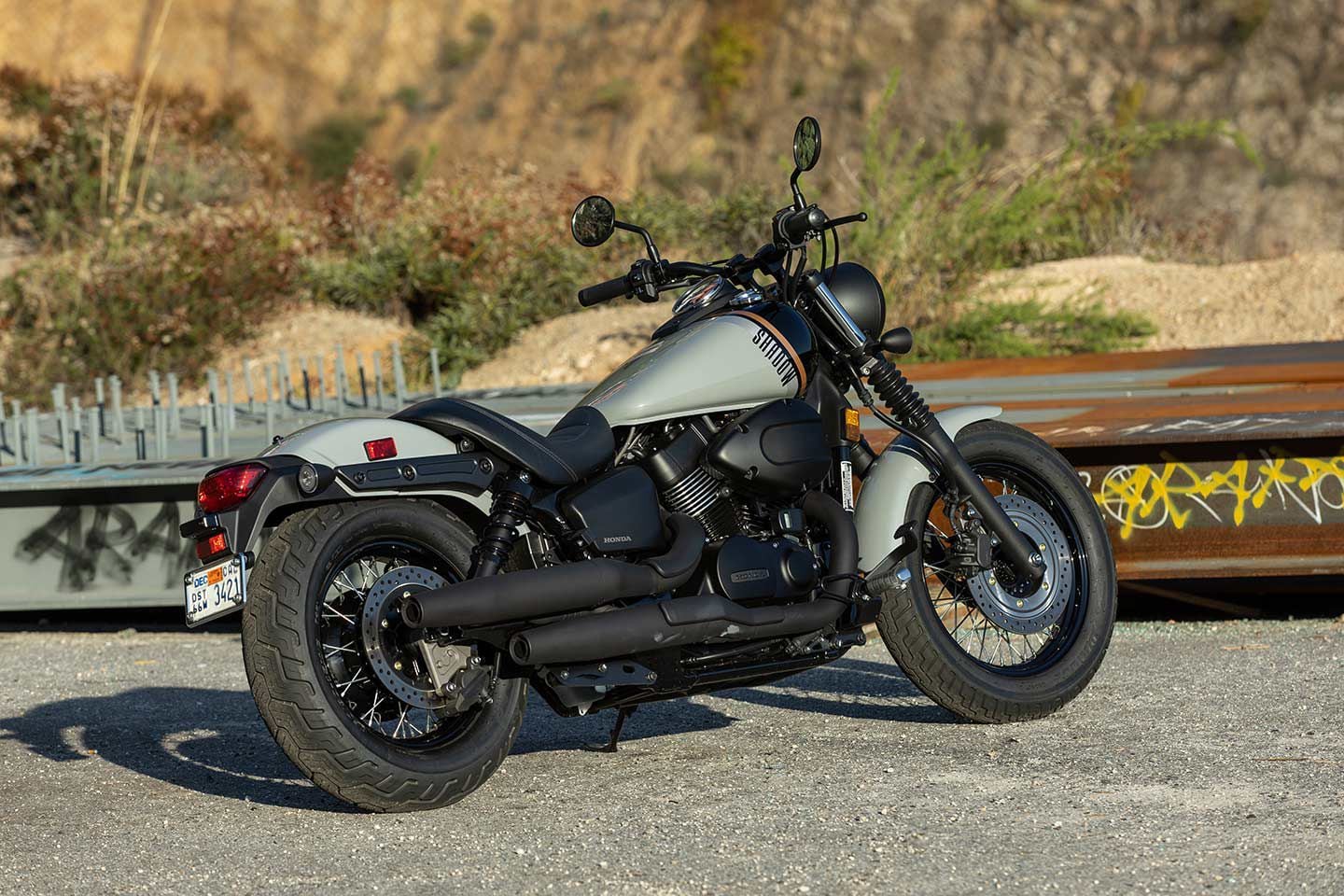
The 2024 Honda Shadow Phantom in Deep Pearl Gray. (Kevin Wing/)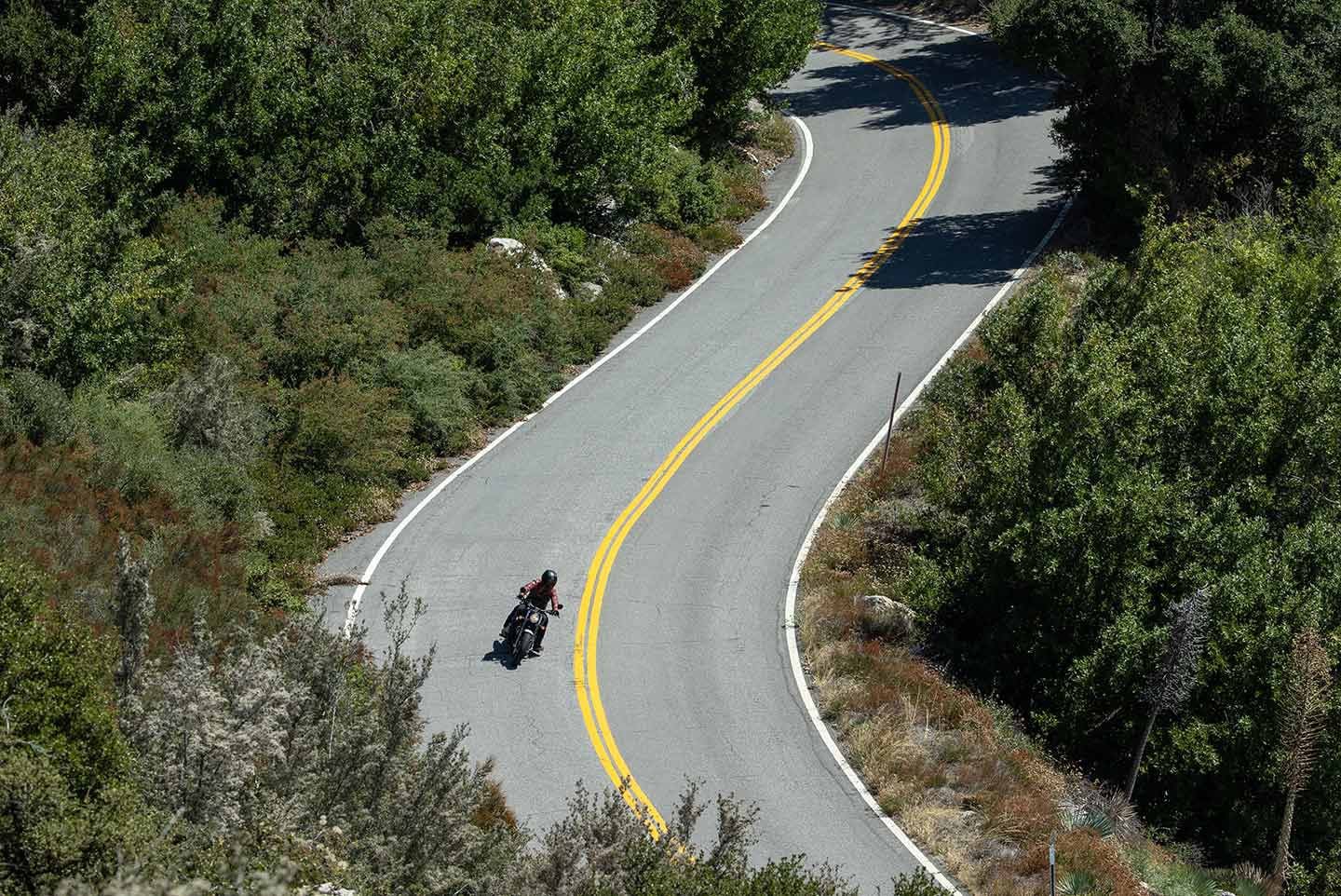
Don’t be afraid to hit the curves on the Shadow Phantom. (Kevin Wing/)2024 Honda Shadow Phantom Specs
MSRP: $8,399/$8,699 (ABS) Engine: SOHC, liquid-cooled 52-degree V-twin; 3 valves/cyl. Displacement: 745cc Bore x Stroke: 79.0 x 76.0mm Compression Ratio: 9.6:1 Transmission/Final Drive: 5-speed/shaft Fuel System: Programmed Fuel Injection w/ 34mm throttle bodies Clutch: Wet, multiplate Engine Management/Ignition: Electronic Frame: Steel Front Suspension: 41mm fork; 5.1 in. travel Rear Suspension: Twin shocks, preload adjustable; 3.5 in. travel Front Brake: 2-piston caliper, 296mm disc, available ABS Rear Brake: 1-piston caliper, 276mm disc, available ABS Wheels, Front/Rear: Wire-spoked; 17 in./15 in. Tires, Front/Rear: 120/90-17 / 160/80-15 Rake/Trail: 34.0°/6.3 in. Wheelbase: 64.6 in. Ground Clearance: N/A Seat Height: 25.6 in. Fuel Capacity: 3.9 gal. Claimed Wet Weight: 543 lb. Contact: powersports.honda.com -
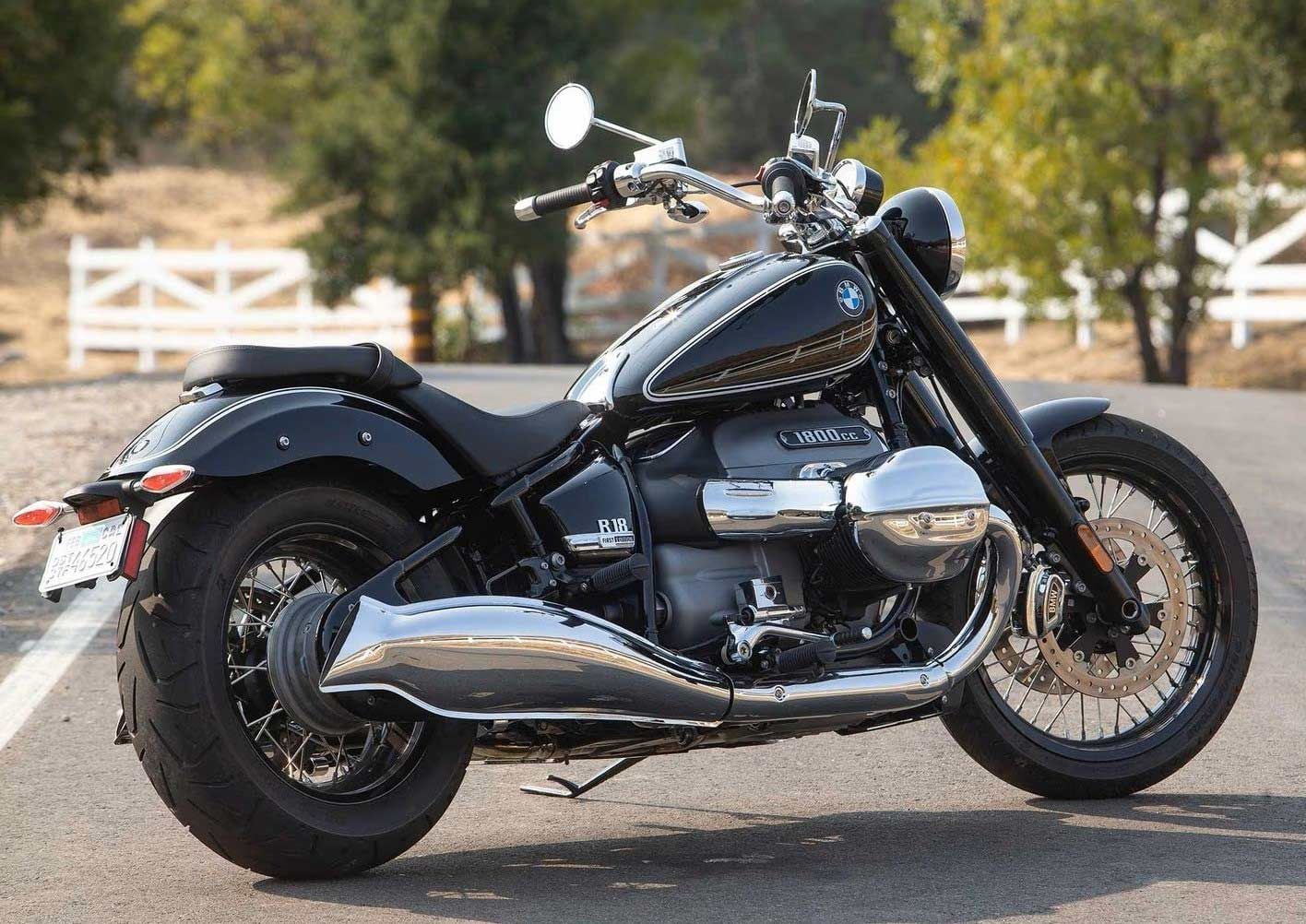
BMW Motorrad’s stop-sale order is voluntary and applies to all new internal combustion BMW motorcycles in dealer inventory. (Jeff Allen/)We just got word that BMW Motorrad has issued a stop-sale order for some of its motorcycle models in North America. Apparently the problem relates to the evaporative system in all new internal combustion machines as well as used bikes in dealer inventory.
Not to worry, however; although details remain vague, it looks like BMW owners can still ride their machines. According to the official statement, the issue at hand is with materials used in said system rather than faulty manufacturing, as some have suspected:
“Following a recent quality analysis, BMW is pursuing measures to further evaluate the material used in a component of its motorcycle evaporative system, which may not have been produced to material specifications.”
Related: Will Exhaust Emissions Limits Kill Motorcycling?
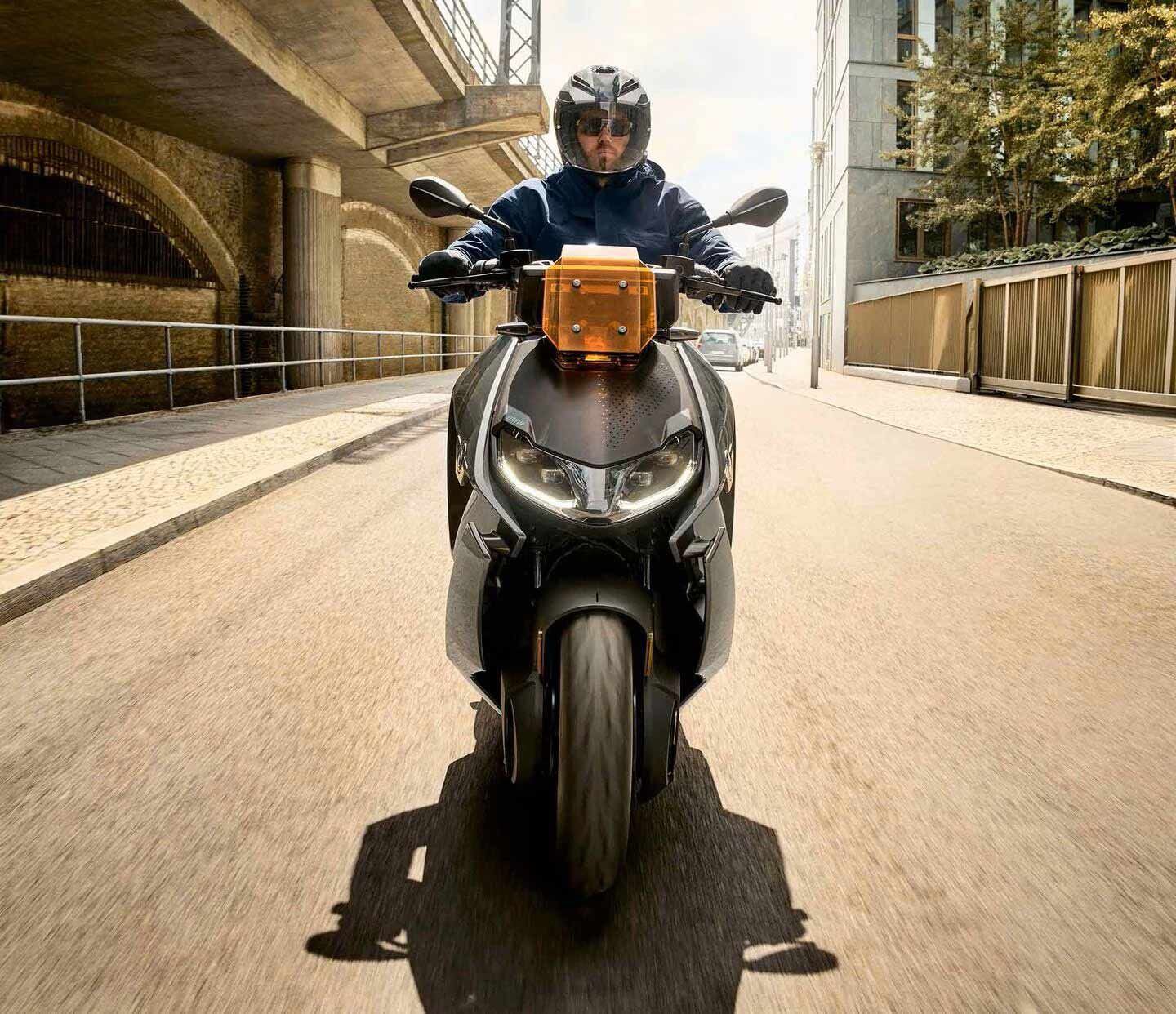
The BMW CE 04 is not affected by the order, the brand explicitly specified. (BMW/)As it stands, the stop sale order is “temporary and voluntary,” but BMW has said that it does affect “all new and pre-owned BMW motorcycle models in dealer inventory, except for the CE 04. The CE 04 is an electric, so obviously it is without any emission equipment.” No other models or further details were given, though the brand goes on to state that the issue is not safety related, and that “owners may continue to ride their motorcycles as normal.”
As a refresher, the evaporative system (also known as evap) is designed to catch unburned vapors and redirect them back to the engine or exhaust catalyst to burn more completely rather than releasing into the atmosphere.
The entire official BMW response follows:
“BMW of North America is dedicated to providing vehicles to our customers that meet their expectations. To ensure that our vehicles are of the highest industry standards, BMW performs ongoing testing and evaluation.
“Following a recent quality analysis, BMW is pursuing measures to further evaluate the material used in a component of its motorcycle evaporative system, which may not have been produced to material specifications.
“As a result, BMW of North America is issuing a temporary, voluntary stop sale for all new and pre-owned BMW motorcycle models in dealer inventory, except for the CE 04.
“This temporary stop sale is not safety related and BMW owners may continue to ride their motorcycles as normal.”
-
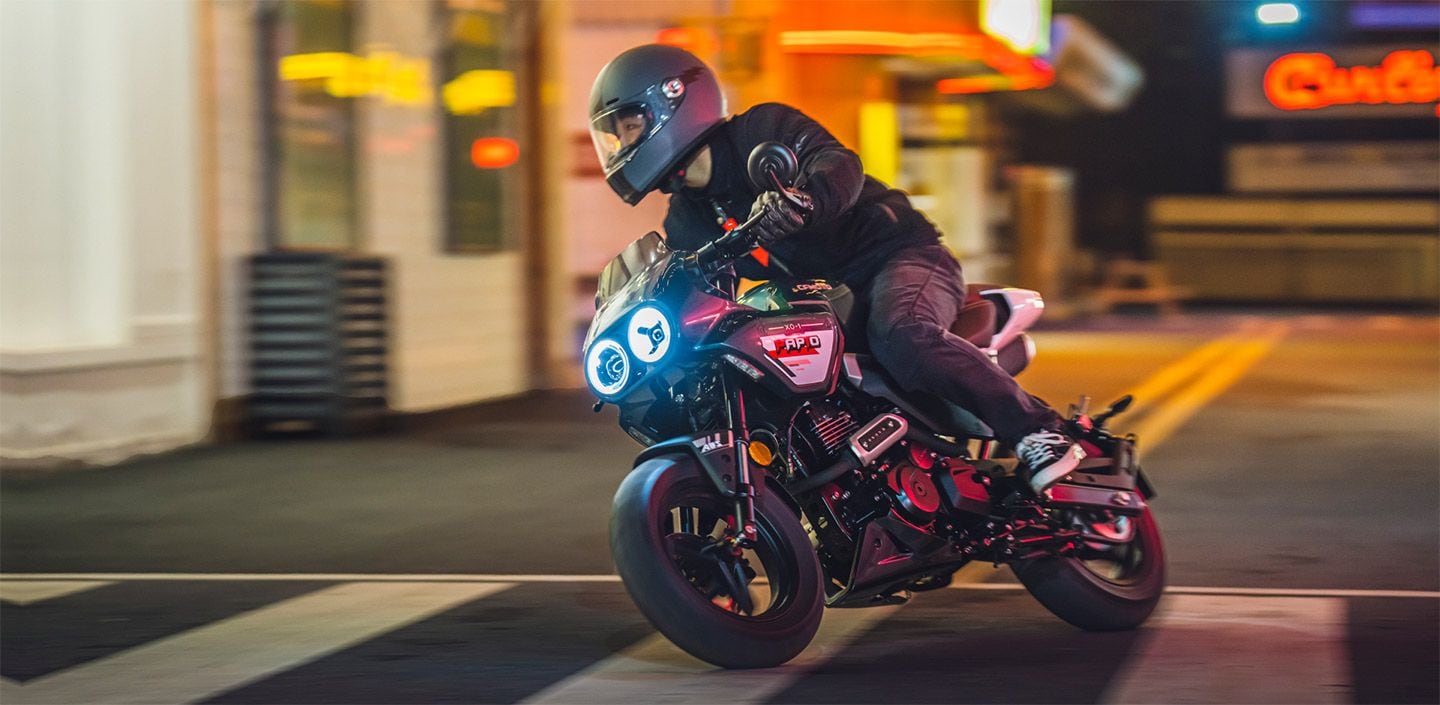
The CFMoto Papio Racer is coming to the US, likely badged as the Papio SS. (CFMoto/)At the start of this year we brought the news of two new variants of CFMoto’s 126cc Papio minibike that were launched in China—the XO Papio Racer and XO Papio Trail—and now it looks like they’re heading to the US market in 2024.
Documents filed with CARB and the EPA are listing two additional variants of the Papio, which is CFMoto’s rival to the Honda Grom, as 2024 models. While they don’t share the same names as the XO Papio Racer and Trail that have already hit the market in China, they’re likely to be the same bikes.
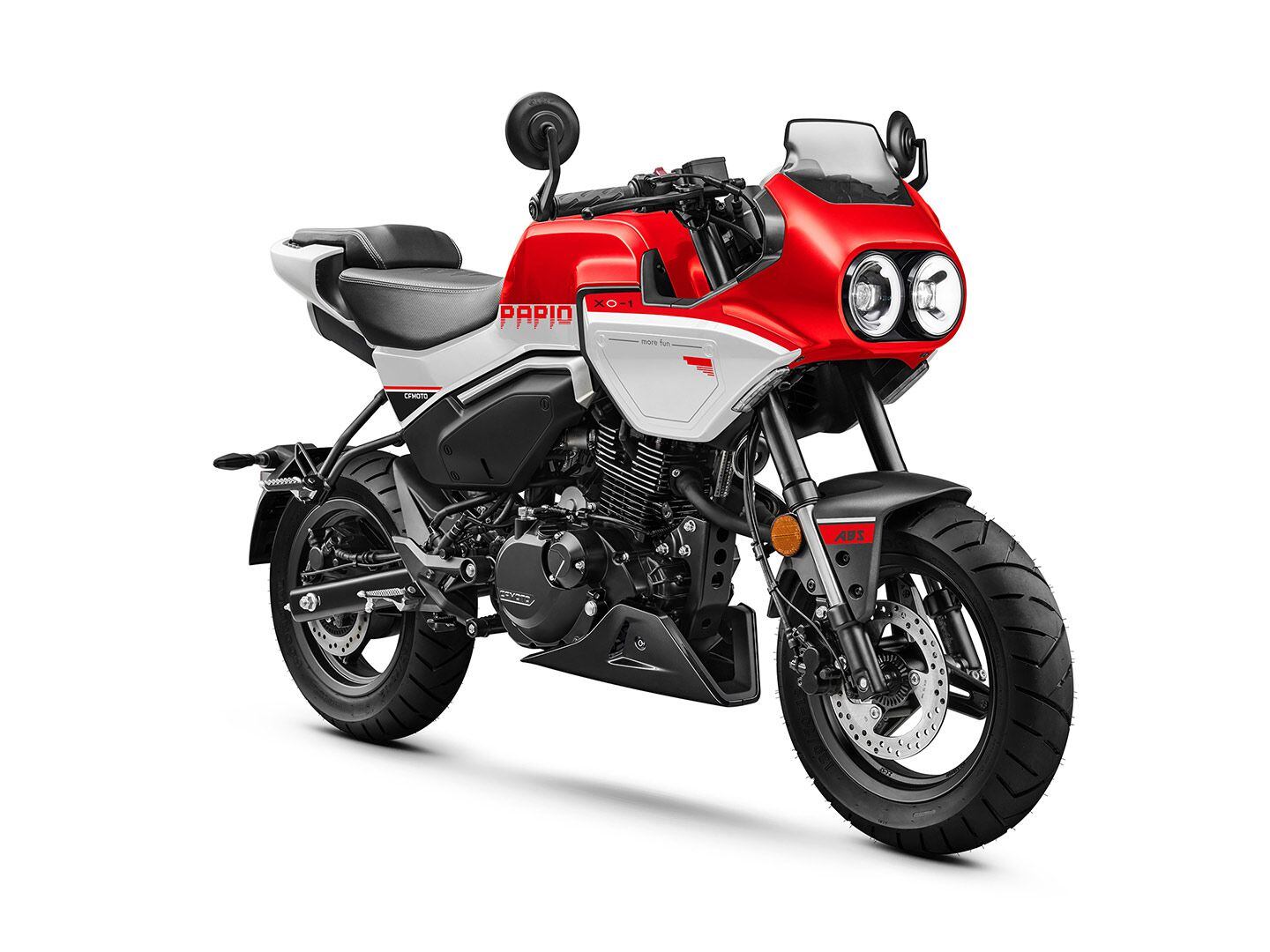
The Papio SS looks like an 1980s endurance racer with its retro headlights. (CFMoto/)The first new machine listed is the Papio SS—a title that fits CFMoto’s US branding for sport models. In the States, all CFMoto’s sportbikes carry the “SS” suffix, even though the same machines are titled “SR” in most other countries. The implication is that the new Papio SS that’s appeared on the emissions filings is a faired, sport version of the Papio, matching the brief of the XO Papio Racer.
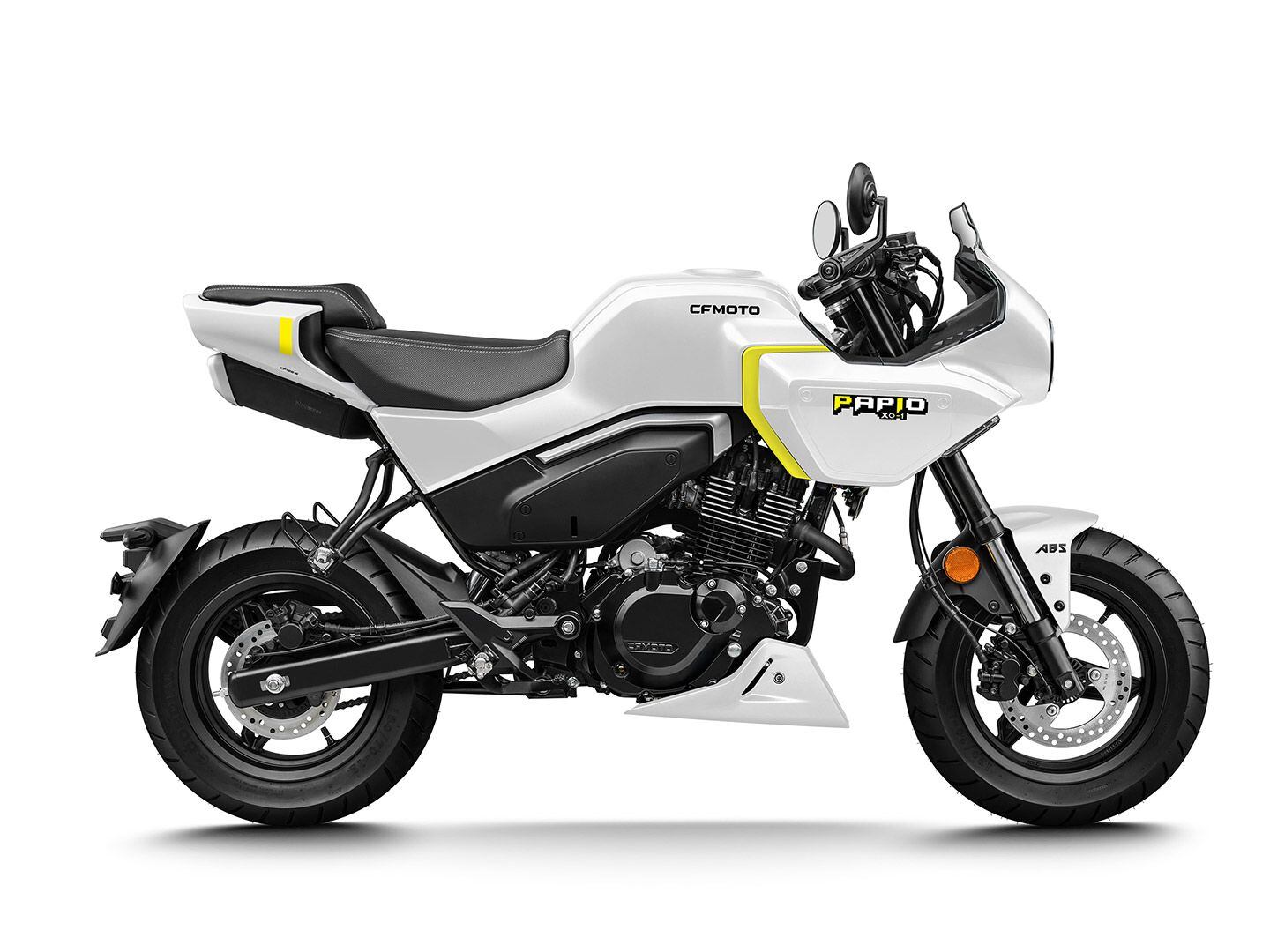
Side view of the Papio Racer in white. (CFMoto/)Essentially similar to the existing Papio under the skin, the Racer (or SS?) adds an underseat exhaust, a fairing with twin headlights, a small bellypan, and dropped bars. The overall look is reminiscent of 1980s endurance racebikes, albeit ones that have been shrunk in the wash and become caricatures of themselves.
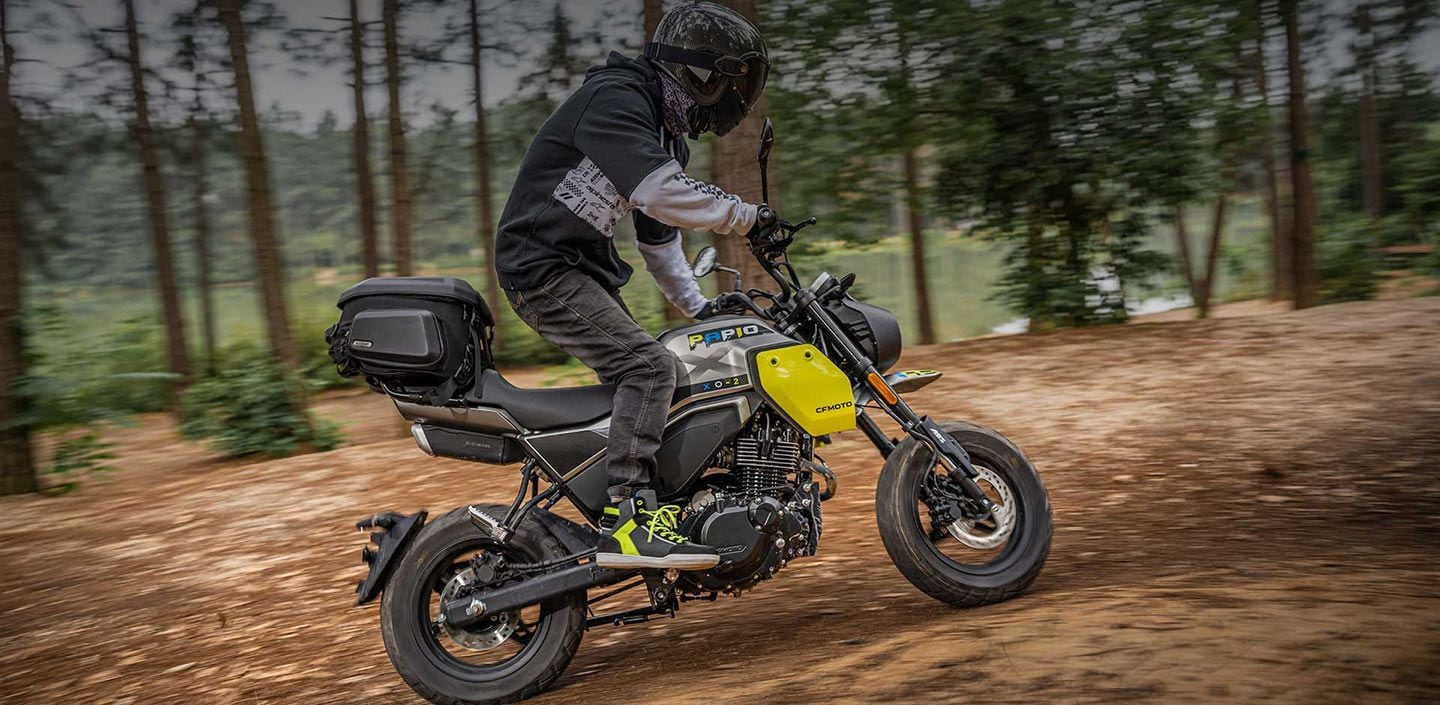
The other variation that is coming to the US, which we believe will be called the Papio CL here. (CFMoto/)The second new model in the emissions paperwork, the Papio CL, uses a name that aligns with the unfaired, slightly retro 700CL-X models currently sold here. It’s a title that wouldn’t be out of place on the bike sold in China as the XO Papio Trail, which borrows many of the components of the XO Papio Racer but removes the fairing and adds a dash of adventure bike to the recipe.
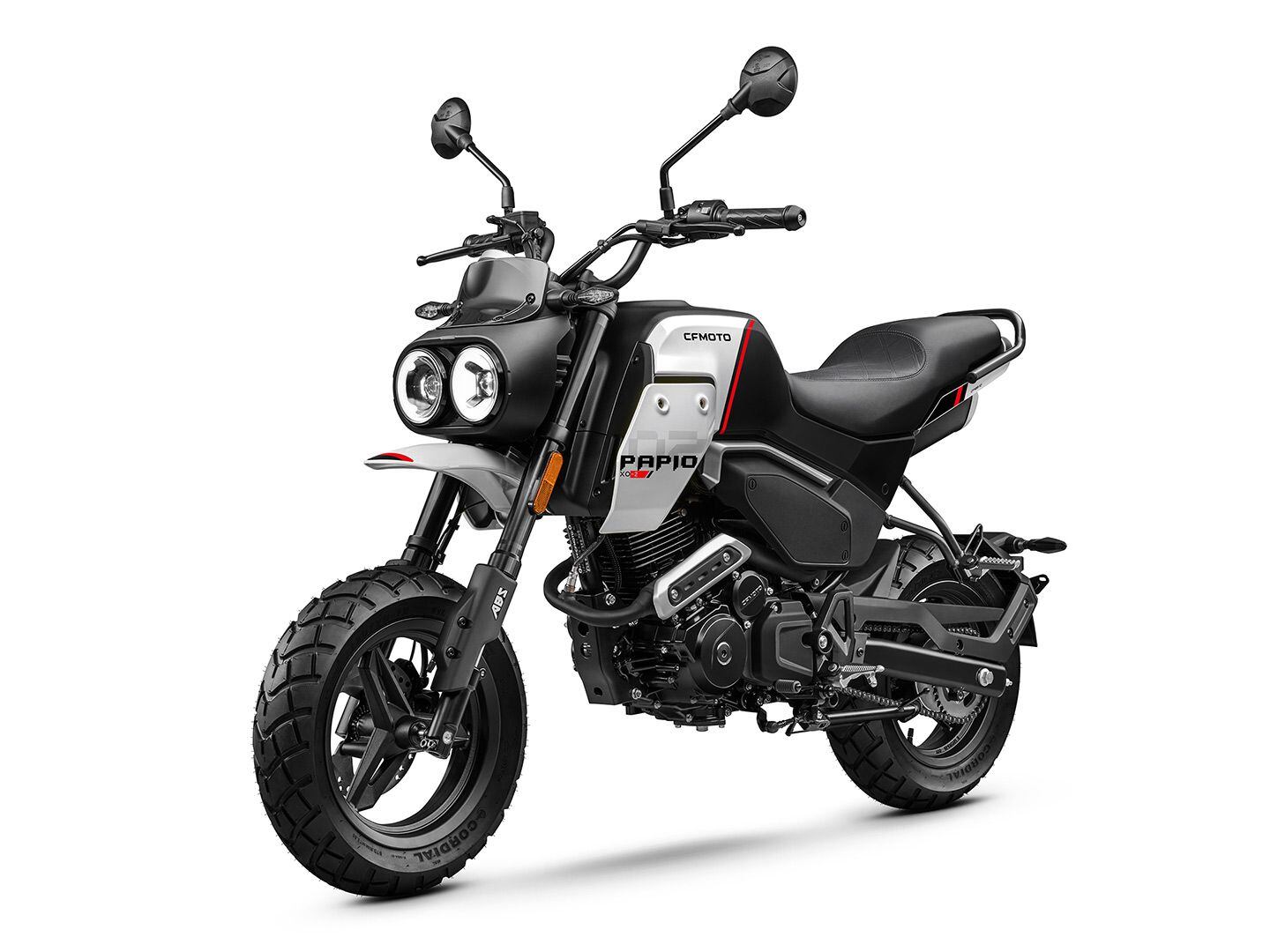
The Papio Trail will be called the Papio CL in the US. (CFMoto/)It has the same set of circular headlights, but sets them in a small, bar-mounted cowl above a high front fender. The 1.8-gallon fuel tank is the same as the Racer’s and the underseat exhaust is also shared, but the seat is simpler and the Trail lacks its sister model’s bellypan. Both bikes also have the same upside-down fork—an upgrade over the base Papio.
In terms of specs, all variants of the Papio share the same 126cc air-cooled fuel-injected single, making 9.4 hp, although the different exhaust on the XO models means it arrives at fractionally lower revs—8,250 rpm instead of 8,500 rpm. They also sit on an identical 48-inch wheelbase and, according to their Chinese specs, come in at the same 251-pound weight. That last figure is slightly at odds with the CARB and EPA documents, which show a 22-pound increase for the two new models compared to the standard Papio. However, the emissions paperwork uses a rounded-up Equivalent Inertial Mass (EIM) figure intended to represent both bike and rider rather than a simple bike weight, so needs to be taken with a large pinch of salt when making comparisons.
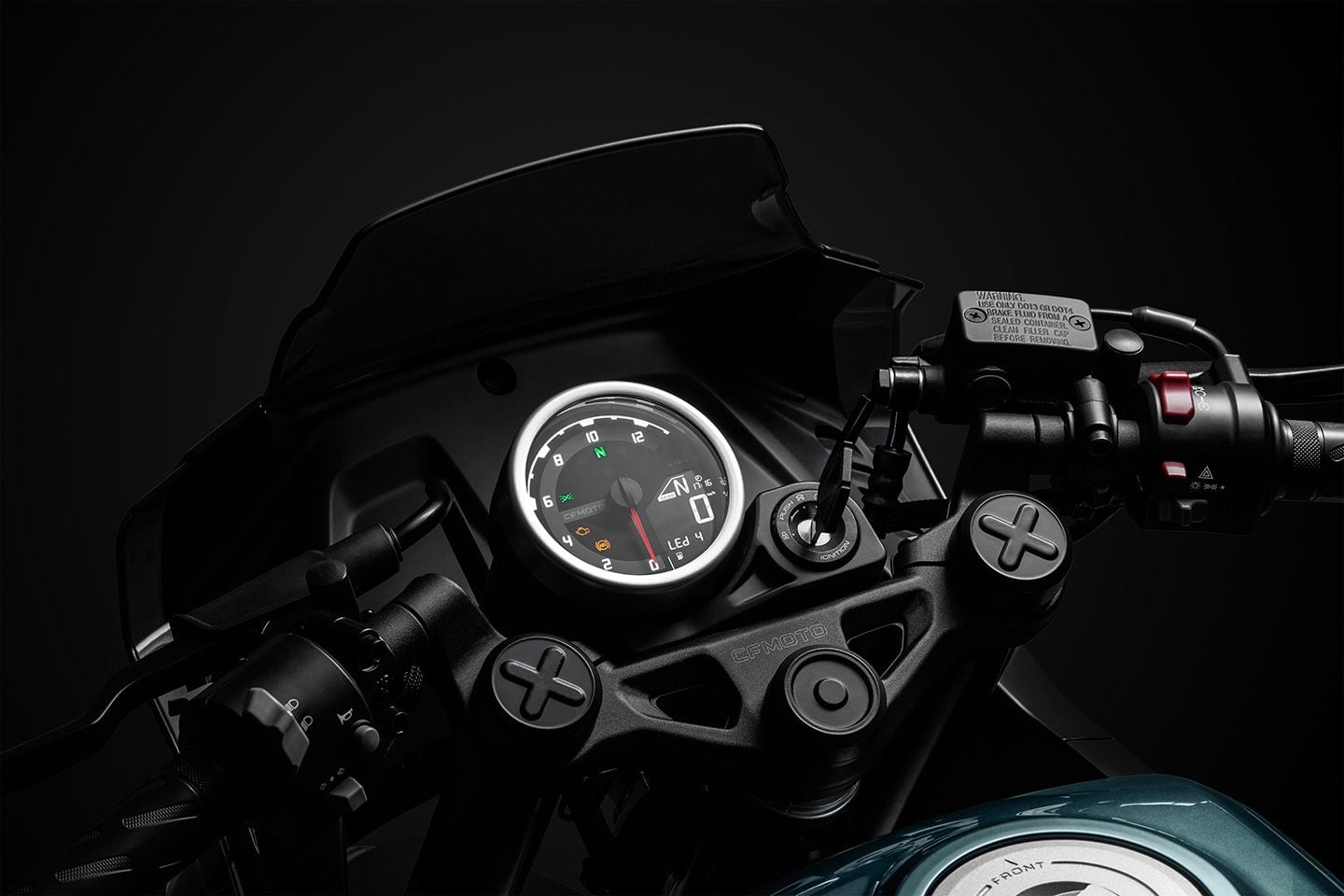
A closer look at the Papio Racer’s cockpit. (CFMoto/)Given their similarities, the two new Papio variants aren’t likely to be vastly more expensive than the standard $2,999 model sold here now, potentially undercutting the $3,599 Honda Grom that’s clearly its No. 1 rival.
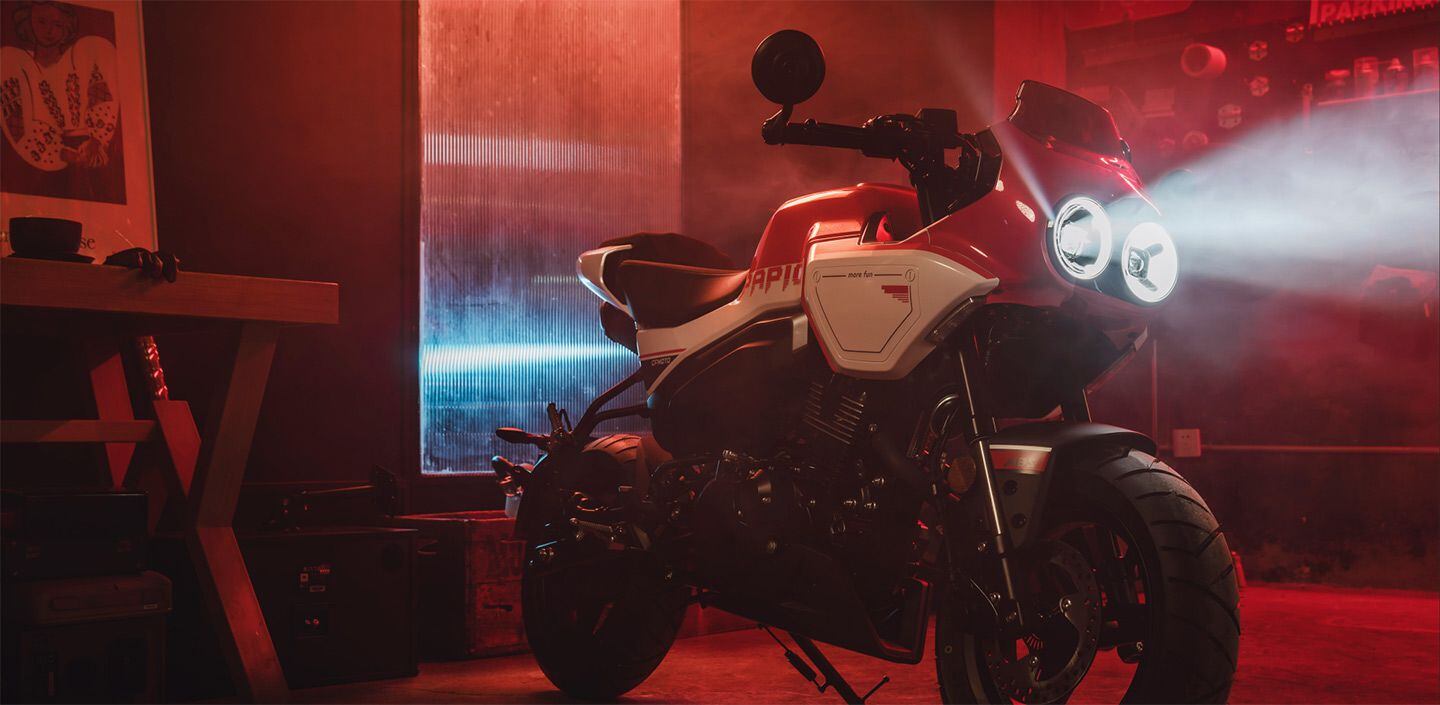
CFMoto Papio Racer. (CFMoto/)-
 1
1
-
-
More torque and road-focused handling characteristics seem to be in the pipeline.
-
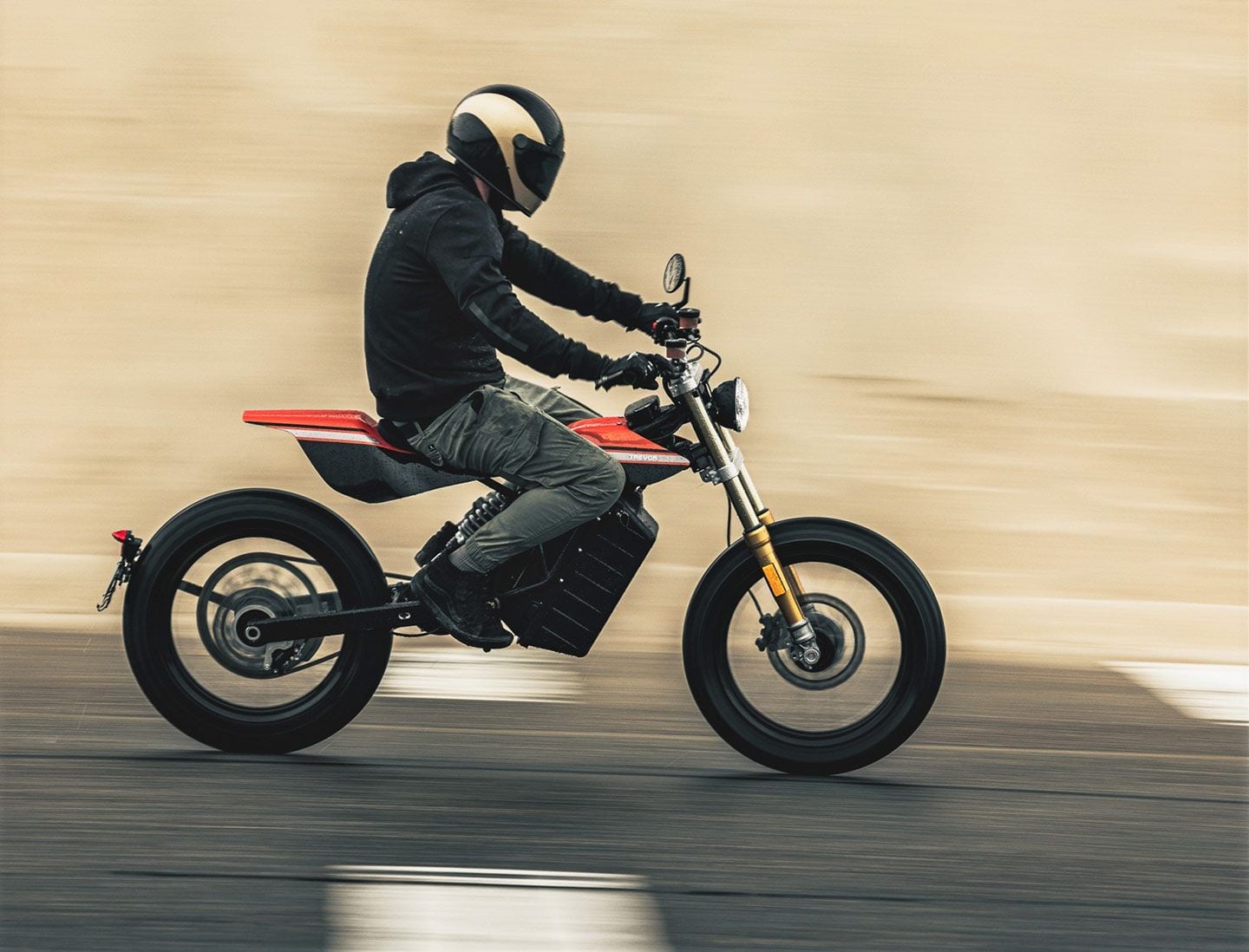
Big on style and adequate on power, the Belgian-born Stella DTRe electric motorcycle is coming to the US market. (Russell McKellar/Trevor Motorcycles/)You could say the electric motorcycle market has been absolutely flooded with new models of late, but if you’re sniffing around for lightweight, torquey two-wheelers designed mainly for off-road? There are only a handful of those, and if your wish list demands premium components, solid build quality, and a heavy dose of style, the choices shrink dramatically. With the introduction of its new DTRe Stella, Belgium-based Trevor Motorcycles made it clear it was angling to join that rarefied group; the problem was that model was only available in Europe. But now Trevor is bringing an off-road-only version of its DTRe Stella to riders in the US, and it’s available for order.
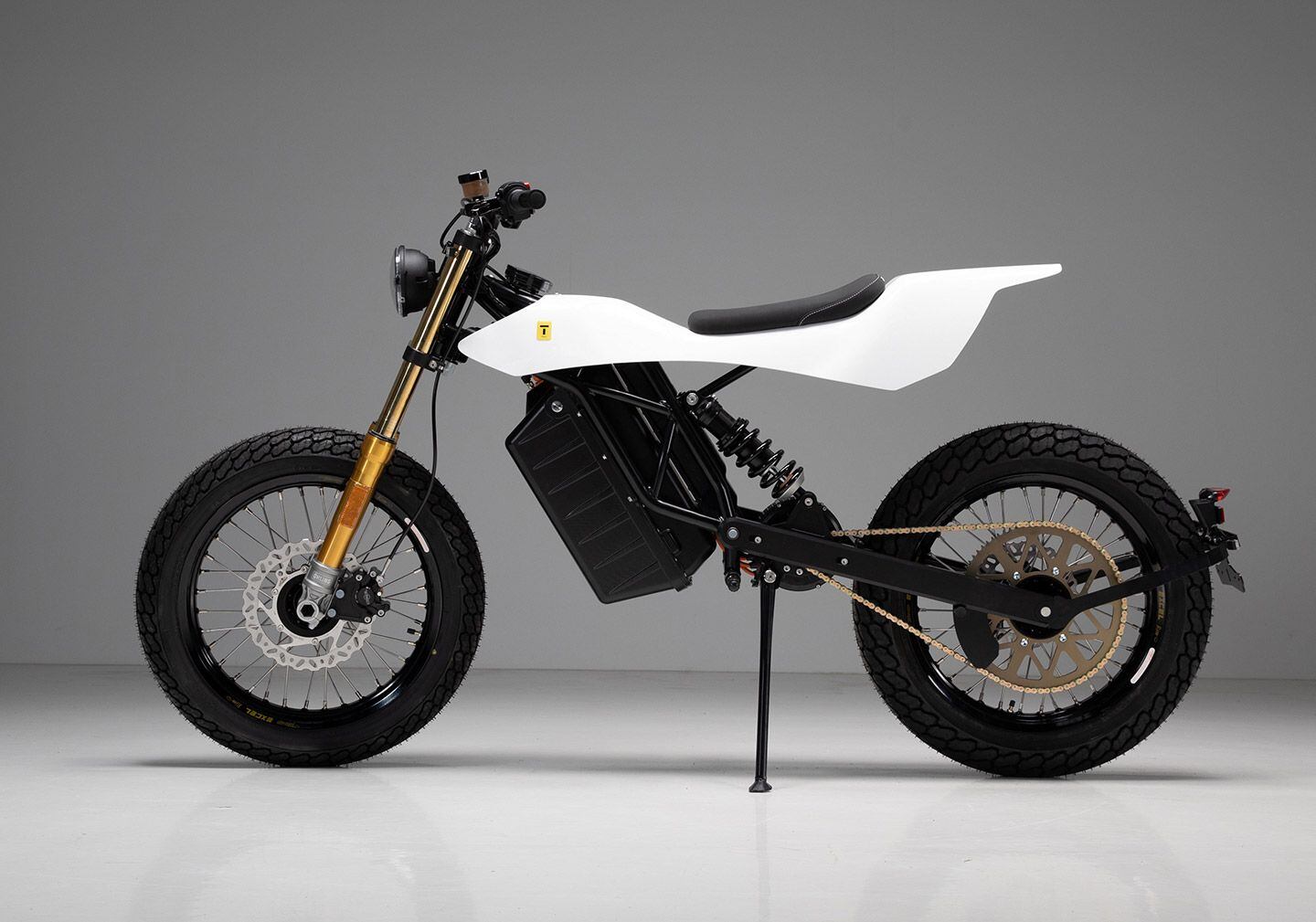
Spare styling with a minimal body and big 19-inch wheels define the DTRe Stella’s flat-track-ish vibe. Each bike is hand-built in Belgium. (Trevor Motorcycles/)Let’s be clear: The Stella ain’t exactly new, having been in pandemic-addled development for more than two years and finally hitting European streets over a year ago. Trevor says its bikes are “Designed in California and Hand-built in Belgium,” but over there, the Stella is street-legal for A1 license holders. Not so in North America; Trevor emphatically states, “In the USA this motorcycle is not allowed to drive on public roads.”
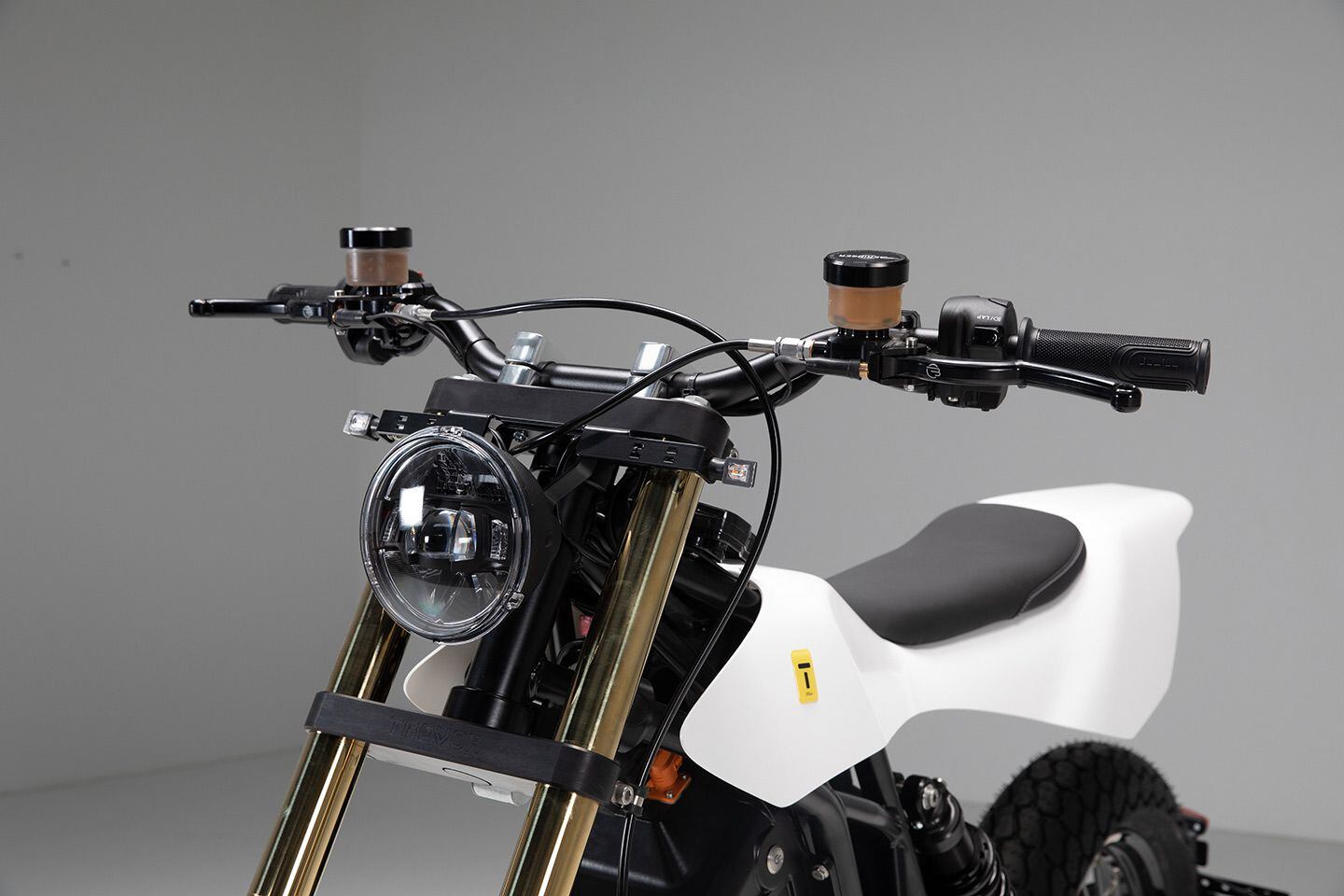
LED lighting and an aluminum flat-track-style Domino Racing bar define the front end. (Trevor Motorcycles/)In any case, here’s what else we can confirm: The DTRe Stella is a classic flat-track-styled electric motorcycle with upright ergonomics and a good amount of premium high-performance parts. We’re talking a chromoly trellis frame, CNC-machined alloy swingarm, an adjustable Öhlins fork, and a linkage-free rear shock to name just a few.
Beringer brake calipers supply stopping power to the lightweight 19-inch Excel wheels, which are shod with flat-track-spec Mitas rubber. Although we can clearly make out that Öhlins fork, there’s no travel measurement, and while Saroléa Performance Technology is also mentioned as a component, it’s not clear for what element. (If Saroléa sounds familiar, that’s because the fellow Belgian electric outfit campaigned an SP7 racebike at IOM TT Zero a few years back.) Trevor does state that the Saroléa Performance Technology team did collaborate on the bike “to ensure the strict integration of premium OEM parts.”
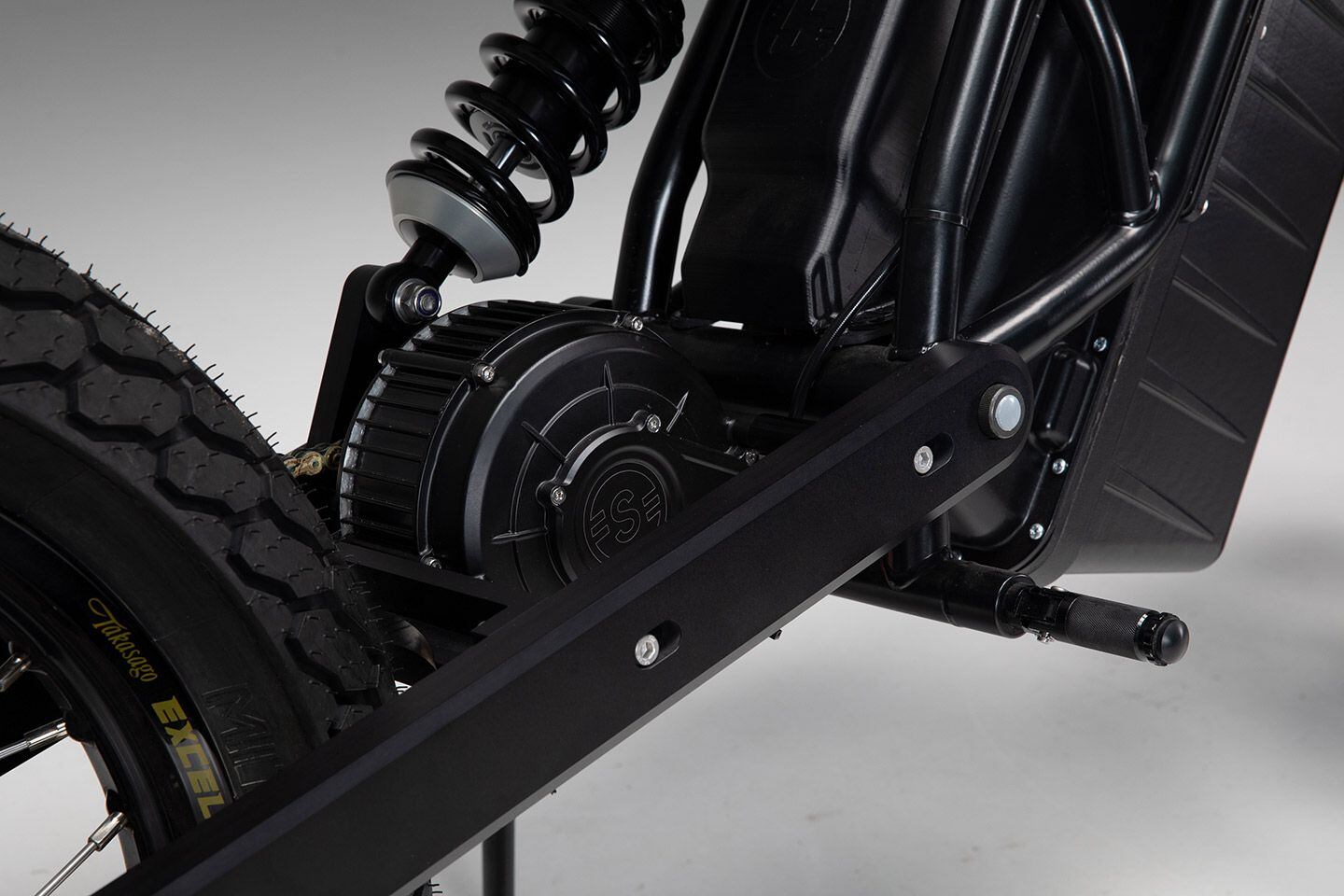
An air-cooled DC motor is mounted at the swingarm pivot; it’s good for 11kW of peak power and 8kW rated power. (Trevor Motorcycles/)Other specs on the US release also vary somewhat from the EU model on the website, with a claimed 223-pound weight for American machines, though both versions of the bike get power from a brushless air-cooled 11kW (that’s 14.7 hp) motor mounted at the swingarm pivot. Trevor claims 233 lb.-ft. of torque at the rear wheel, with juice provided by a 2.7kWh battery. The lithium-ion brick is said to be good for 54 miles of range, with a charging time of just over an hour, with the optional 3kW charger; the standard 1kW charger will get you an 80 percent charge in two hours.
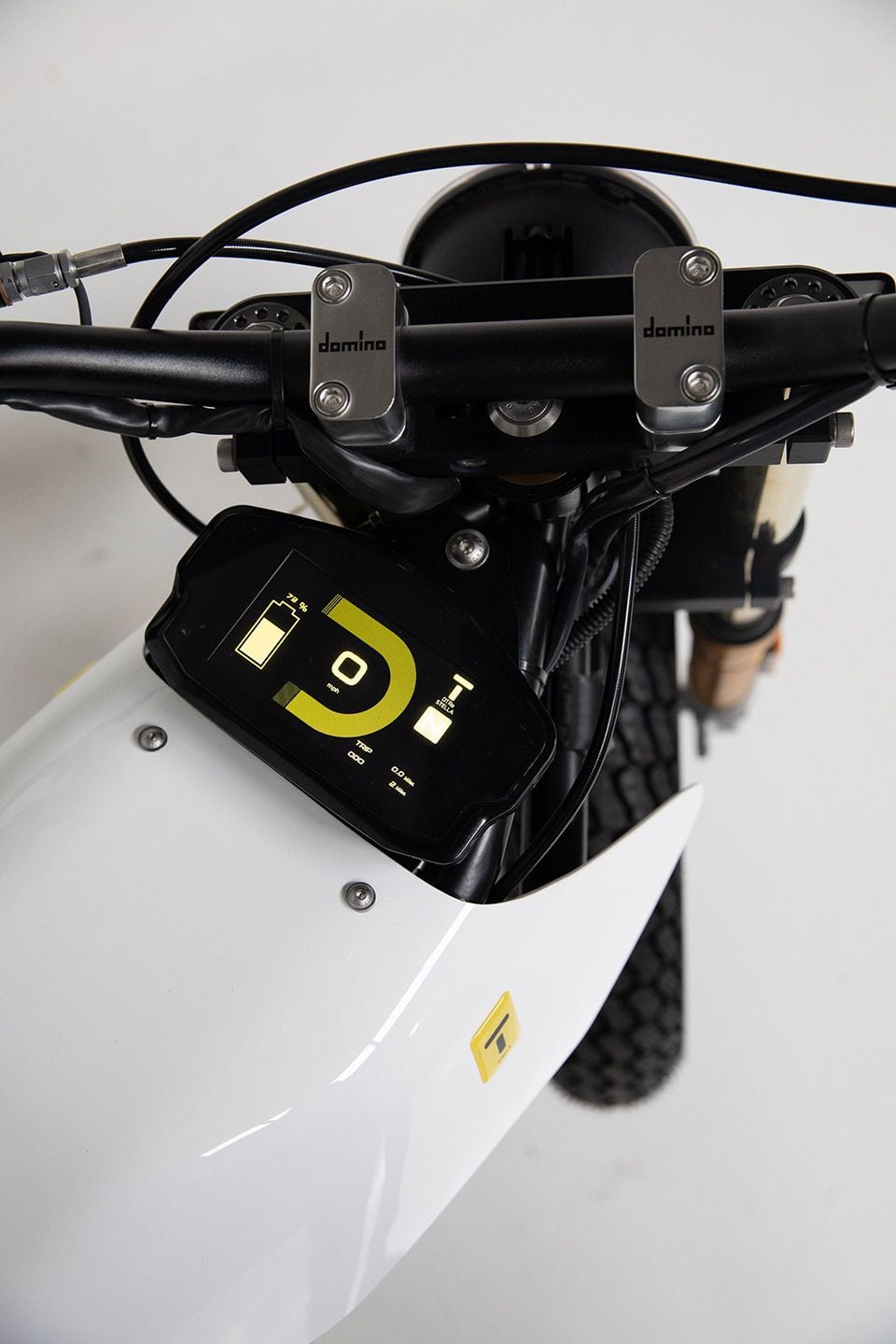
A cockpit view of the DTRe Stella, with a color dash displaying bike functions and battery status. (Trevor Motorcycles/)Trevor emphasizes its “design-first approach in terms of both technology and style” on the DTRe Stella model, which we’re seriously hoping doesn’t mean form over function. There’s no denying the Stella’s minimalist look is pleasing to the eye but there’s just this one bike, so we’ll have to wait and see if that “looks matter” philosophy holds. Each DTRe Stella comes with a built-in battery pack, 1kWh external charger, and white body, but Trevor is also offering additional optional bodywork colors and other accessories to give Stella buyers more choices on the cosmetic front, so there’s definitely a fashion element at play here.
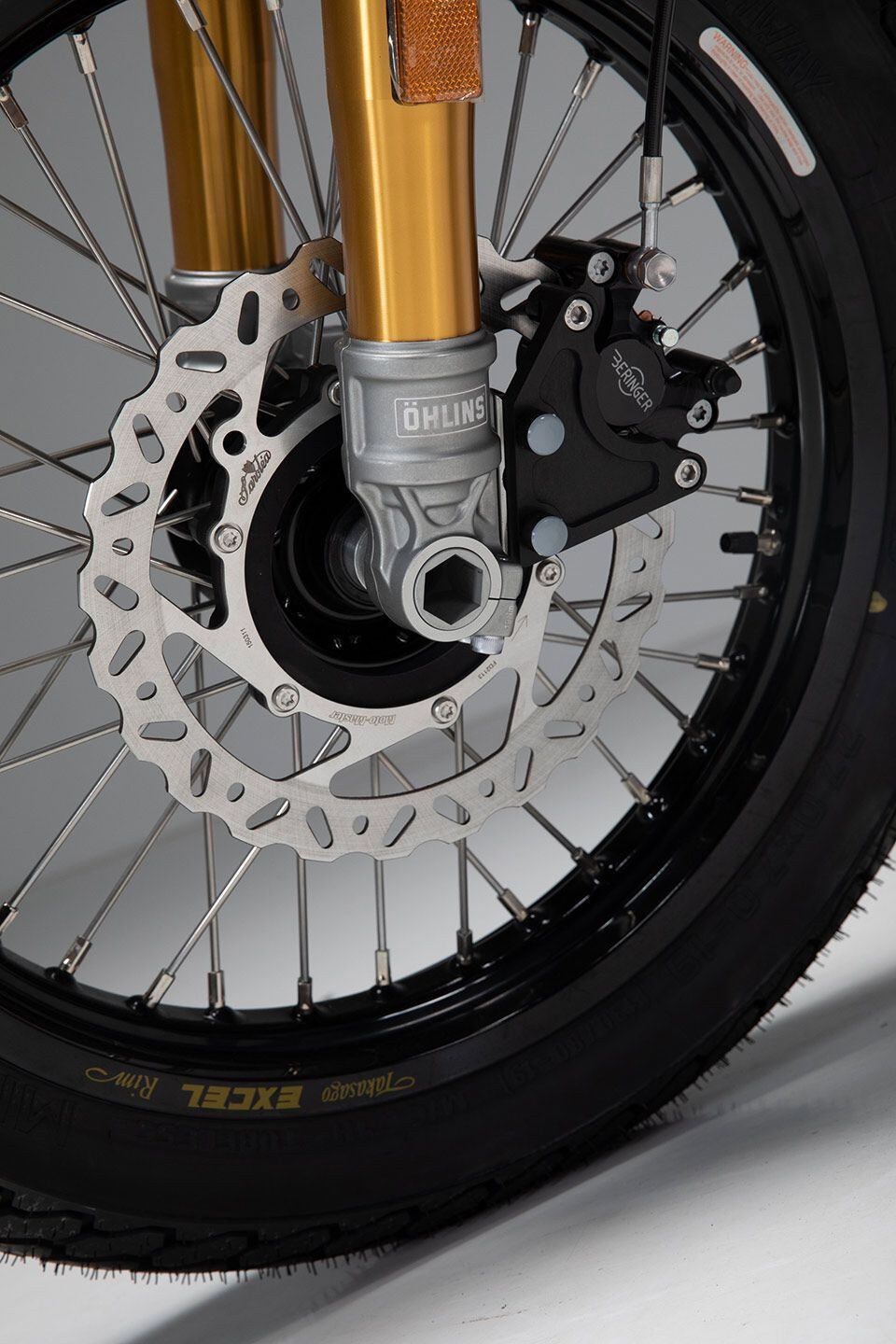
Öhlins supplies the front suspension, with Saroléa Performance Tech providing calibration. Beringer brake calipers appear front and rear. (Trevor Motorcycles/)As far as positioning in the market goes, Trevor says the DTRe Stella is “an everyday performance bike…with zero active emissions…and a near-silent ride. The size and thickness of the tires make the Stella ideal for a wide range of riders from pros to those just getting started riding.”
Jeroen-Vincent Nagels, co-founder and technical director of Trevor Motorcycles, added: “It’s incredibly exciting to be launching the DTRe Stella in the US market, and to continuously hear the amazing responses from our customers who absolutely love the look, feel, and performance of the bike.”
The bad news is that the bike is currently limited to a top speed of 56 mph and a range of 54 miles, which likely relegates it to the status of a very good looking commuter bike for city use—if it were street-legal. US MSRP is $11,975, but the Stella isn’t your highest priced option, though it does have company in that group; Zero’s also flat-track-y FXE rings in at $12,995, but with double the power and longer range. A better comparison would be the also off-road-only Sur-Ron Ultra Bee, which brings similar power and range claims as well as chunky 19-inch wheels—but is half the price of the Stella. Will the Stella’s more premium component set and polished design be enough to woo US consumers? We’ll see.
The DTRe Stella can be found online at: trevormotorcycles.com/products/dtre-stella-usa.
Trevor Motorcycles states a 20-week lead time between purchase and delivery.
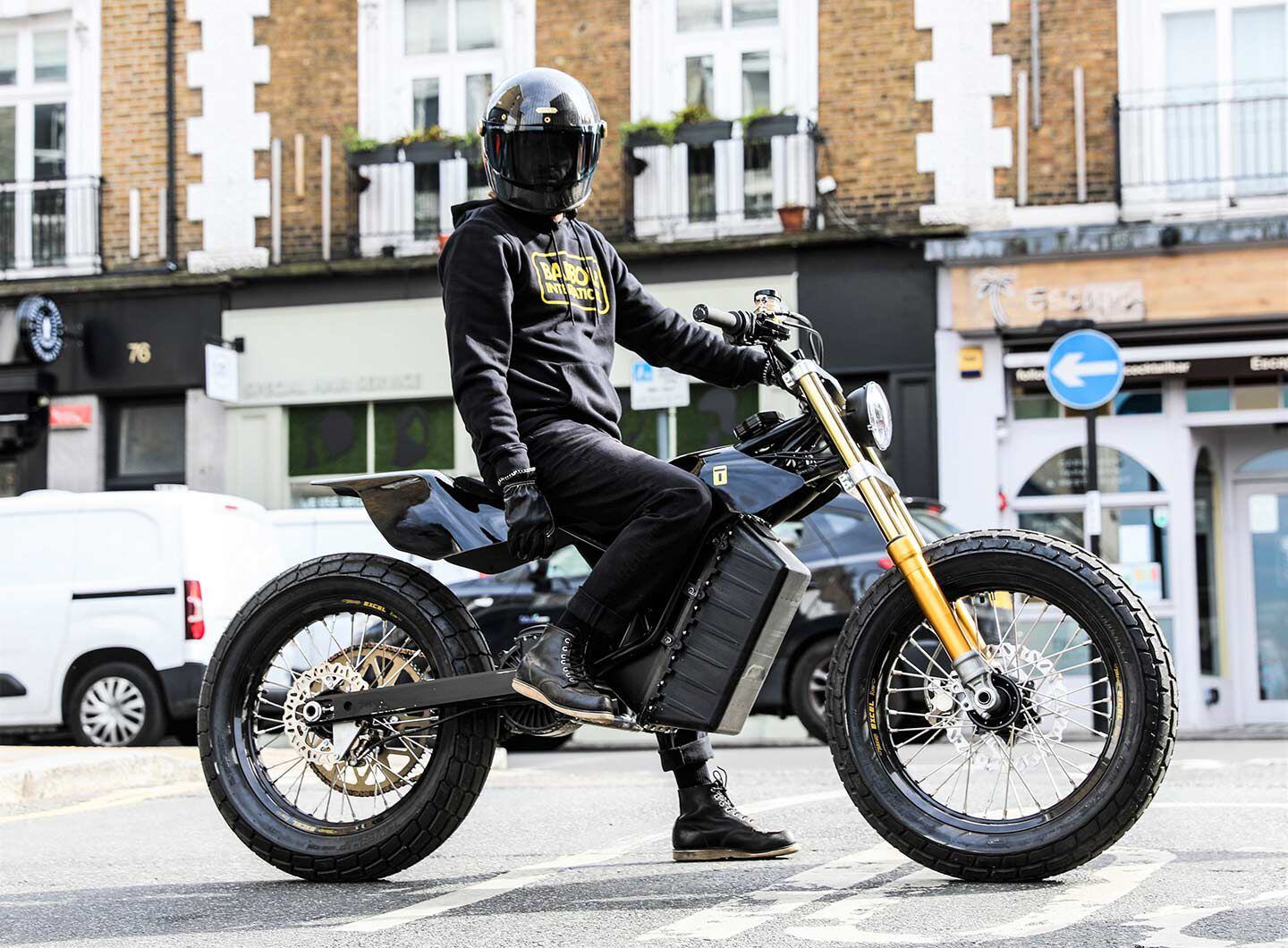
Optional bodywork in various colors and patterns are also available for the DTRe. Shown is the street-legal EU model. (Trevor Motorcycles/) -
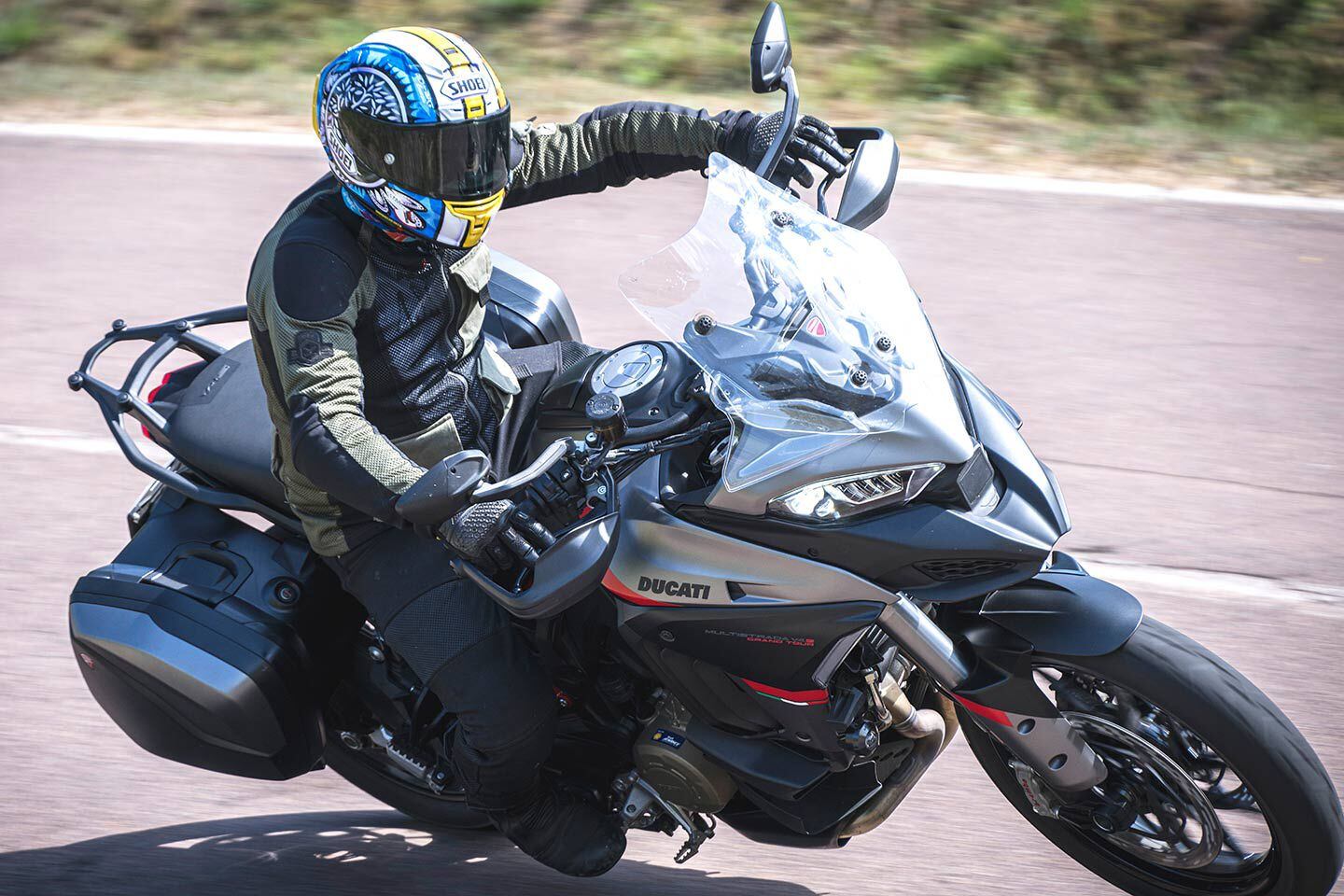
Is Ducati’s Multistrada V4 S Grand Tour the best iteration of the Italian brand’s adventure bike? (Alex Photo/)Some of us are early adopters, always eager to snap up the latest technological wonder as soon as it lands—to hell with the price. Others are more reticent, preferring instead to see how that supersmart new phone or tablet plays out, then wait until it’s cheaper. Which camp are you in? Fans of the Ducati Multistrada V4 might be glad to be in the latter, because the latest incarnation, the V4 S Grand Tour, is arguably the most technologically rich all-round streetbike ever built. And in comparative terms, represents value for money.
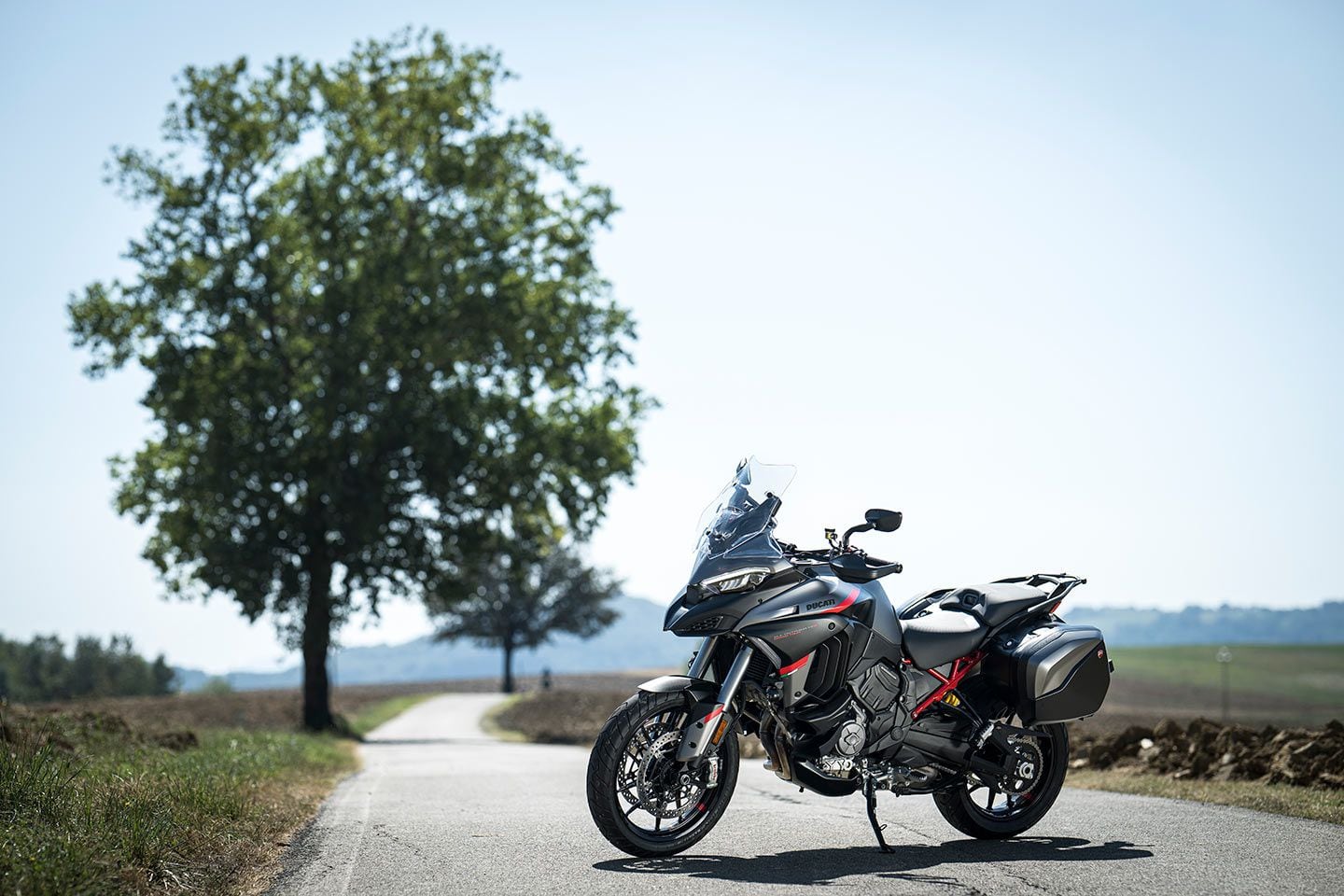
Priced at $28,395, the Multistrada V4 S Grand Tour offers a great value. (Alex Photo/)Some three years after Ducati’s first V-4 adventure motorcycle hit the street, the Grand Tour is “the most complete Multistrada ever for lovers of long-distance travel in maximum comfort and safety” says the Bologna factory—and its spec sheet is as long as it is compelling. From radar-based systems such as Adaptive Cruise Control (ACC) and Blind Spot Detection (BSD) to an instant seat-height lowering system, which allows the shorter rider to reduce the spring preload to its minimum at low speed or when stopped, Multi GT is simply stunning considering the its $28,395 price tag. In fact the package, which also includes LED lights, multiple riding modes, 60-liter side cases, a main stand with Easy Lift, a hands-free gas tank cap, and GT livery, is significantly cheaper than a fully spec’d V4 S with similar factory options fitted.
As well as raiding the V4 S accessory catalog and making a host of Multistrada extras standard fitments, Ducati has also bestowed the Grand Tour with technologies and parts from the proven Multistrada Rally (that will also become standard on the Multi in 2024). Its directly mounted handlebar configuration, for example, which Ducati say gives the rider more direct feel without incurring extra vibration, is the same as the Rally’s. There are added heat shields to isolate the rider from engine heat, adjustable cooling air scoops, and a more comfortable pillion seat, all from the Rally too.
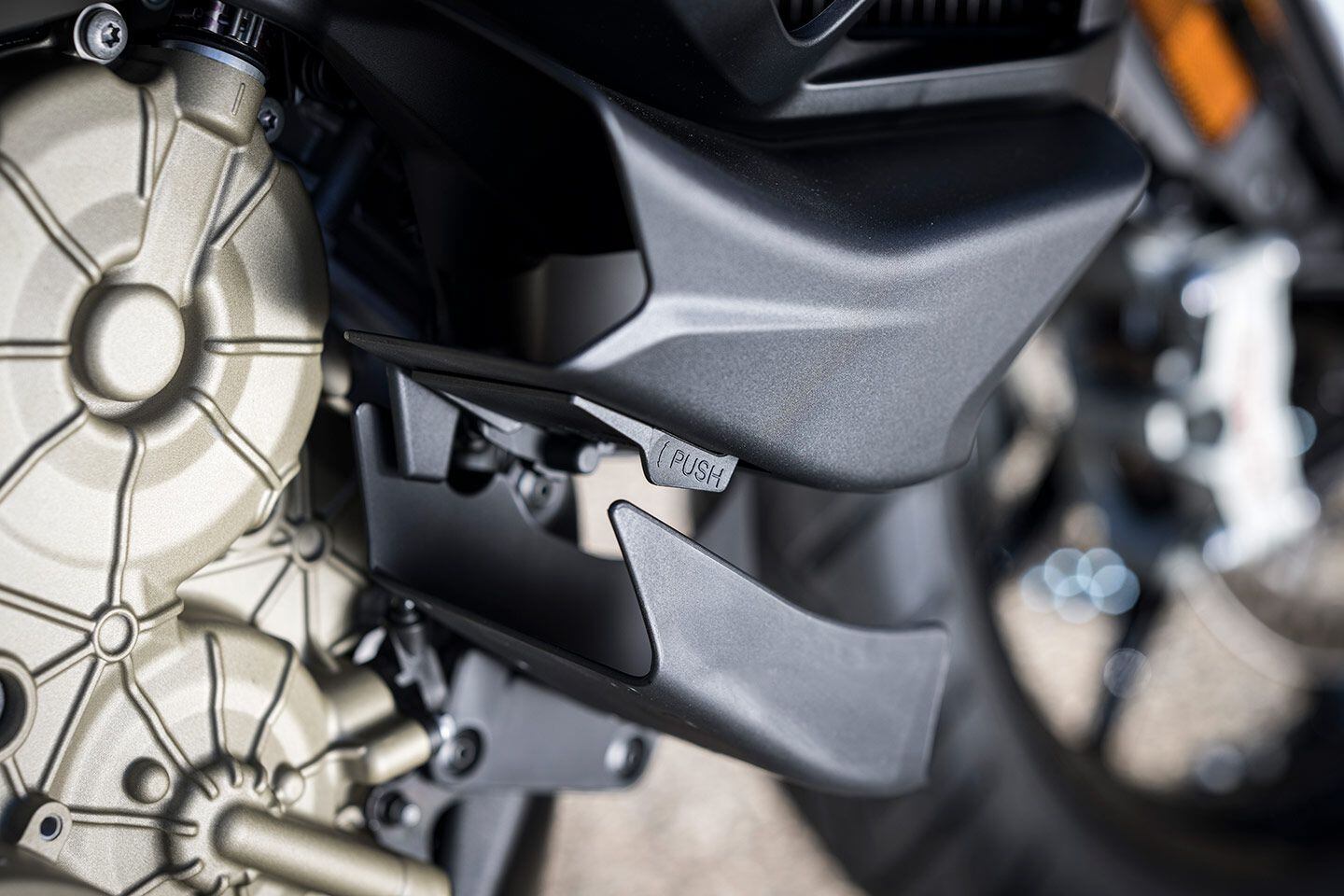
Adjustable air scoops direct cooling air to the rider’s lower extremities. (Alex Photo/)In contrast to the myriad extras and tweaks introduced to the Grand Tour, the Granturismo V-4 motor, with its counterrotating crank, spring-operated valves, and most impressively, 170 hp at 10,500 rpm and 92 lb.-ft. of torque at 8,750 rpm, remains blissfully unaltered.
Smooth and long-legged on the freeway, urgent and aggressive in the hills, the Granturismo remains one of the great Ducati engines, its only flaw being that the Grand Tour shares the version used in the current V4 S and not the new 2023 Rally. That means it doesn’t benefit from the latter bike’s cylinder deactivation system (also installed in the Diavel), which deactivates the back two cylinders below 4,000 rpm, improving fuel economy, emissions, and crucially, reducing engine heat to the rider at low rpm.
Its versatility is enhanced by four riding modes: Sport, Touring, Urban, and Enduro. Each brilliantly adapts and configures the bike’s power and the long list of rider aids to suit the terrain and riding mood.
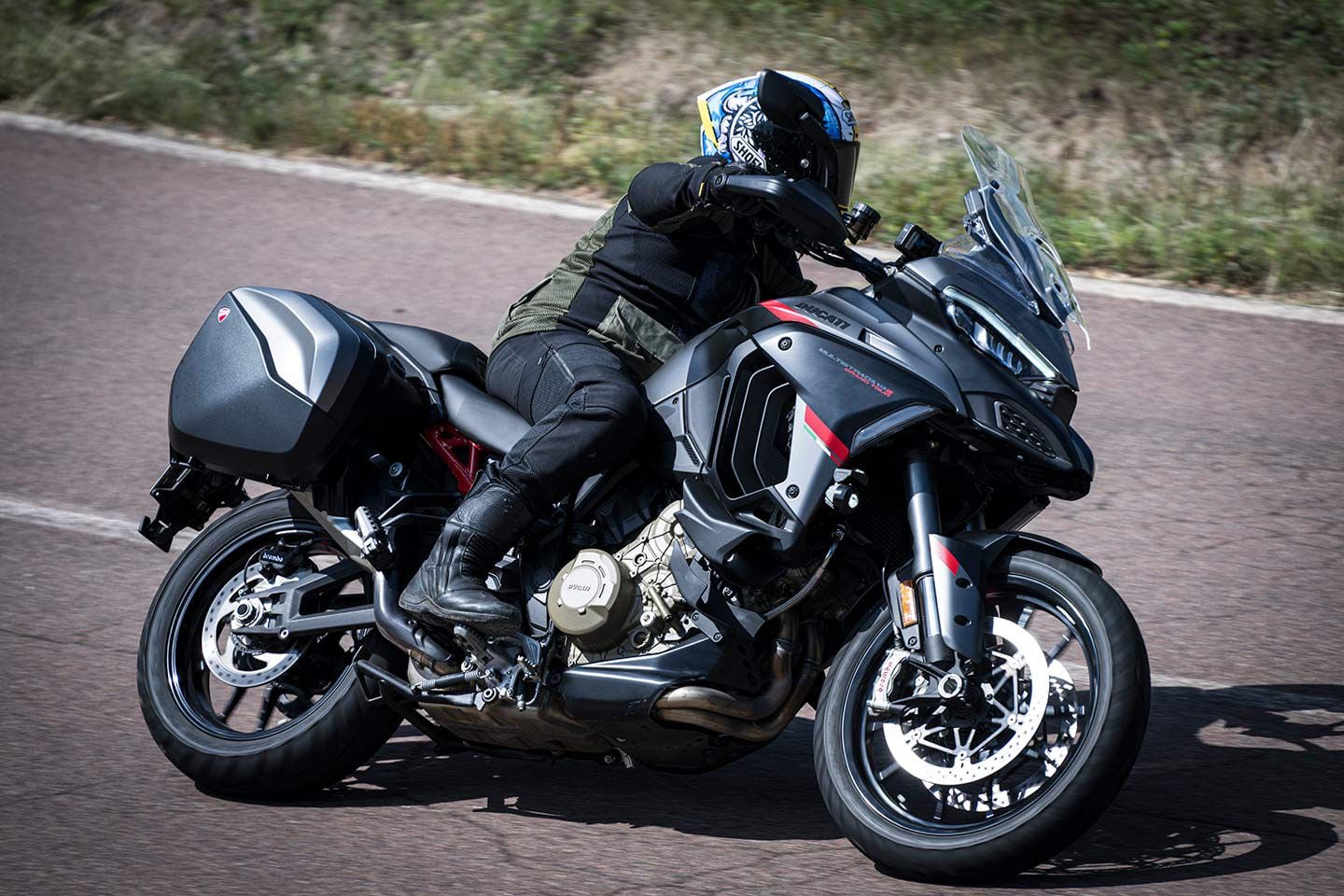
Riding modes adjust the power, suspension, and traction control for the ability to adapt to various road and weather conditions. (Alex Photo/)Cycle World was invited to experience the new Grand Tour over two days of riding in northern Italy, fully loaded with enough kit in the 60-liter cases for an overnight stay near the Imola race circuit. As well as being treated to miles of snaking asphalt, we experienced several hours of autostrada riding, crunching out miles to our overnight destination.
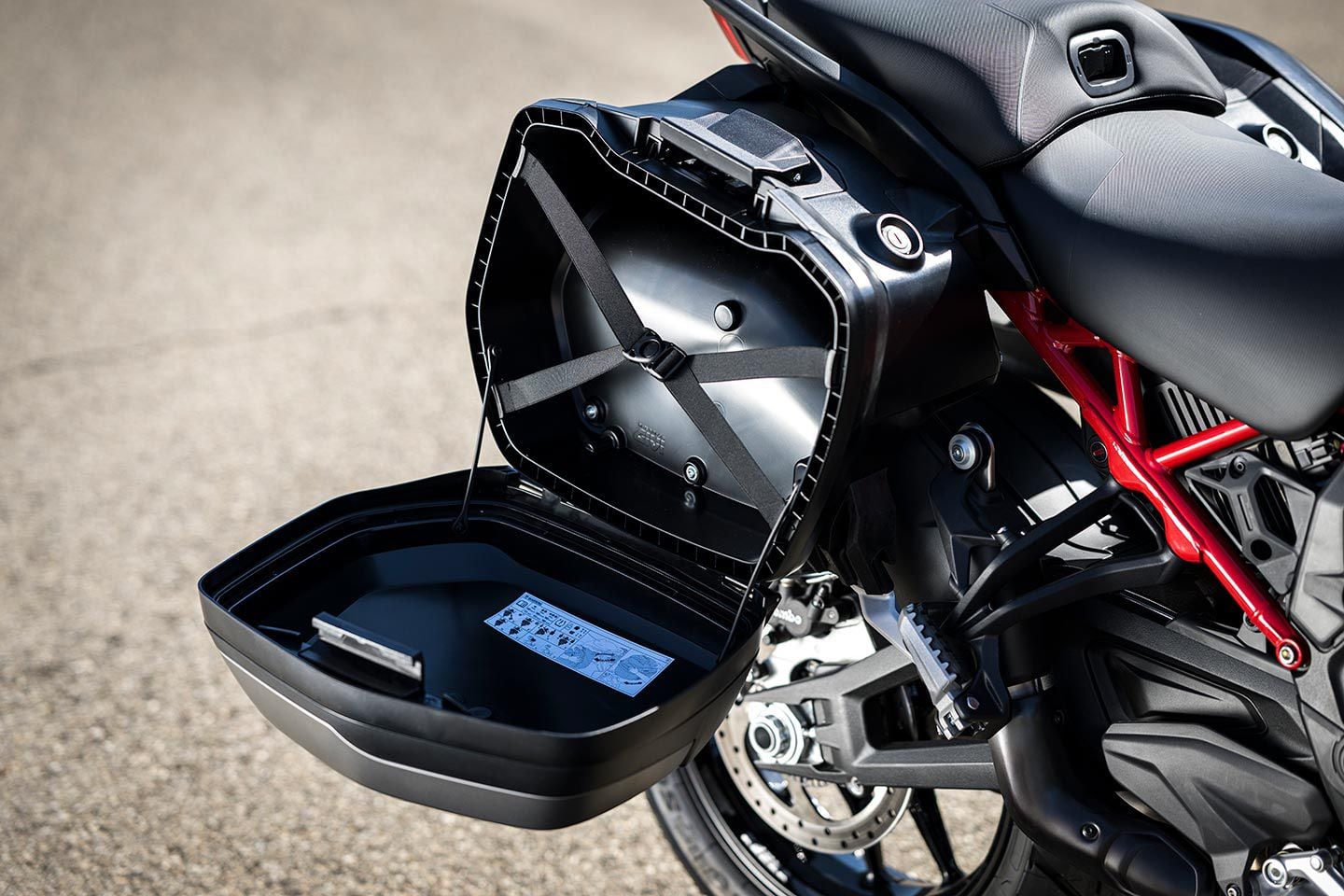
Capacity for the two plastic side cases on the Multistrada V4 S Grand Tour is a combined 60 liters. (Alex Photo/)The Grand Tour took it all in powerful stride, accelerating away from the tollbooths like a snarling superbike before cruising at 90 mph with the nonchalant ease of a smooth thoroughbred tourer. With the light fading and still 80 or so miles to process, the now-standard Adaptive Cruise Control is engaged (by setting the cruise to 140 kph then releasing the throttle) to let the system work its magic, monitoring the distance between our bike and vehicles in front then adjusting the speed accordingly.
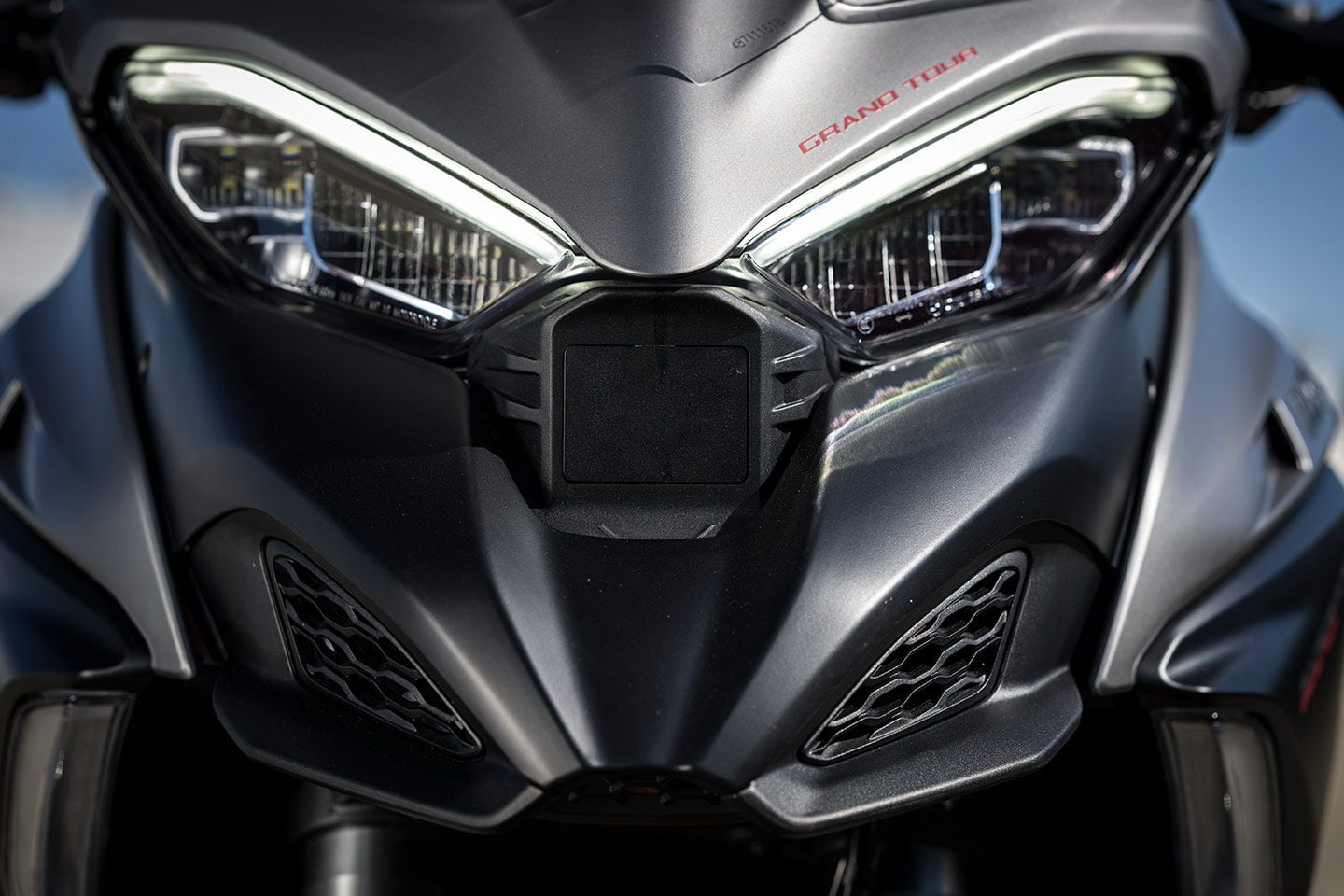
Forward-facing radar paired with rear-facing radar gives the Grand Tour adaptive cruise control as well as blind spot detection. (Alex Photo/)At this point, the rider has little to do—in a good way. Even the Blind Spot Detection works overtime so you can relax and conserve concentration, highlighting if it’s clear to change lanes. An LED light on each mirror illuminates when aggressively driven cars are storming up fast on either side, which is extra useful in the cut and thrust of an Italian rush hour.
On day two, the GT proved how versatile that V-4 motor is and how useful and intuitive the riding modes are. In Urban mode, peak power is reduced to 115 hp with throttle response softened just so, and even the up-and-down quickshifter subtly adjusted to city needs too. Sport and Touring modes, meanwhile, deliver full power, with Touring giving a less direct feeling at the throttle, Sport coming with a sharper response without being overly aggressive.
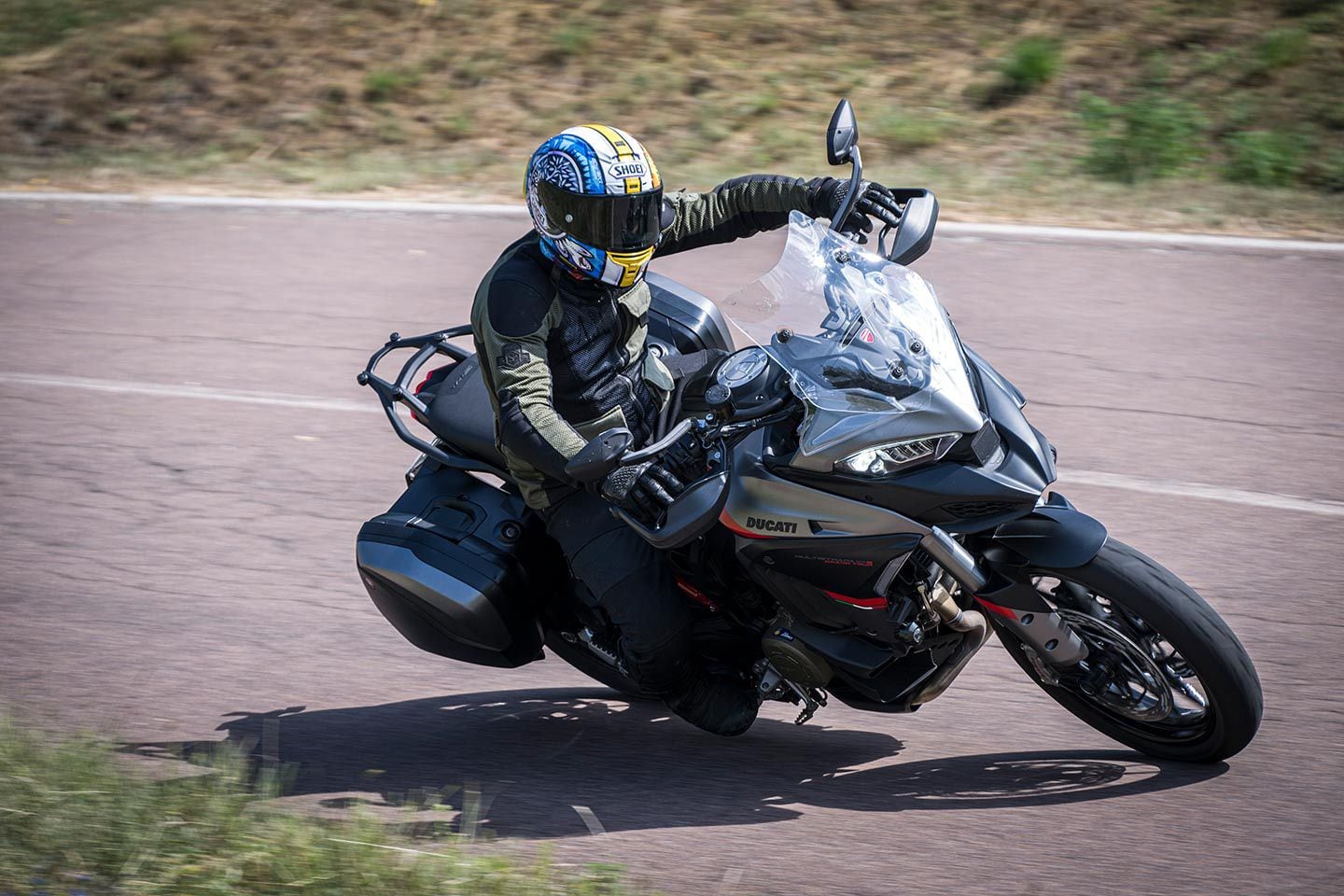
Sport mode tightens up the ride for spirited riding. (Alex Photo/)Most of our second day of riding focused on flowing along sweeping hillside roads, which meant Touring mode was optimal for most of the time, and flicking into Sport for an extra kick in power to blast up steep mountain passes. With so much power and torque to hand, the softer Touring mode was the preferred option.
When the roads tightened and the adrenaline began to flow, Sport mode was called up, not only for the most direct connection between throttle and rear tire contact patch but also for the extra support it injects into the semi-active Marzocchi suspension. Make no mistake, the new Grand Tour creams along like the very best touring machines, but when you want to have fun it has the power, the handling, and the attitude to deliver what we would have called mind-bending sportbike performance not too long ago. Despite being laden with panniers and bristling with worthy touring equipment (yes, there’s even a main stand), it’s responsive, full of grip, and instills full confidence.
Stopping power is the same as the V4 S and, up front, comes via tasty race-spec Brembo Stylema calipers, 330mm discs, and cornering ABS. The radial master cylinder adds to GT’s high specification and is similar to what you’d find on a high-end superbike. There’s excellent stopping power when needed, the ABS isn’t intrusive in any way, and the lever actuation is smooth at low speeds.
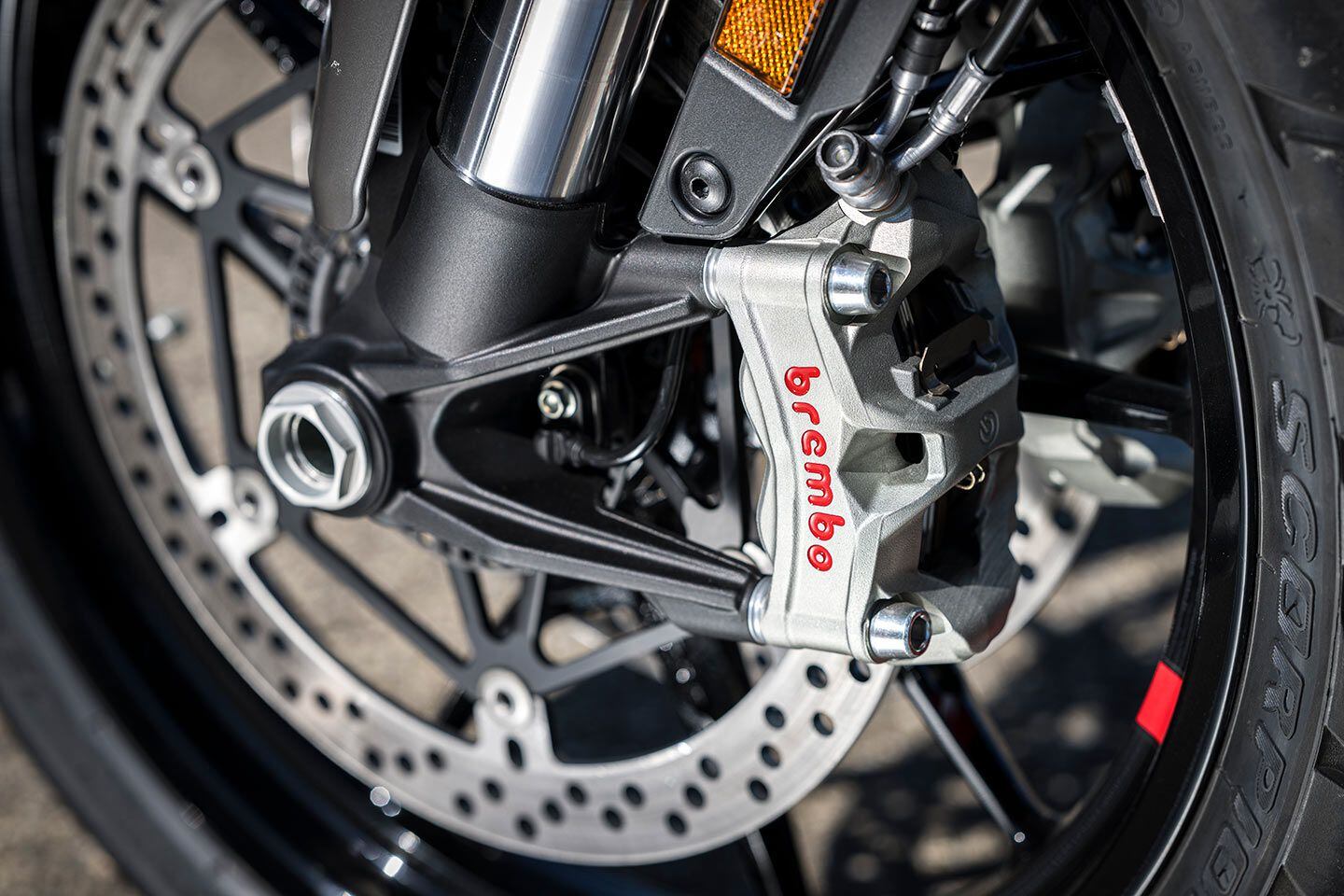
Brembo Stylema front calipers matched to 330mm discs offer sportbike-like braking performance. (Alex Photo/)The quoted weight of the Grand Tour is yet to be confirmed but is expected to be a fraction more than the standard V4 S’ 474 pounds (dry) due to all its extras, but even with the panniers fully loaded the added weight was hardly noticeable thanks to Ducati’s Skyhook semi-active suspension.
Like its engine performance, the Grand Tour’s dominant handling characteristics are dictated by the selected riding mode. Touring is plush and yielding yet holds the chassis well when you want to make the most of all those frisky Italian horses. In Sport mode the Skyhook system transforms the Grand Tour into a purposeful and hard-edged performance tourer, the suspension movement and travel are reduced with more support and stiffer damping when you’re pushing hard, braking deeper, and accelerating earlier.
We hit some poorly paved surfaces in the hills above Bologna but barely reduced our pace as the GT was never close to the limit or about to do anything untoward. For a bike with a 19-inch front wheel and for a roadster with long-travel suspension, it’s an integrated, sweet-handling package, backed up by some of the smartest rider aids on the planet. Ducati Wheelie Control (DWC), Ducati Traction Control (DTC), plus cornering ABS are all present and all lean-sensitive, their input and intervention levels dependent on the riding mode selected, working in the background and enabling you to have fun in safety.
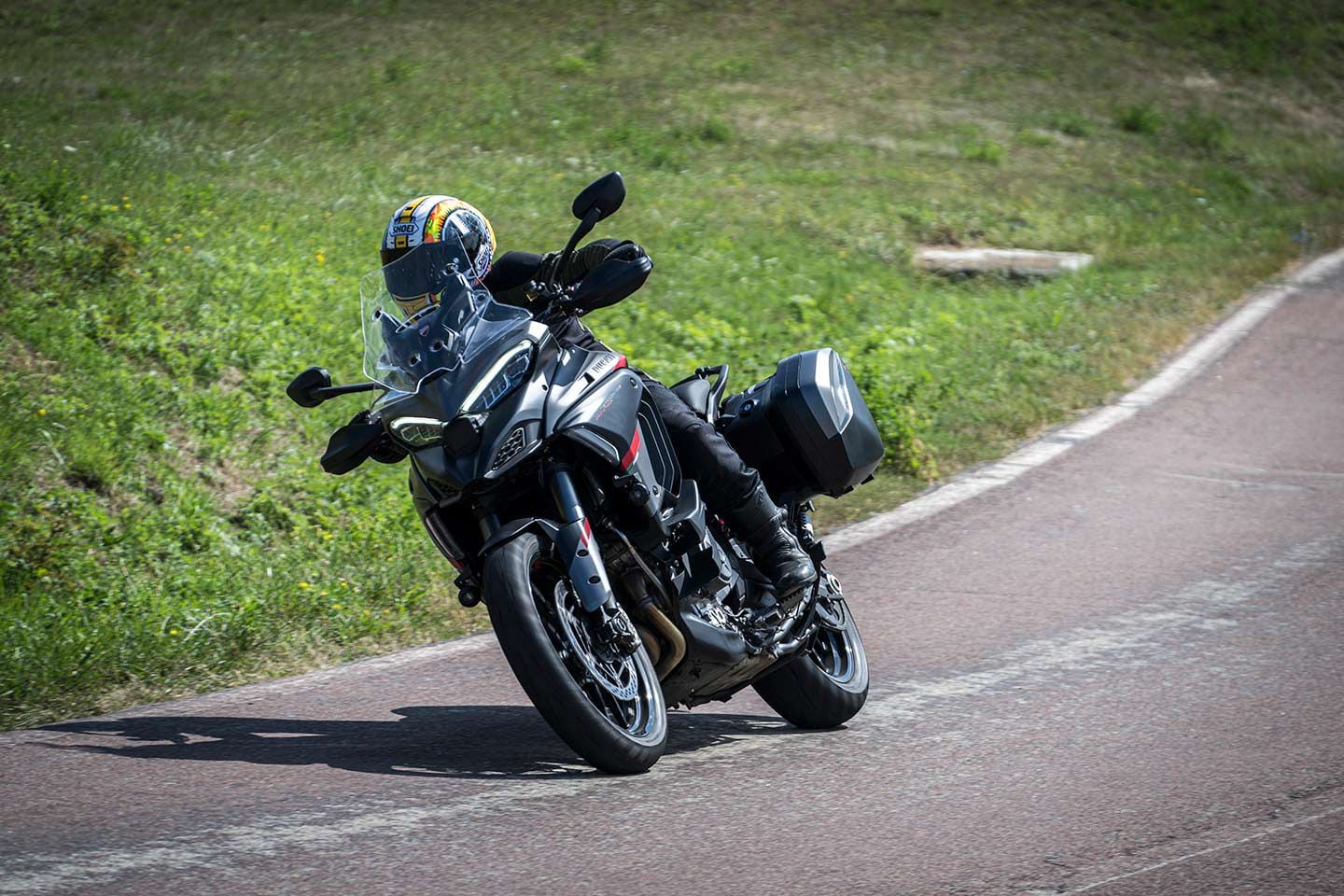
Lean-sensitive traction control and ABS along with Ducati’s Skyhook semi-active suspension keep rider confidence high when the road quality is low. (Alex Photo/)The 2024 Grand Tour additionally comes equipped with two useful suspension aids: minimum preload and Easy Lift. As mentioned, the minimum spring preload function allows the rider to effectively increase sag and lower the seat height for low-speed security. How much the seat lowers depends on the weight the seat is carrying. I am 5 feet, 7 inches, and with the preload reduced I could confidently get two feet on the ground. Once rolling again, you can press a button on the left bar to restore the preload to normal, or failing that, the system will automatically add the preload once the speed is up to around 68 mph.
Easy Lift, meanwhile, opens up the suspension, making it softer when the ignition is on and easier to lift the bike upright from the sidestand. With a fully loaded machine especially, it provides welcome assistance.
The large, adjustable screen remains only manually adjustable but is effective and only takes the lightest touch to operate. Even at 90 mph, you can ride visor up without your eyes watering or any discomfort.
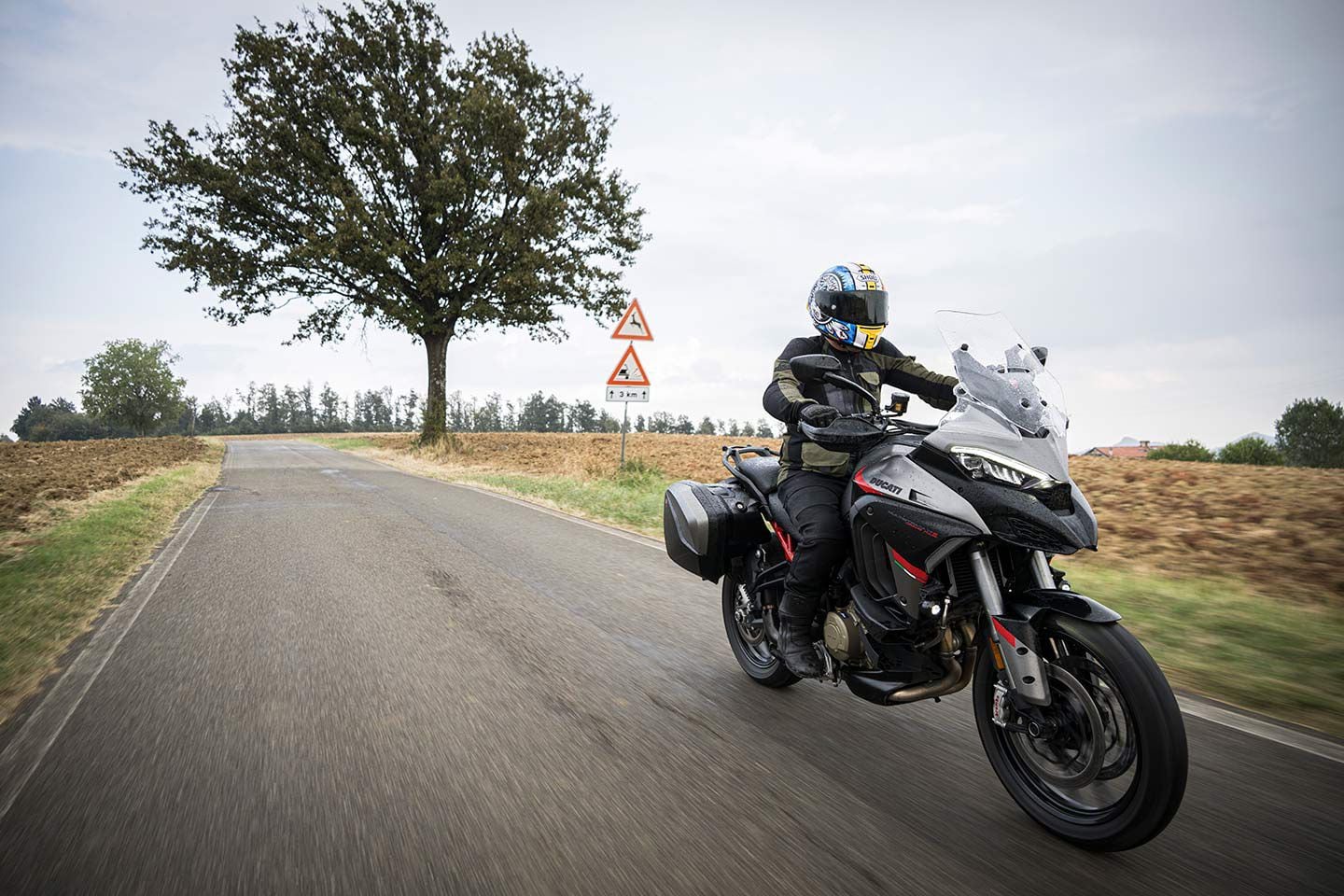
Covering big distances is a breeze on the Grand Tour with its all-day comfort. (Alex Photo/)As noted, the new GT doesn’t have the rear cylinder deactivation system that drops the rear pair of cylinders at low engine speeds, but Ducati has tried to channel engine heat away from the rider, with new heat shields on the swingarm and the left side of the rear subframe, plus new closable air ducts on either side just in front of your legs.
The busy but clear 6.5-inch TFT dash is adopted from the S model and comes with full connectivity and navigation. There are heated grips and heated seats for rider and pillion, while the pillion also gets a plusher perch, again stolen from the Rally released earlier this year.
Over two days on this test we averaged 31 mpg. A 5.8-gallon gas tank suggests more than 170 miles between fuel stops are possible, even more if ridden with less gusto than the Multi GT begs for. Grinding out 190 miles without a stop should be easy going on the Grand Tour as the comfort is all-day excellent.
In summary, Ducati has taken the hugely accomplished and versatile crossover that is the Multistrada V4 S, added even more features plus a few ideas from the excellent V4 Rally to produce not only the best Multi for long-distance touring but arguably one of the best bikes to have sporty fun on when you arrive at your mountain destination.
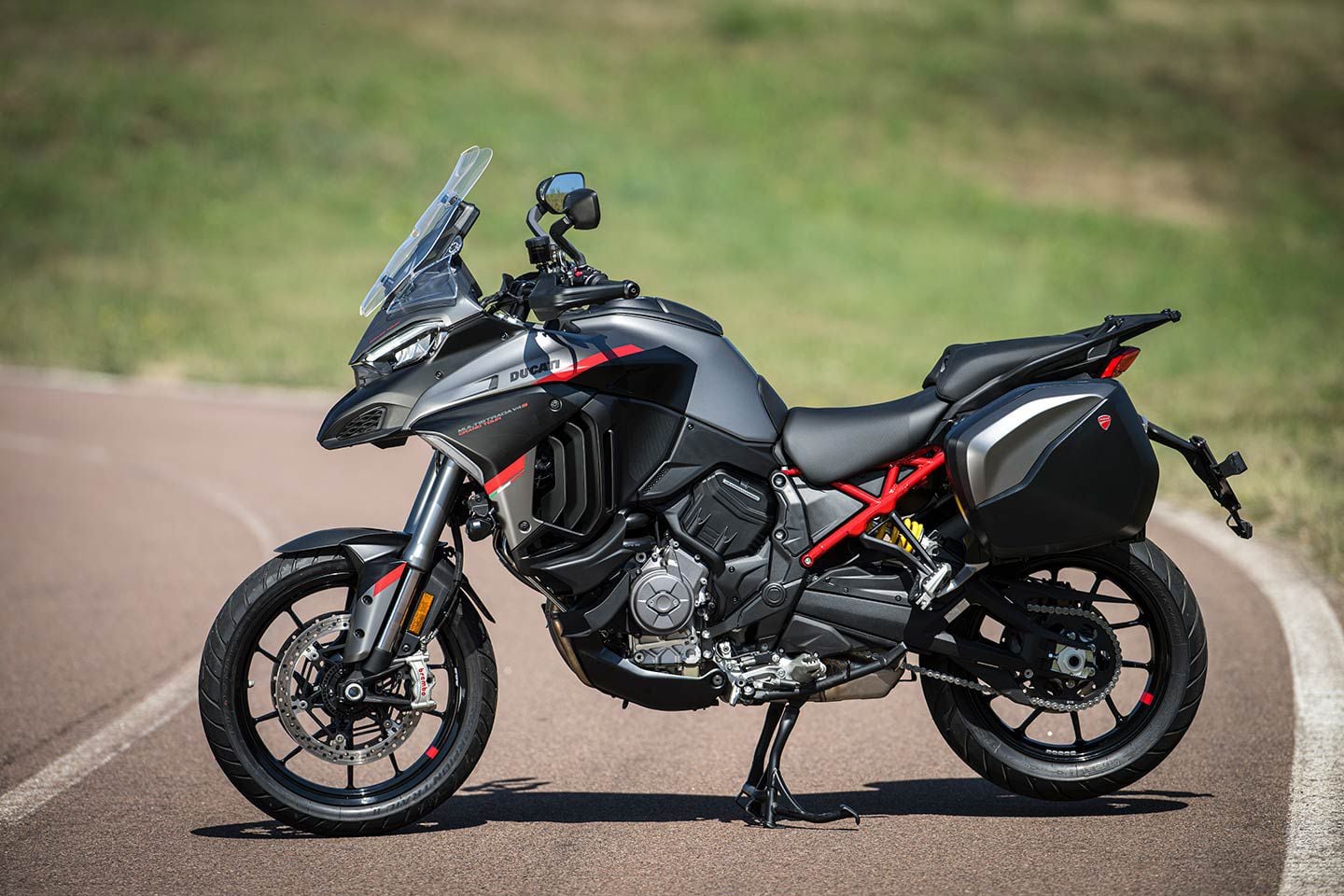
The Grand Tour puts the “multi” in Multistrada. (Alex Photo/)We dream of finding the ultimate machine that can do it all and the Grand Tour truly comes close. It’s flexible and smooth, oozes comfort, and has enough luggage capacity for a proper touring holiday. With 170 hp and the ability to stop, turn, and go like a very good superbike and there’s very little it cannot do, and do very well. For those who’ve always yearned for Ducati’s superb all-rounder but patiently waited for price and spec to fully align, the Grand Tour’s arrival may well be the moment to pounce.
2024 Ducati Multistrada V4 S Grand Tour Specs
MSRP: $28,395 ENGINE: DOHC, liquid-cooled, 90-degree V-4 w/ counterrotating crankshaft; 4 valves/cyl. DISPLACEMENT: 1,158cc BORE X STROKE: 83.0 x 53.5mm COMPRESSION RATIO: 14.0:1 TRANSMISSION/FINAL DRIVE: 6-speed/chain CLAIMED HORSEPOWER: 170 hp @ 10,500 rpm CLAIMED TORQUE: 92 lb.-ft. @ 8,750 rpm FUEL SYSTEM: EFI w/ 46mm elliptical throttle bodies; ride-by-wire CLUTCH: Wet, multiplate w/ slipper action; hydraulic operation FRAME: Aluminum monocoque FRONT SUSPENSION: 50mm inverted fork w/ Ducati Skyhook, electronically adjustable compression and rebound; 6.7 in. travel REAR SUSPENSION: Monoshock w/ Ducati Skyhook, electronically adjustable; 7.1 in. travel FRONT BRAKE: Radially mounted Brembo Stylema Monoblock 4-piston calipers, twin 330mm semi-floating discs w/ Cornering ABS REAR BRAKE: Brembo 2-piston floating caliper, 265mm disc w/ Cornering ABS WHEELS, FRONT/REAR: Light alloy cast; 19 x 3 in. / 17 x 4.5 in. TIRES, FRONT/REAR: Pirelli Scorpion Trail II; 120/70ZR-19 / 170/60ZR-17 RAKE/TRAIL: 24.2°/4.0 in. WHEELBASE: 61.7 in. SEAT HEIGHT: 33.1–33.9 in. FUEL CAPACITY: 5.8 gal. CLAIMED CURB WEIGHT: TBA AVAILABILITY: February 2024 CONTACT: ducati.com

2024 Brabus 1300 R Masterpiece Edition First Look
in Motorbike news
Posted
Brabus has revealed its third 1300 R model variant, dubbed the Masterpiece Edition. Only 50 units will be produced. (Brabus/)
When German supercar tuner Brabus partnered up with KTM to release its first-ever motorcycle model, the 1300 R, last February, we predicted it would be a sales success. And because the 1300 R was heavily based on the already-bonkers KTM 1290 Super Duke R Evo, the Germans saw no need to mess with the mechanicals, opting instead to give the “luxury hyper-naked” its own, brand-specific visual identity. Turns out “success” was a bit of an understatement; all 154 units of the approximately $45,000 Brabus were snapped up in under two minutes, spawning a follow-up model, the 1300 R Edition 23, earlier this year, which also had a sell-out run.
So it’s no wonder we’re seeing a third version of the bike—the Brabus 1300 R Masterpiece Edition—also derived from the KTM 1290 Super Duke R Evo. Brabus says this 1300 R edition will be the last of the series, and will also be the most limited. In this case just 50 units will be produced.
The latest 1300 R is also heavily based on KTM’s 1290 Super Duke R Evo, and is available in two colors. Diamond White shown. (Brabus/)
Like its two predecessors, the Masterpiece Edition builds on the same platform, and is powered by the 1290 Super Duke R Evo’s 1,301cc V-twin set in a matte black steel trellis frame and suspended by WP Apex semi-active suspension, with cornering ABS, traction control, and a host of other electronic rider aids. Other carryover bits on the Masterpiece Edition include the 17-inch Brabus Monoblock Z forged wheels, though here the nine-spoke design is accented with a new Gold Platinum finish. Brembo brake components, heated grips, and adjustable brake clutch levers and footpegs are all back as well.
Related: KTM-Brabus 1300 R Revealed
The Masterpiece Edition doubles down on the carbon fiber packaging; special badging as on this air duct is featured throughout. (Brabus/)
The dual slip-on Brabus exhaust also looks like a rerun, though it gains a different body color and new gold accents with the model name laser-etched on the rear mufflers, which the company says was developed “exclusively for the Masterpiece Edition.” Also returning is the distinctive round LED headlight framed by an exposed visor, though it’s sporting more carbon fiber this year, as are the side fairings, integrated winglets, and a lot of front fender.
In fact carbon fiber seems to be the running theme, with Brabus using the material for the single-sided swingarm cover, front spoiler, dash and connector covers, the triangular frame sections under the tank and seat, as well as the cover for the rear side fairing.
Additional carbon also appears below the headlight bracket, and each bike comes with the “1 of 25″ badge on the tank. The bespoke heated single seat is covered in black leather with a diamond quilt pattern, while new padding for the tail cowl features a golden “Brabus Masterpiece” badge to mark its limited-edition status.
The Brabus dual-pipe slip-on exhaust gets gold accents on the mufflers, with the model name laser-etched on the bottom unit. (Brabus/)
Befitting its luxury positioning, each Masterpiece bike also comes with a package of exclusive accessories, including a tailor-made indoor cover—because apparently parking this beauty outside is frowned upon—-and a Brabus “exhibition carpet” with a “Heritage” brand pattern (we sense an indoor theme here) to create what the company calls “an atmosphere of prestige.” Also included is the Brabus Masterpiece Box made of high-grade carbon fiber containing a personalized certificate of authenticity.
The Brabus 1300 R Masterpiece Edition is also available in Onyx Black; MSRP is 41,390 euro. (Brabus/)
The exclusive Brabus 1300 R Masterpiece Edition is available now in Onyx Black or Diamond White with a limited run of 25 bikes for each color. Depending on your choice, the bike’s tank, tail cowl, and parts of the front fender will come in the black or white option. Brabus says the export price in Germany is 41,930 euros (approximately $43,700 USD).
View the full article